Saint Helena Travel Guide
This is a Saint Helena Travel Guide from taste2travel.com
Date Visited: November 2024
Introduction
Nestled in the South Atlantic Ocean, far from the bustle of modern life, Saint Helena Island is a hidden gem that offers an extraordinary blend of history, natural beauty, and tranquility.
This remote British territory, measures 16 km x 8 km (10 x 5 mi) and is home to approximately 4,500 souls.
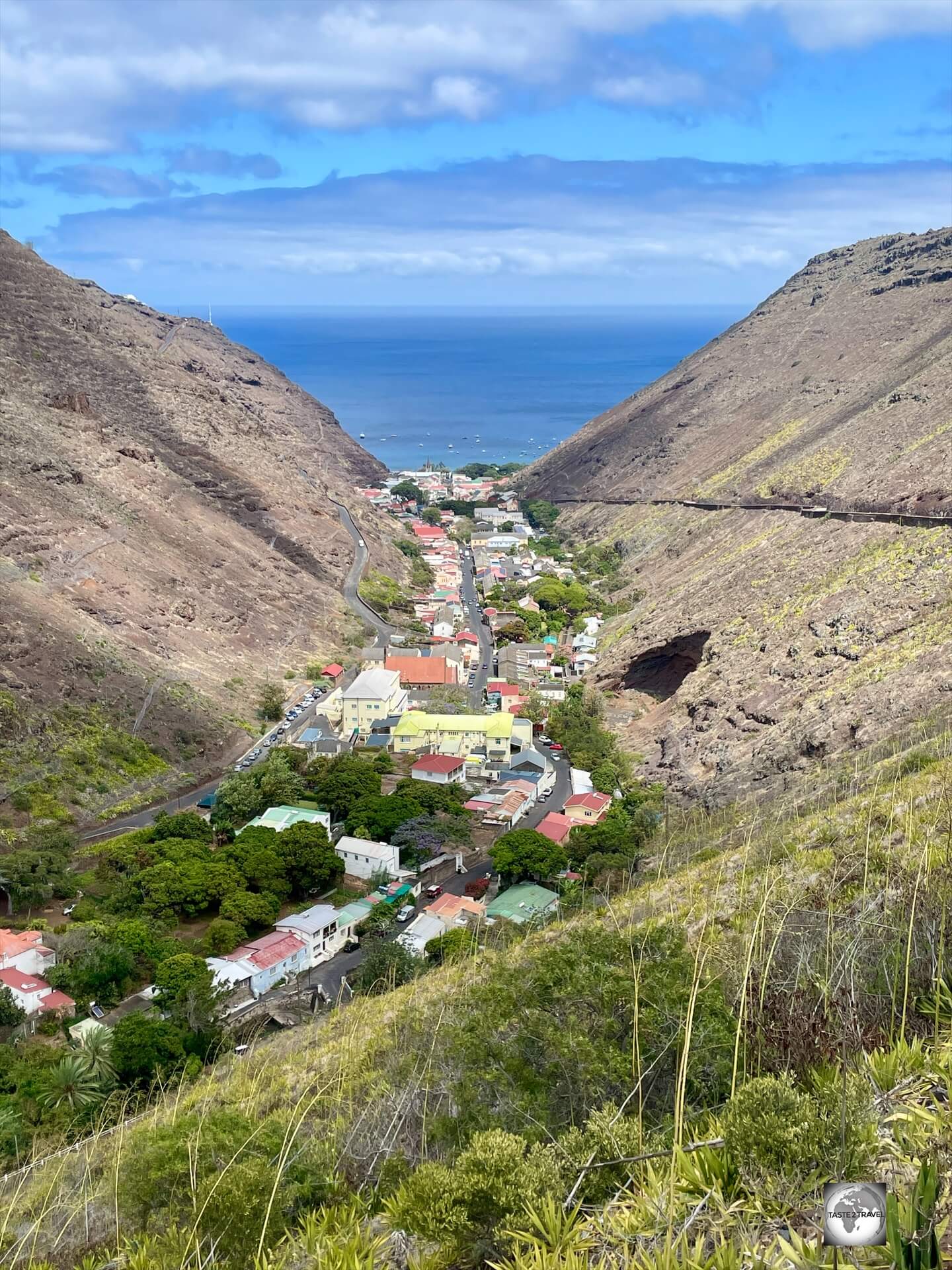
The capital and largest town on Saint Helena, Jamestown is home to 625 souls.
The capital, and only town of any size, is Jamestown, which is wedged into the very narrow James Valley, which is surrounded on all sides by steep rocky cliffs.
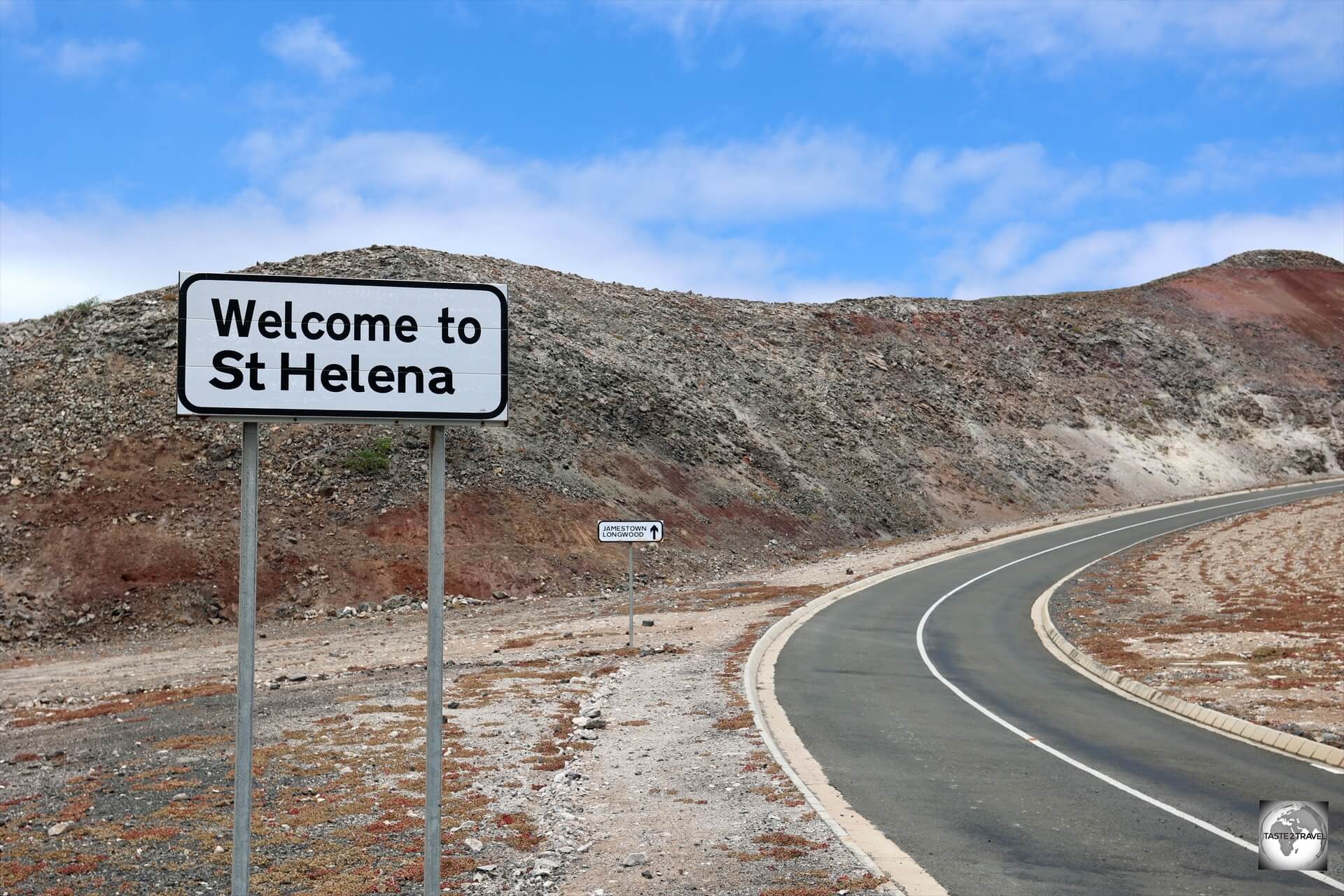
The “Welcome to St Helena” sign, outside St Helena Airport.
With its rugged, rocky, coastline, lush hills, and charming historic sites, this small British overseas territory provides an authentic escape for those seeking a unique travel experience.
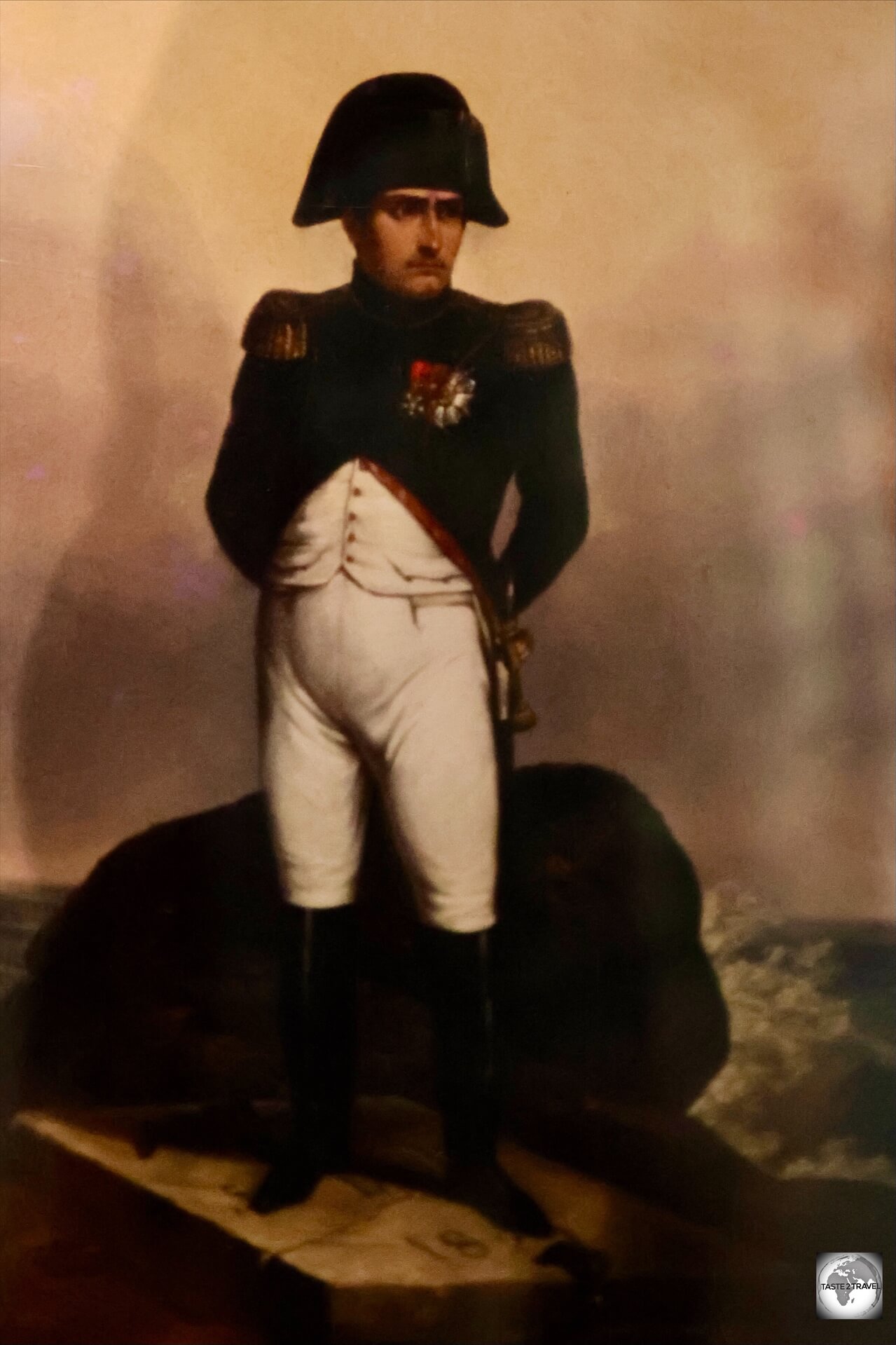
Saint Helena is famous as being the place of exile, and death, of the French emperor – Napoleon Bonaparte.
Saint Helena is perhaps most famous for being the remote island where Napoleon Bonaparte was exiled in 1815, and was the place of his death in 1821.
Napoleonophile’s can explore the remnants of his final years at the site associated with his residence – Longwood House and the site of his original tomb.
But beyond its historical significance, Saint Helena offers a wealth of natural wonders, including spectacular hiking trails, incredible birdwatching, and pristine beaches.

At 193 years old, Jonathan the Tortoise is the oldest resident on Saint Helena and one of the island’s star attractions.
While Napoleon was the most famous resident of Saint Helena, the longest surviving resident is the remarkable Jonathan the Tortoise, the oldest resident on Saint Helena and one of the island’s star attractions.
A Seychelles giant tortoise, it is believed that Jonathan was hatched around 1832, and was brought to Saint Helena from the Seychelles in 1882, along with three other tortoises at about 50 years of age.
In 2025, Jonathan is celebrating his 193rd birthday!
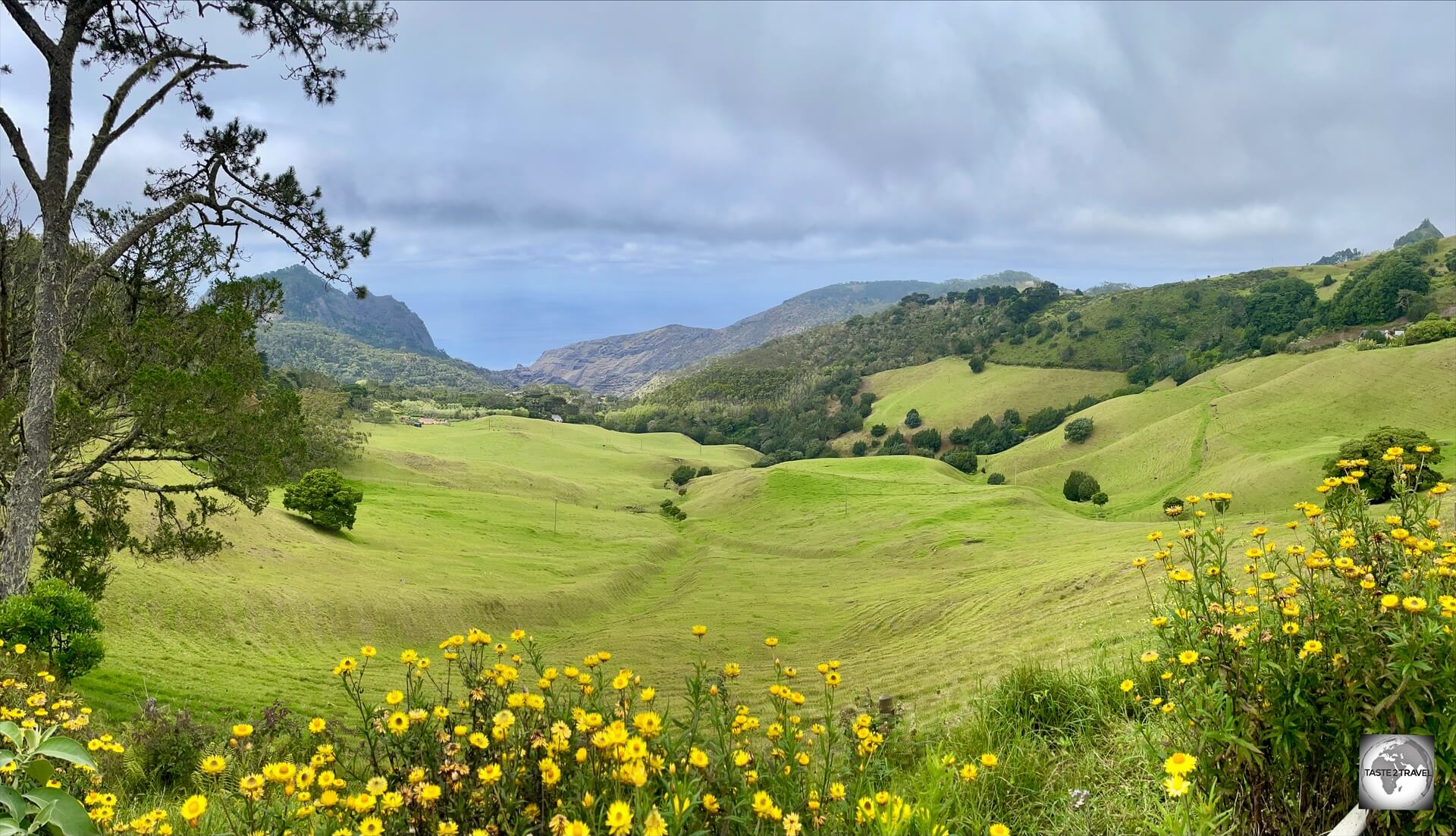
Views of the Saint Helena countryside from the road to Blue Point.
Whether you’re drawn by history, nature, or simply the allure of an off-the-beaten-path destination, Saint Helena promises an unforgettable adventure.
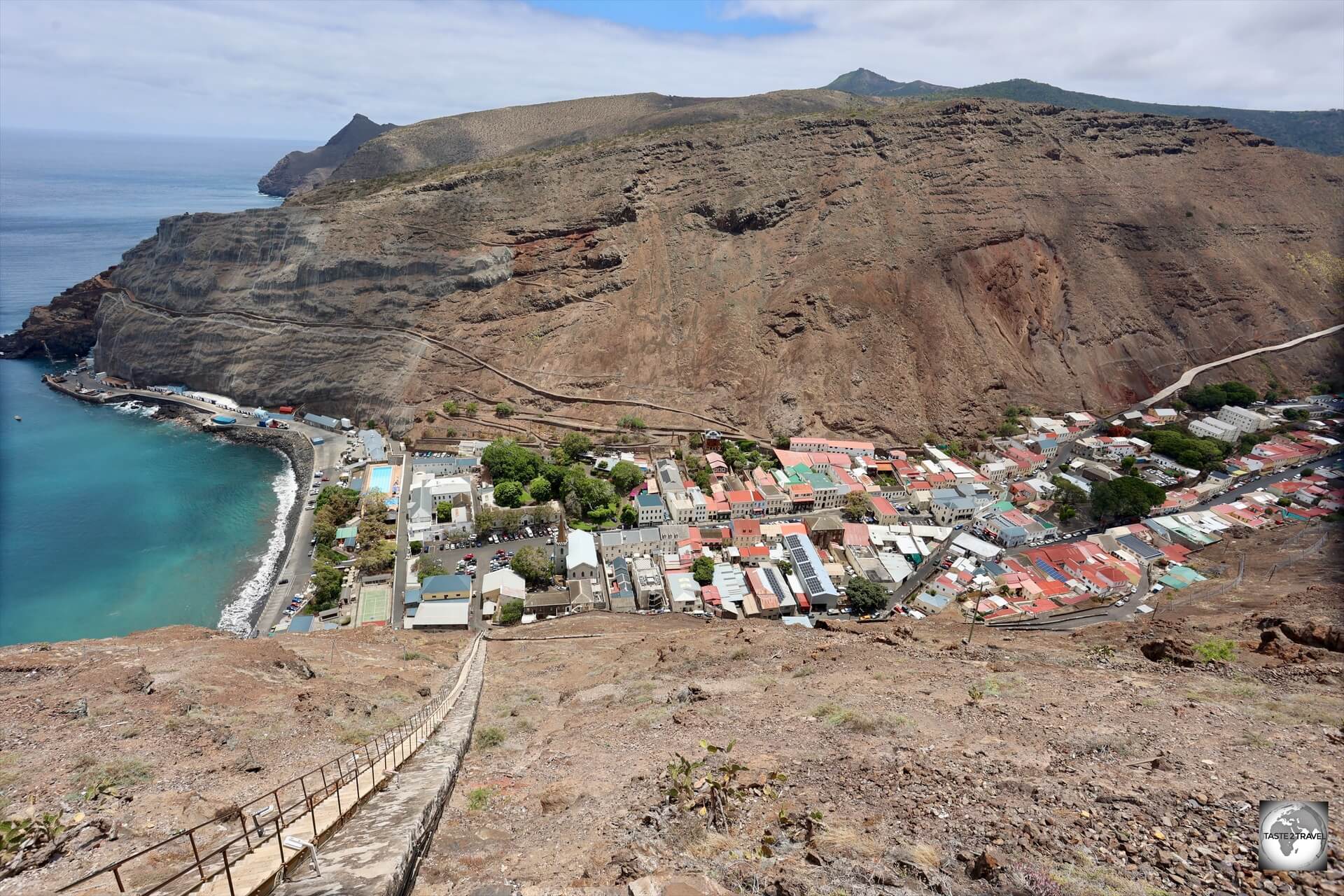
A spectacular view of Jamestown awaits those who climb the 699-step Jacob’s Ladder.
Getting to Saint Helena is an experience in itself, with a once-weekly flight available only from South Africa, making the journey as much a part of the adventure as the destination.
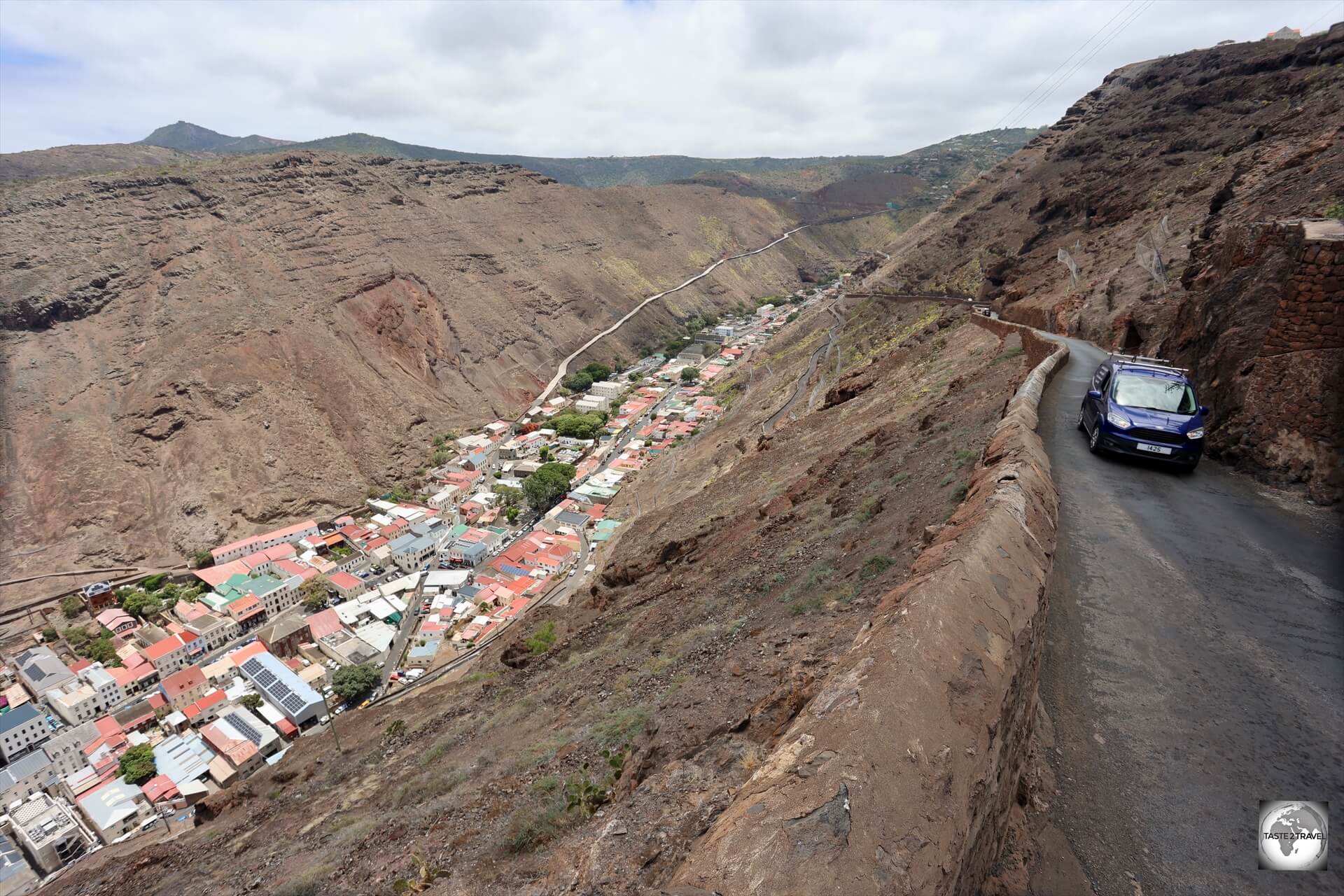
The narrow, windy, steep, perilous roads on Saint Helena could be described as challenging.
Once one the island, which has no public transport and a limited taxi service, the only feasible way to explore the countryside is with a rental car.
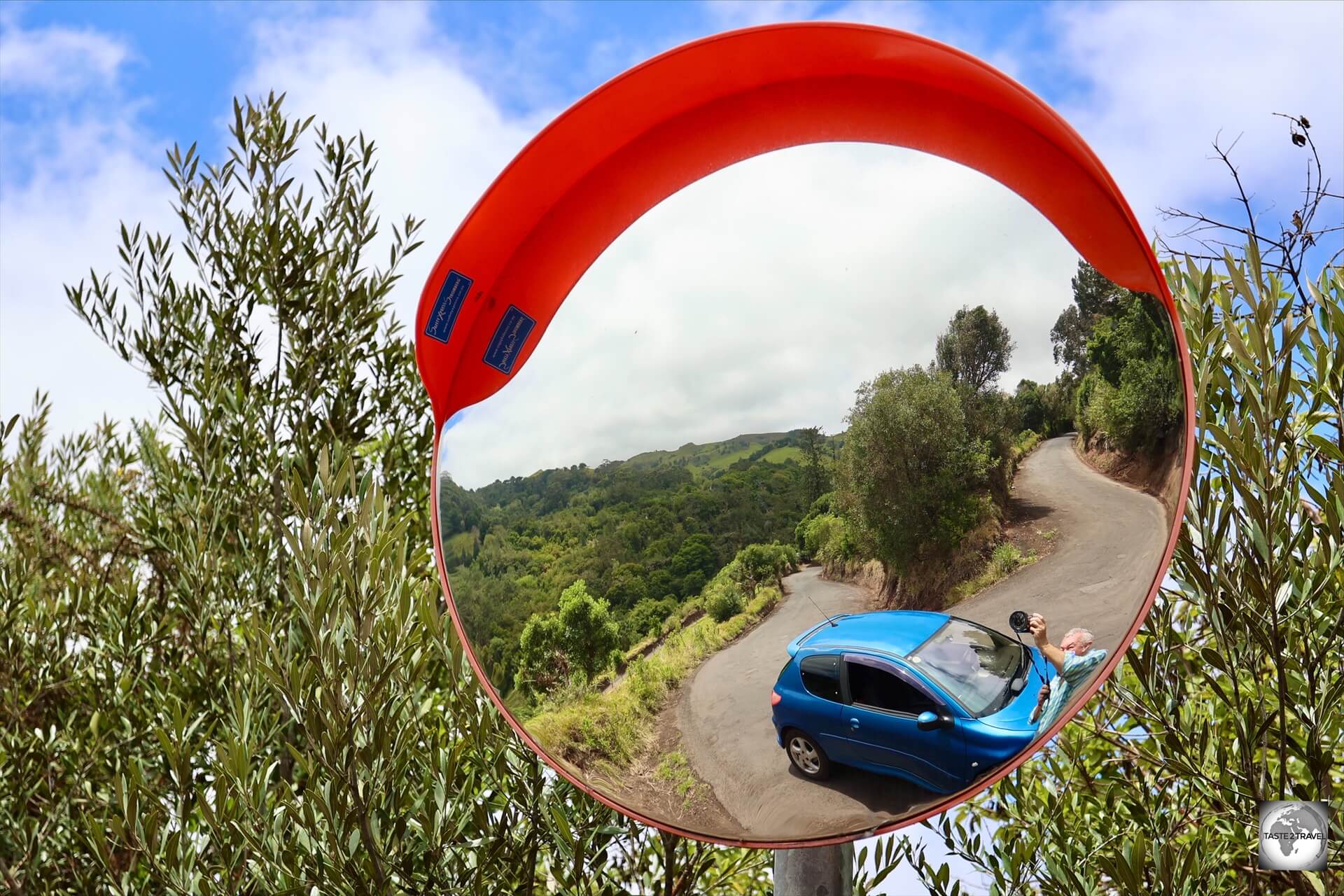
Roadside mirrors everywhere on Saint Helena – a typical hairpin turn!
Driving conditions on Saint Helena are challenging with roads which are narrow, windy, one-lane in many places, lined with rock walls and full of one tight hairpin turn after another.
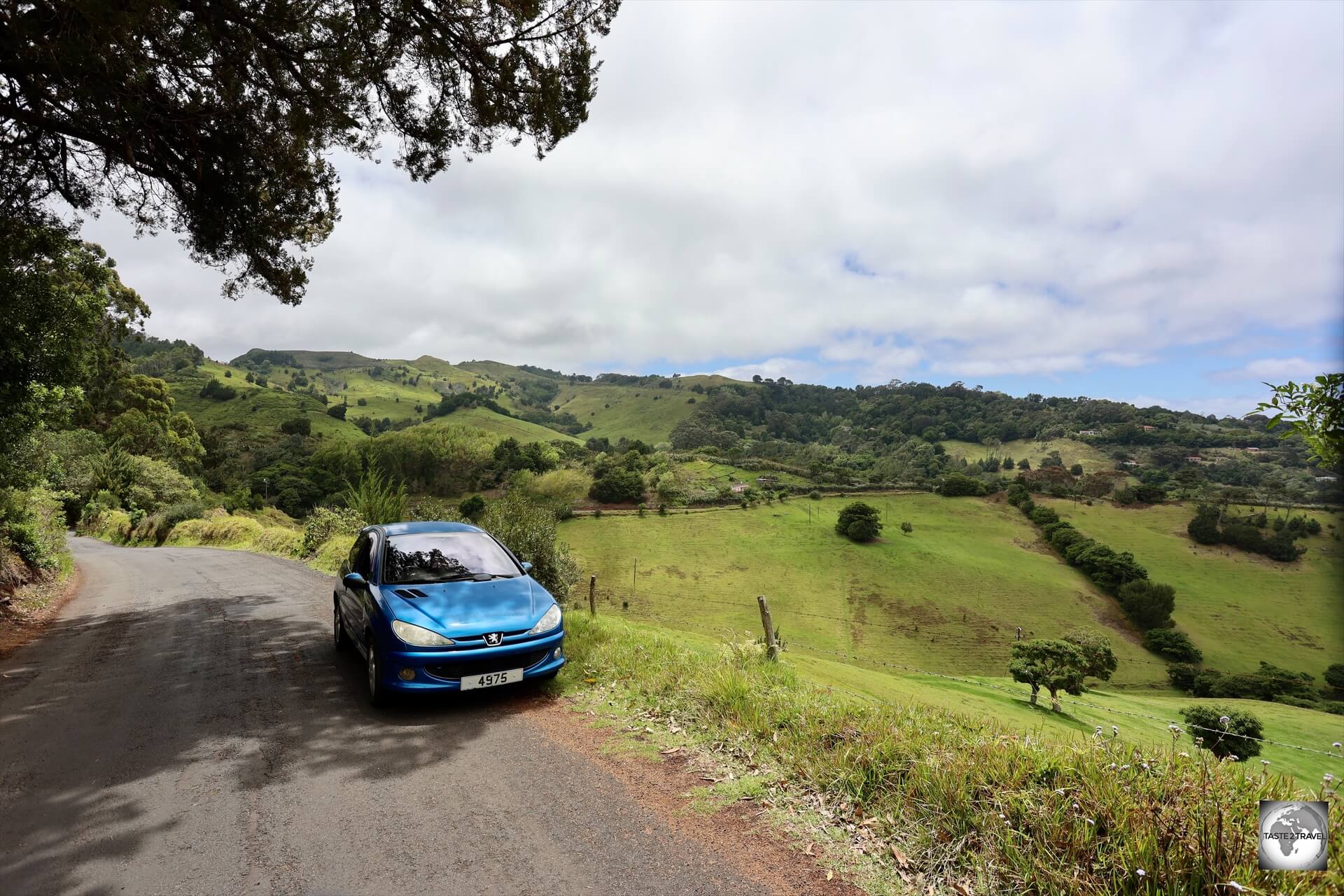
I spent one week exploring beautiful Saint Helena in my rental car.
Cars are mostly manual drive and rarely will you engage any gear above 3rd. Signage is poor and the roads are unlit at night!
I thoroughly enjoyed my one week on Saint Helena and would recommend this remote outpost to those who love to explore off-the-radar destinations.
Onward to Ascension Island

The flag of Ascension Island.
Since Saint Helena is one of just two access points to Ascension Island, I have included details on ‘Visa Requirements‘ and ‘Getting There‘, including links and contact information, in the relevant sections of this guide.
Location
A territory of the United Kingdom, Saint Helena Island is a remote volcanic island located in the middle of the South Atlantic Ocean, far from anywhere else!
Due to its volcanic origins, Saint Helena is almost impenetrable, with its coast comprised largely of towering, rocky cliffs.
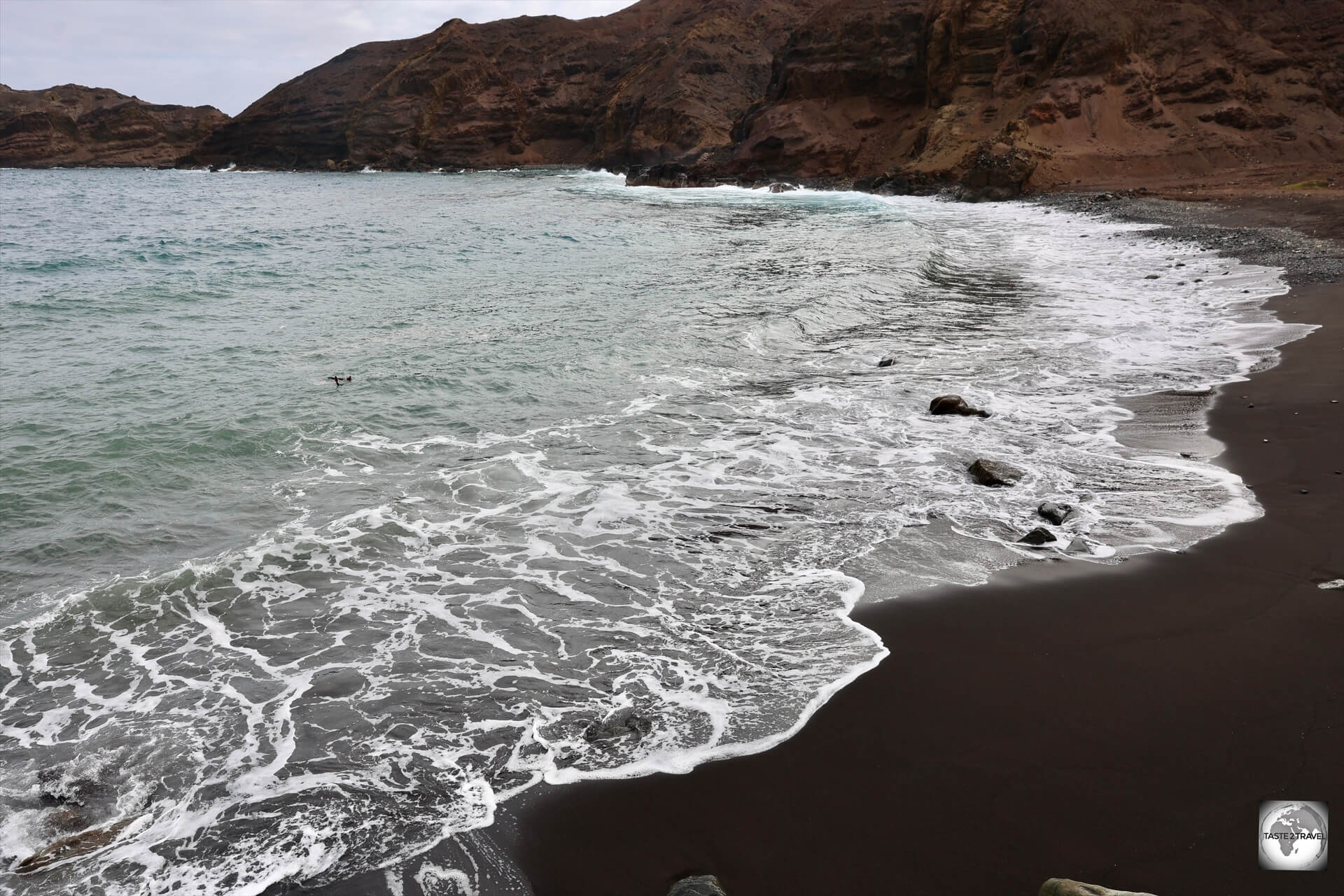
The only real beach on Saint Helena, the jet-black sand beach at Sandy Bay.
It is roughly situated halfway between South America and Africa, making it one of the most isolated inhabited islands in the world.
Saint Helena lies approximately 1,950 km (1,210 mi) west of the southwestern coast of Africa (near Angola and Namibia).
The South African city of Cape Town lies 3,130 km (1,945 mi) to the south-east while the Namibian port of Walvis Bay lies 2,253 km (1,400 mi) to the south-east.
This remote outpost lies 3,540 km (2,200 mi) to the east of the Brazilian city of Salvador.
The capital of Saint Helena, Jamestown, lies 7,517 km (4,670 mi) south of London, United Kingdom.
Mid-Atlantic Ridge

Saint Helena is located on the Mid-Atlantic ridge.
Source: Wikipedia
Saint Helena is one of several islands which are located on the Mid-Atlantic ridge, an underwater mountain range which extends the entire length of the Atlantic Ocean from Greenland in the north to Bouvet Island, which lies 1,700 km (1,100 mi) north of the coast of Antarctica.
Other islands which lie on the Mid-Atlantic ridge include:
- Jan Mayen
- Iceland (click to view my travel guide)
- Azores
- Ascension Island
- Tristan da Cunha
- Gough Island
The island of Bermuda (click to view my travel guide) originated slightly west of the mid-Atlantic ridge, in a huge volcanic eruption that created a seamount close to the surface of the water.
Over millions of years the Bermuda seamount migrated westwards (towards the United States) as tectonic plates were forced apart.
History
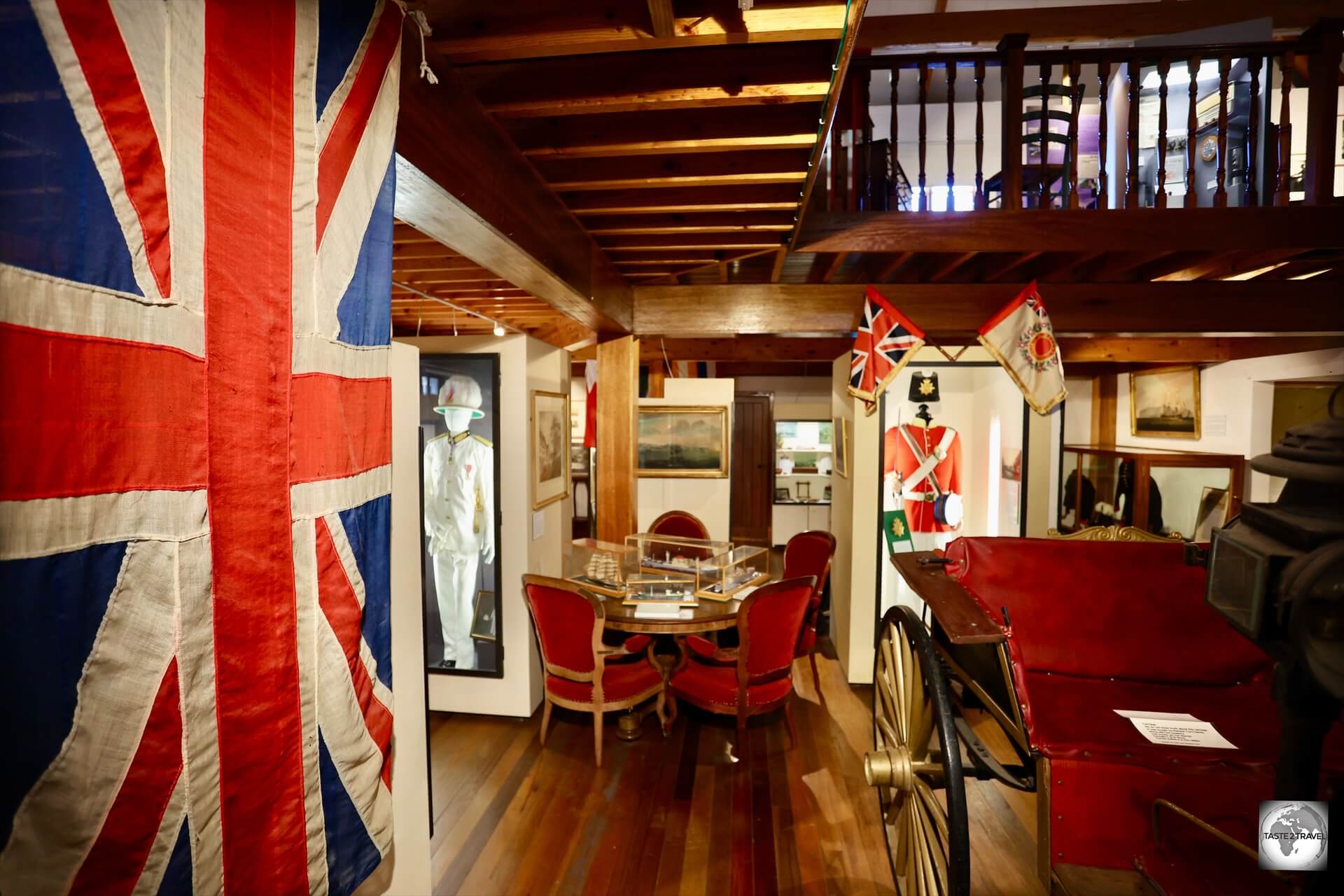
The Saint Helena Museum in Jamestown provides a comprehensive overview of the history of the island.
Historically, and due to its remote location, the island of Saint Helena had always existed in blissful isolation – uninhabited, undisturbed and undiscovered!
This all changed when the island was discovered, purely by chance, in May 1502 by João da Nova, a Spanish navigator in the service of Portugal.
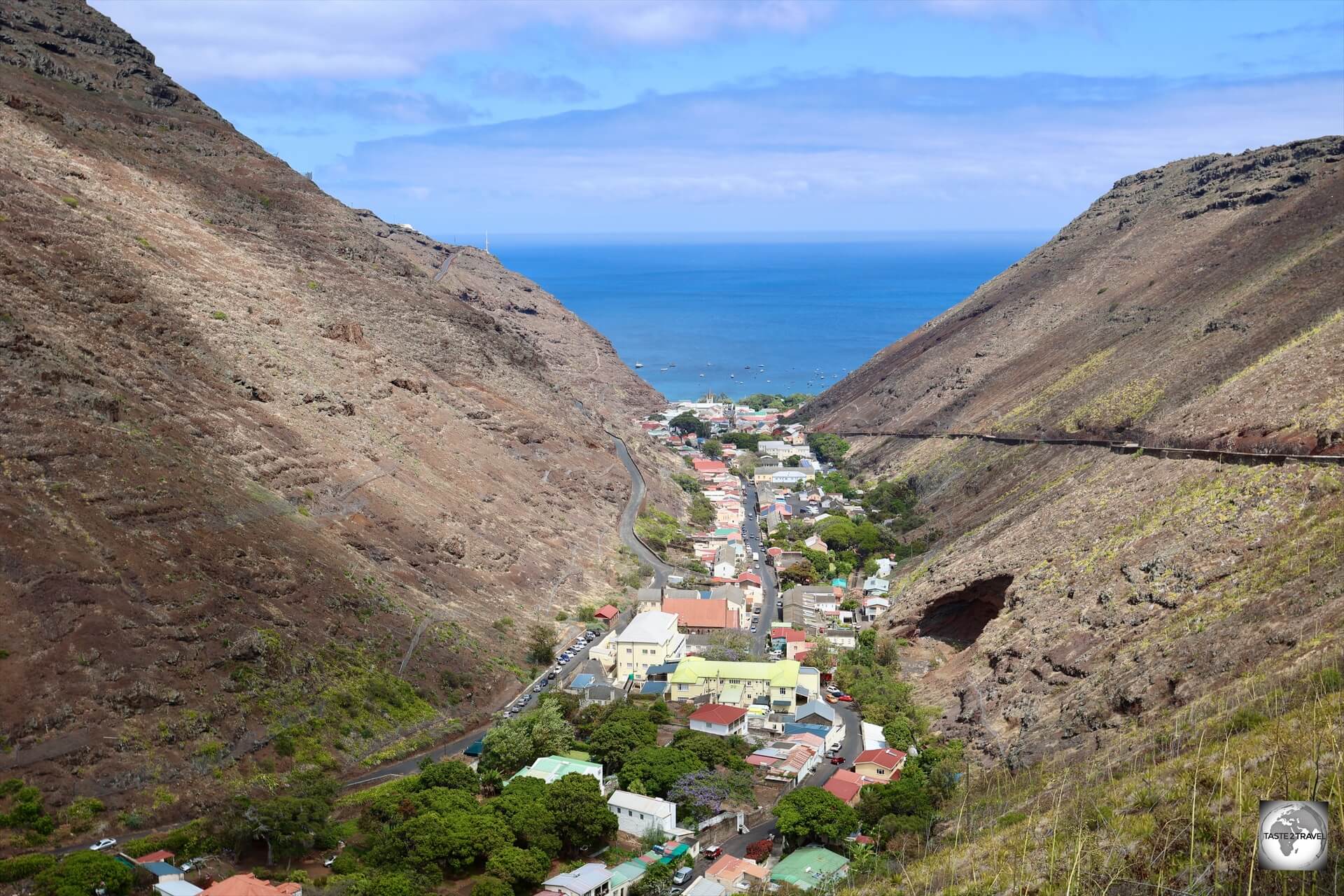
Founded in 1659, Jamestown, the capital of Saint Helena, is located in James Valley, surrounded by steep volcanic cliffs.
The exact date of the discovery traditionally has been given as May 21, which in the Eastern Orthodox Church is the feast day of Saint Helena, Roman empress and mother of the emperor Constantine.
Initially, the island was used as a stopping point by the Portuguese on their sea routes between Europe and Asia, but they did not establish permanent settlements.
In 1659, the Dutch made an attempt to settle on Saint Helena but abandoned it after a short time due to the island’s lack of fresh water and its remoteness.
In 1673, the British East India Company took possession of Saint Helena, recognising its strategic value as a stopover for ships travelling between Europe and India.
In 1679, the British established a permanent settlement and began building infrastructure, including a fort and other buildings to protect the island from possible Dutch or French attacks.
The capital, Jamestown, was founded in 1659 by the East India Company and named in 1660 to honour the Duke of York and to celebrate the restoration of the monarchy.
At the same time, the fort was renamed James Fort and the valley was renamed James Valley.
In the 18th century, Saint Helena became increasingly important as a crucial refueling stop for the British navy and merchant vessels, especially after the island’s harbour was developed into a naval base.
The British constructed James Fort, and developed plantations, growing crops such as vegetables, fruits, and the highly lucrative crop of sugar.
Due to its remote location, Saint Helena proved to be the perfect location for the exile of Napoleon Bonaparte who was imprisoned on the island in 1815, following his defeat in the Battle of Waterloo.
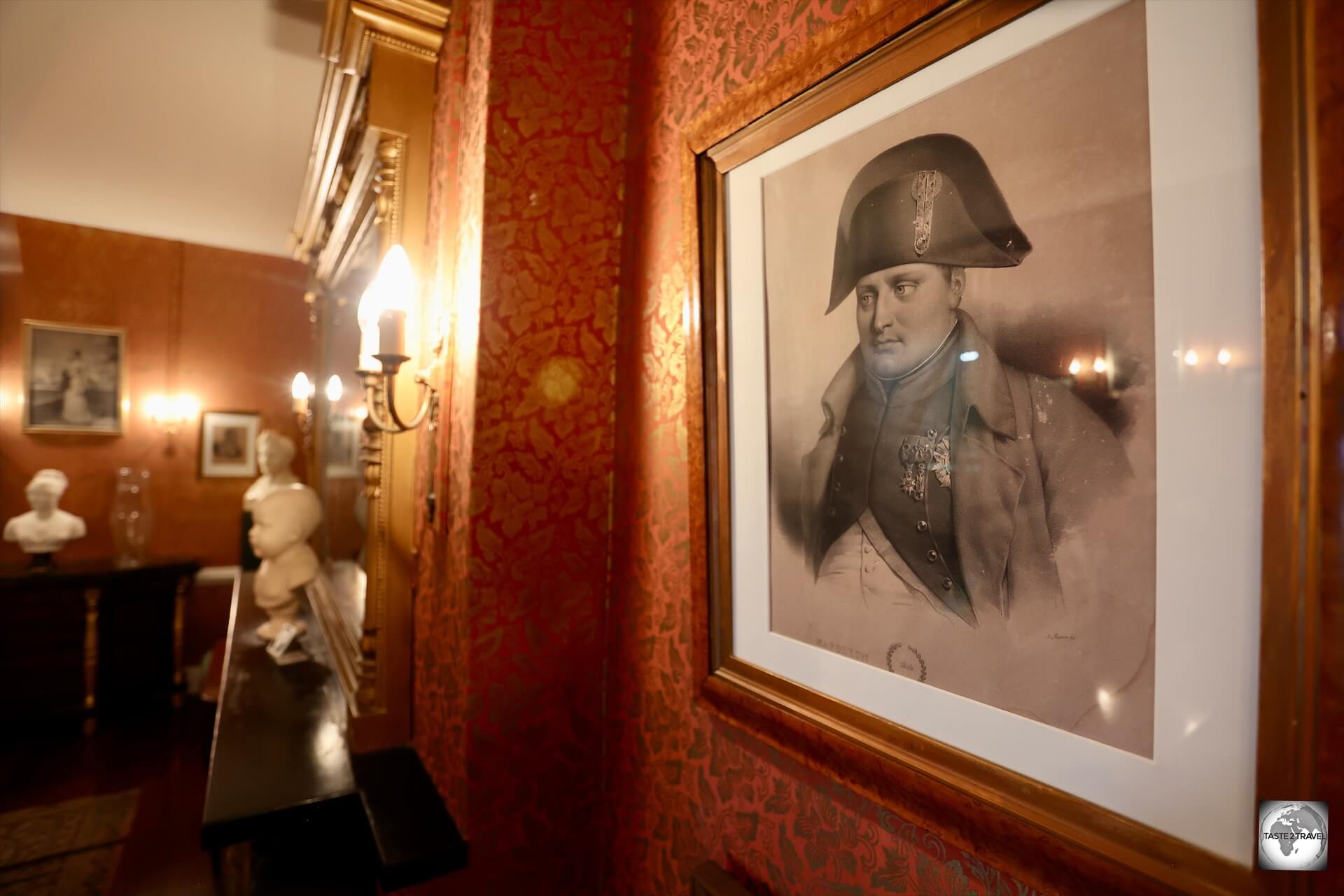
A portrait of Napoleon Bonaparte hangs on the wall of the library at Longwood House, where he was kept prisoner from 1815 until his death in 1821.
Napoleon was kept under house arrest at Longwood House, where he lived under the watchful eyes of British officials.
Napoleon died on the island in 1821, possibly from stomach cancer, though some theories suggest he may have been poisoned.
Napoleon was initially buried on Saint Helena but then transferred to Paris in 1840 where he was laid to rest in a crypt in the Hôtel des Invalides, on the banks of the River Seine, as per his dying wish.
Saint Helena has always remained under British control and, in 1981, the island became a British Overseas Territory, officially governed from London but with some degree of local autonomy.
Today, the island remains a British territory, with limited infrastructure, a limited economy and a small, tight-knit population.
Government

A map showing the location of Saint Helena, Ascension and Tristan da Cunha.
Source: Encyclopedia Britannica
Saint Helena is one of three constituent parts of the territory of Saint Helena, Ascension and Tristan da Cunha, an Overseas Territory of the United Kingdom in the southern Atlantic Ocean.
Ascension Island is located 1,300 km/ 808 mi northwest of Saint Helena, while Tristan da Cunha is situated 2,437 km/ 1,514 to the southwest.
The population of these three outposts are:
- Saint Helena – 4,500
- Ascension Island – 880
- Tristan da Cunha – 264
Did you know?
Tristan da Cunha has the distinction of being the most remote inhabited island in the world, lying approximately 2,787 kilometres (1,732 mi) from Cape Town in South Africa, 2,437 kilometres (1,514 mi) from Saint Helena, 3,949 kilometres (2,454 mi) from Mar del Plata in Argentina, and 4,002 kilometres (2,487 mi) from the Falkland Islands.
This territory was previously known as Saint Helena and Dependencies until 01 September 2009, when a new constitution came into effect giving the three islands equal status within the territory.
The three islands are governed by the one Governor who resides at Plantation House, which is located in the district of St. Paul’s on Saint Helena.
The East India Company built Plantation House between 1791 and 1792. The house was originally intended as a summer residence for the island’s governor.
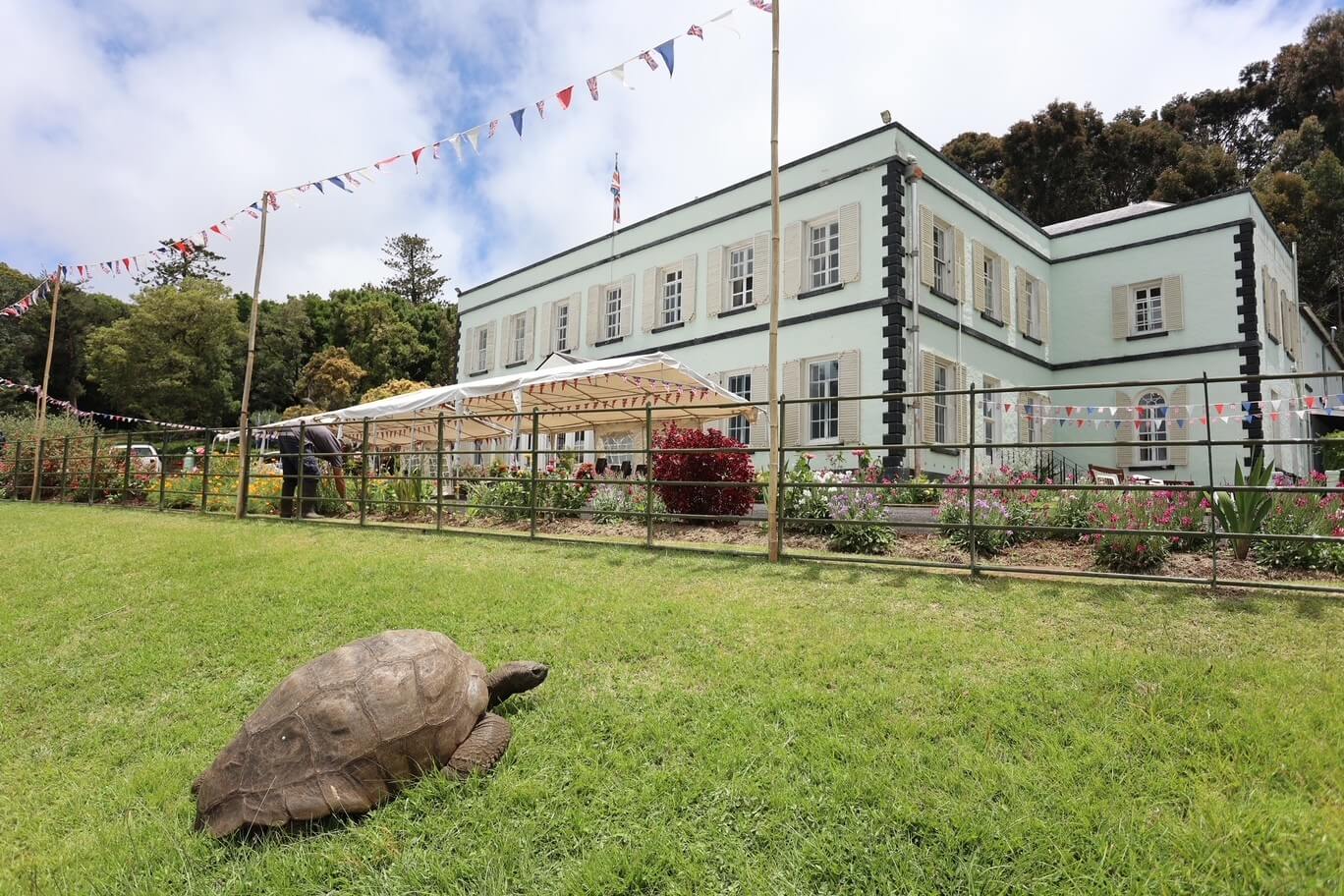
The official residence of the Governor, Plantation House, is home to Jonathan, a 193-year-old Aldabra giant tortoise from the Seychelles.
Plantation House is also home to Jonathan, a 193-year-old Aldabra giant tortoise from the Seychelles, who is a star attraction on Saint Helena.
The Governor’s Office is located within The Castle, which is located on the waterfront in Jamestown.

The Governor’s car, parked outside The Castle in Jamestown.
The territory was governed by the East India Company from its initial colonisation in 1659 to the end of company rule in 1834.
Following on from St Helena becoming a crown colony in 1834, subsequent governors have been appointed by the crown.
People
The people of Saint Helena, known as “Saints,” are a small, diverse, and friendly community.
The island’s population is around 4,500 people, with the community being comprised of a mix of various ethnic groups, including:
- British: As a British Overseas Territory, many of the residents have British ancestry.
- African: Many people on the island have African heritage, descendants of enslaved people brought to the island during the colonial era.
- Chinese and Indian: There are also people of Chinese and Indian descent, reflecting laborers brought to the island in the 19th century.
The unique population mix is the result of the island’s history as a British colony and its location as a stopover for ships during the age of exploration and trade.
The result is a multicultural society with influences from Europe, Africa, and Asia.
The official language is English, and it is spoken with a distinct Saint Helenian dialect that reflects influences from various cultures.
Christianity is the dominant religion, with most people identifying as Anglican, which aligns with the Church of England.
However, there are also other Christian denominations, including Roman Catholics, Baptists, and Seventh-day Adventists.
Due to the island’s isolation and small population, the community is tightly knit, with many people knowing one another.
Hospitality and friendliness are highly valued.
Many people are involved in fishing, farming, and government work. However, tourism is increasingly important, especially after the opening of the island’s airport in 2017.
Life on Saint Helena tends to be slower-paced and more relaxed compared to most other places.
The Saint Helena Independent
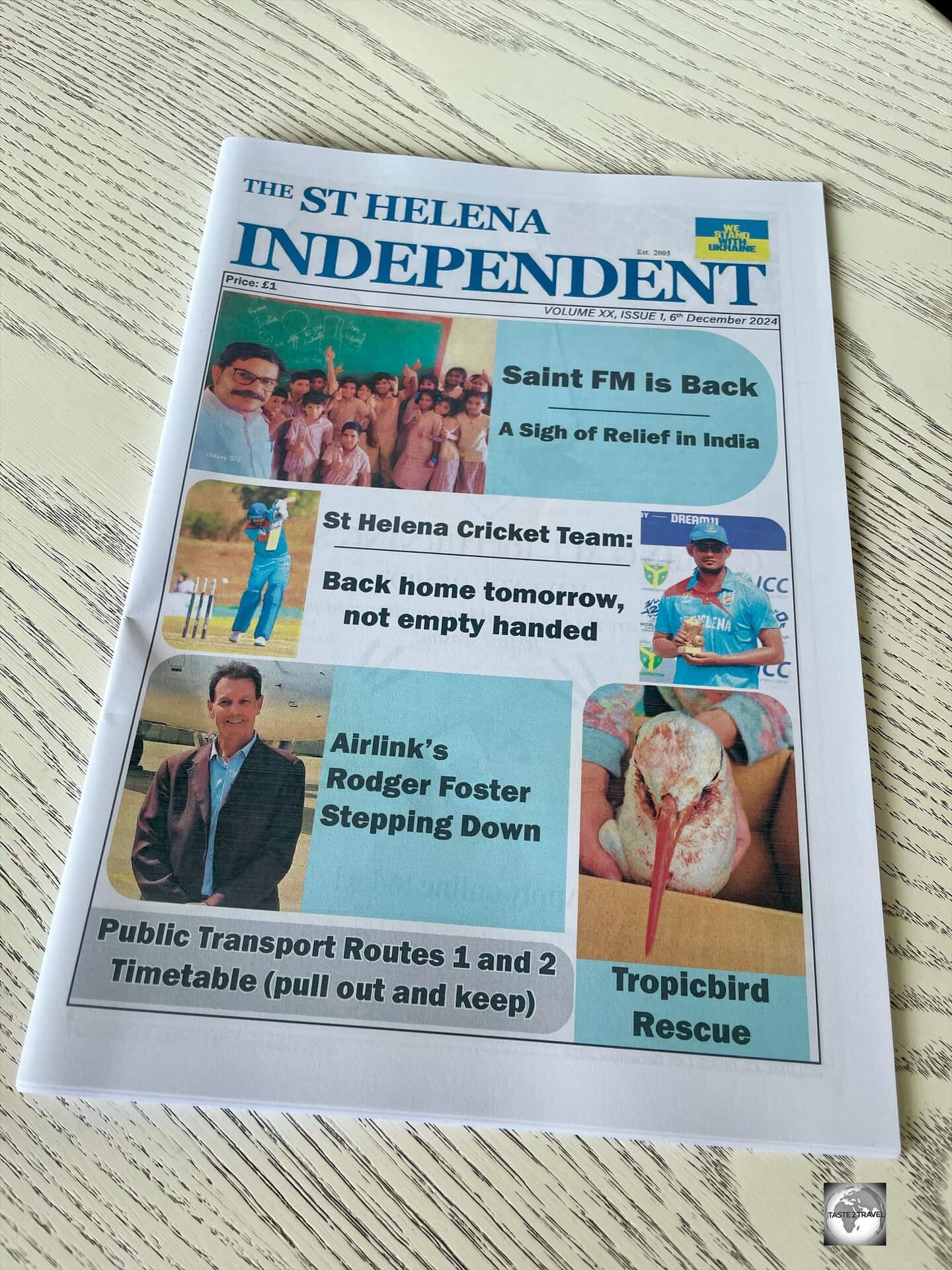
Published once a week, The Saint Helena Independent is the only newspaper on the island.
The one newspaper on Saint Helena is The Saint Helena Independent which is published once a week and is available for download every Friday.
I was interviewed by the editor, Vince Thompson, and appear on page 9 of the 13th of December issue.
I do caution that the photo of me, which Vince took in the local pub while we were enjoying a few beers, is less than flattering.
Birdlife

Saint Helena is a refuge for many sea birds, including these two White terns.
Saint Helena Island is home to a diverse array of bird species.
Due to its isolation, the island has developed a unique ecosystem, with several endemic species, as well as migratory birds that stop by during their journeys.
The island’s birdlife includes a mix of seabirds, landbirds, and species that are found nowhere else in the world, including the Saint Helena Plover and the Saint Helena wirebird which appears on the island’s coat of arms.
After a week of driving on Saint Helena, searching for the elusive wirebird, I was unable to find one.
I was, however, able to find numerous seabirds such as White terns which nest in the numerous pine trees on the island. They seem to especially like Norfolk Island pine trees.
While on Norfolk Island on a previous trip, I was able to photograph numerous White terns in the towering pine trees which line the island.
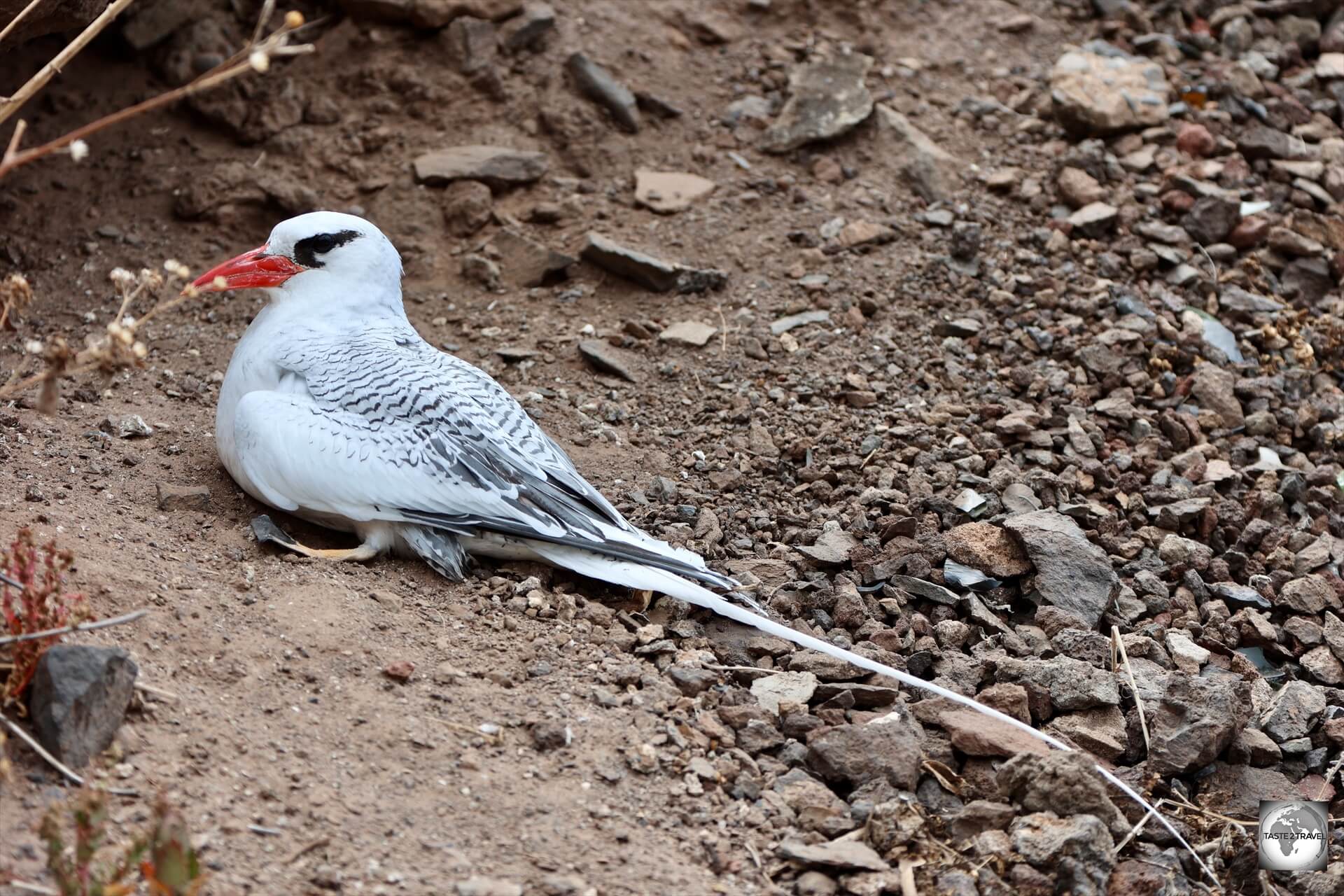
A Red-billed tropicbird, nesting on the cliff above Jamestown.
The cliffs which surround Jamestown are a favourite nesting site for the Red-billed tropicbird.
While climbing Jacob’s Ladder, I was able to photograph one tropicbird up close, who had built its nest next to the ladder.
Over the centuries, many birds have been introduced to Saint Helena, including the common waxbill, also known as the St Helena waxbill, which is native to sub-Saharan Africa.
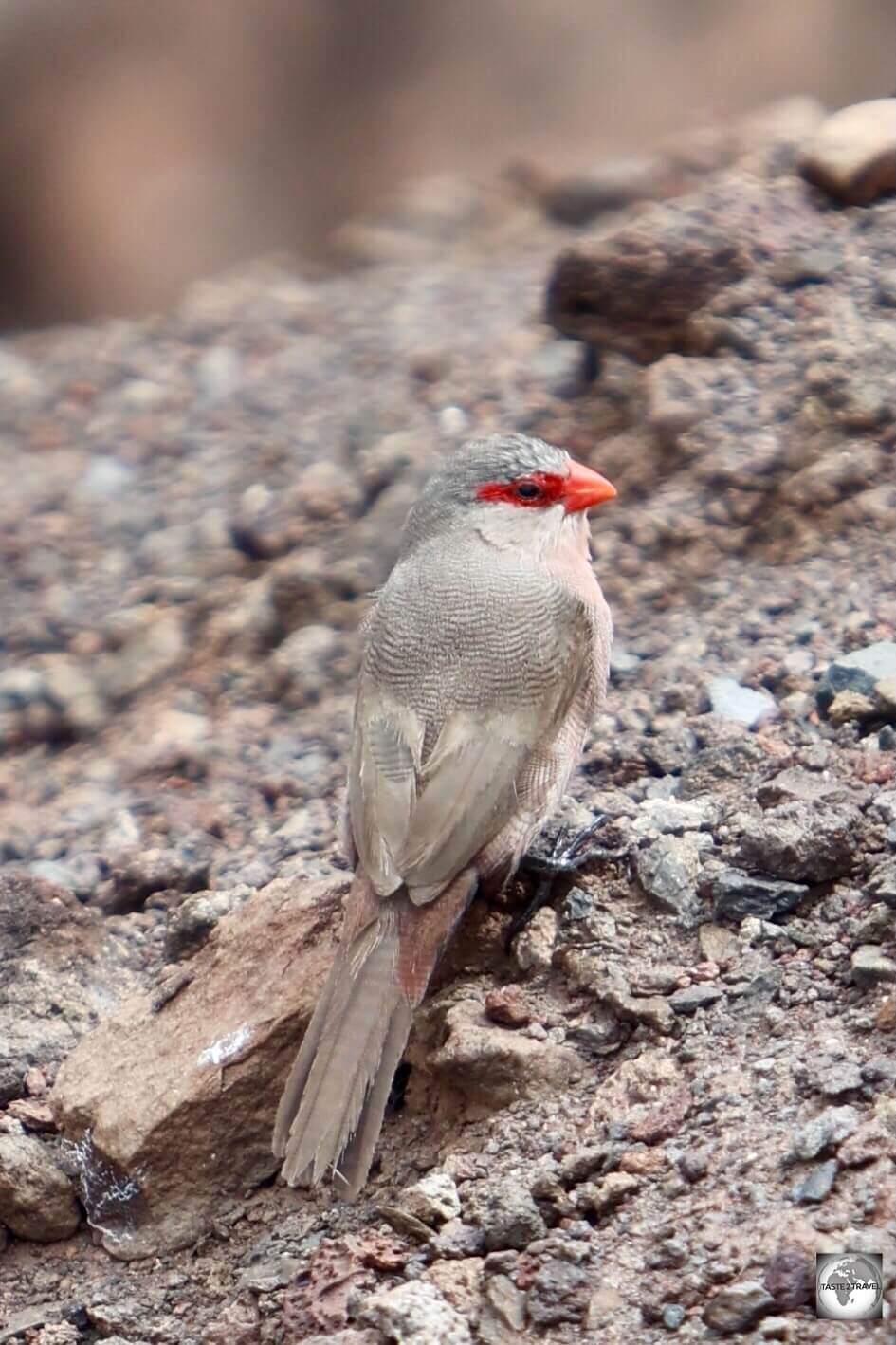
The Common waxbill, also known as the St Helena waxbill.
Flag

The flag of Saint Helena which features the endemic Wirebird.
The flag of Saint Helena is a Blue Ensign with the Union Jack in the upper hoist corner (top left), symbolising its status as a British Overseas Territory.
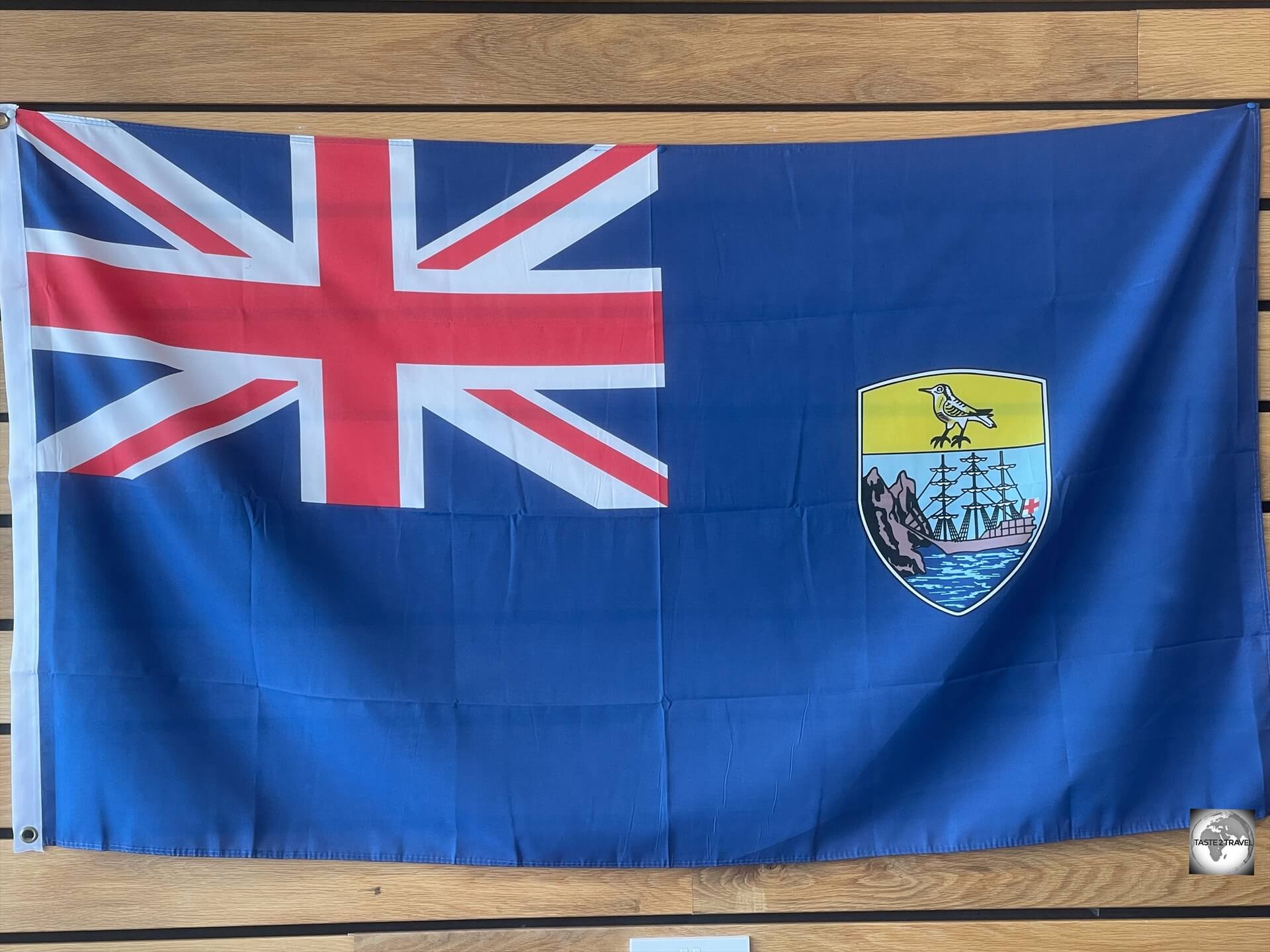
The flag of Saint Helena features the territory’s coat of arms.
The distinguishing feature of the flag is the Saint Helena Coat of Arms displayed on the right side of the blue field.
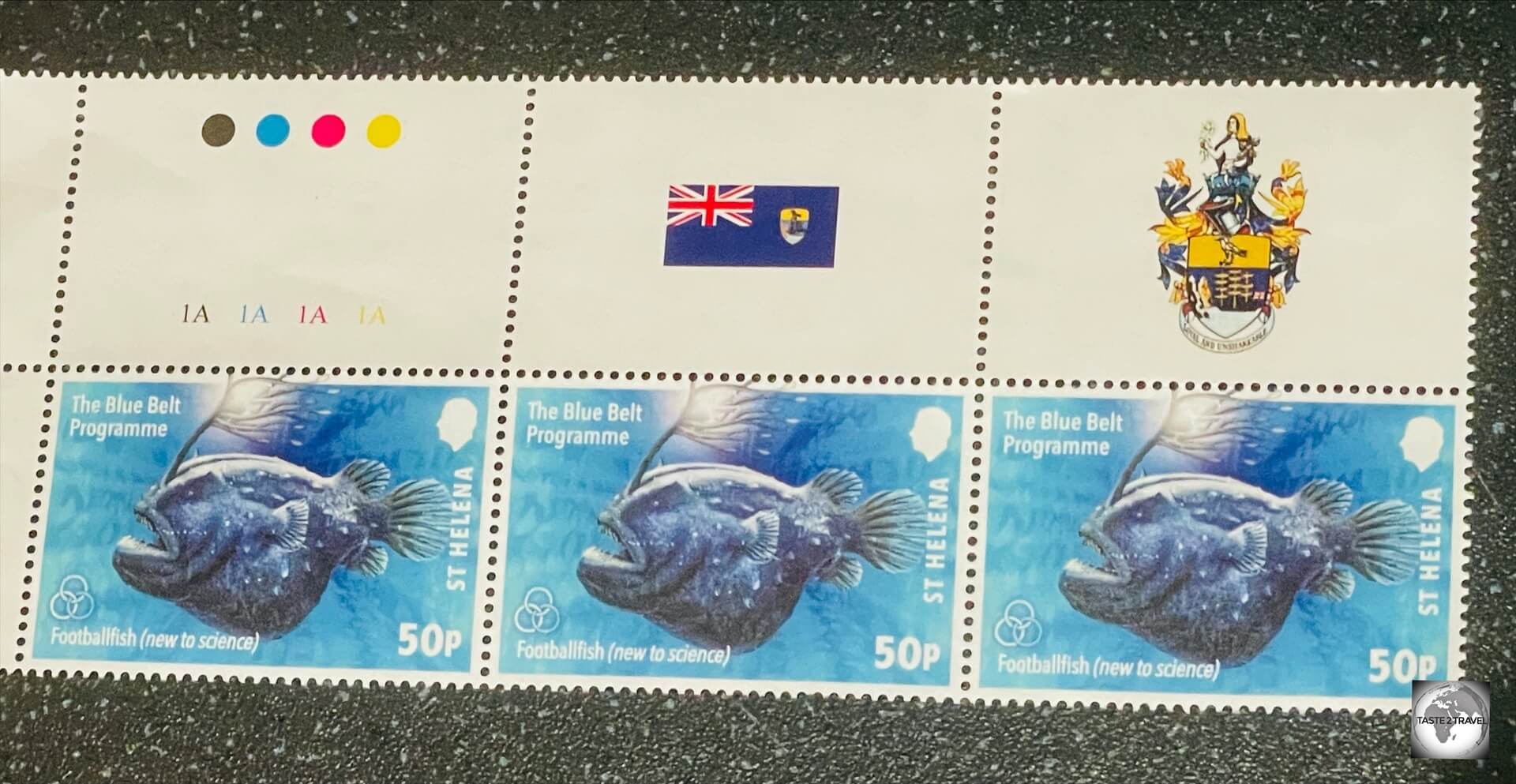
I purchased these stamps which feature the flag of Saint Helena and the coat of arms.
The coat of arms features a Saint Helena plover on a yellow field.
Popularly referred to by Saint Helenians as the wirebird, it is the last species of bird that is endemic to the island, and is the official bird of Saint Helena.
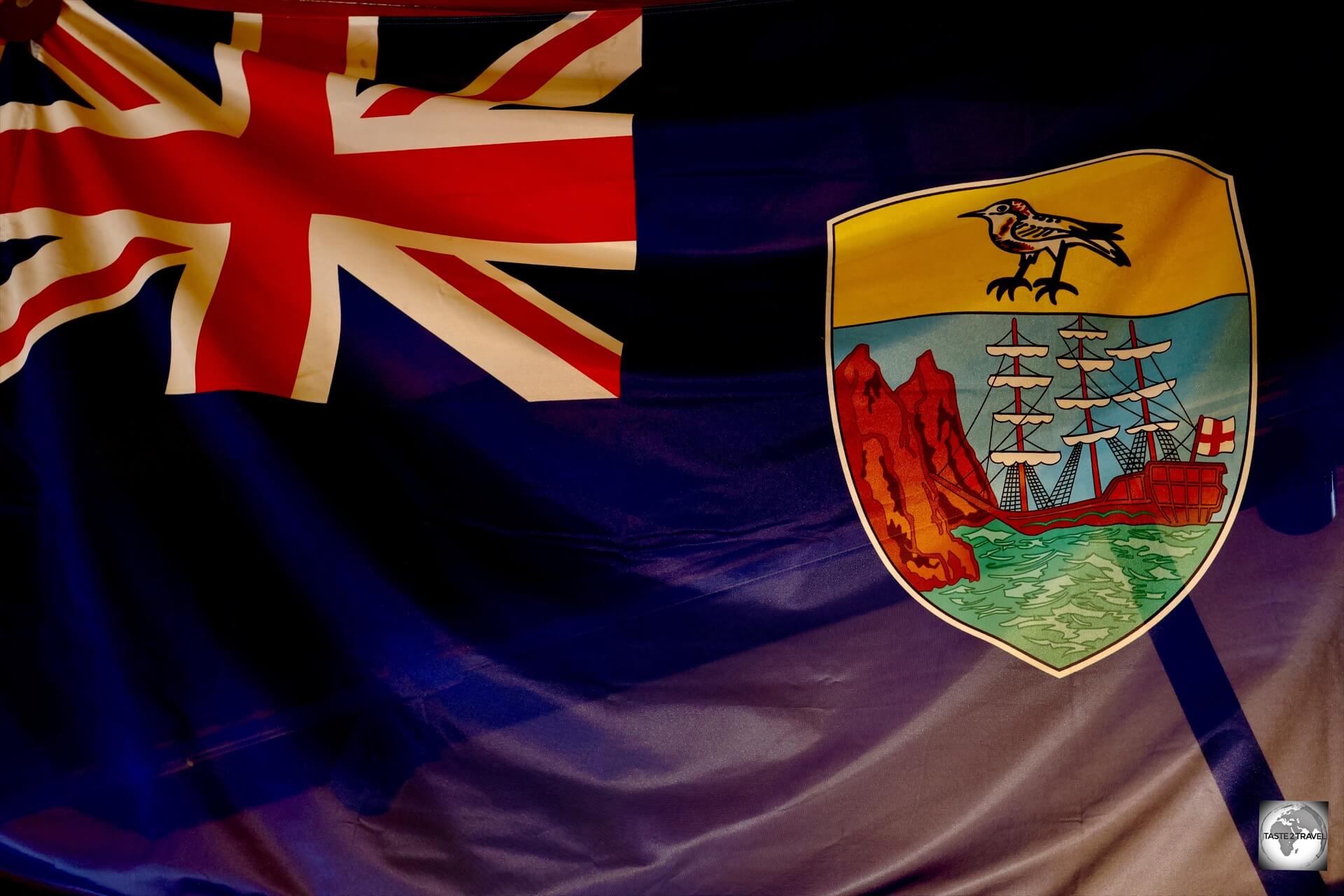
The flag of Saint Helena at the Museum of Saint Helena in Jamestown.
Also featured is a three-masted sailing ship, an East Indiaman, which was the general name for any merchant ship operating under charter or licence to the East India Company.
The ship is flying the Cross of Saint George which is a symbol of the Kingdom of England, Saint Helena’s mother country.
Also featured are rocky cliffs, which comprise the coast of volcanic Saint Helena.
Did you Know?
Saint Helena’s flag is similar to the flags of eight other British Overseas Territories, which are also Blue Ensigns with their respective coats of arms.
Those territories include (click the links to view my travel guides):
- Anguilla
- British Virgin Islands
- Cayman Islands
- Falkland Islands
- Montserrat
- Pitcairn Islands
- South Georgia and the South Sandwich Islands
- Turks and Caicos Islands
Philately
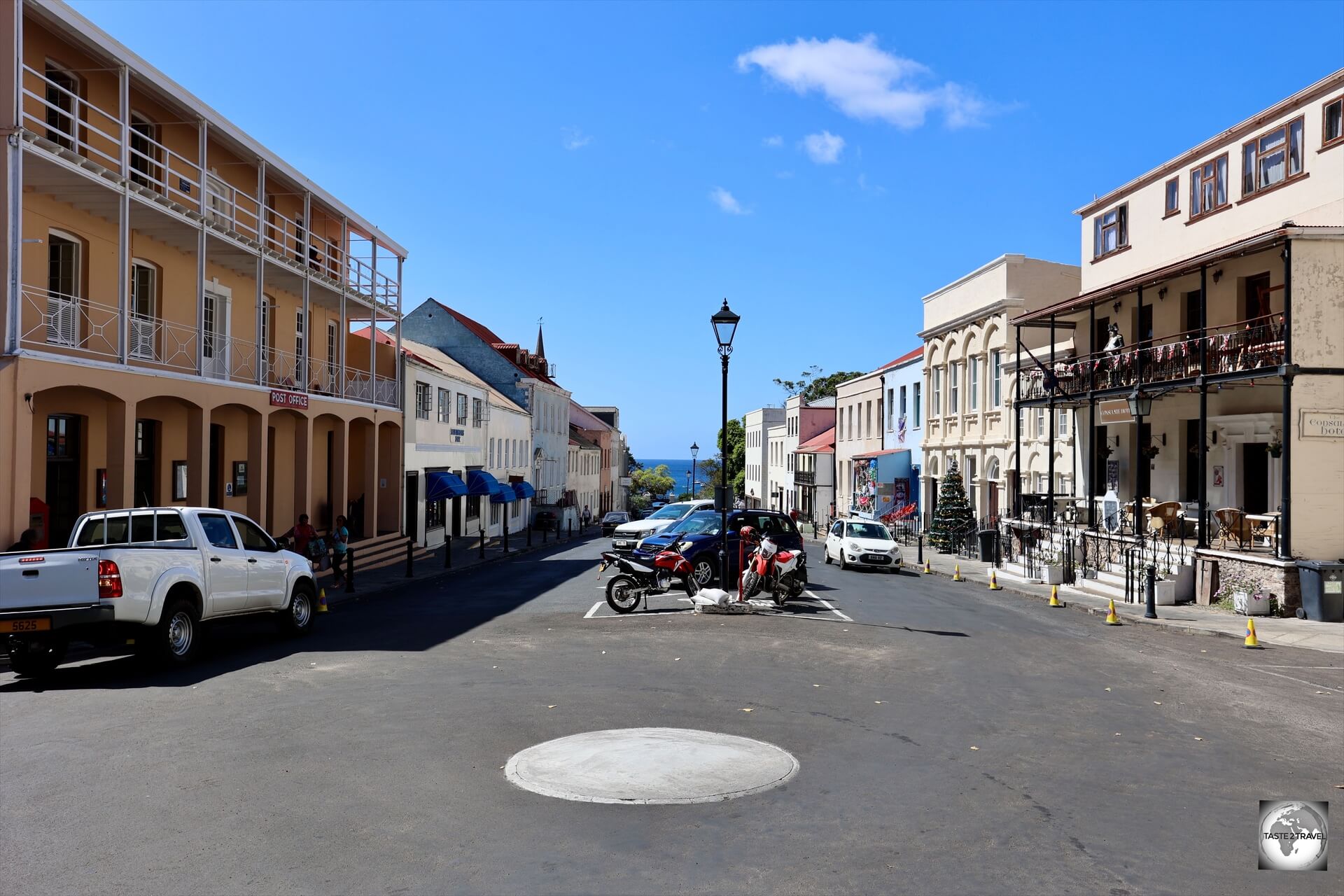
A view of the main street of Jamestown, with the large post office building on the left.
The stamps of Saint Helena are known for their beautiful and detailed designs, often reflecting the island’s rich history, unique geography, and diverse flora and fauna.
The only post office on Saint Helena, which has a commanding presence on the main street of Jamestown, provides a variety of philatelic items for collectors.
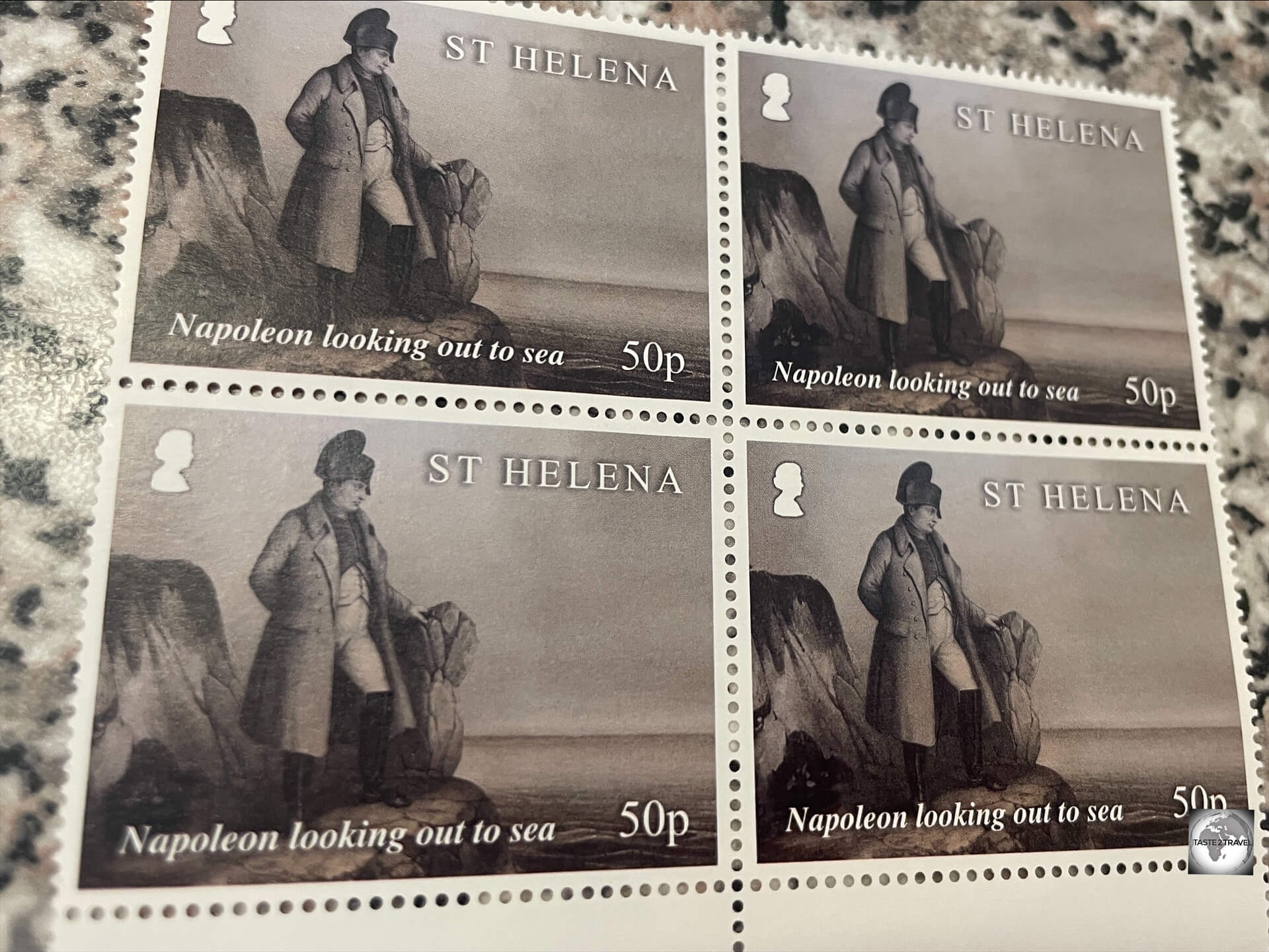
Available from the post office in Jamestown, the stamps of Saint Helena feature major historical events.
Saint Helena stamps frequently depict Napoleon Bonaparte, who was exiled on the island from 1815 until his death in 1821.
Various stamps commemorate his time on the island, including his residence at Longwood House and his tomb.
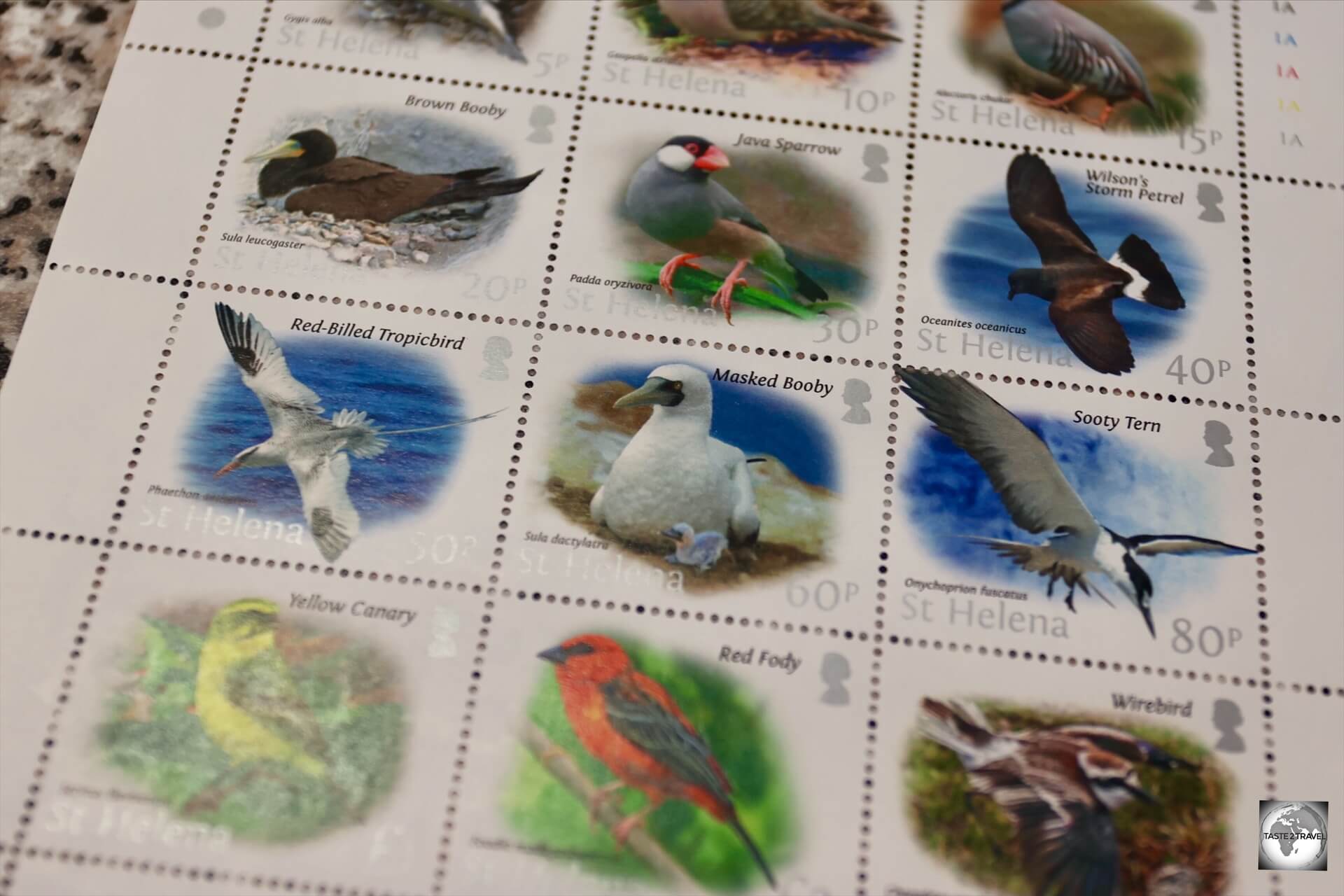
The stamps of Saint Helena feature the many different birds which can be found on the island.
The island’s unique ecosystem, including rare and endangered species, is frequently featured.
Stamps show local wildlife such as the Saint Helena plover (wirebird), the island’s national bird.
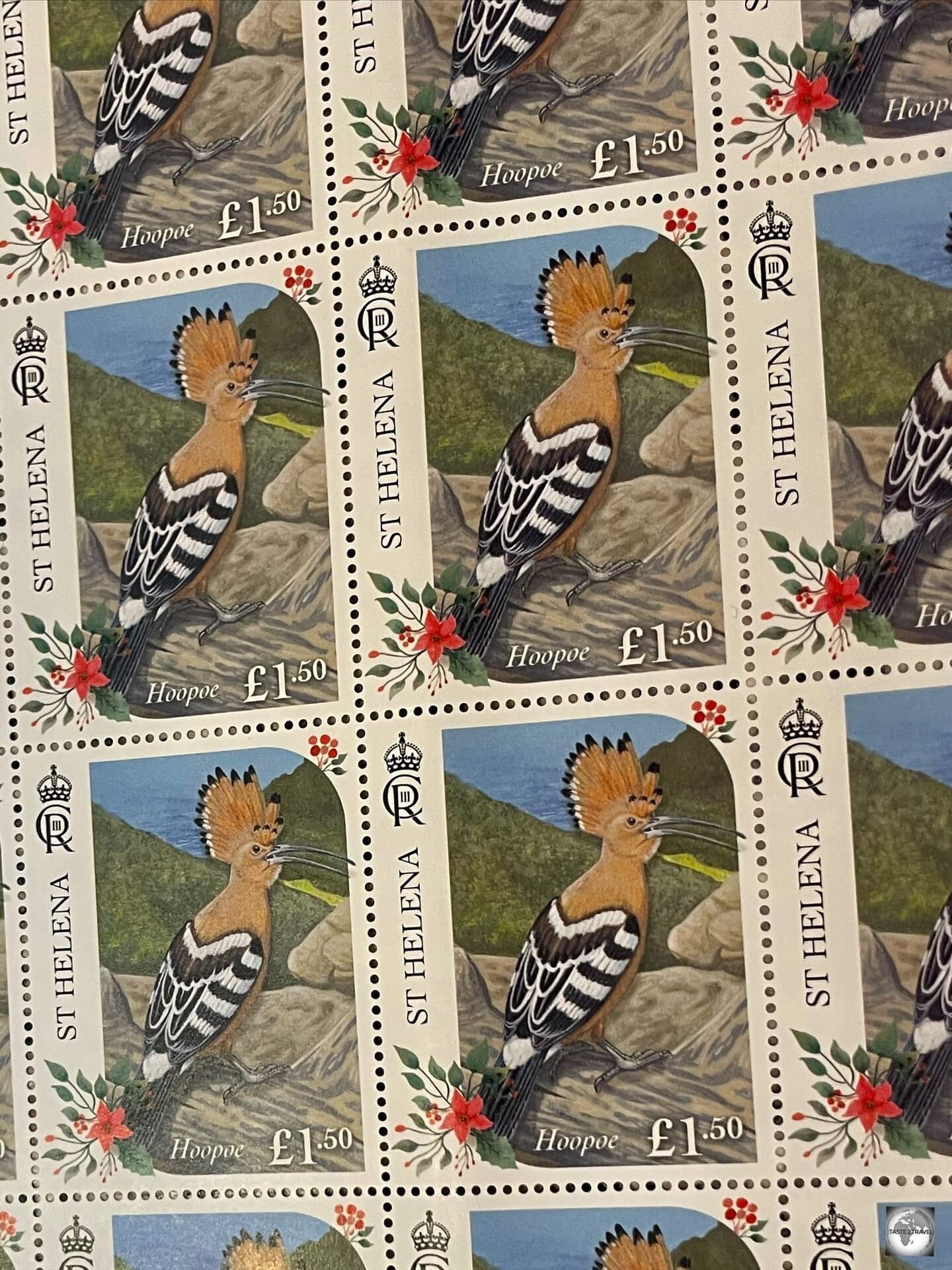
The Hoopoe is an extinct land bird which is featured on a recent issue of stamps.
Birds are another popular theme with a recent issue featuring four extinct land birds, including the funky looking Hoopoe.

The stamps of Saint Helena feature the rich marine life which can be found in the waters which surround the island.
Details of the latest stamp issues are published on the Saint Helena Government website, with one recent issue featuring different marine creatures which were found in the waters around Saint Helena during a marine survey known as “The Blue Belt Programme”.
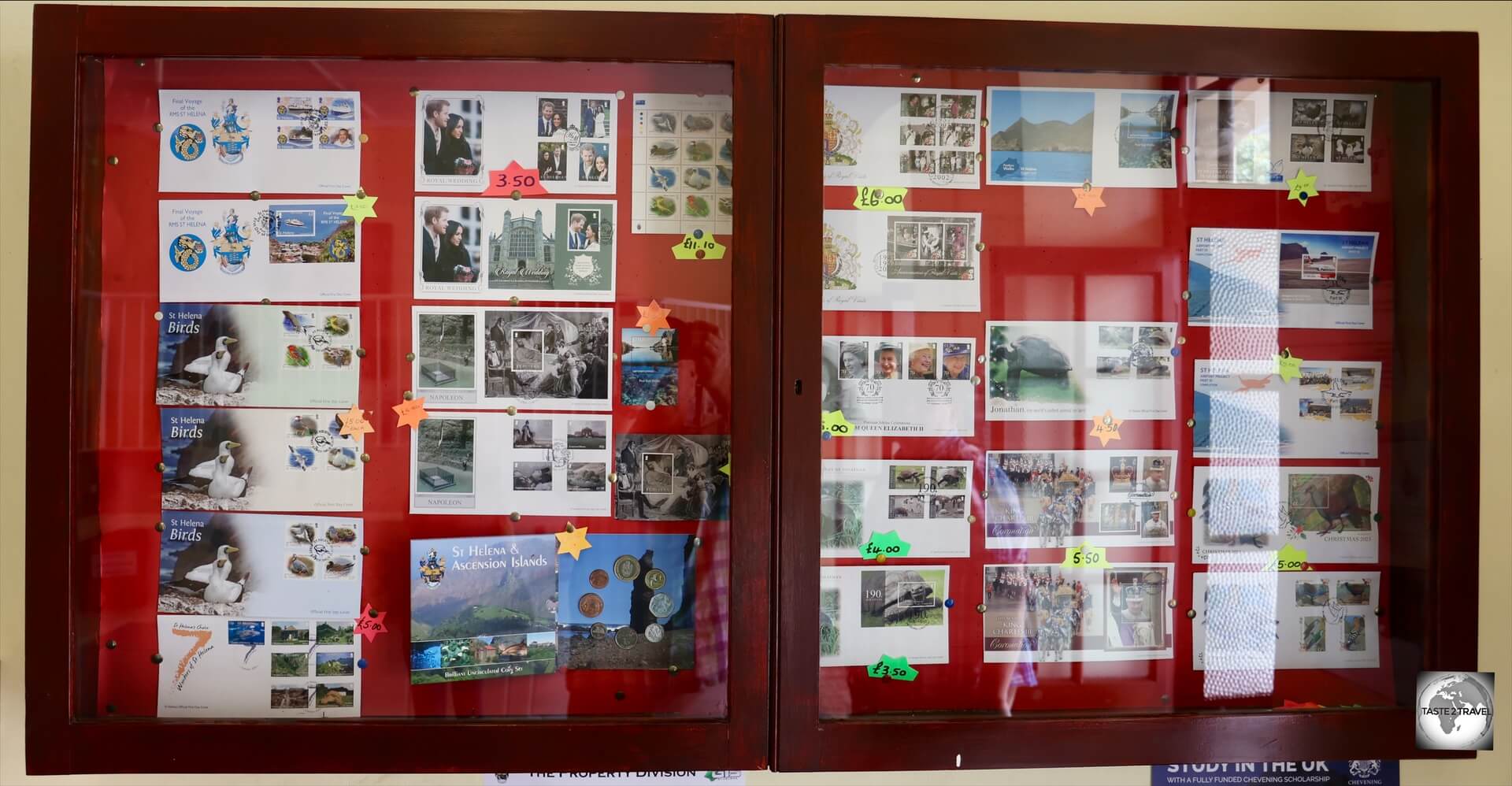
A display of philatelic items, at the post office in Jamestown.
Unfortunately, the post office does not offer online sales, however, there are plenty of websites where you can purchase Saint Helena stamps online.
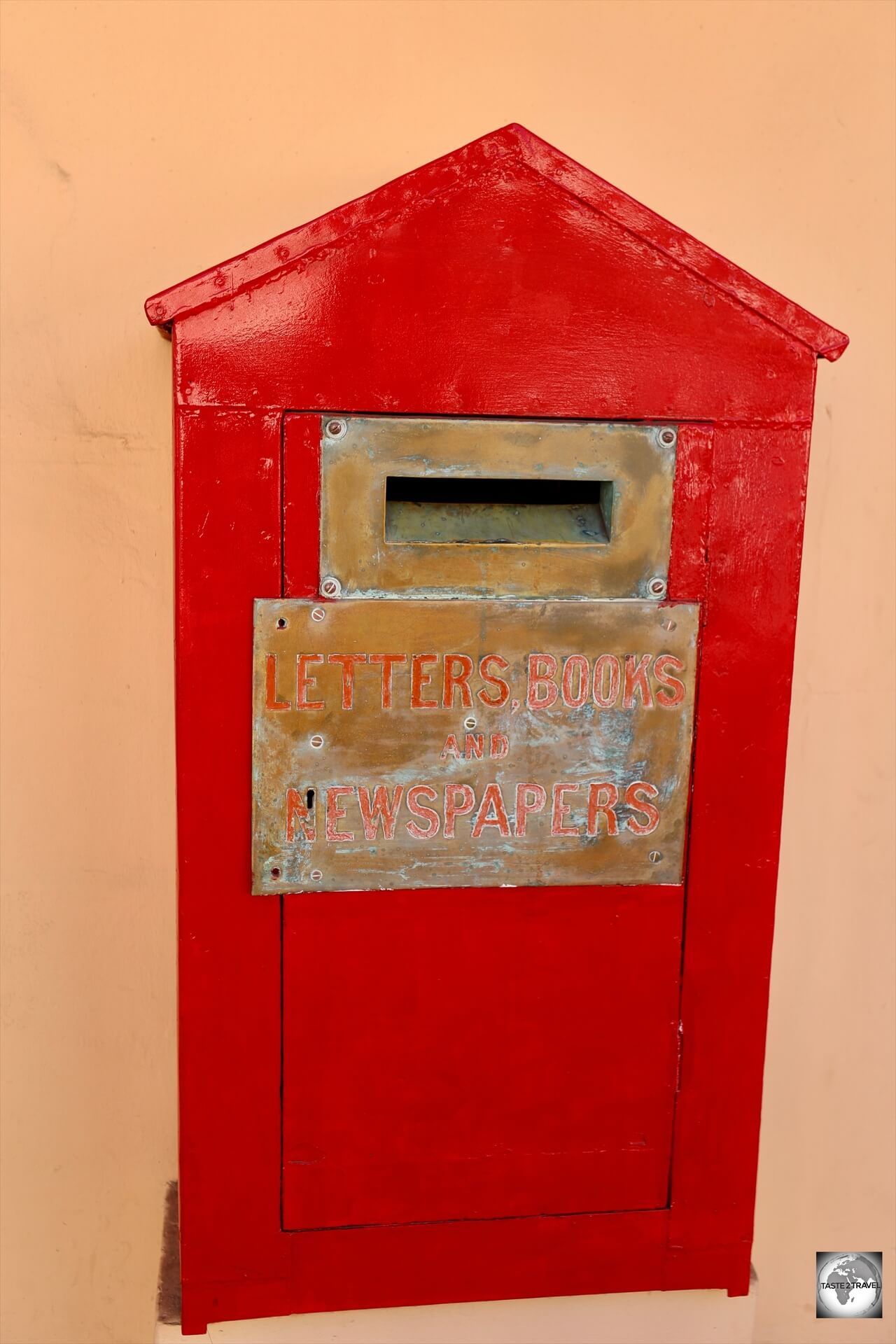
The post box at Jamestown post office.
The post office also sells a selection of postcards which can be posted in the red post box which is installed in the front outside wall.
Internet/ WiFi
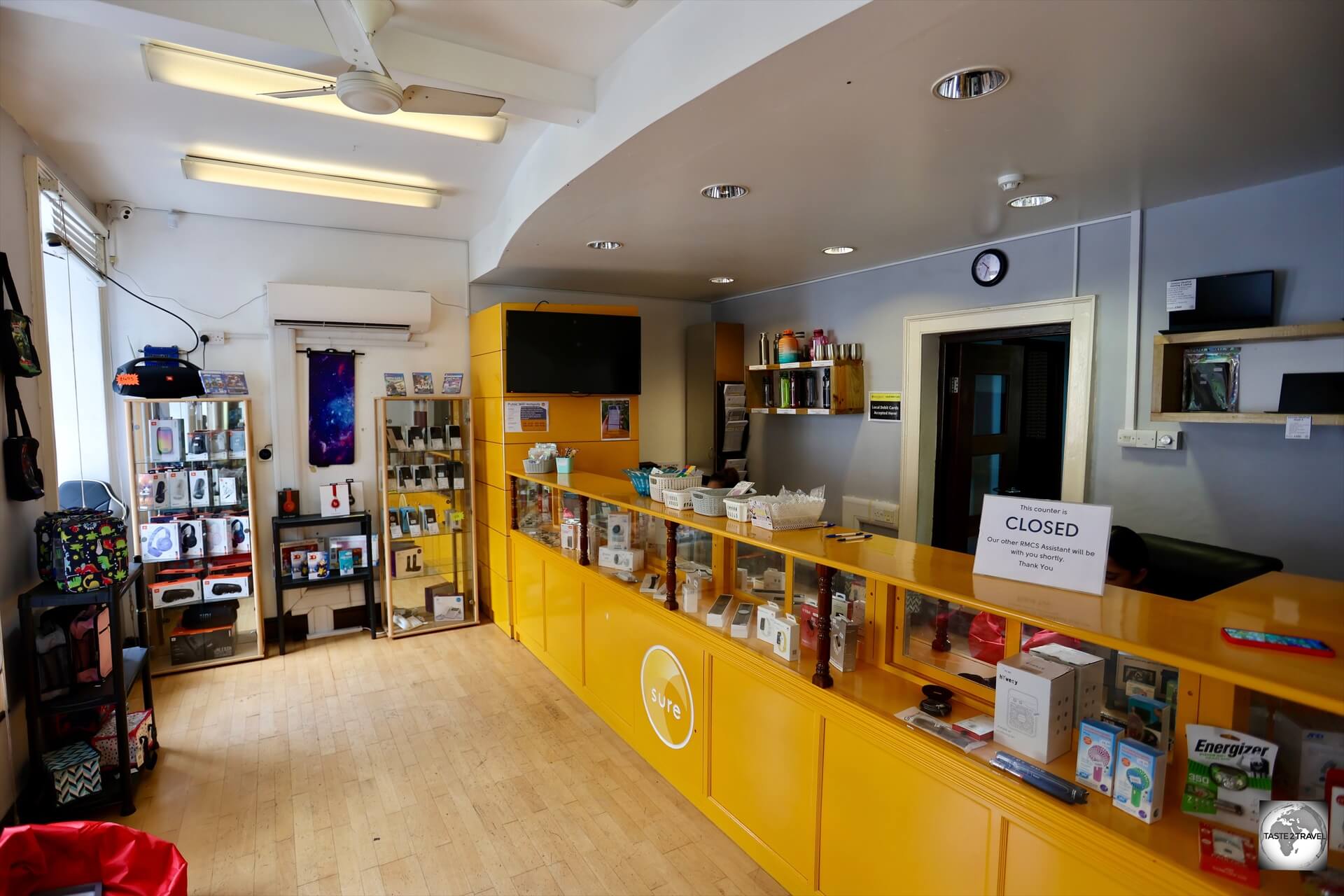
The office of Sure Services in Jamestown, where you can purchase a local SIM card.
Internet/ WiFi services on Saint Helena are provided by Sure Services who have their office on the main street in Jamestown (opposite the post office).
SIM cards cost £16.50 which includes £10 of credit, which was ample to cover my needs for my one week on Saint Helena and allowed me to use google navigation while driving around the island. That’s a must if driving!
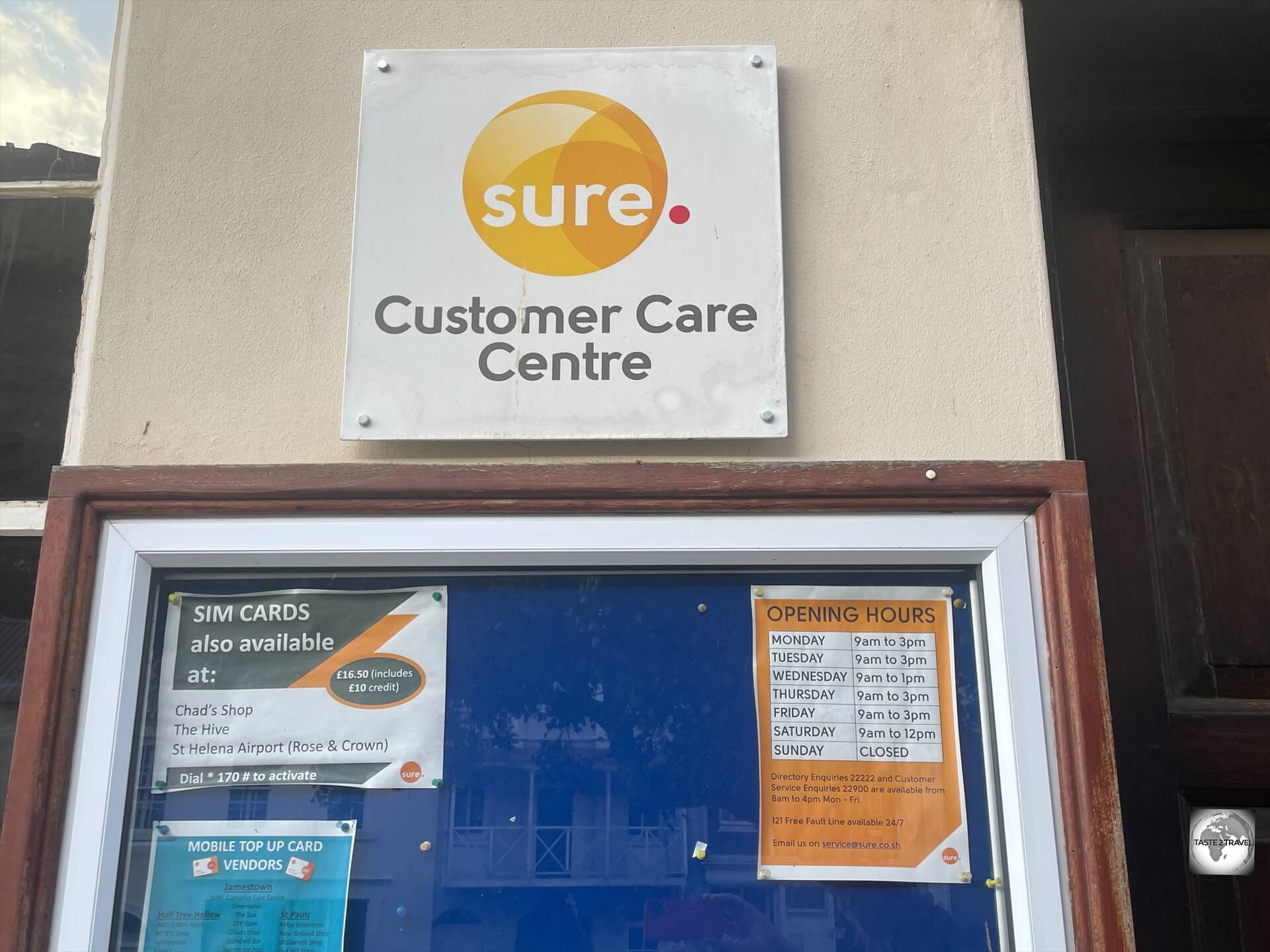
Local SIM cards can also be purchased from Chad’s Shop, The Hive and at Saint Helena Airport.
The internet service is painfully slow and very patchy once outside of Jamestown.
Sure Services are currently the only telecommunication services provider on the Falkland Islands, Saint Helena, Ascension Island and Diego Garcia.
Currency

The official currency of Saint Helena is the Saint Helena pound (SHP).
The official currency of Saint Helena is the Saint Helena pound, which trades under the international currency symbol of SHP.
It is pegged at par to the British pound sterling (GBP), meaning the two currencies are of equal value and can be used interchangeably on the island.
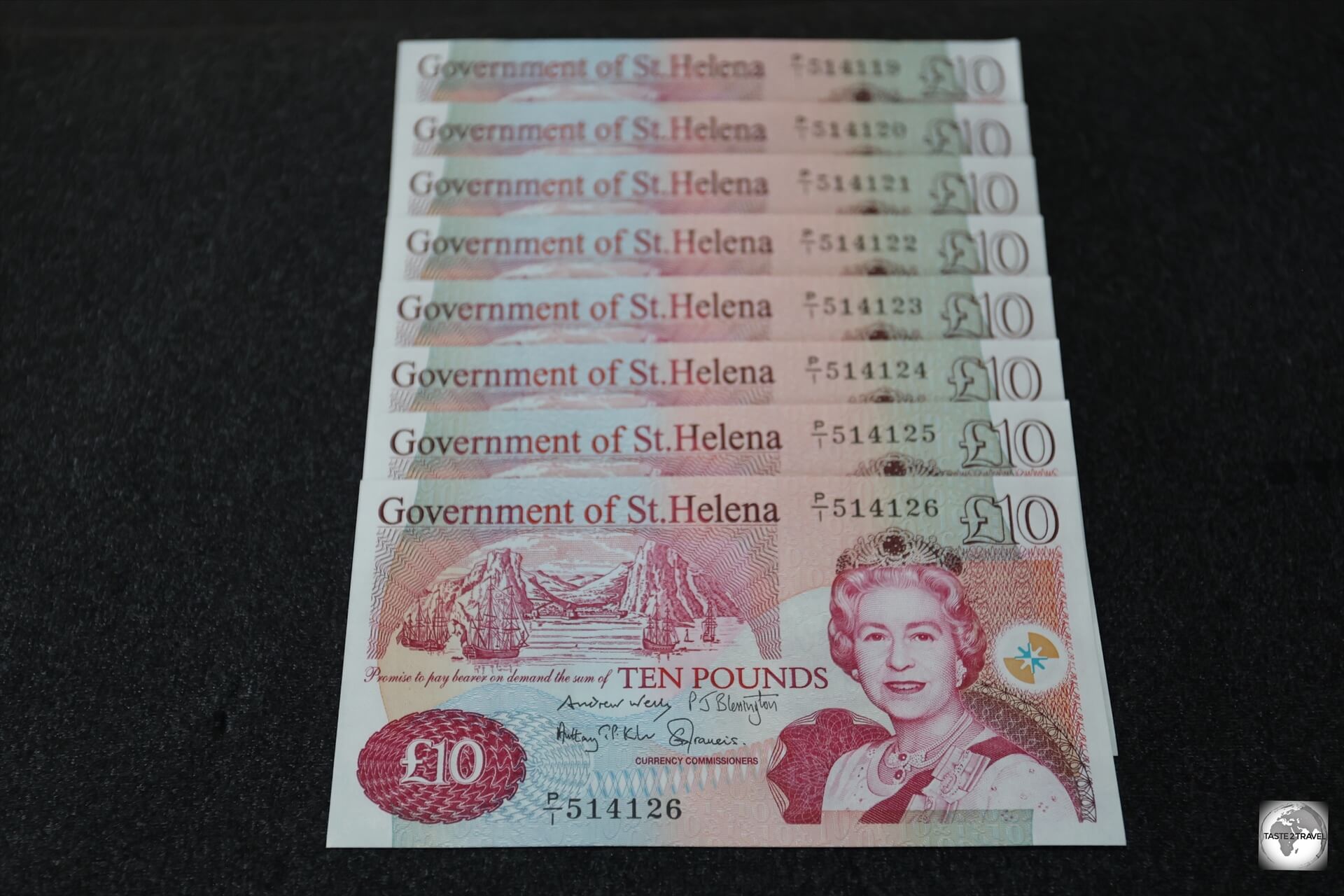
My uncirculated Saint Helena £10 banknotes, in numerical order, which I obtained from the Bank of Saint Helena.
The Saint Helena pound is the official currency of St. Helena and Ascension Island, two of the three South Atlantic islands that comprise the British territory of Saint Helena, Ascension, and Tristan da Cunha.
The official currency of Tristan da Cunha is the British pound sterling.
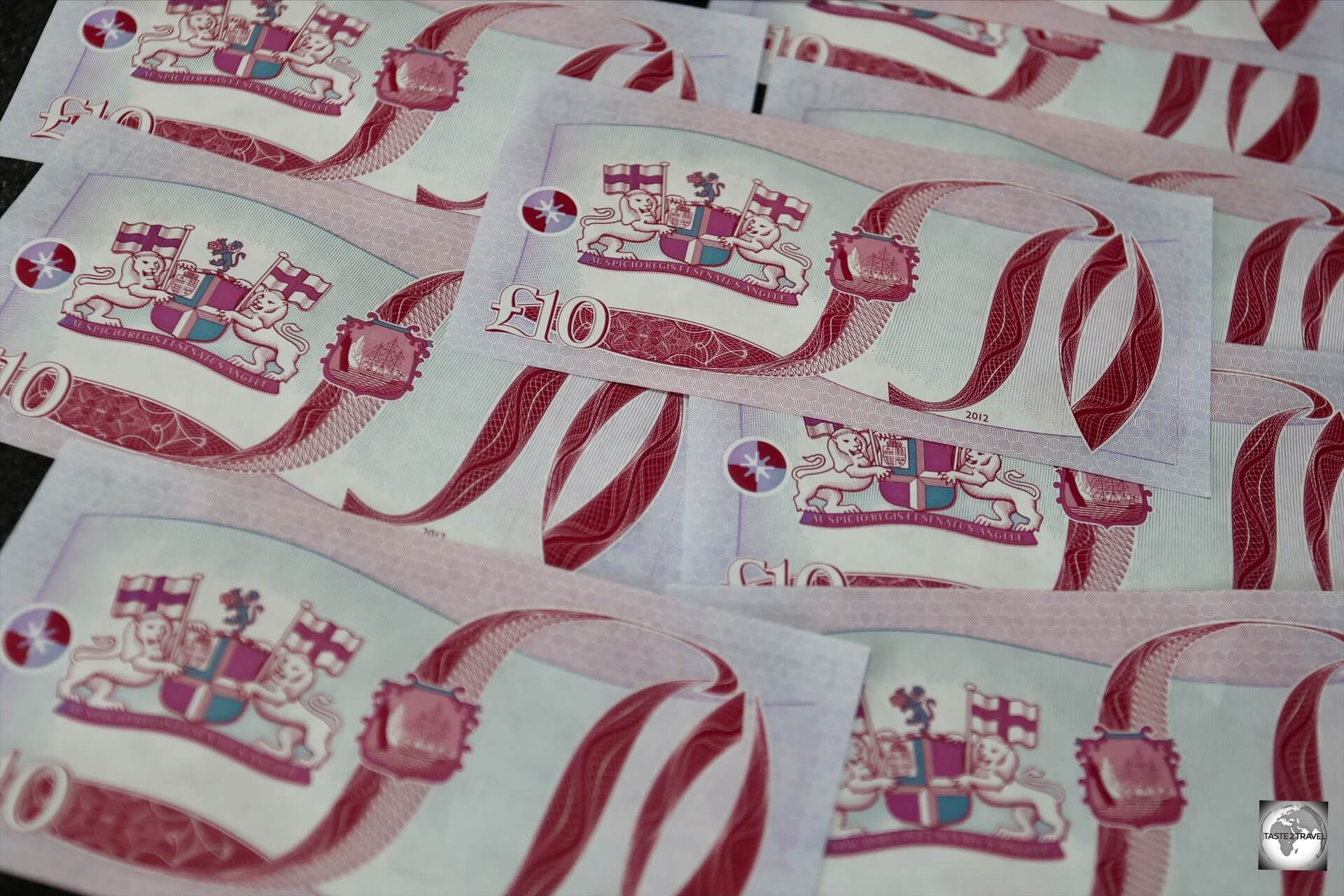
The obverse side of the Saint Helena pound banknote features only a design, no serial numbers of other markings.
Key facts about the Saint Helena pound:
- Symbol: £
- Subunit: The Saint Helena pound is divided into 100 pence.
- Banknotes and Coins: Saint Helena issues its own banknotes and coins, which feature local designs and imagery unique to the island. However, British currency is also widely accepted.
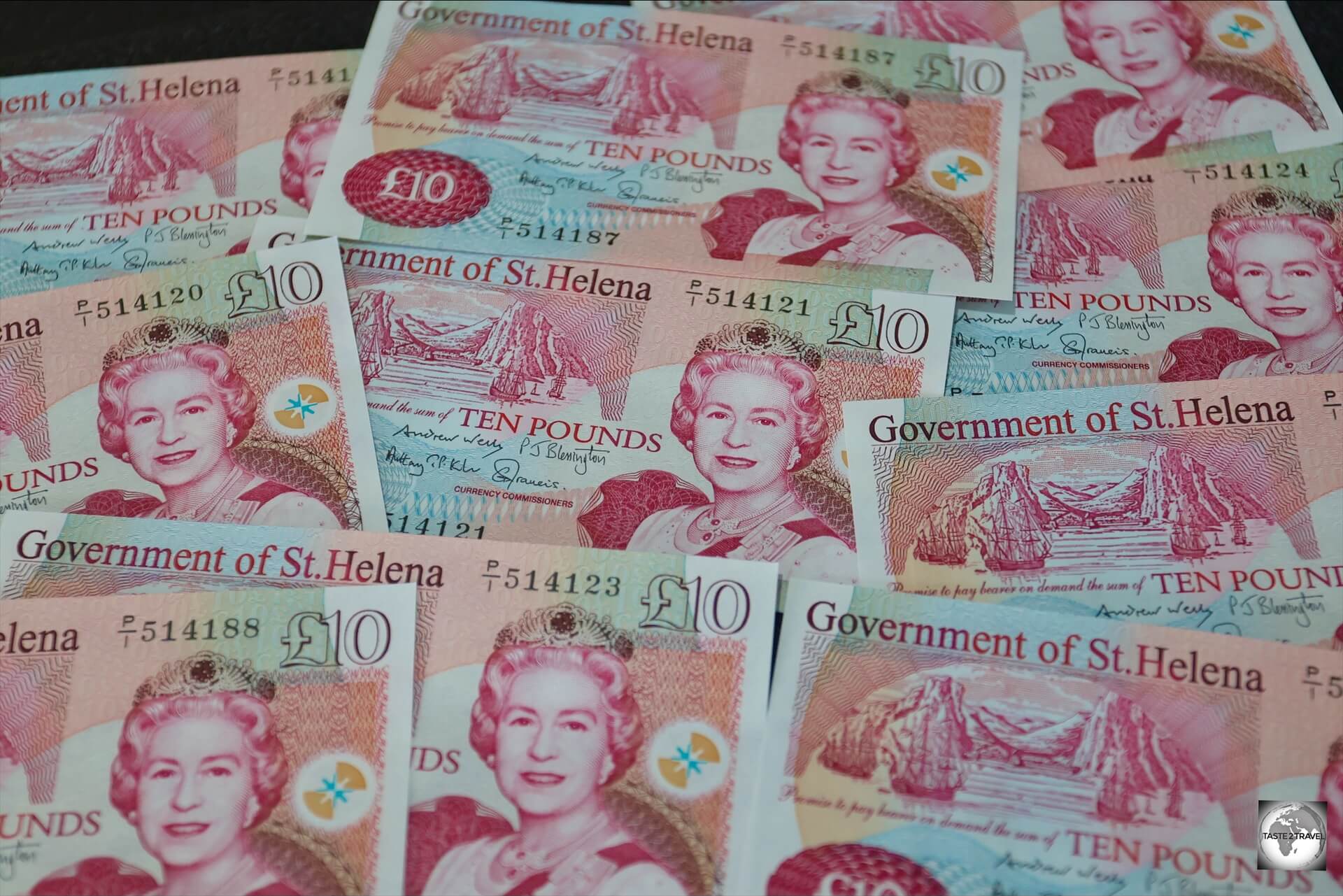
Saint Helena pounds are not accepted in the UK or other countries.
While British pounds can be used on Saint Helena, the reverse is not true, i.e. Saint Helena pounds are not accepted in the UK or in any other country.
One sad aspect of the currency is that all £5 banknotes are in terrible condition with only heavily used, poor-quality paper notes in circulation. Most notes are scrunched, shabby, dirty, ripped and torn.
I asked for new £5 banknotes at the Bank of Saint Helena and was told that no new notes have been issued in many years and nor will any new notes be issued anytime soon.
The next new bank notes to be issued will be the ‘King Charles III’ series, although no one was able to say when these would be issued.
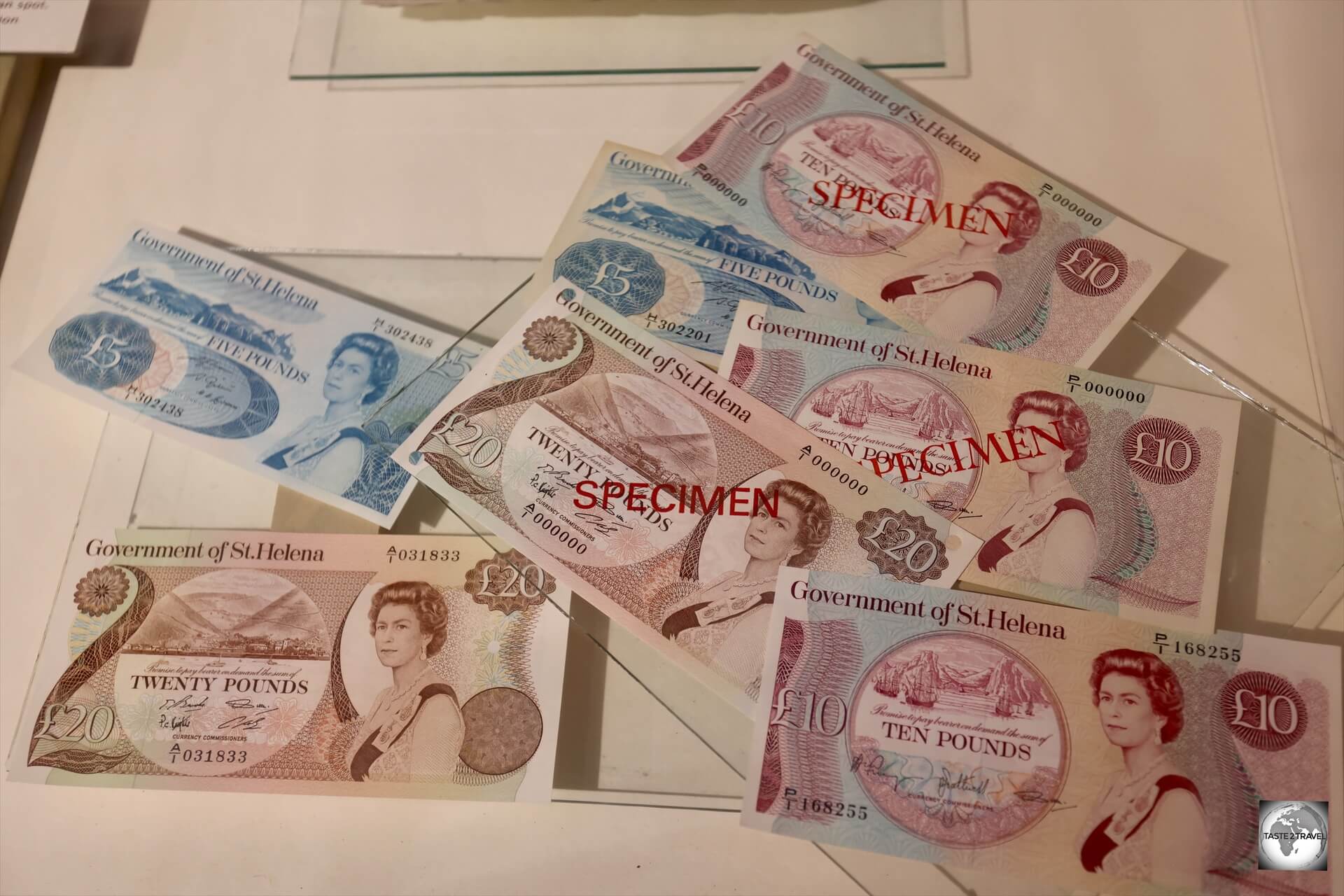
A display of former Saint Helena banknotes at the Saint Helena Museum in Jamestown.
Important:
It is imperative that you convert any remaining SHP into another currency before leaving Saint Helena, since you are unable to convert this currency once off-island.
There is a branch of the Bank of Saint Helena at the airport where you can convert any remaining SHP into GBP or South African Rand.
Banking Services
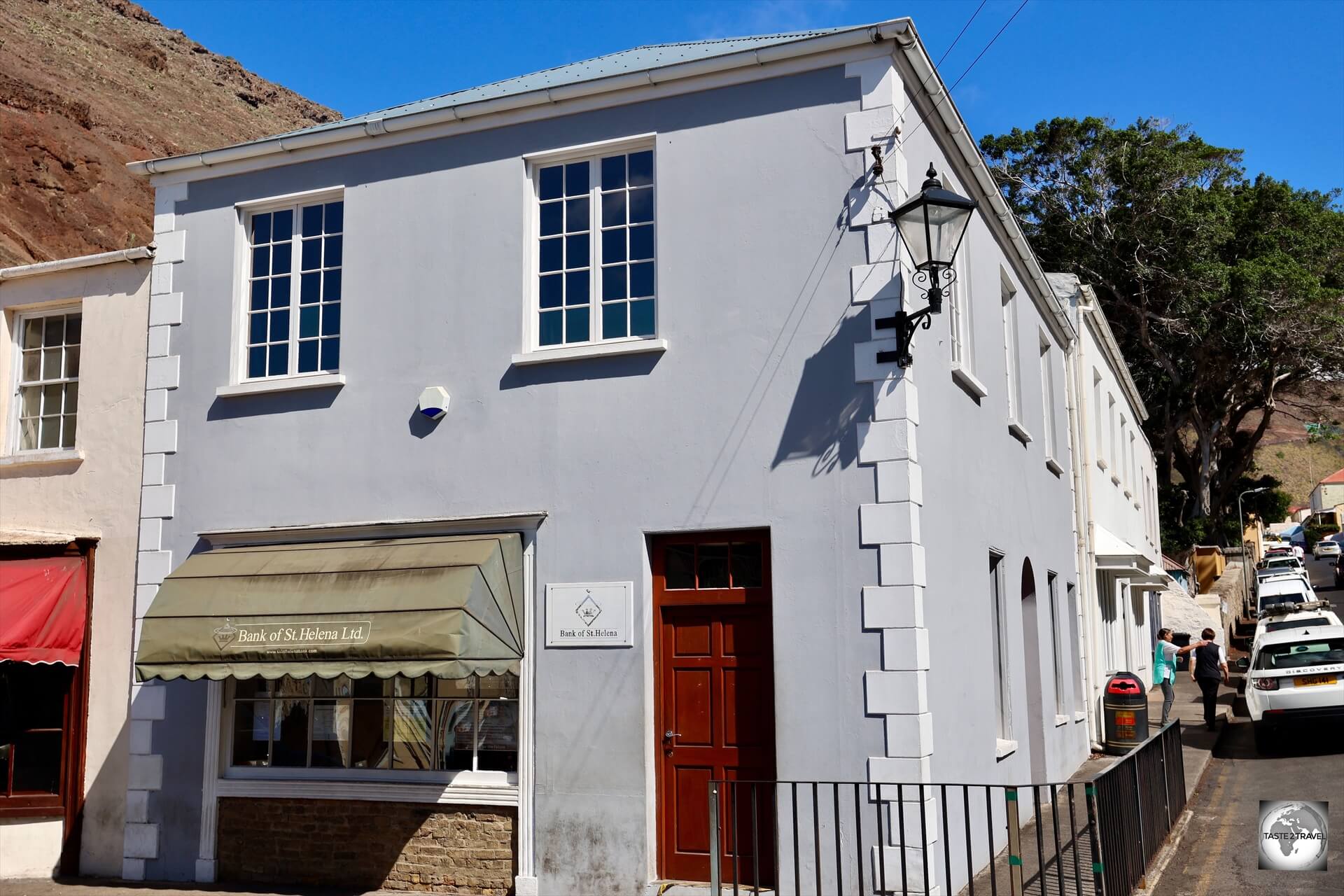
The only branch of the Bank of Saint Helena in Jamestown.
The Bank of Saint Helena operates from one small branch in Jamestown and also has a branch at the airport which is open during flight times.
The bank operates very much as a bank would have operated in rural England 50 years ago with no ATMs, no credit cards, and, usually, a long queue of customers snaking its way out the door and onto the footpath.
If you must visit the bank, you should bring plenty of patience!
ATMs
There are no ATMs on Saint Helena.
Credit Cards
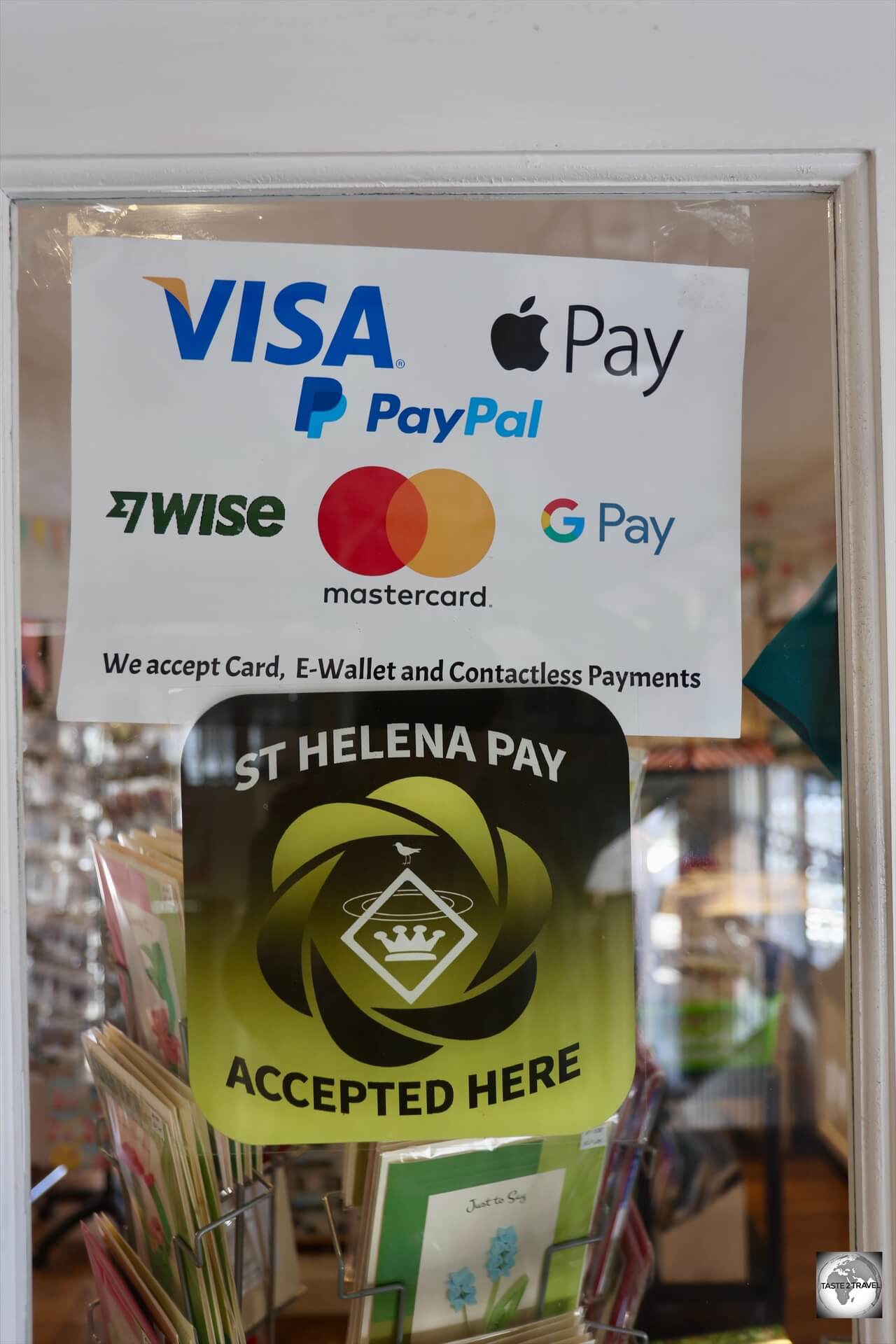
While most merchants accept St Helena Pay, very few accept international credit cards.
St Helena has very limited international credit card acceptance.
You can use a credit card to obtain cash at the Bank of Saint Helena in Jamestown.
The one place on the island which accepts credit cards is the Mantis St Helena hotel where rooms and restaurant bills can be settled using credit cards.
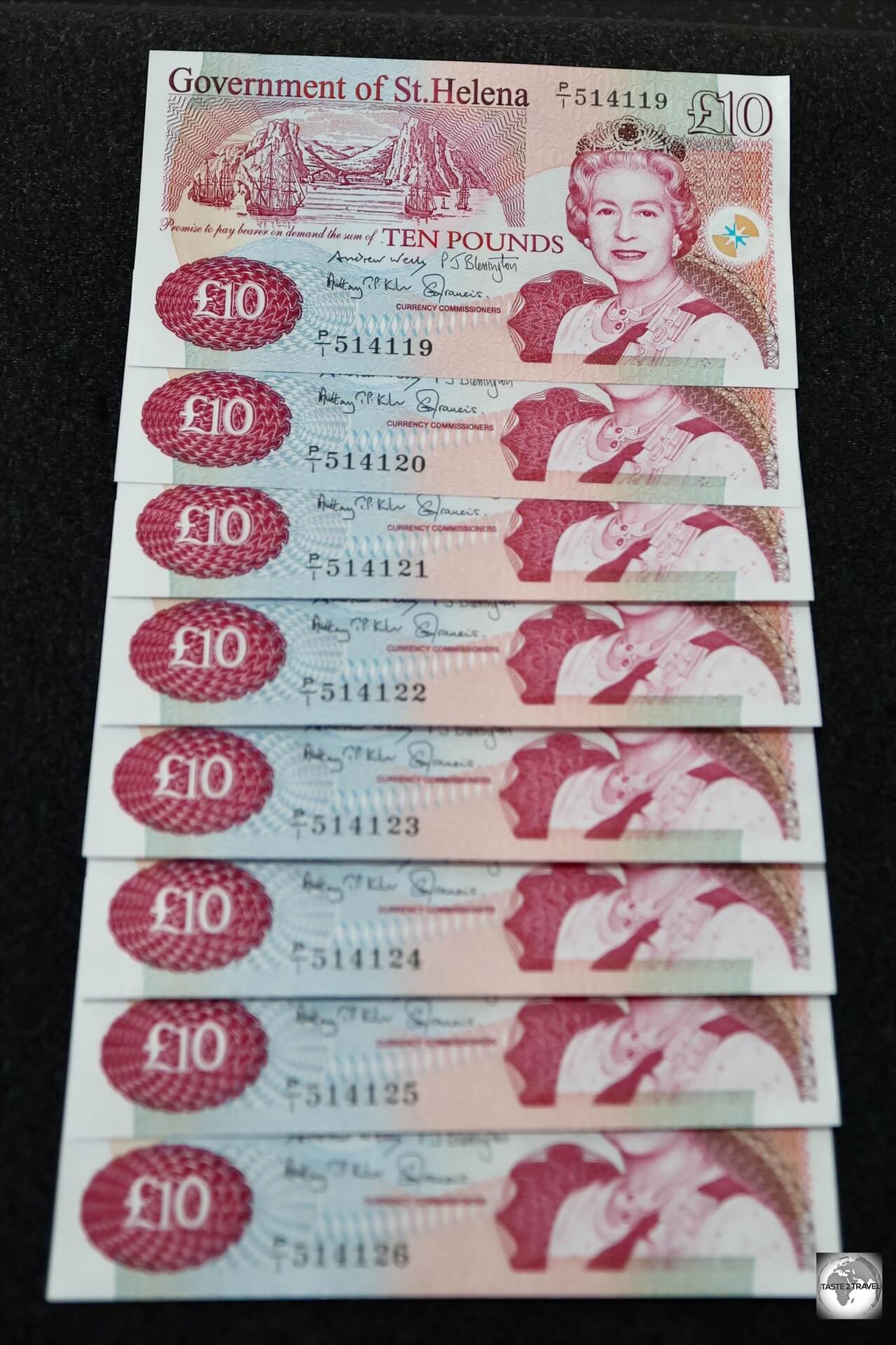
Saint Helena pounds can be purchased from the Bank of Saint Helena using a credit card.
Because of the lack of ATM’s and, almost non-existent credit card acceptance, it’s best to always carry some cash with you.
I was able to obtain these beautiful uncirculated bank notes (pictured above) at the Bank of Saint Helena using my Mastercard.
I often ate meals at the Mantis hotel so that I could pay using my credit card, rather than using my limited cash reserves.
A few merchants in Jamestown have recently been setup to accept credit card payments which are processed through a 3rd party financial services provider based in the UK.
Bank of St Helena Tourist Card
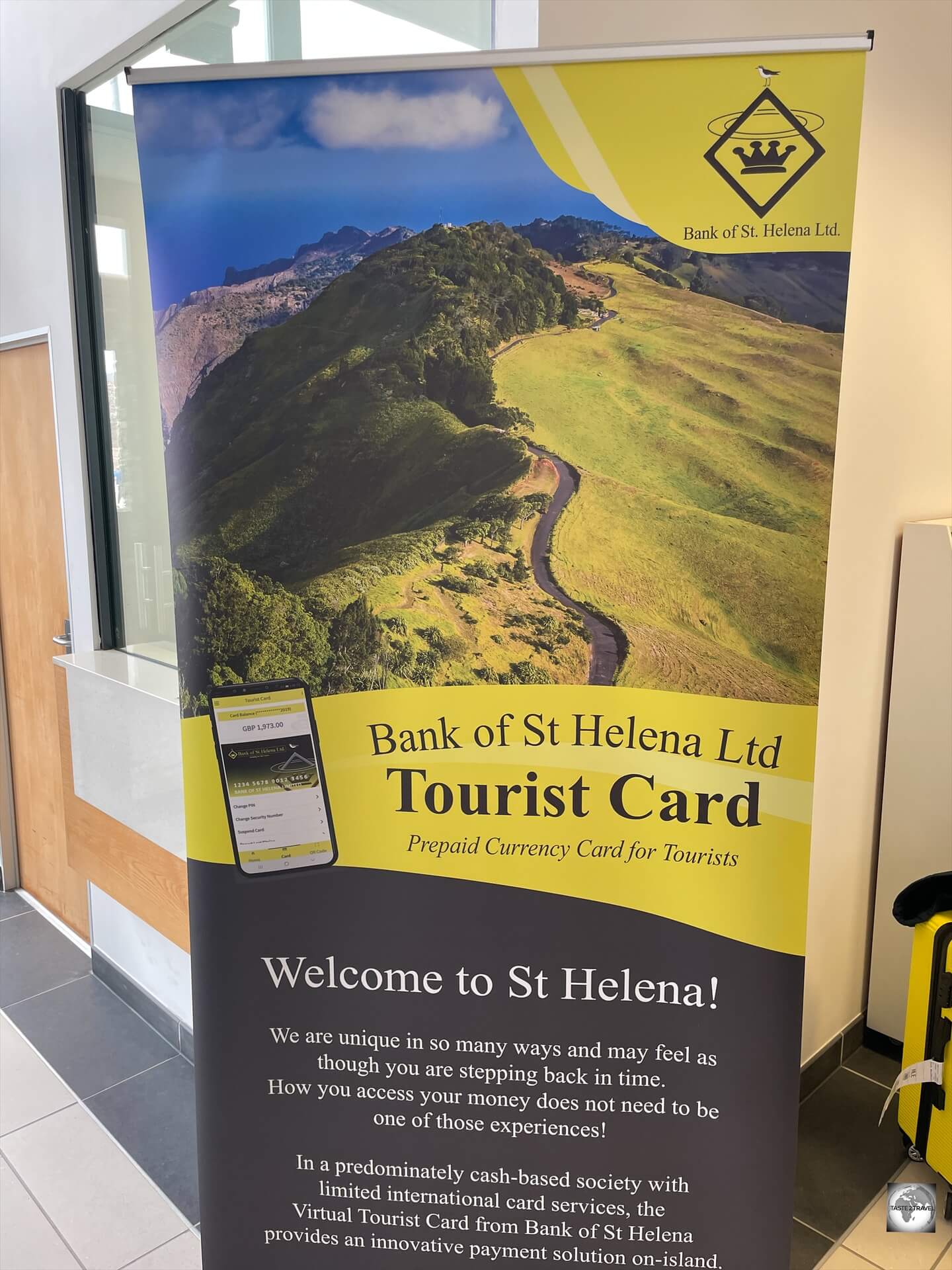
The Bank of Saint Helena Tourist Card is an online pre-paid currency card.
On an island where there are no ATM’s and almost no credit card acceptance, the best option for visitors is the Bank of Saint Helena Tourist Card.
Despite its name, the Saint Helena Tourist Card isn’t a physical card but an online mobile app which should be setup before you arrive on the island.
Known as St Helena Pay, this payment system is used by most merchants and allows you to pay for purchases by scanning a QR code on your phone.
Provided you have enough funds, your transaction should be approved.
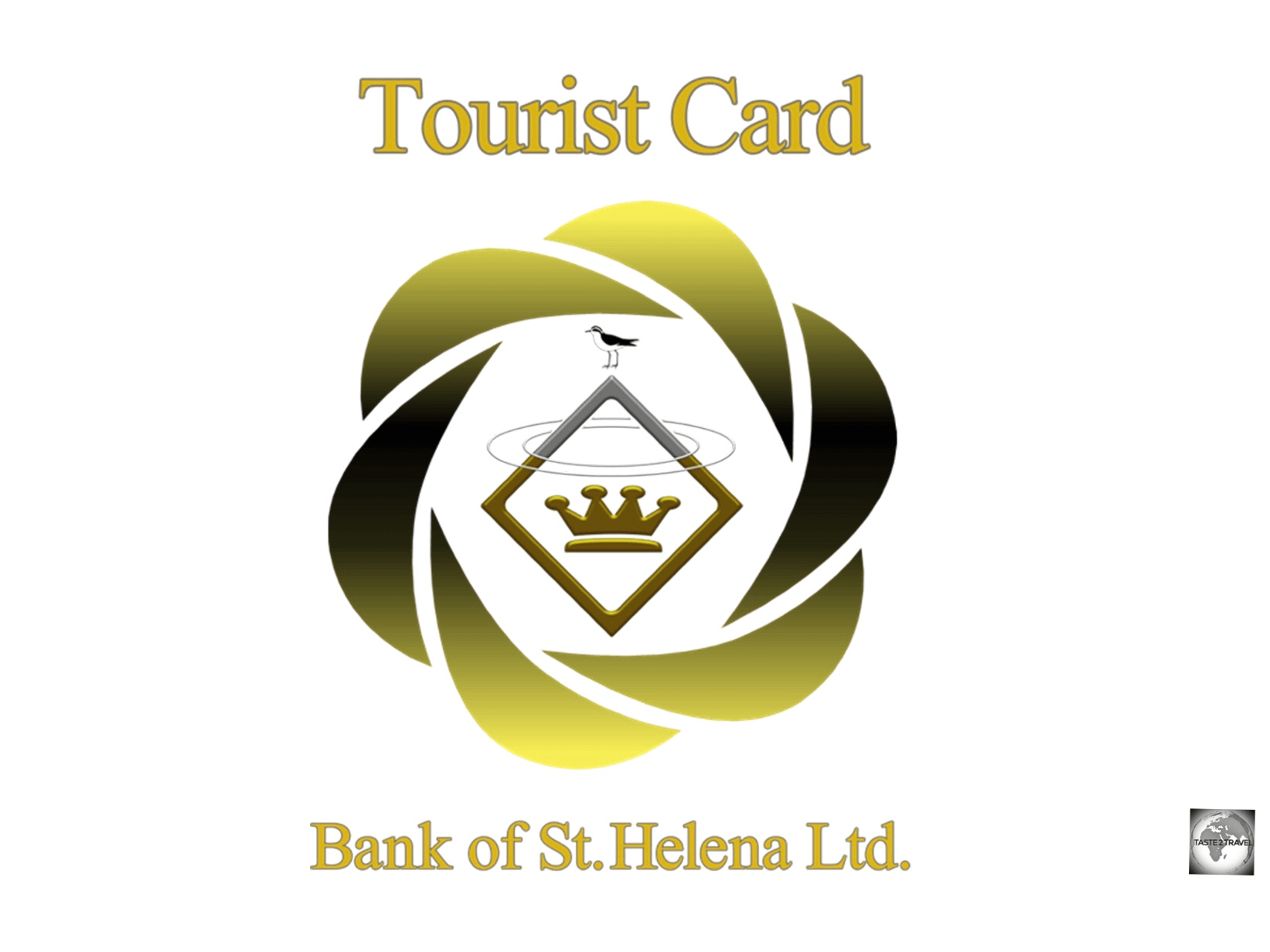
The St Helena Tourist Card is a mobile app which works as a substitute for credit cards on Saint Helena.
It is best to get everything installed and working before you arrive on the island.
Funds which are loaded onto the card take 24-hours to clear before they can be used.
It’s best to load funds onto the card before you arrive on the island.
From a technology point of view, the system is clumsy and cumbersome and in need of a complete revision.
For more information, and to apply for a Tourist Card, visit the Bank’s official website.
If you encounter any problems with the setup, the helpful customer service staff will be happy to assist you and can be contacted via email at:
customerservices@sainthelenabank.com
Costs
Travel costs on Saint Helena are not unreasonable and are comparable to costs in the UK.
The one big expense is the return airfare with Airlink, which typically costs around £620 / 14,500 rand / US$776.
As for my rental car, I was charged just £10 per day, while my self-catering Airbnb apartment cost £35 per night.
Sample costs:
- Cappuccino at St Helena Coffee shop: £3.95 (US$5.00)
- Bottle of water (0.33 litre bottle): £0.85 (US$1.07)
- A bottle of imported beer: £3.90 (US$5.00)
- Soup of the day at the Mantis Hotel: £3.50 (US$4.40)
- Beef Burger at the Mantis Hotel: £11.95 (US$15)
- SIM card from Shaw Services: £16.50 (US$18.81)
- Car hire (per day) from Patrick’s Hire Drive: £10 (US$12.54)
- Litre of fuel (per litre): £2.02 (US$2.53)
- Return flight from Johannesburg to Saint Helena: £620 / 14,500 rand / US$776.
- Airbnb apartment at Sommerville Flat (per night): £35 (US$44)
- A double room at Mantis St Helena Hotel (per night): £221 (US$277)
Saint Helena Tourist Office
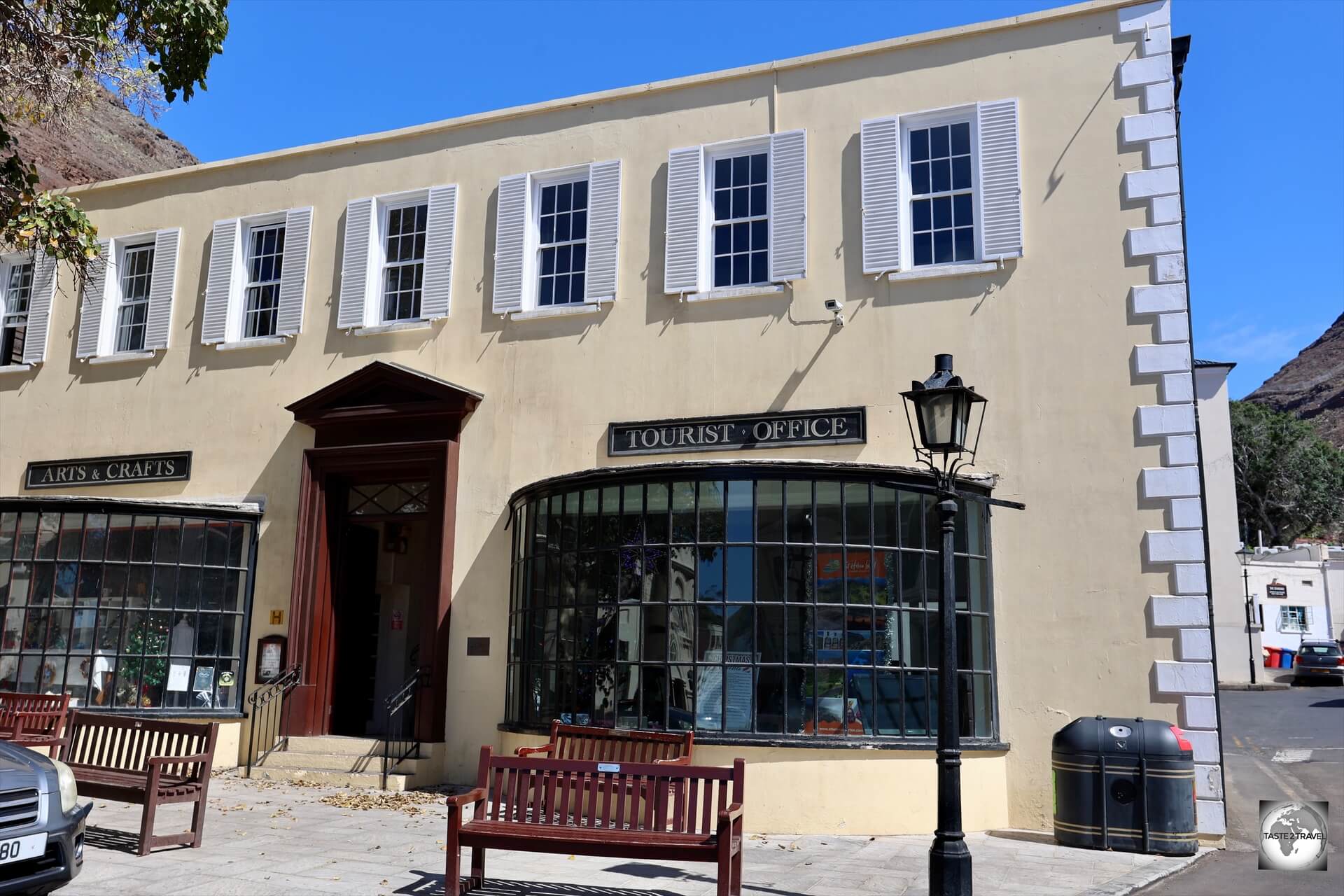
The Saint Helena Tourist Office is located on the main street in Jamestown.
Located on the main street of Jamestown, across the road from the post office, the Saint Helena Tourist Office should be the first stop for all visitors to the island.
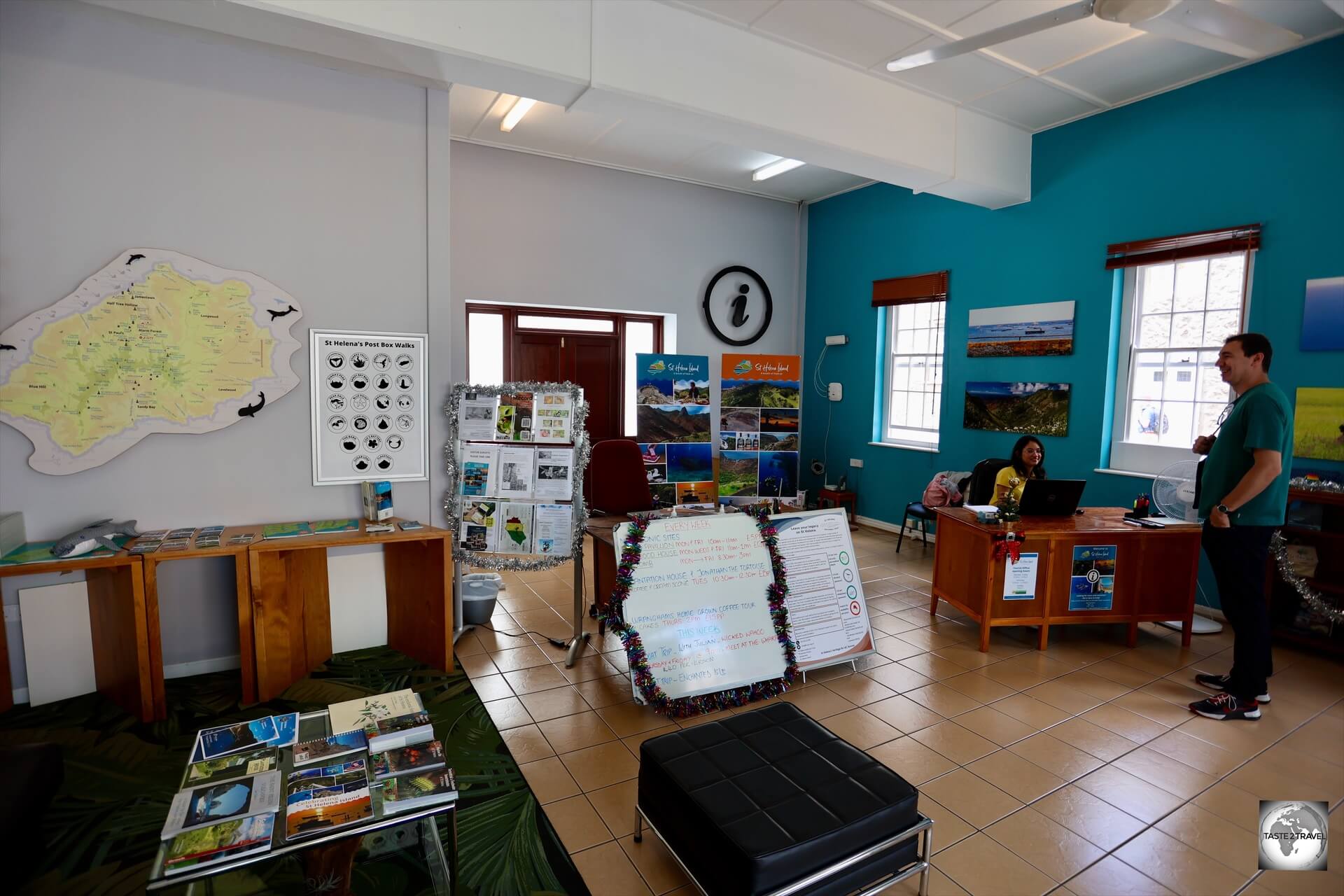
The helpful staff at the Saint Helena Tourist Office in Jamestown offer advice, planning tips, maps, brochures and lots more.
The friendly and helpful staff offer maps, brochures and advice, no matter what your interest may be.
They can even make arrangements for a photo session with Jonathan the tortoise.
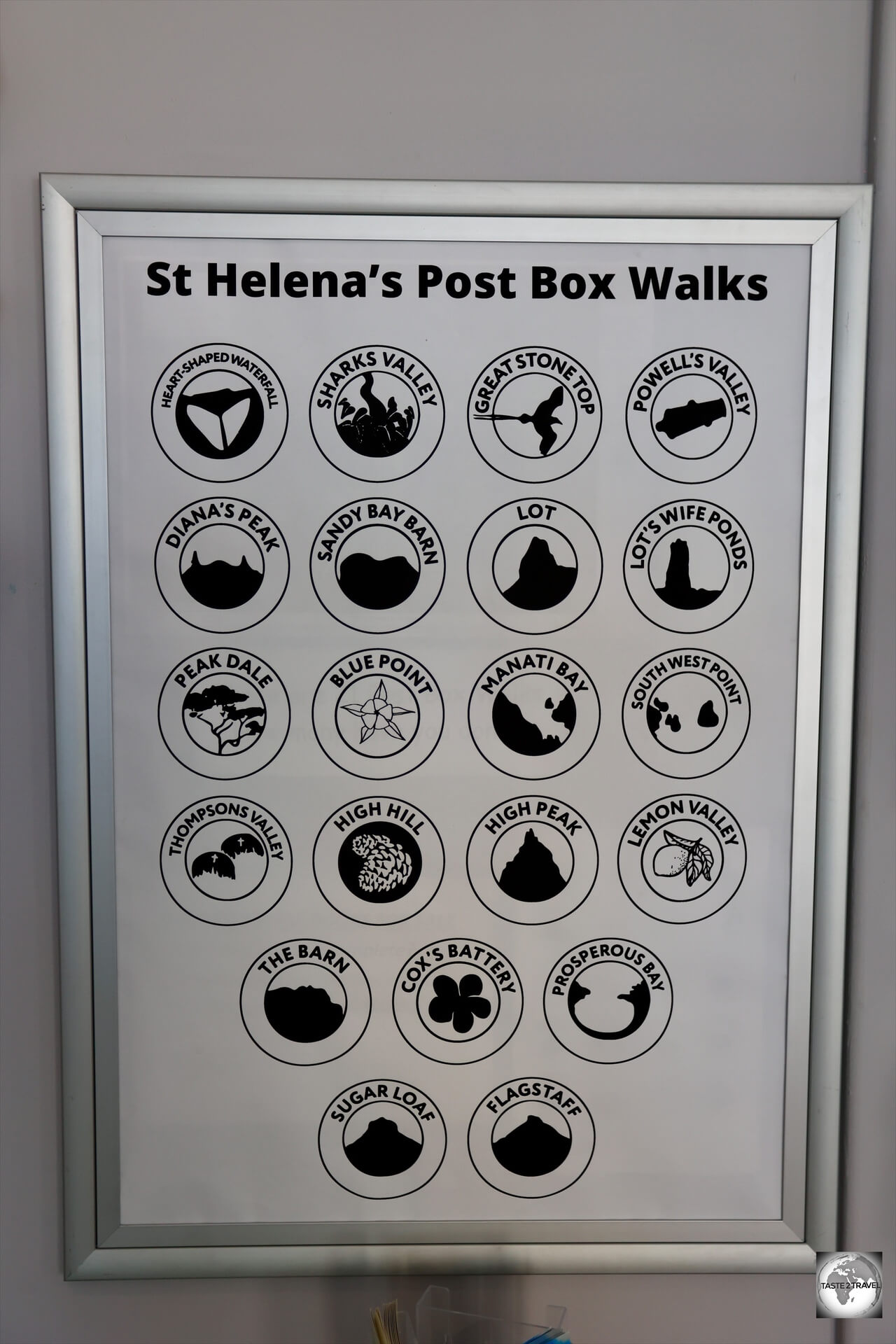
St Helena offers 21 “Post Box Walks”.
Post Box Walks
While there are many walking and hiking trails on Saint Helena, 21 trails have been designated as Post Box Walks.
The walks range in length and degree of difficulty, with all having a ‘Post Box’ at the end of the walk that holds a notebook to write your comments in and a stamp that can be used as a souvenir.
All trails are previewed on the walking and hiking page of the Saint Helena Tourism website.
A special folder is available at the tourist office which allows you to collect all 21 stamps.
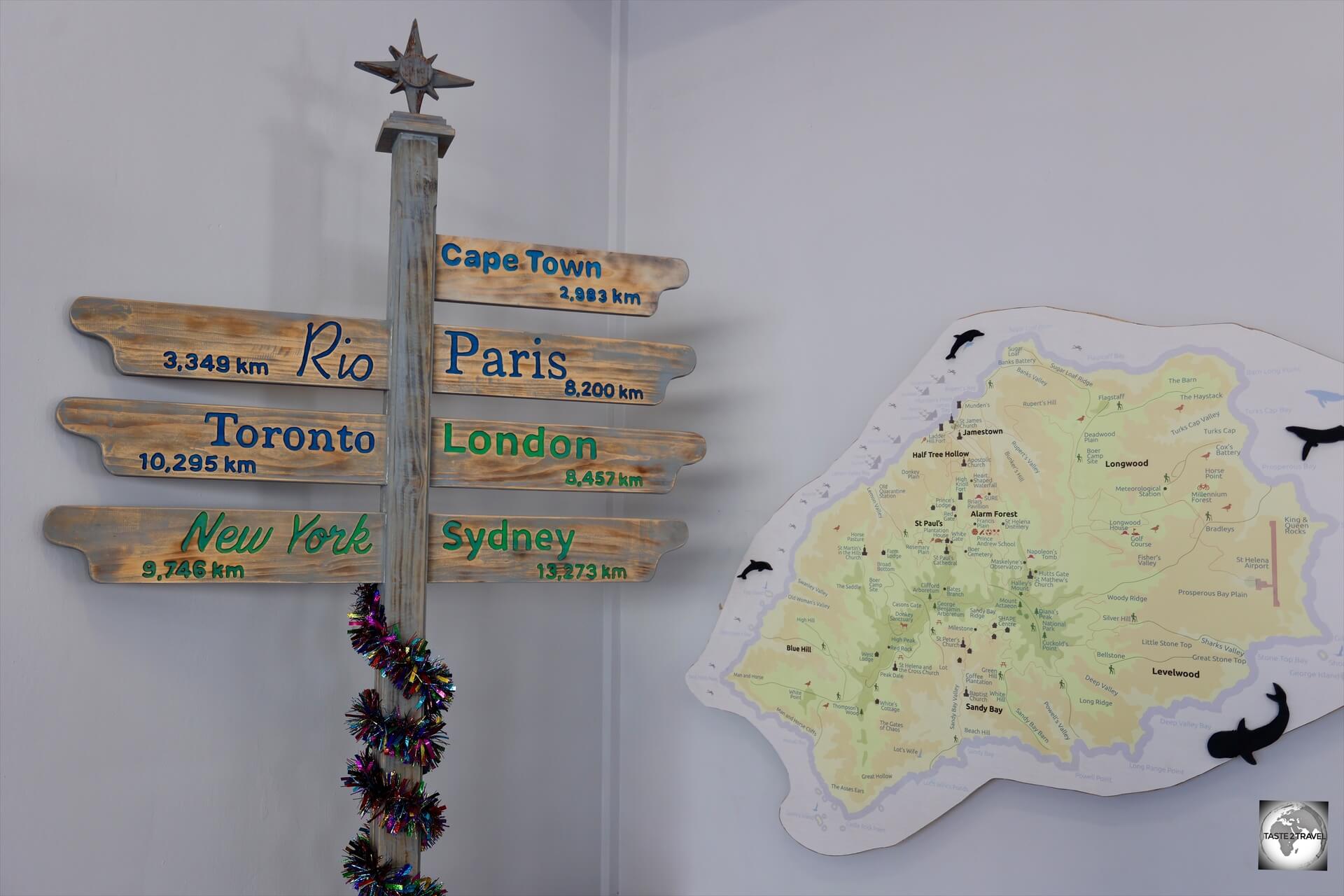
A distance indicator at the Saint Helena Tourist Office in Jamestown.
The Saint Helena Tourism Website is a valuable resource when planning a trip to the island.
The website includes:
- A listing of all accommodation options, along with contact details for each property.
- A list of restaurant and cafe options.
- A downloadable tourism map of the island.
- Detailed descriptions of the various hiking trails on the island.
- Information for those who wish to scuba dive.
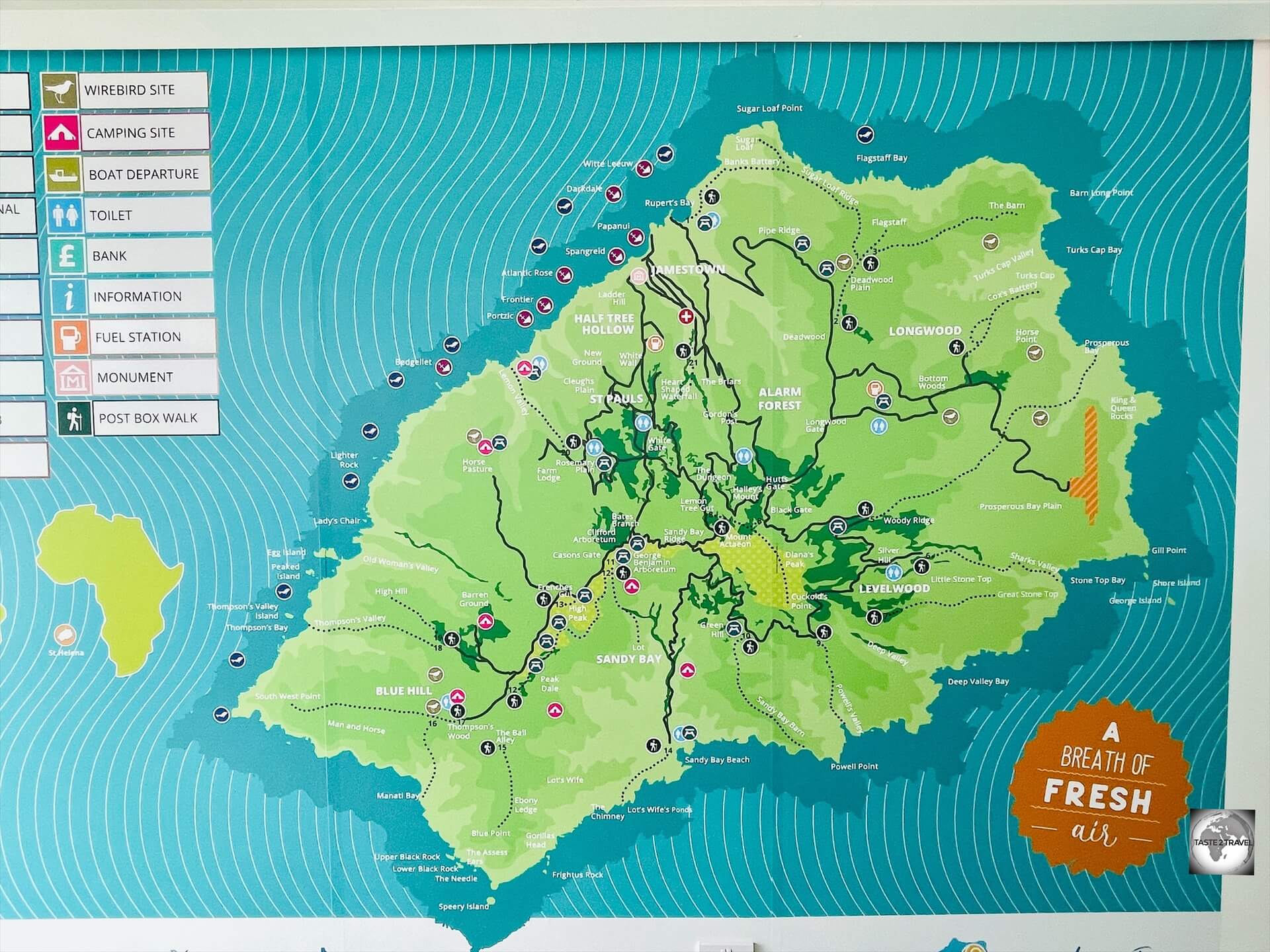
This useful wall map of Saint Helena is displayed in the arrivals hall of the airport.
Contact Details:
- Email:
- Telephone: +290 22158
- Address: The Canister, Jamestown, St Helena STHL 1ZZ
- Website: https://www.sthelenatourism.com/
- Instagram: https://www.instagram.com/st.helena.tourism/
- Facebook: https://web.facebook.com/visit.sthelena/?_rdc=1&_rdr
- YouTube: https://www.youtube.com/channel/UCvpIbc3vTOET4c7duJ2QYOA
Sightseeing
Jamestown
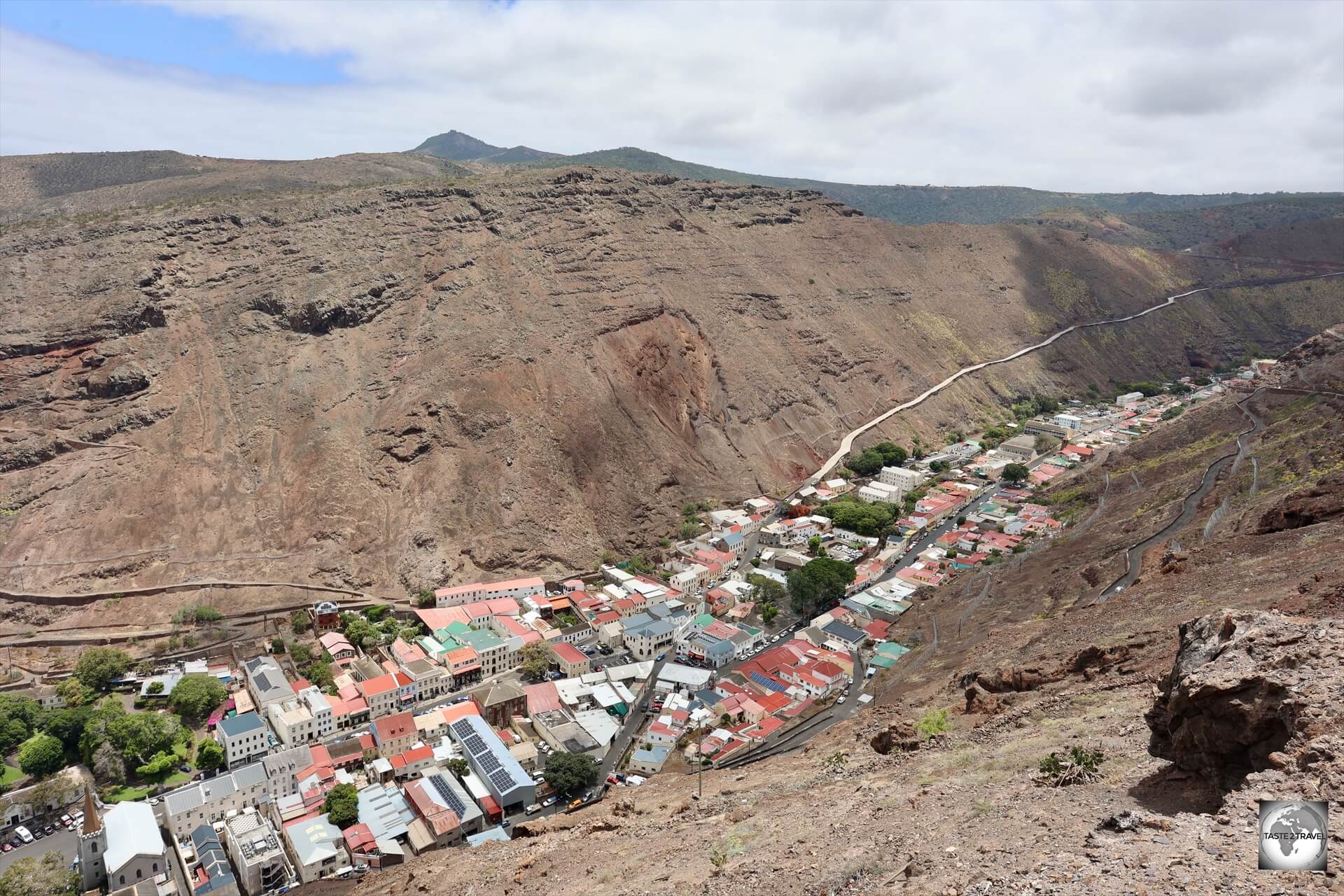
The capital and only town on Saint Helena, Jamestown lies in a very narrow valley, James Valley, surrounded by steep cliffs.
Jamestown, the island’s capital, was founded in 1659 by the East India Company, making it one of the oldest settlements in the South Atlantic.
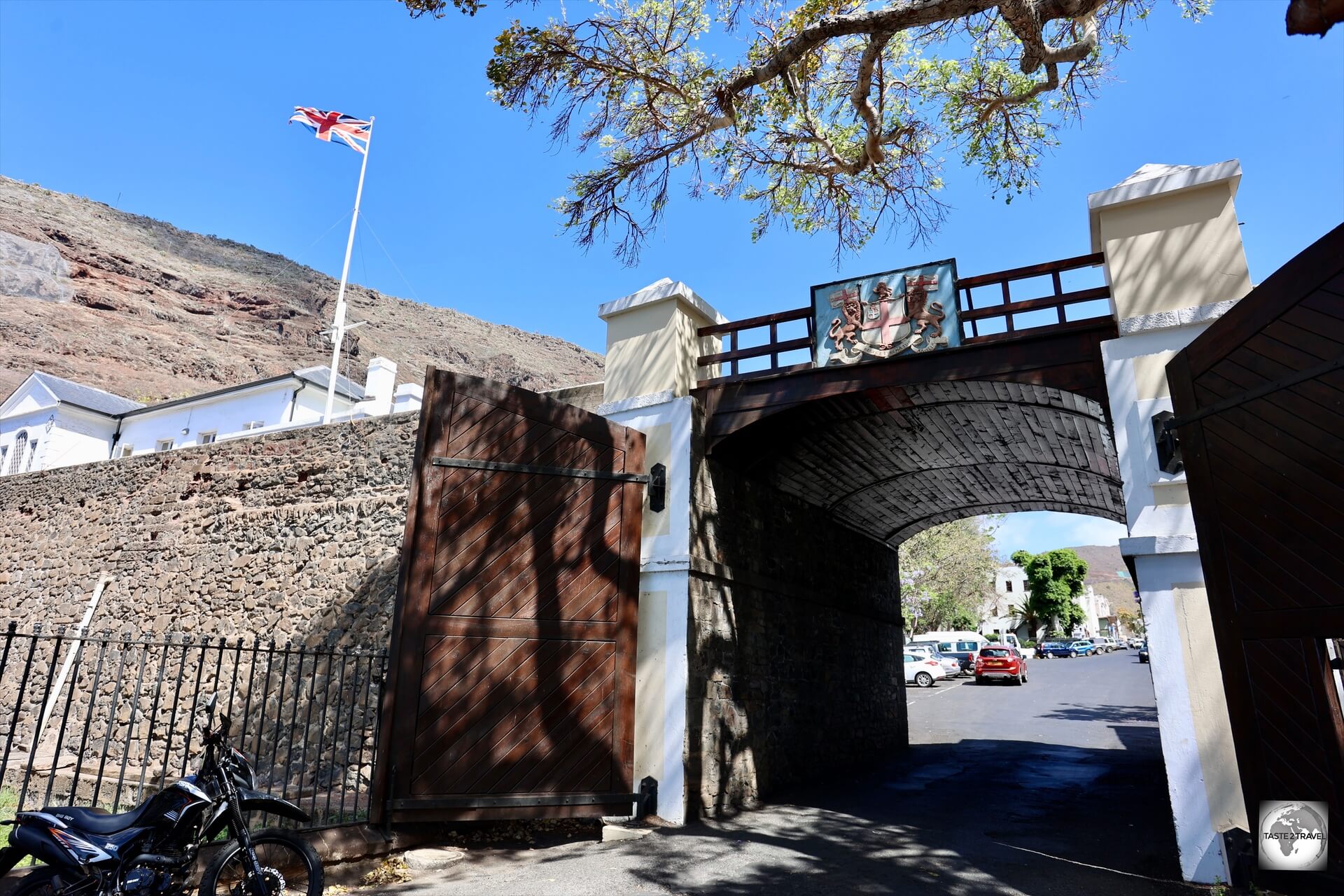
‘The Arch’ was the one access point through the city wall which once protected Jamestown from any invasion from the sea.
The settlement was established near a natural harbour at the mouth of a small river, which was ideal for landing ships and providing fresh water.
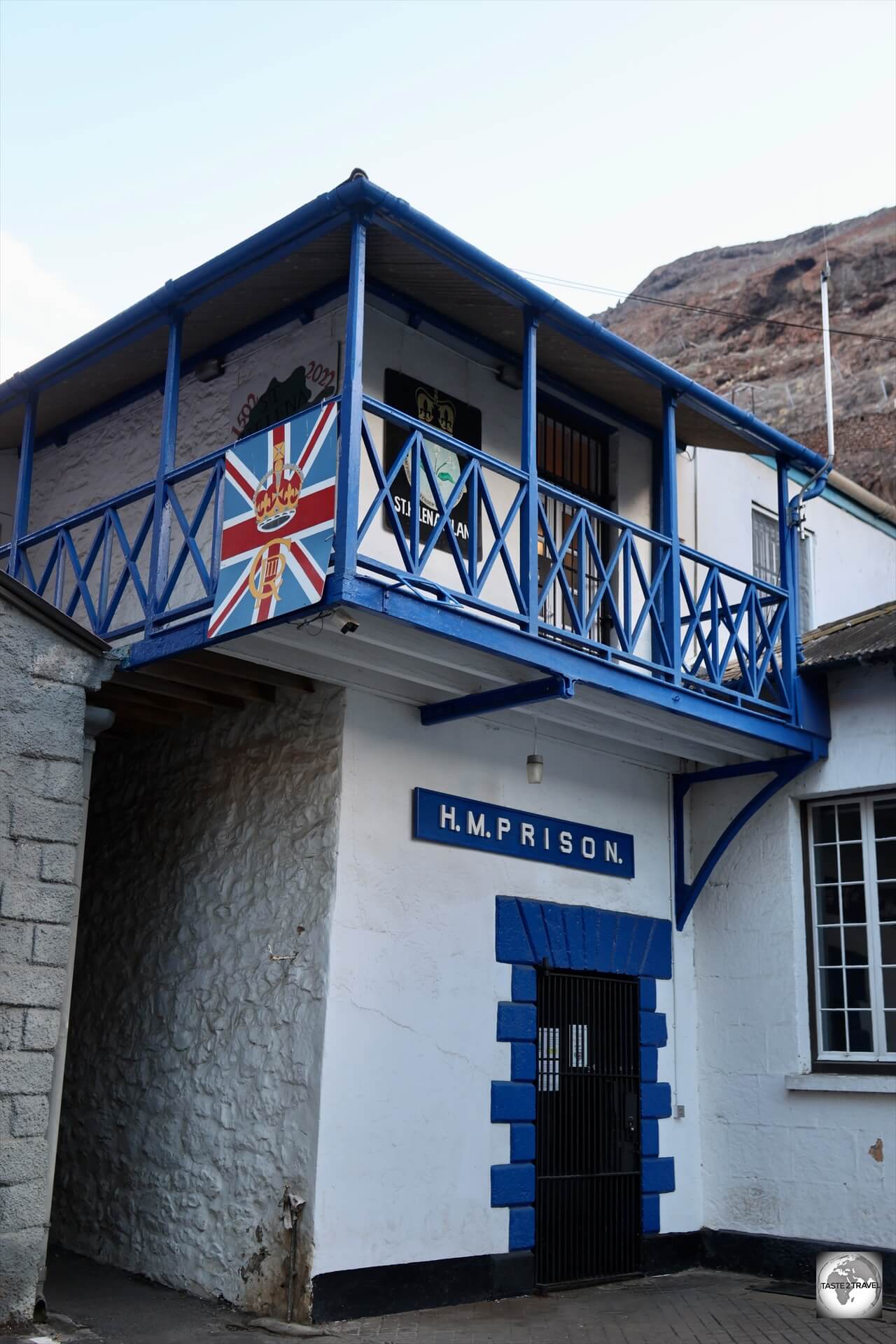
A view of the old, but still-functioning, prison in Jamestown.
The settlement was named after King James II of England.
Saint Helena became a British colony in 1673, and Jamestown grew to be the central hub of the island’s administration and trade.

The ancient moat, which once protected Jamestown from the exposed seafront, is now a garden.
The East India Company constructed various buildings, including forts and stores, and began to develop the island as a strategic naval and commercial outpost.

A view of the fortifications, which once protected Jamestown from any attack from the sea.
Museum of Saint Helena
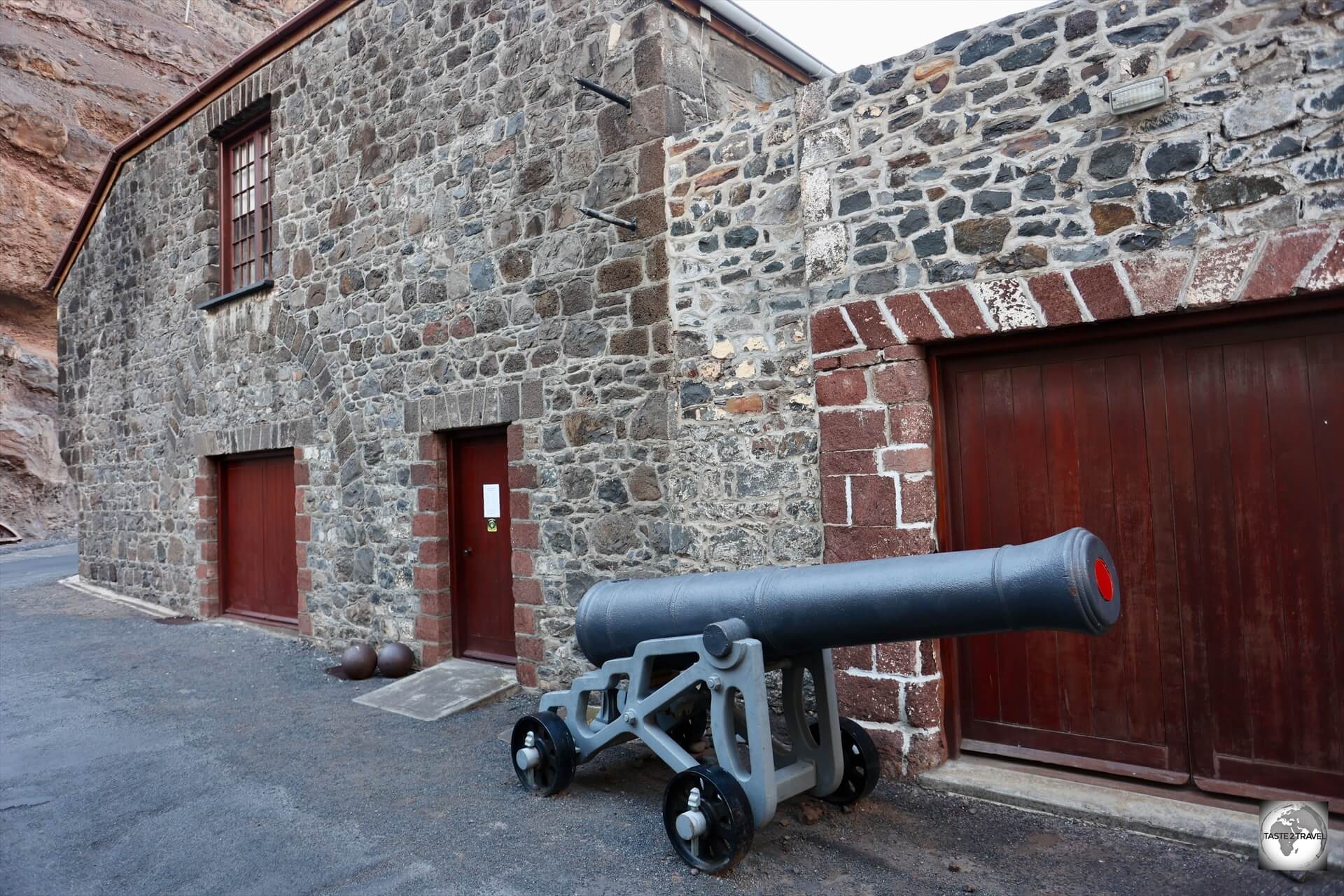
Located at the base of Jacob’s Ladder, the Museum of Saint Helena first opened its doors in 1854.
Located at the base of Jacob’s Ladder and alongside the Mantis Saint Helena Hotel, the Museum of Saint Helena is a good starting point for any visit to the island.
First opened in 1854, the current museum is housed in the old Power House in lower Jamestown.
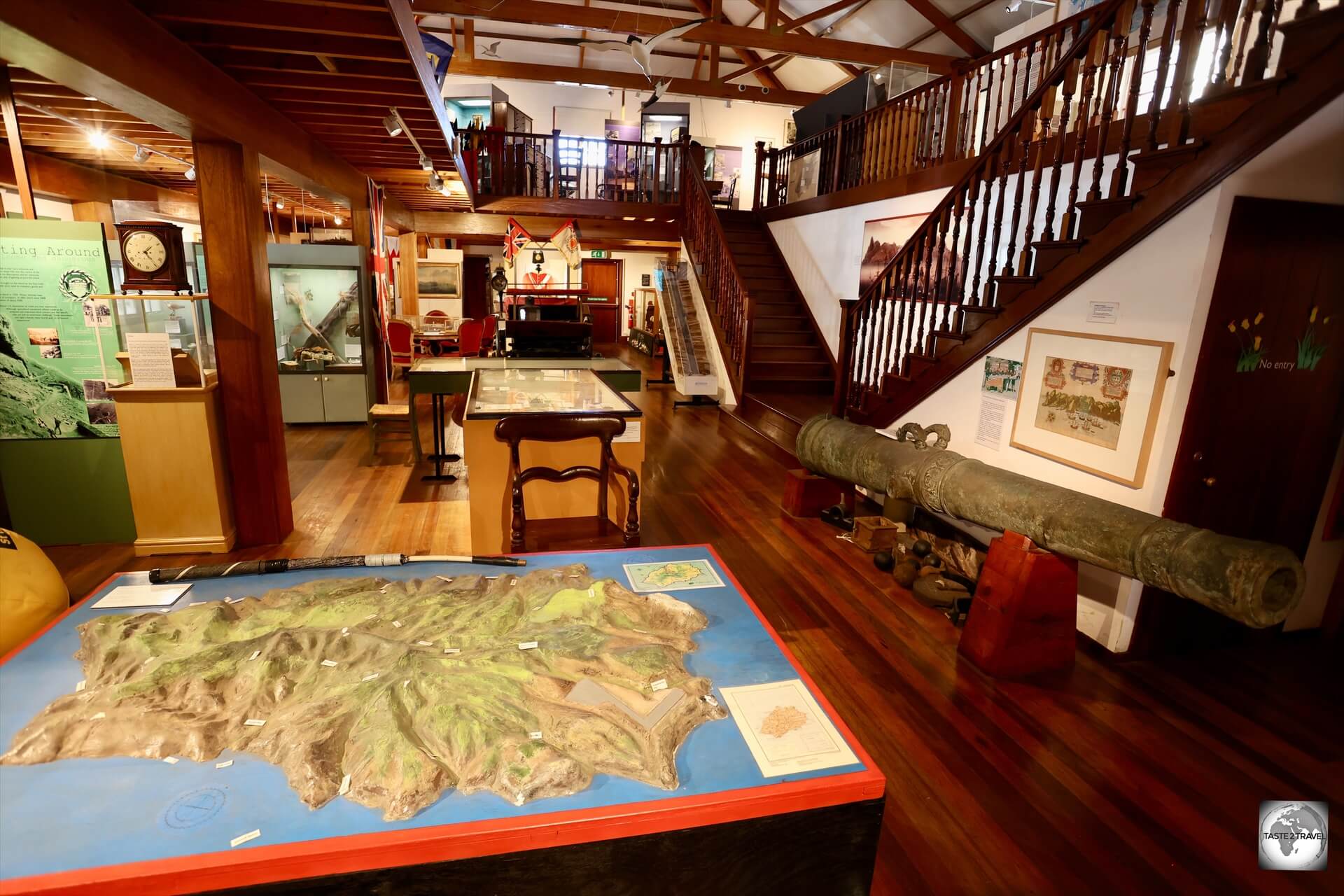
Displays, at the Museum of Saint Helena in Jamestown.
The museum displays cover the maritime, military and social history of the island over two floors.
It also has a small gift and book shop and an adjoining gallery for temporary exhibits.
The museum is one of two on the island, the other being Longwood House, the house that Napoleon Bonaparte stayed in during his exile on St Helena.
Museum Opening Hours:
- Monday: 10 am – 2 pm
- Tuesday: closed
- Wednesday: 10 am – 2 pm
- Thursday: 10 am – 2 pm
- Friday: 10 am – 2 pm
- Saturday: 10 am – 12 pm
- Sunday: closed
Jacob’s Ladder
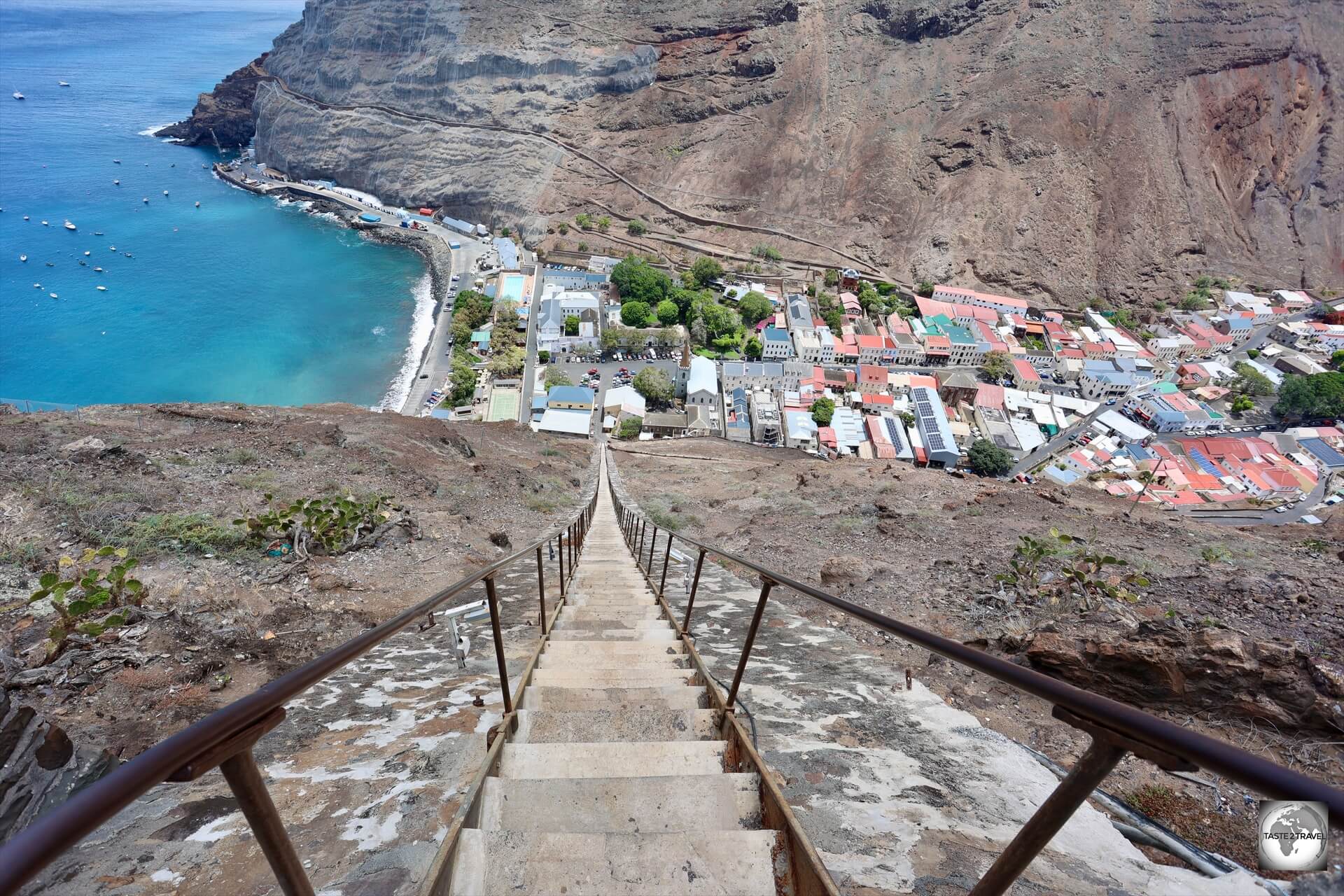
The best step exercise workout on Saint Helena, the 699-step Jacob’s ladder connects Jamestown to Ladder Hill.
The most iconic sight on Saint Helena, Jacob’s Ladder is a famous staircase which is remarkably steep, consisting of 699 steps that ascend from the bottom of the cliff in Jamestown, up to Ladder Hill.
Jacob’s Ladder was built in 1829 to transport manure, soil and organic rubbish out of Jamestown to be used by farmers and to provide access to Ladder Hill.

Jacob’s Ladder was originally a donkey-powered railway that used pulleys to haul cargo up and down the hill.
It was originally a donkey-powered railway that used pulleys to haul cargo up and down the hill.
Today, the rails have disappeared, with only the staircase remaining.
There is a working model of the original railway setup in the nearby Museum of Saint Helena.

Jacob’s Ladder rises up from the back laneways of Jamestown.
The best step workout on the island, the climb ascends approximately 200 metres (656 feet) from sea level to the hill above.
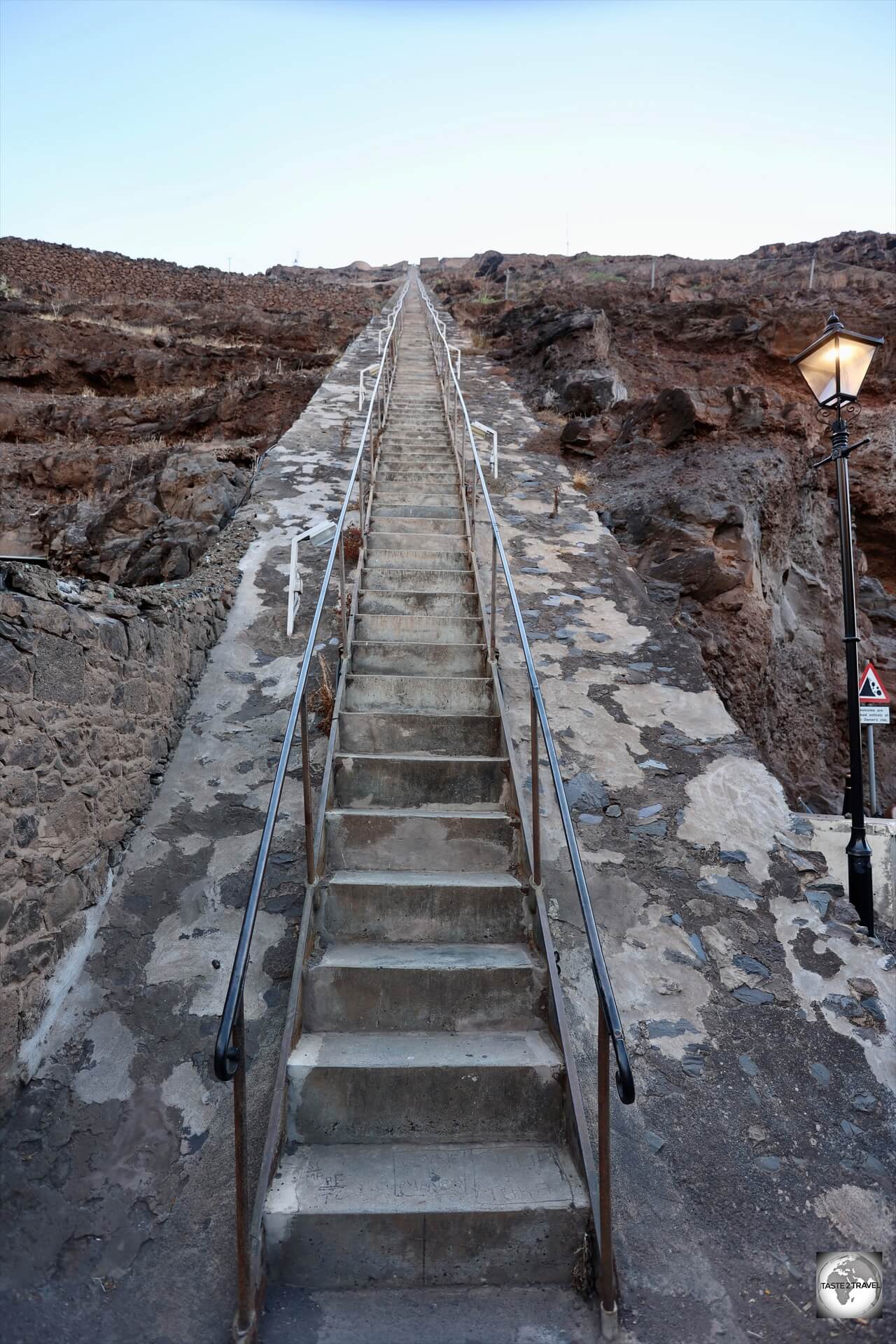
The view up the 699-step Jacob’s Ladder from Jamestown.
Those who do climb the ladder are rewarded with the best views of Jamestown with panoramic views in every direction.
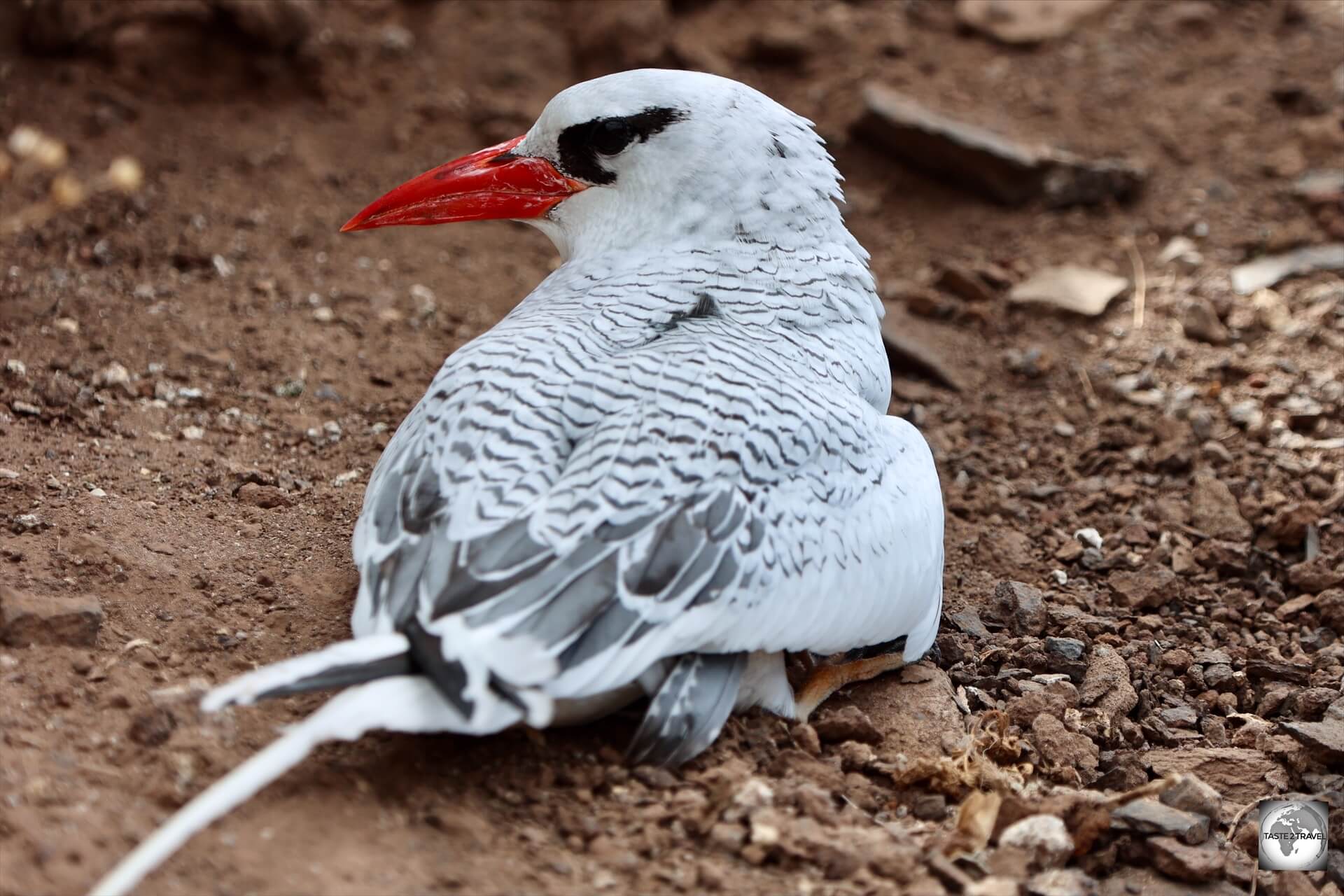
A Red-billed tropicbird, nesting on the cliff above Jamestown, next to Jacob’s Ladder.
The cliffs either side of Jacob’s Ladder are a popular nesting ground for the Red-billed tropicbird.
If you sit still long enough anywhere on the ladder, you will be rewarded by the sight of tropicbirds returning to their nests which occupy the many crevices on the cliffs.
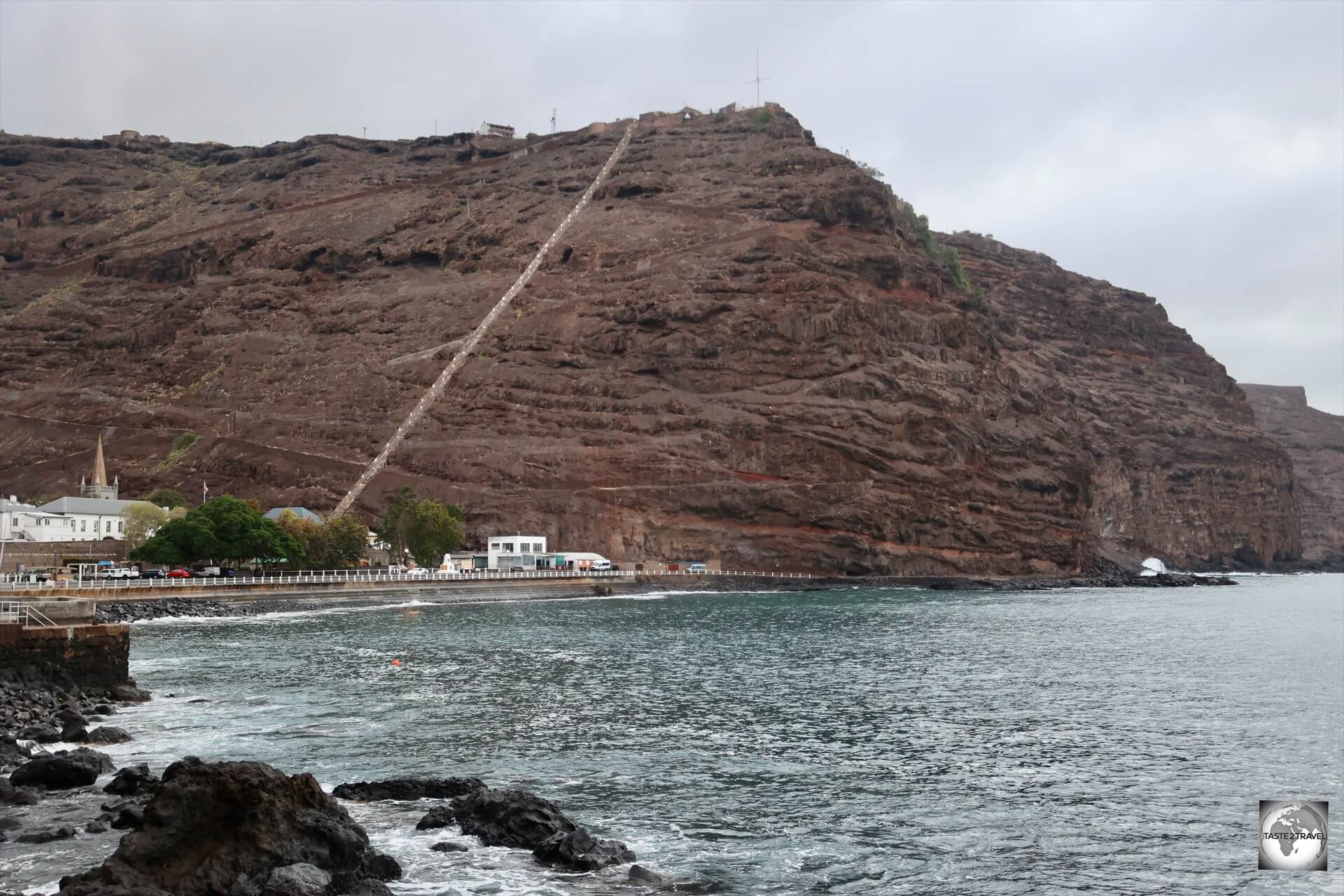
Jacob’s Ladder connects Jamestown to Fort Ladder.
For those who do not wish to climb the 699 steps, a steep, narrow, perilous road leads up the cliff face from Jamestown to Ladder Hill.
Video: Driving from Jamestown up to Ladder Hill:
Saint James’ Church

The interior of Saint James’ Church in Jamestown.
Located at the base of Jacob’s Ladder, the unremarkable Saint James’ Church is the principal church in Jamestown.
Dating from 1774, Saint James’ is the oldest Anglican Church in the southern hemisphere.
The Castle
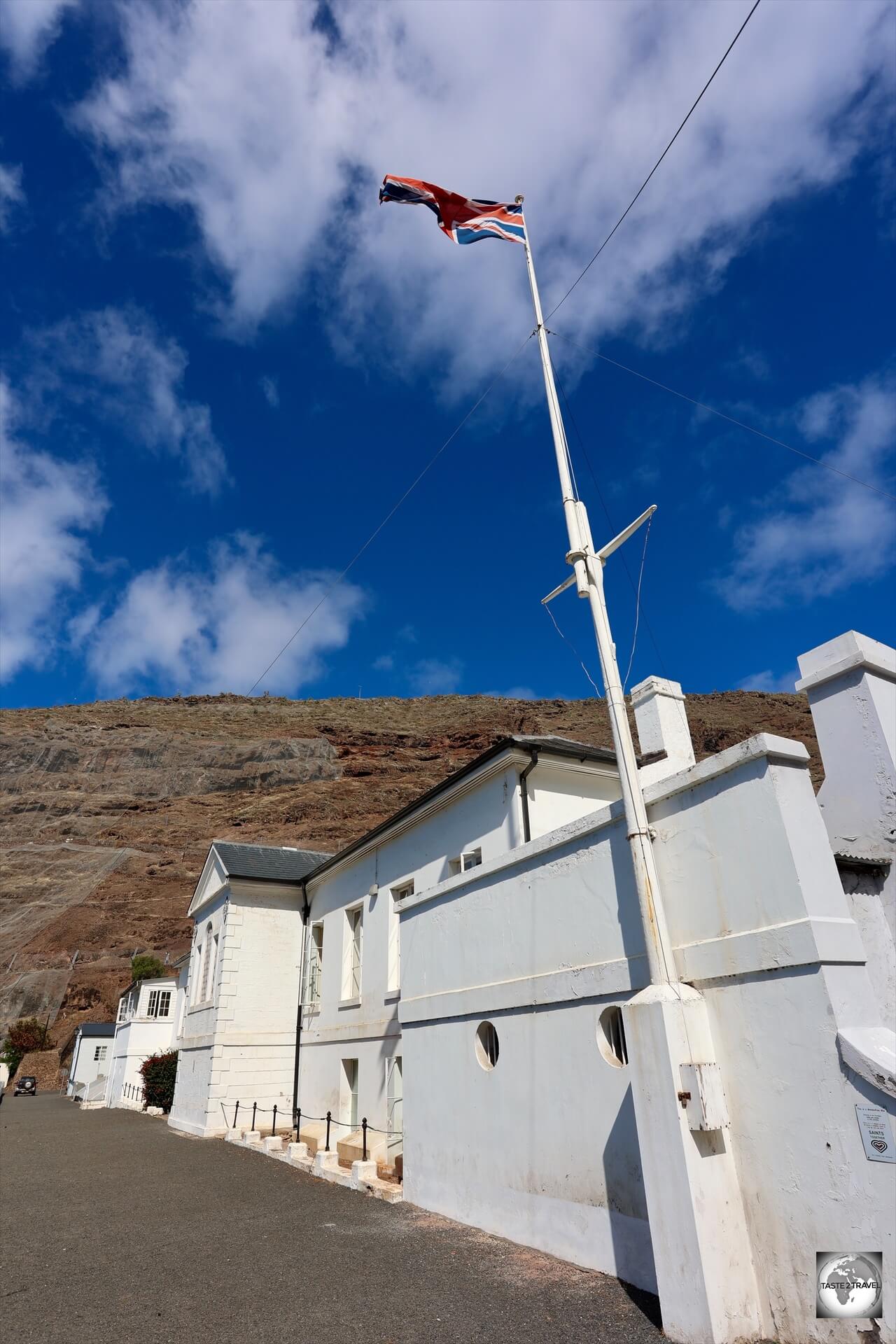
The Castle was originally built by the East India Company between 1708 and 1711.
Located alongside the city wall which once protected Jamestown from any attack from the sea, The Castle is the main government building on Saint Helena and is the office of the Governor.
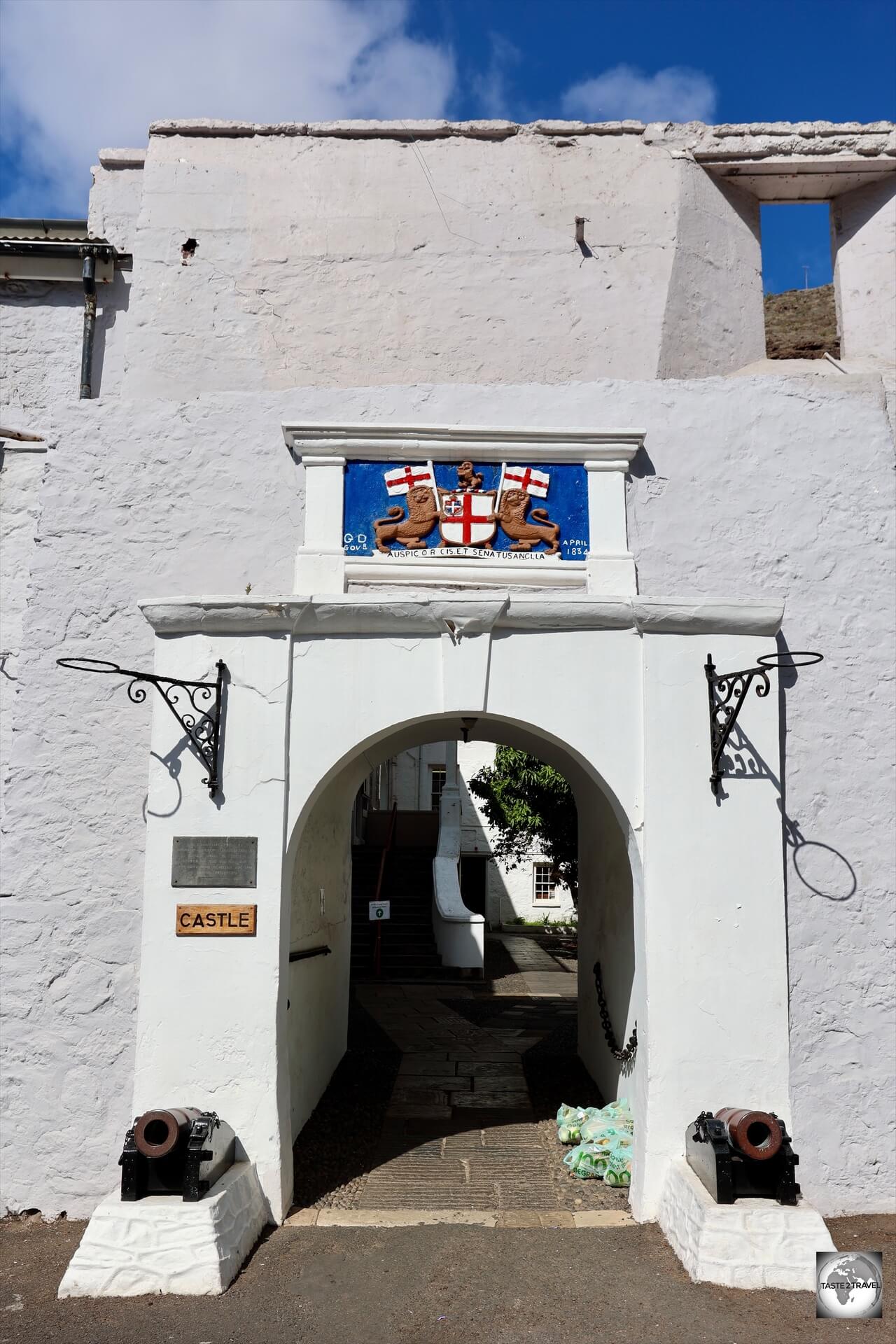
The main entrance to The Castle, the main government building on Saint Helena.
Originally built by the East India Company (EIC) between 1708 and 1711, it is one of the oldest colonial buildings in the South Atlantic Ocean.
I was originally built to protect the settlement from pirate attacks.
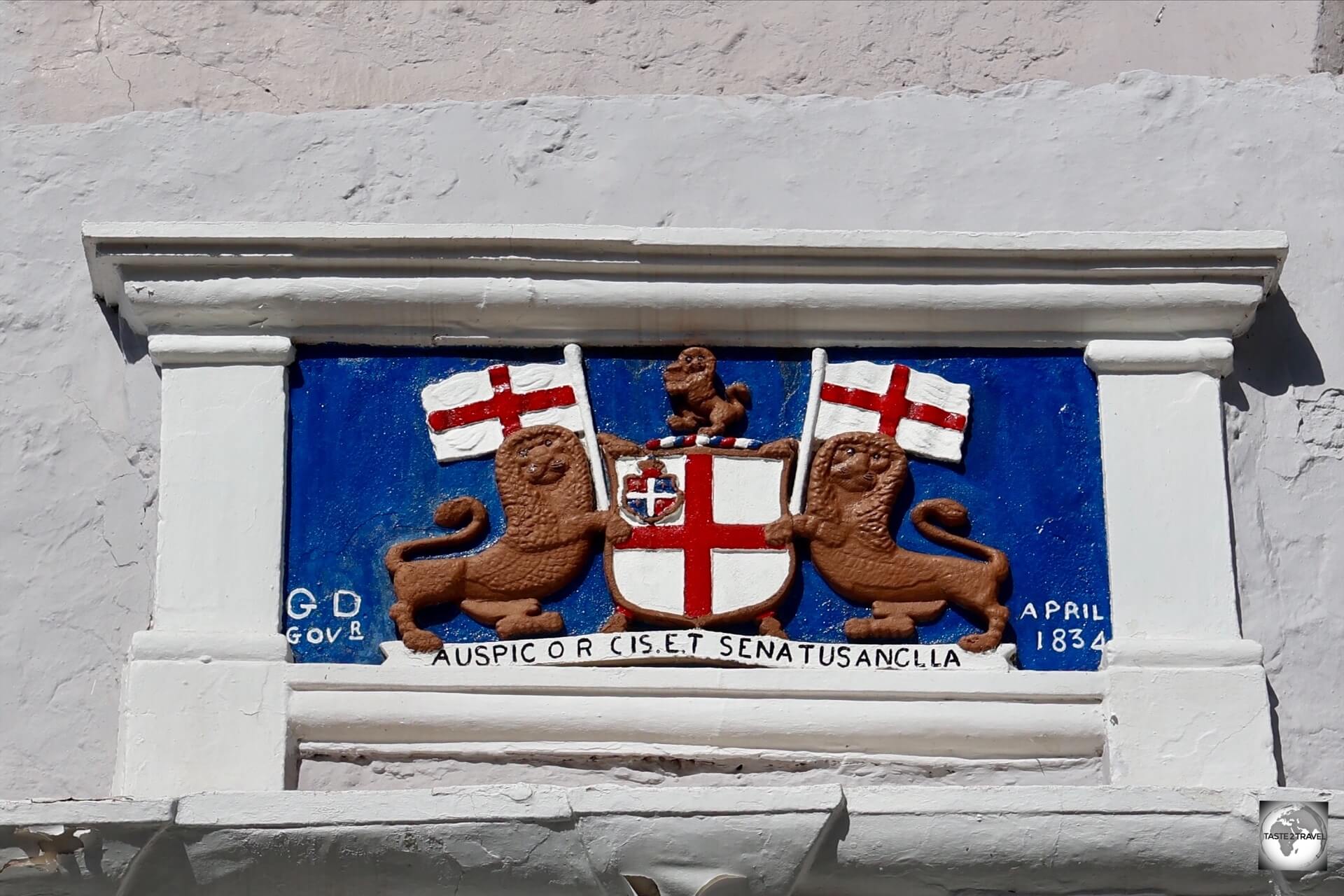
The coat of arms of the East India Company adorns the main entrance to The Castle in Jamestown.
What was the East India Company?
The East India Company (EIC) was a private corporation that traded with India, Southeast Asia, and East Asia.
It was a monopoly trading company that was chartered by the English crown in 1600.
The company was formed to give England a presence in the Indian spice trade.
English merchants were interested in the spice trade after seeing the success of Dutch and Portuguese companies.
The company was a major player in British imperialism in India from the early 18th century until the mid-19th century.
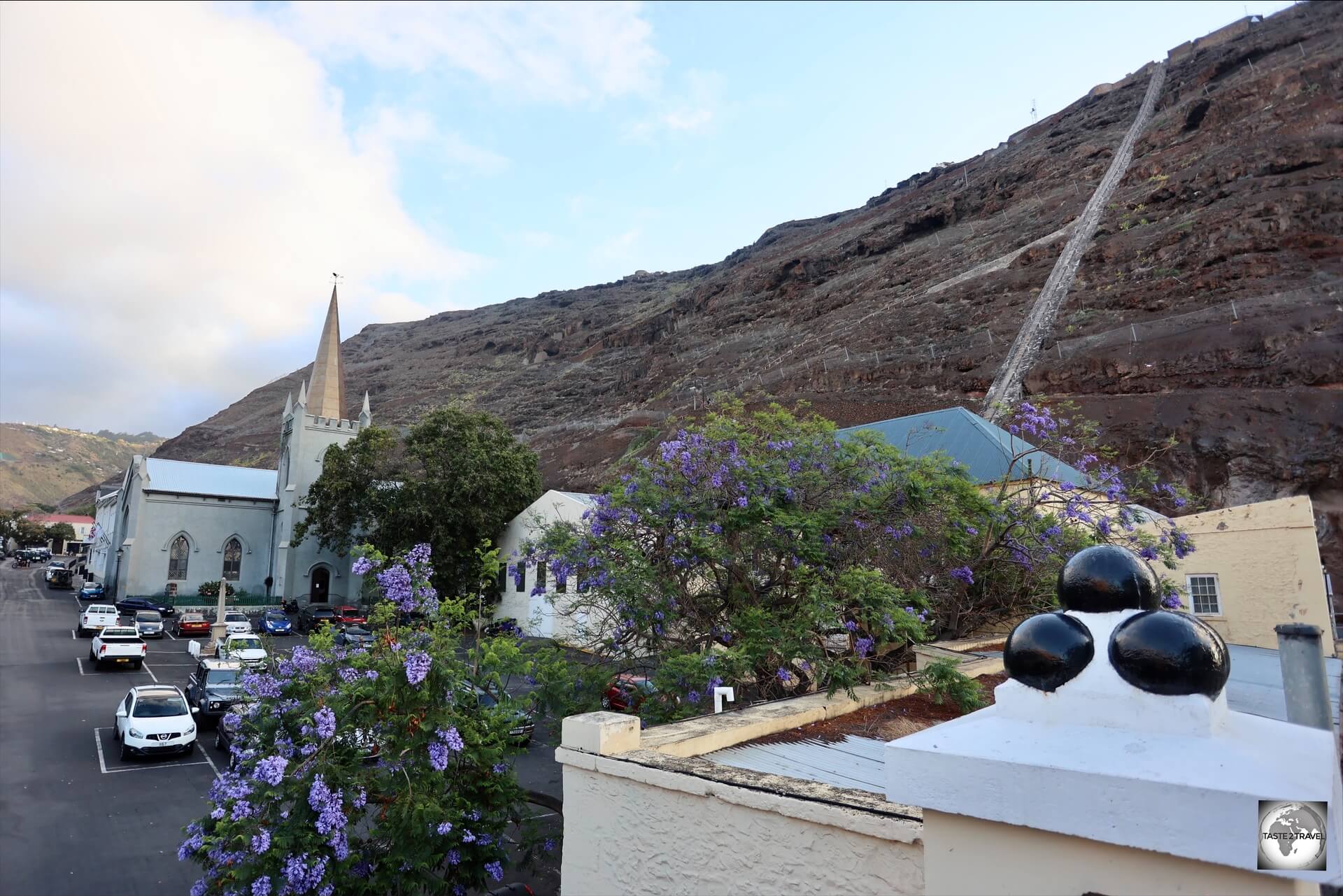
A view of Jamestown from the walls of The Castle with St James’ Church and Jacob’s Ladder in the background.
Castle Gardens
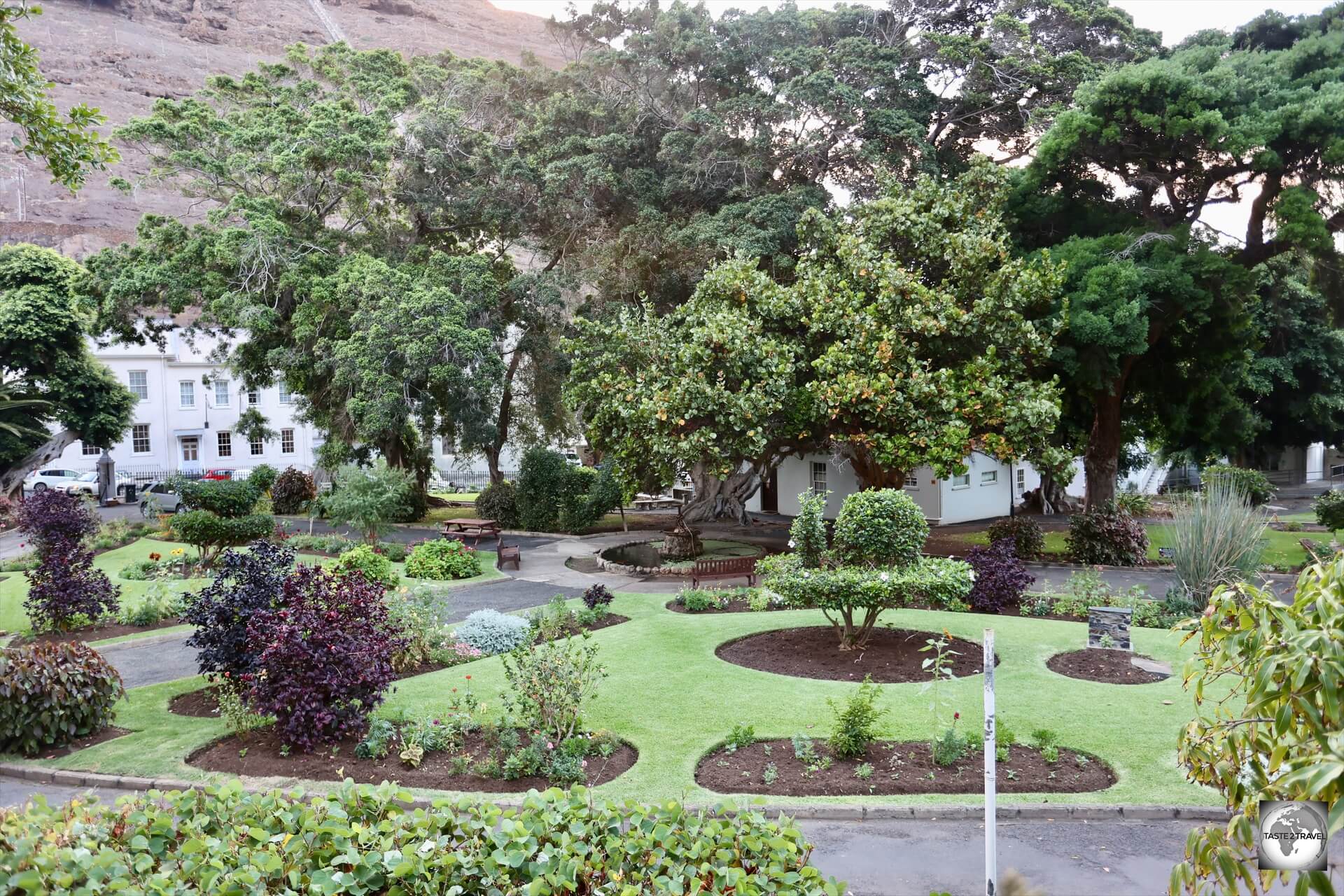
The view of Castle Gardens in Jamestown.
Located next to The Castle, Castle Gardens is a small, shady park which is home to manicured lawns, well-maintained garden beds, a selection of endemic trees and a couple of memorials.
The popular restaurant, Anne’s Place (see the ‘Eating Out‘ section below) is also located here.
Longwood
Longwood House
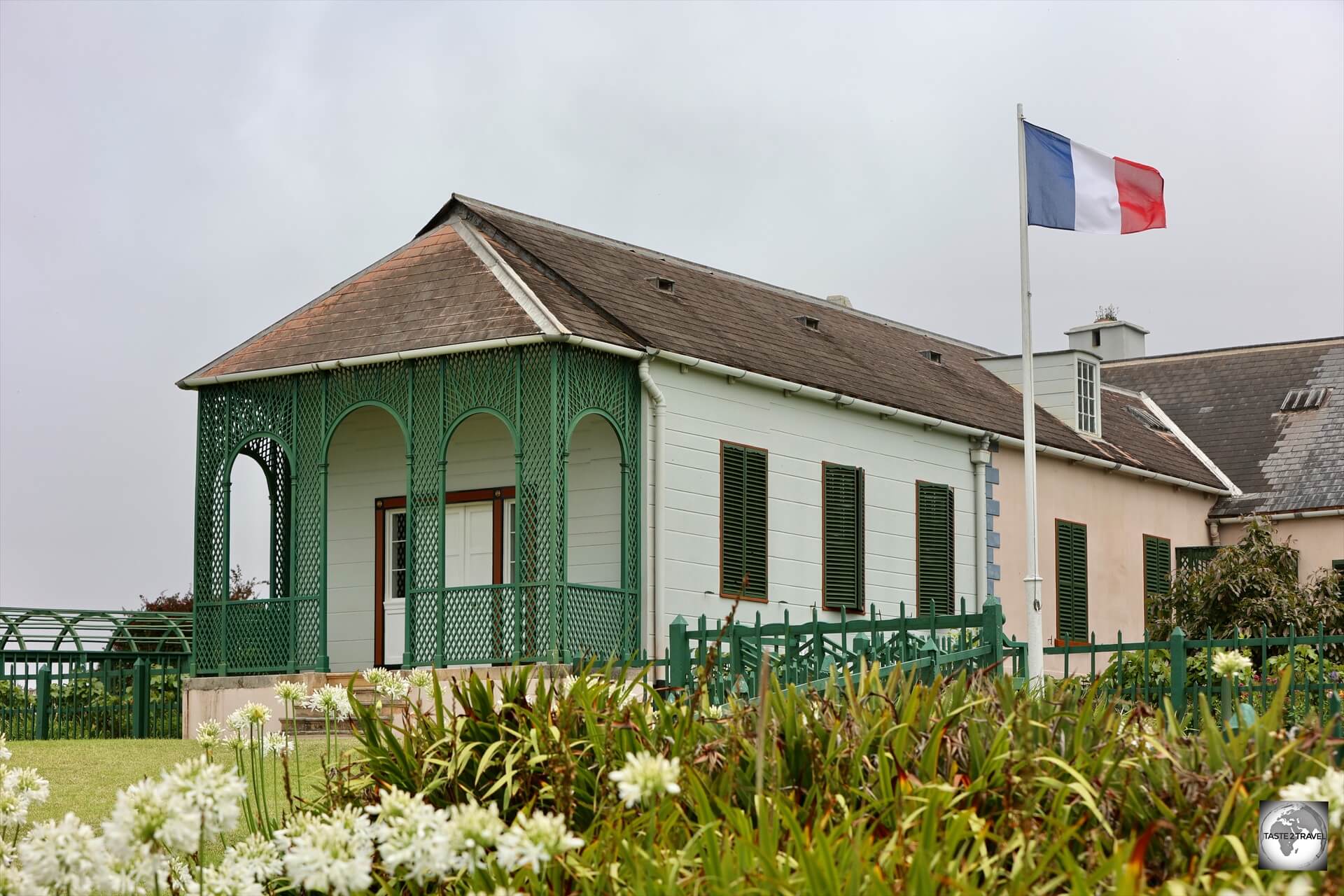
Longwood House became famous as the place where Napoleon Bonaparte spent the last years of his life.
Located on a hilltop in the central part of Saint Helena, 8.5 km from Jamestown, Longwood House is an historic, two-story Georgian-style, residence and the most famous sight on Saint Helena.
It became famous as the place where Napoleon Bonaparte spent the last years of his life, from 1815 until his death in 1821.
Napoleon was exiled to Saint Helena after his defeat at the Battle of Waterloo, and the British government selected Longwood House as his residence.

This Green oak tree at Longwood House was planted by Napoleon.
Original built in 1743 by the East India Company as a storage barn, Longwood House was converted for Napoleon’s use in 1815 and was chosen because it was easy to secure.
Many additions and renovations were made during Napoleon’s residence.
Napoleon was not allowed to live in a grand or comfortable setting, and the house, while spacious, was far from luxurious, reflecting his status as a prisoner of war.
His living conditions were relatively poor compared to his former, lavish, imperial lifestyle.
During his time at Longwood, Napoleon was attended by a small entourage of servants and aides, and he spent much of his time writing, reading, and reflecting on his past empire.
Some of his most famous writings, including letters to his family and associates, were composed here.
Napoleon’s life at Longwood was a time of relative isolation and ill health.
His living conditions, coupled with the tropical climate, contributed to his deteriorating state of health, and he complained frequently about the dampness and cold of the house.
The building is surrounded by lush greenery, with gardens and a relatively expansive property.
Longwood House is arranged with a variety of rooms including a Billiard/ Map room, Salon, Dining room, Bedroom and Napoleon’s study, all of which are carefully preserved.
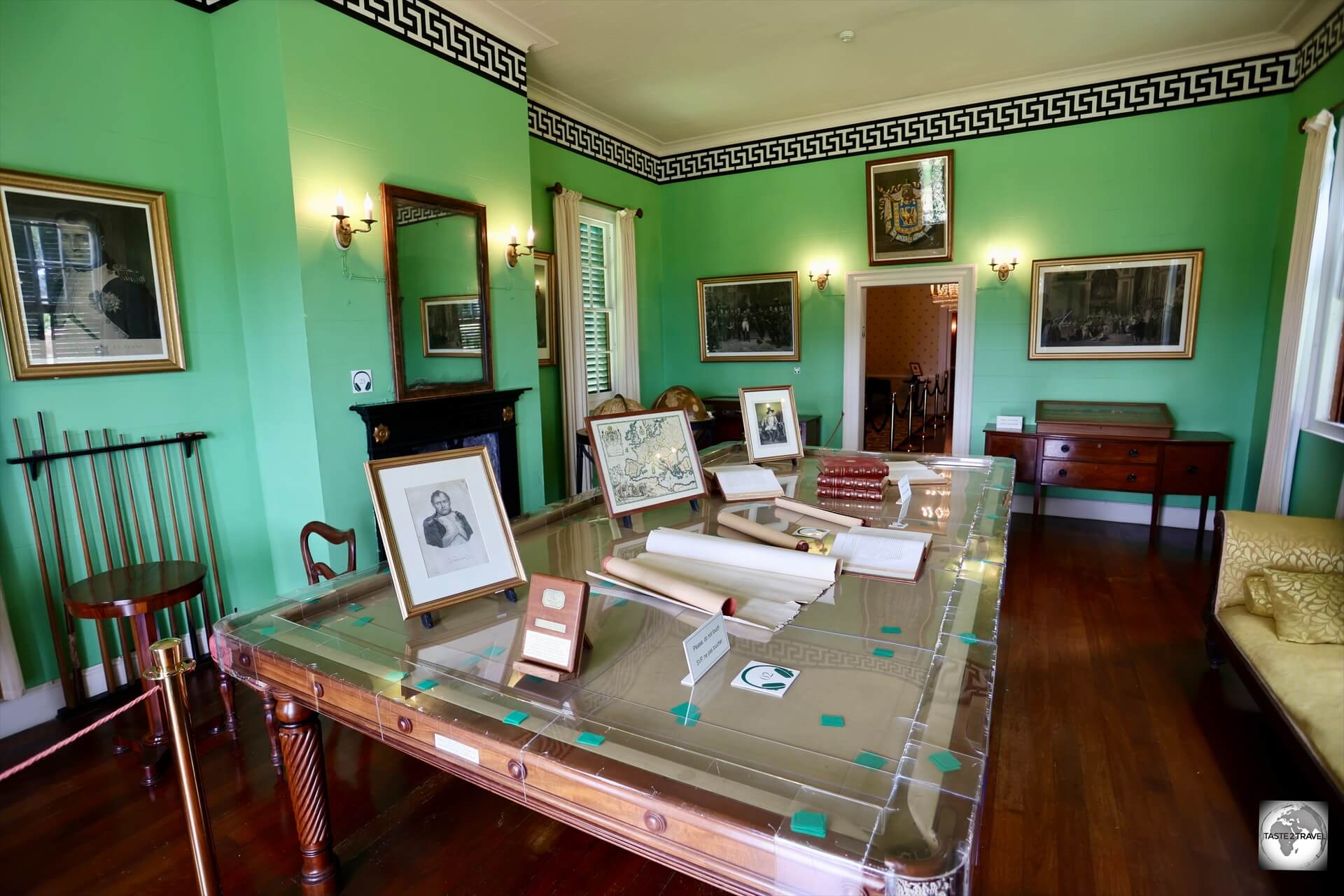
A view of the Billard/ Map room at Longwood House.
The first room of the house, as you enter through the front entrance, is the Billiard / Map room.
This room was added in 1815 by the carpenters from the HMS Northumberland – the ship which carried Napoleon to Saint Helena.
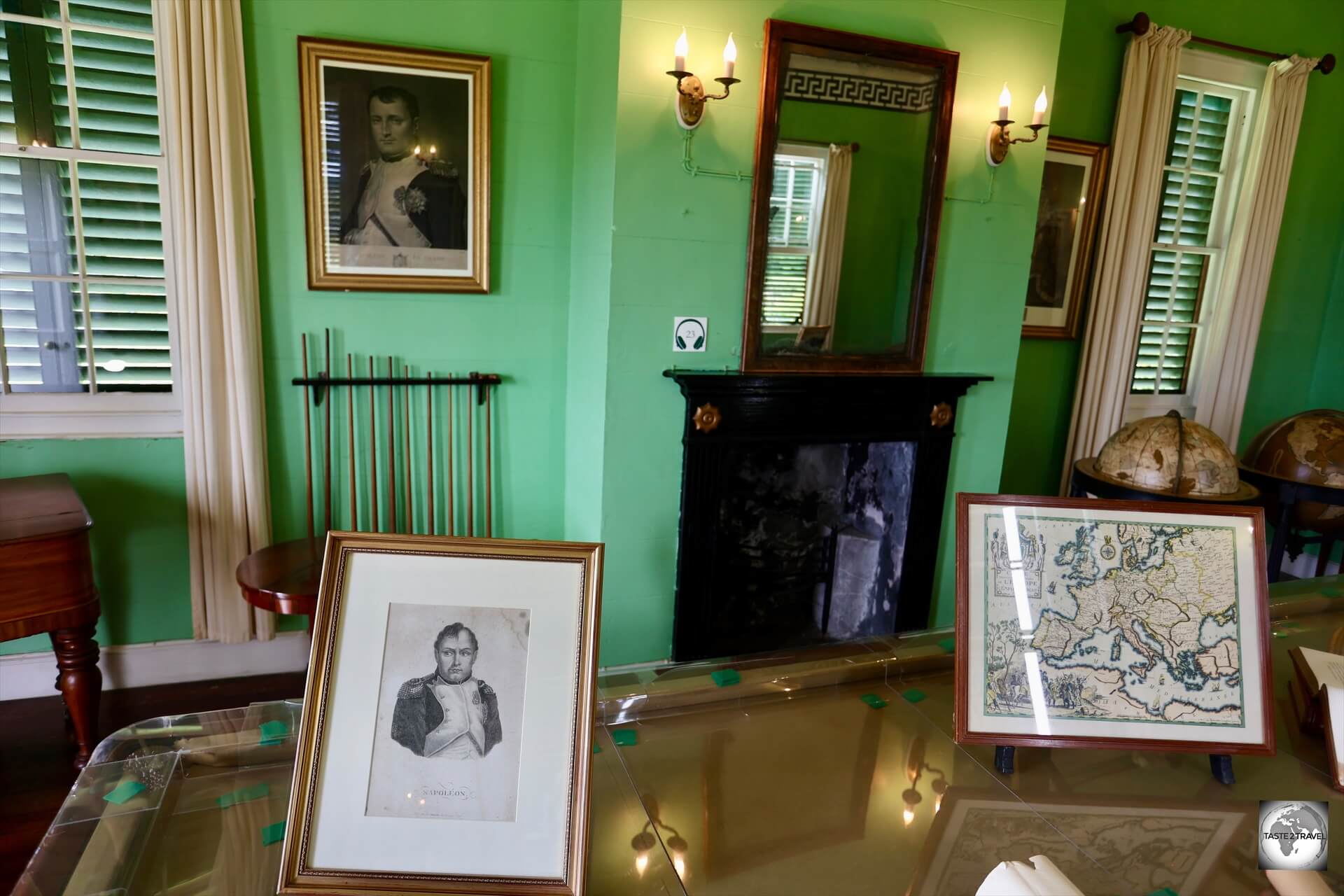
Portraits of Napoleon, and a map of his former empire, in the Billiard/ Map room at Longwood House.
Napoleon never played billiards, however, so he used the table for reviewing maps and documents from his former empire.
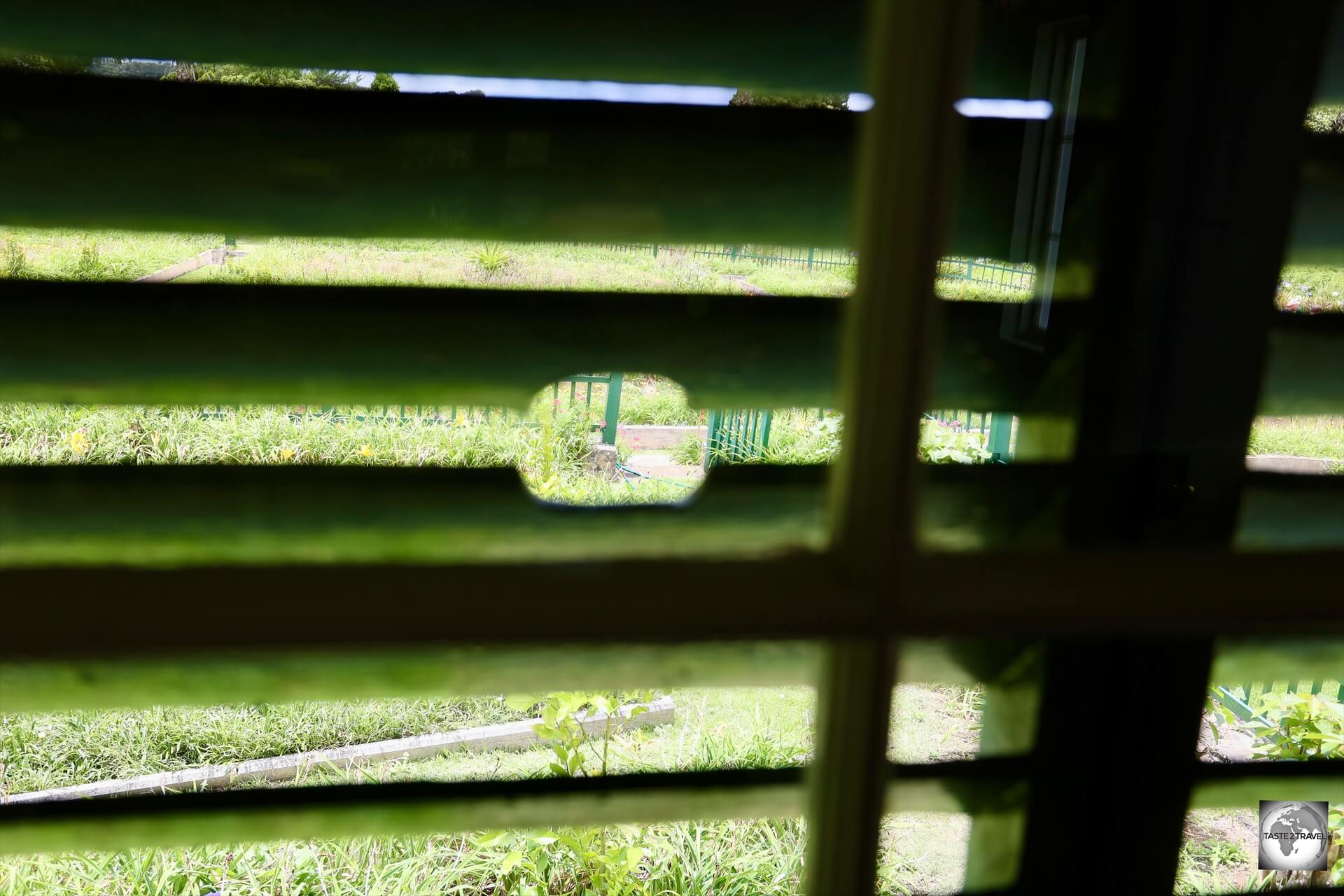
Apparently shy, Napoleon carved peep-holes in the wooden shutters in the Billiard/ Map room so he could spy on the garden staff.
Later, the billiard table was moved to the back of the house for the servants to use, however it is now back in the Billiard/ Map room.
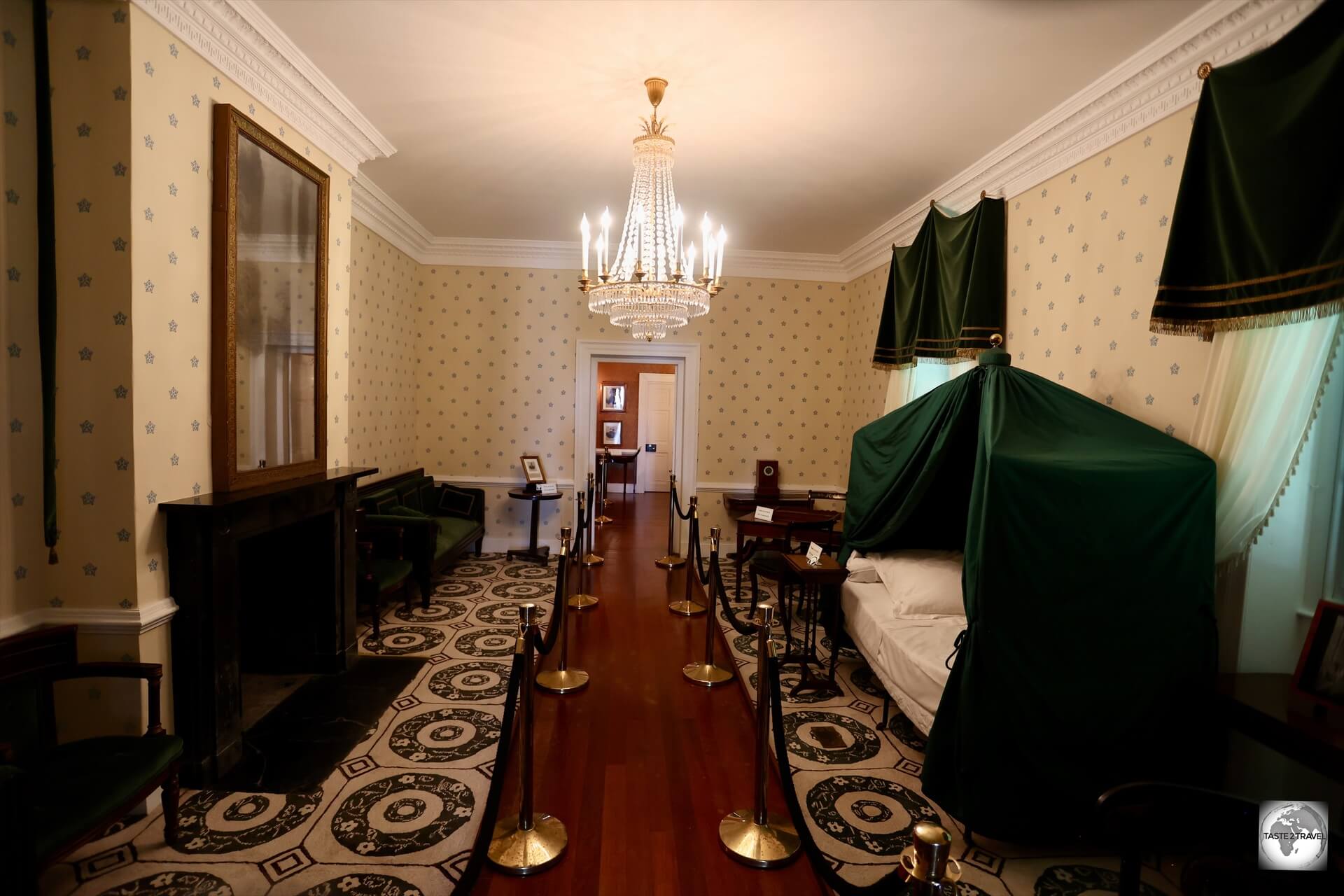
A view of the Salon with Napoleon’s death bed on the right-side wall.
The 2nd room in the house is the Salon, which is the most famous room in Longwood House since this is where Napoleon died at 5:49 pm on 5 May 1821.
The Salon has a door at either end, two windows on one side and a marble fireplace on the opposite side.
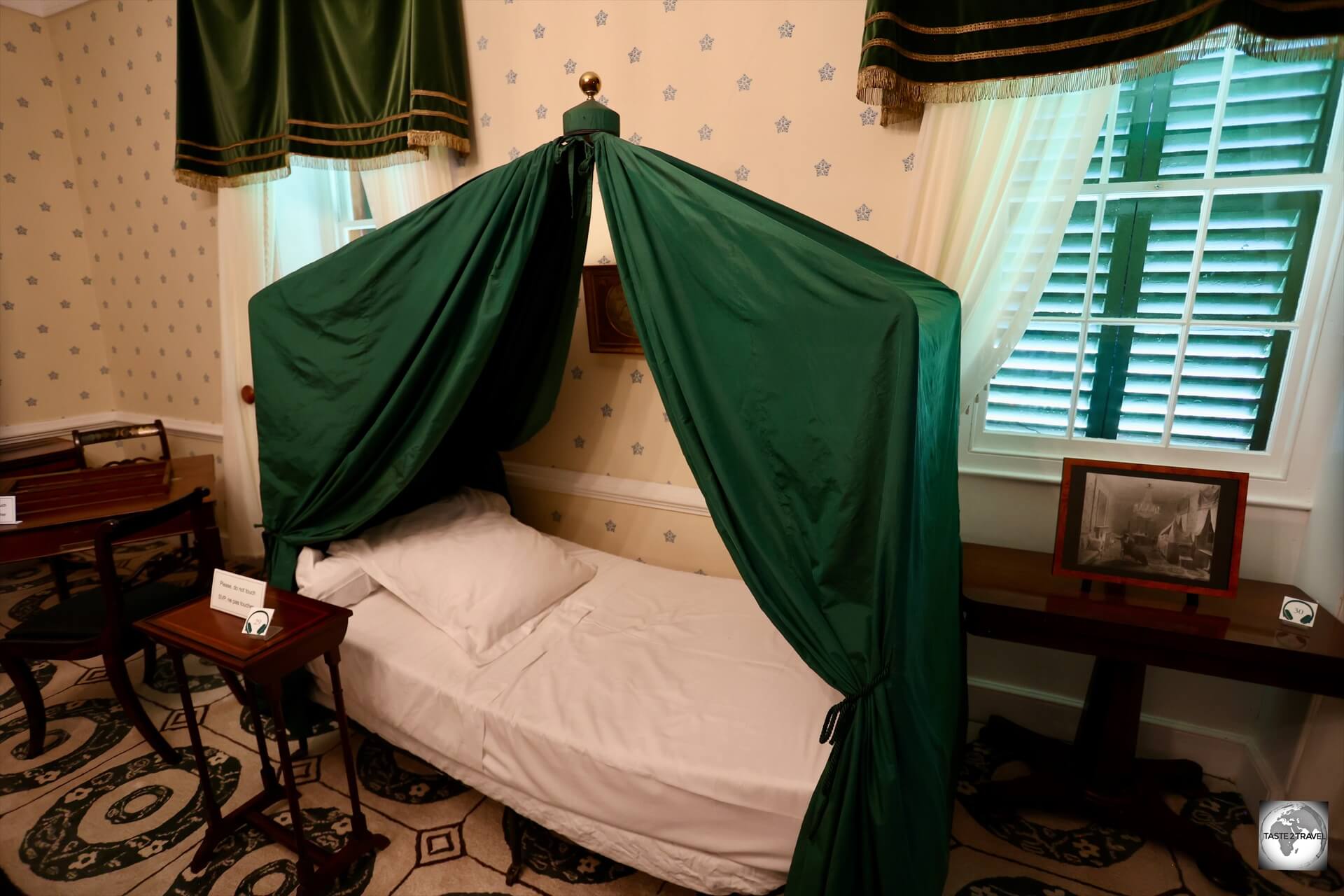
Napoleon died in 1821 at his exact place, in his camp bed, in the Salon room at Longwood House.
Napoleon’s camp bed, which he used at the Battle of Austerlitz, was moved into the Salon from the small stuffy, adjacent, bedroom on 28 April, shortly before his death.
His bed was placed between the only two windows in the Salon, to provide Napoleon with better ventilation.
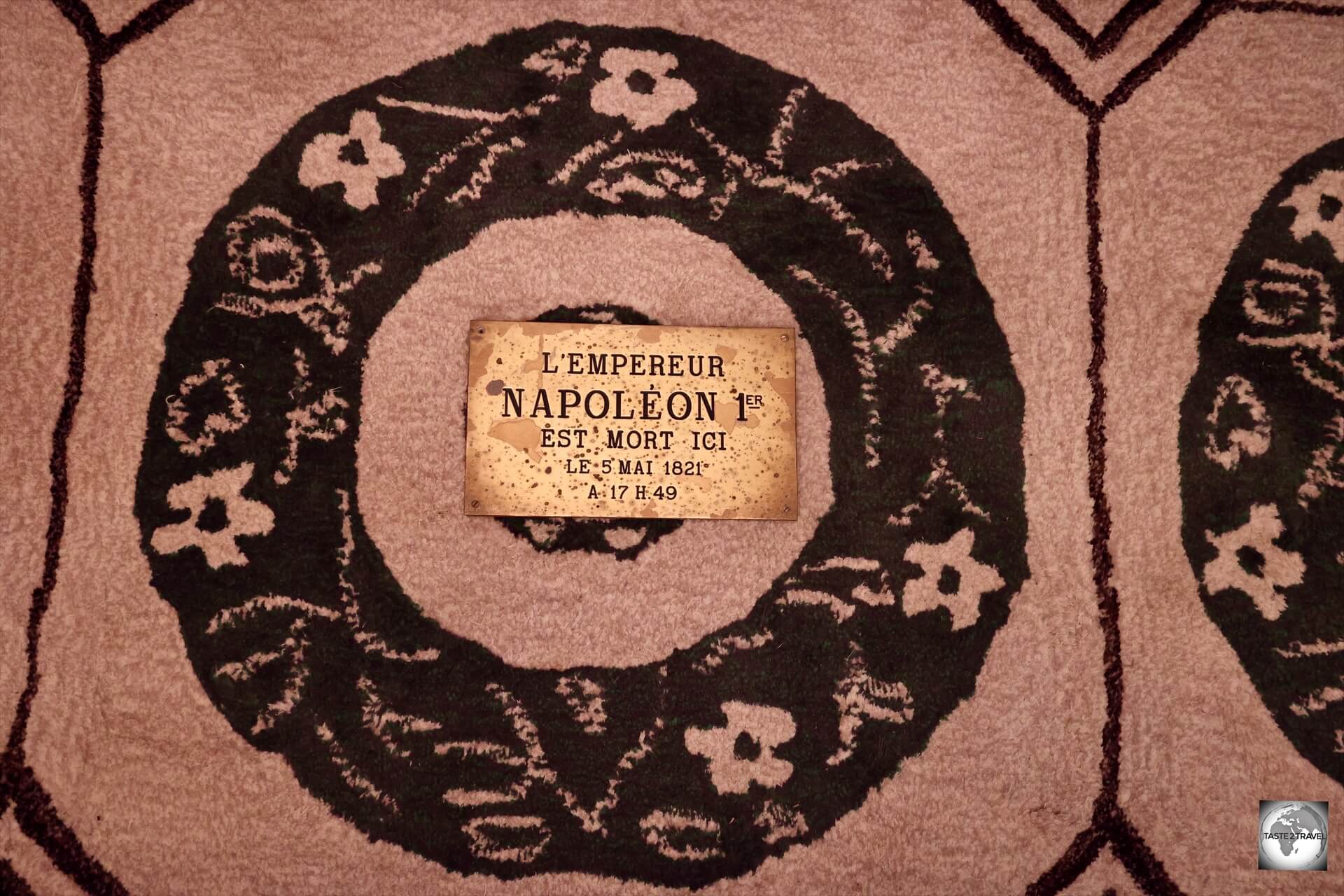
A brass plaque in front of Napoleon’s bed marks the spot where Napoleon died in 1821.
A brass plaque, in front of the bed, indicates this as being the place where Napoleon died in 1821.
Beyond the Salon is the Dining room which still features all of the original wooden furniture, including the dining table, from the time of Napoleon’s residence.
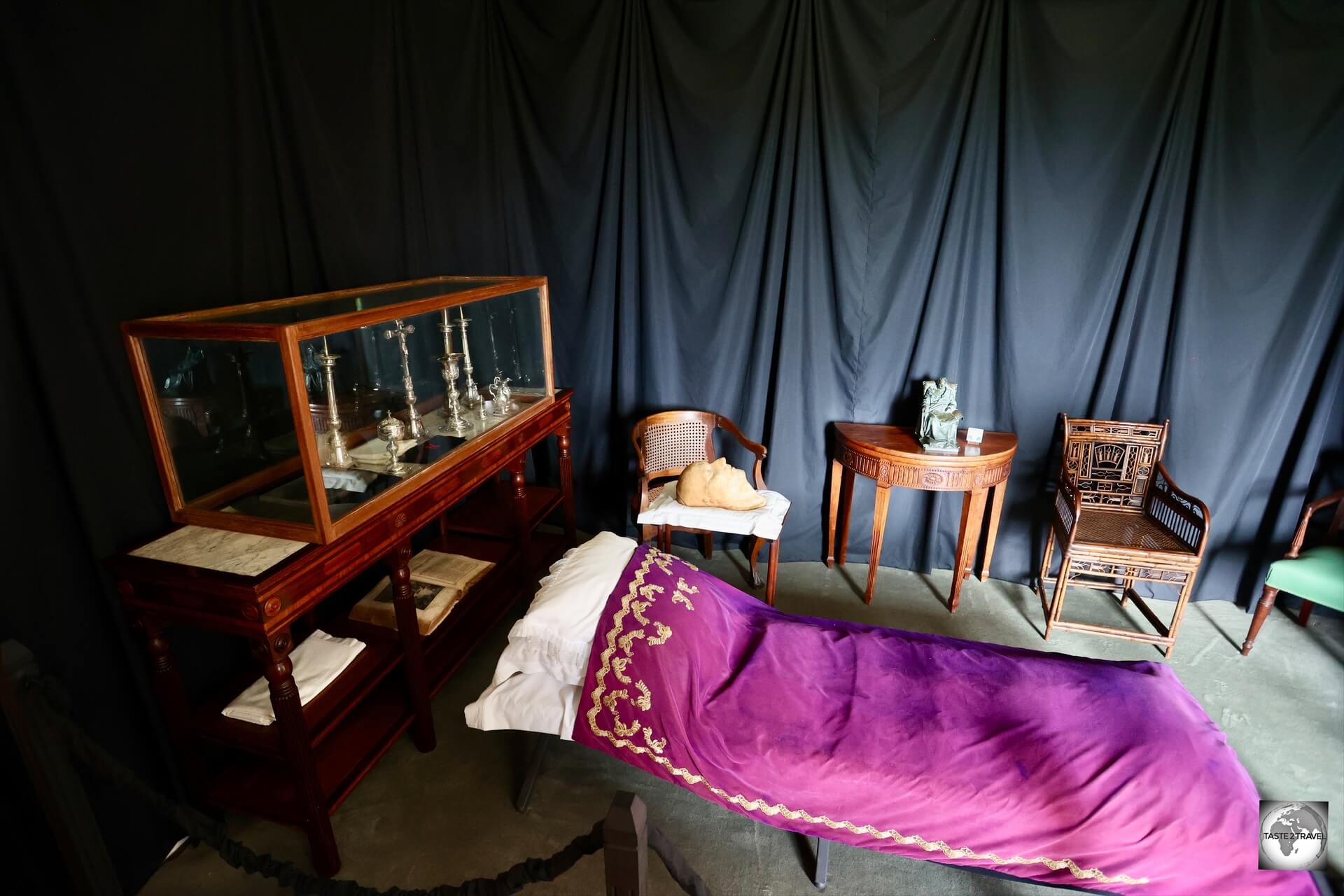
One of the least comfortable rooms at Longwood House, the Emperor’s Study was used after Napoleon’s death as a Mortuary Chapel.
From the Dining room, a door leads into one of the least comfortable rooms at Longwood House, the Emperor’s Study, which was used after Napoleon’s death as a Mortuary Chapel.
With no fireplace, Napoleon considered this room to be the equivalent of a cold cellar, which proved to be the perfect place to store his body after he died.
The walls of the room are lined with black cloth to signify its role as a mortuary.
A death mask of Napoleon lies on a chair next to the bed.
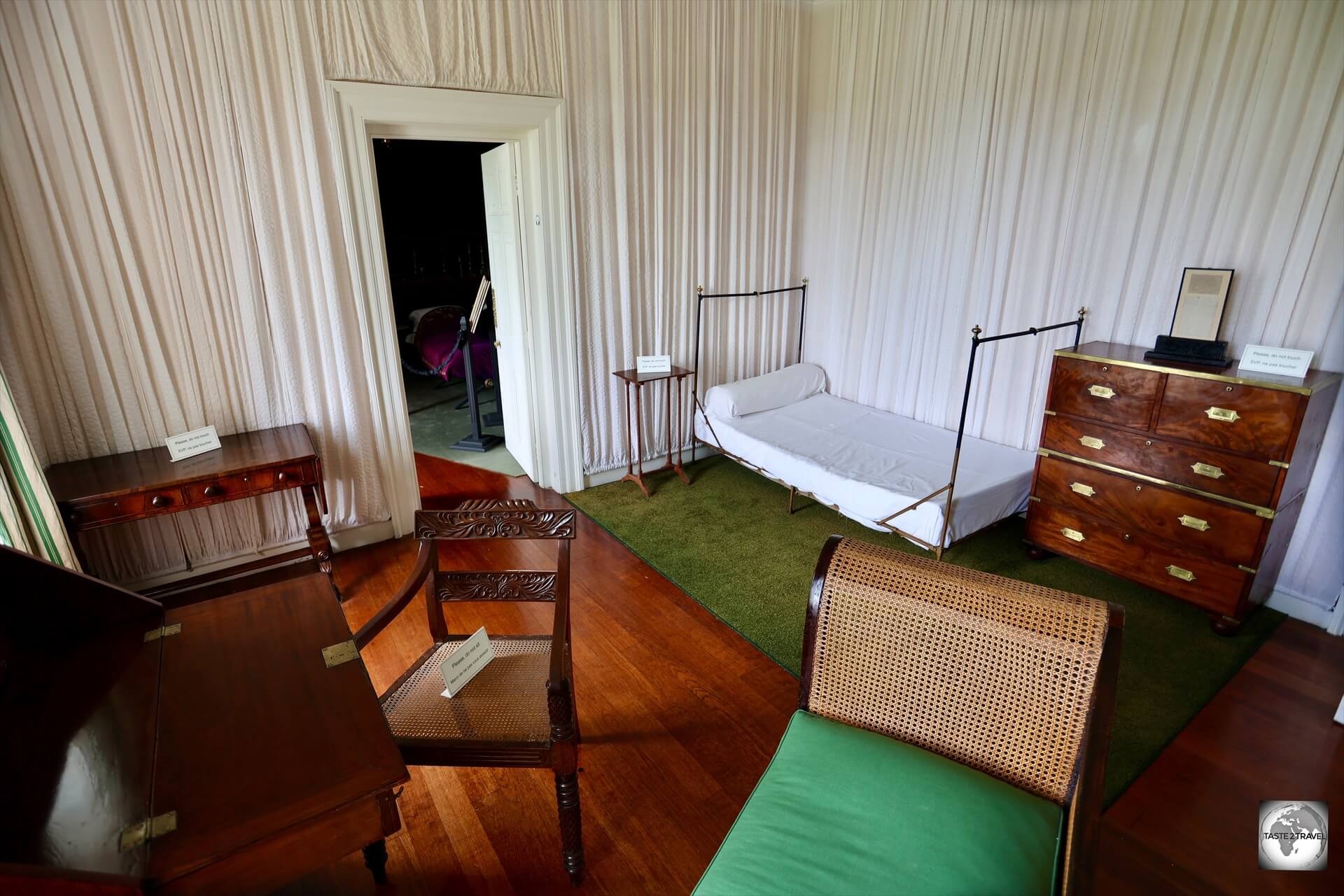
The Emperor’s Bedroom served as Napoleon’s bedroom during his exile at Longwood House.
Following on from the Emperor’s Study, you next enter the Emperor’s Bedroom.
Napoleon did not always sleep here, he sometimes slept in his study on one of his camp beds.
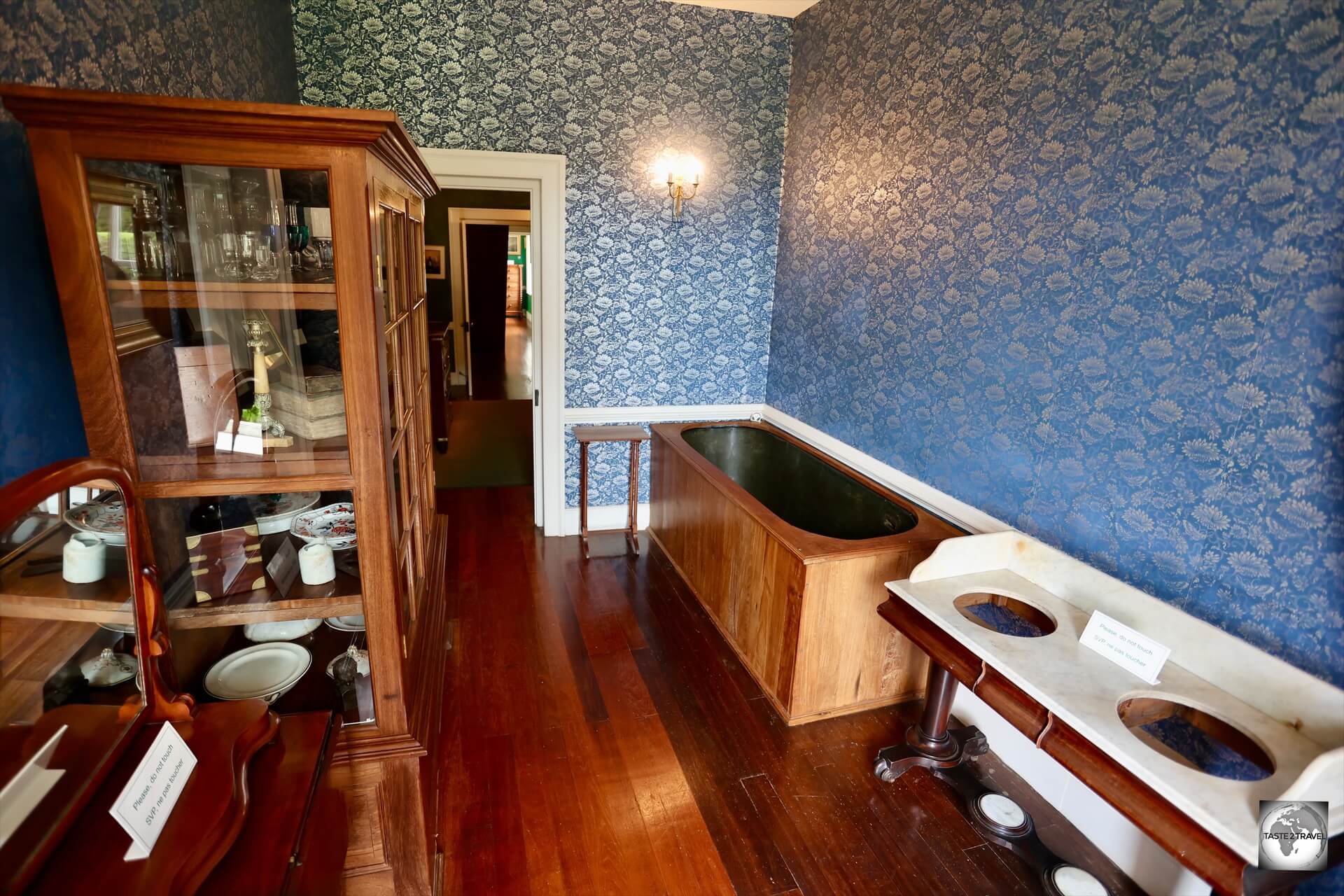
A view of the bathroom at Longwood House with the copper bathtub which Napoleon used to soothe his many ailments.
From the bedroom, the next room is the Bathroom which features a deep copper bathtub which Napoleon apparently spent many hours in, soothing his many ailments.
Napoleon’s Tomb
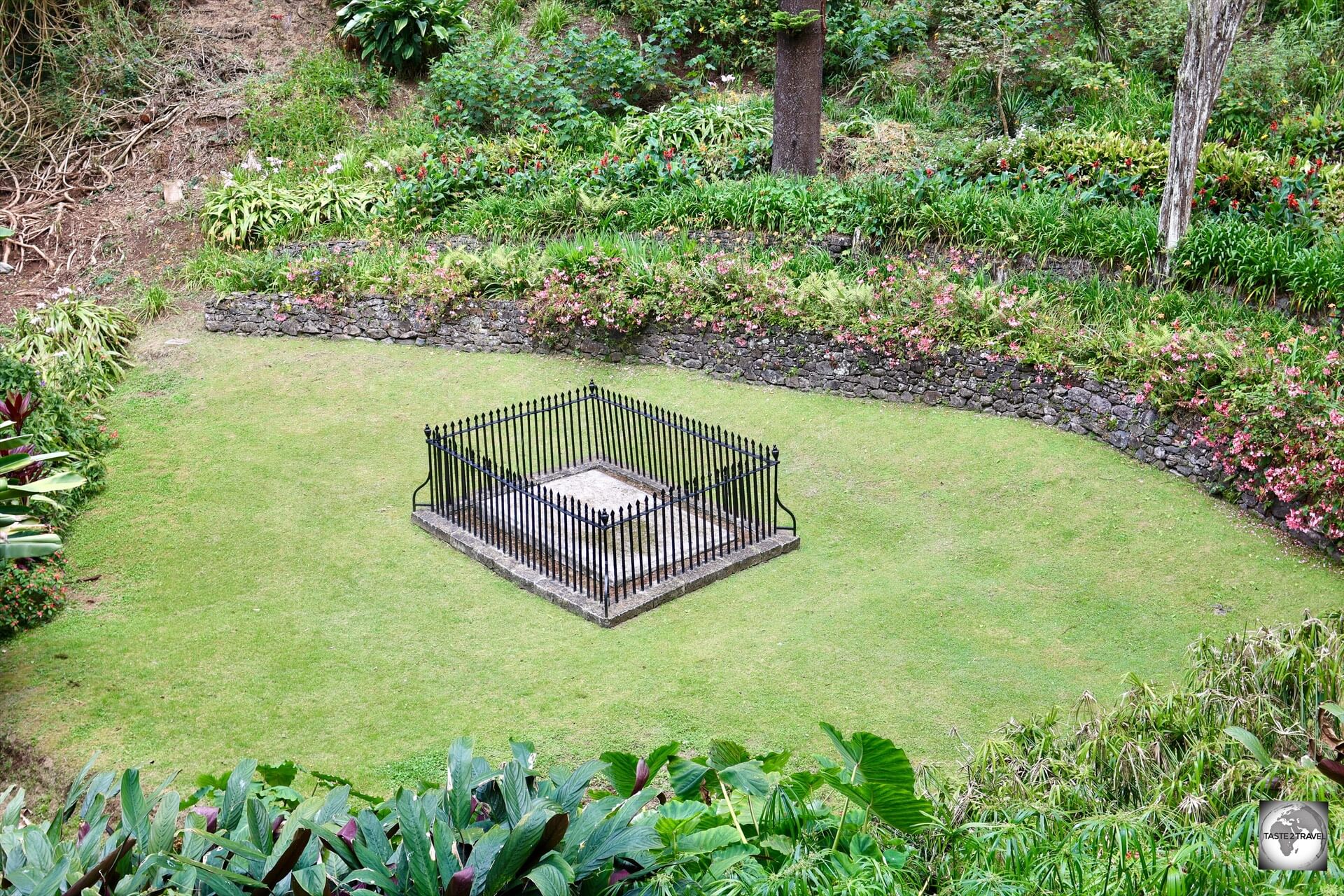
Napoleon’s tomb on Saint Helena is set in a small valley which was a favourite recreation place for Napoleon during his exile.
In his will Napoleon asked to be buried in Paris, on the banks of the River Seine, but the British Governor, Hudson Lowe, insisted he should be buried on St. Helena, in the Valley of the Willows (now Sane Valley), which is located a few kilometres from Longwood House, back towards Jamestown.
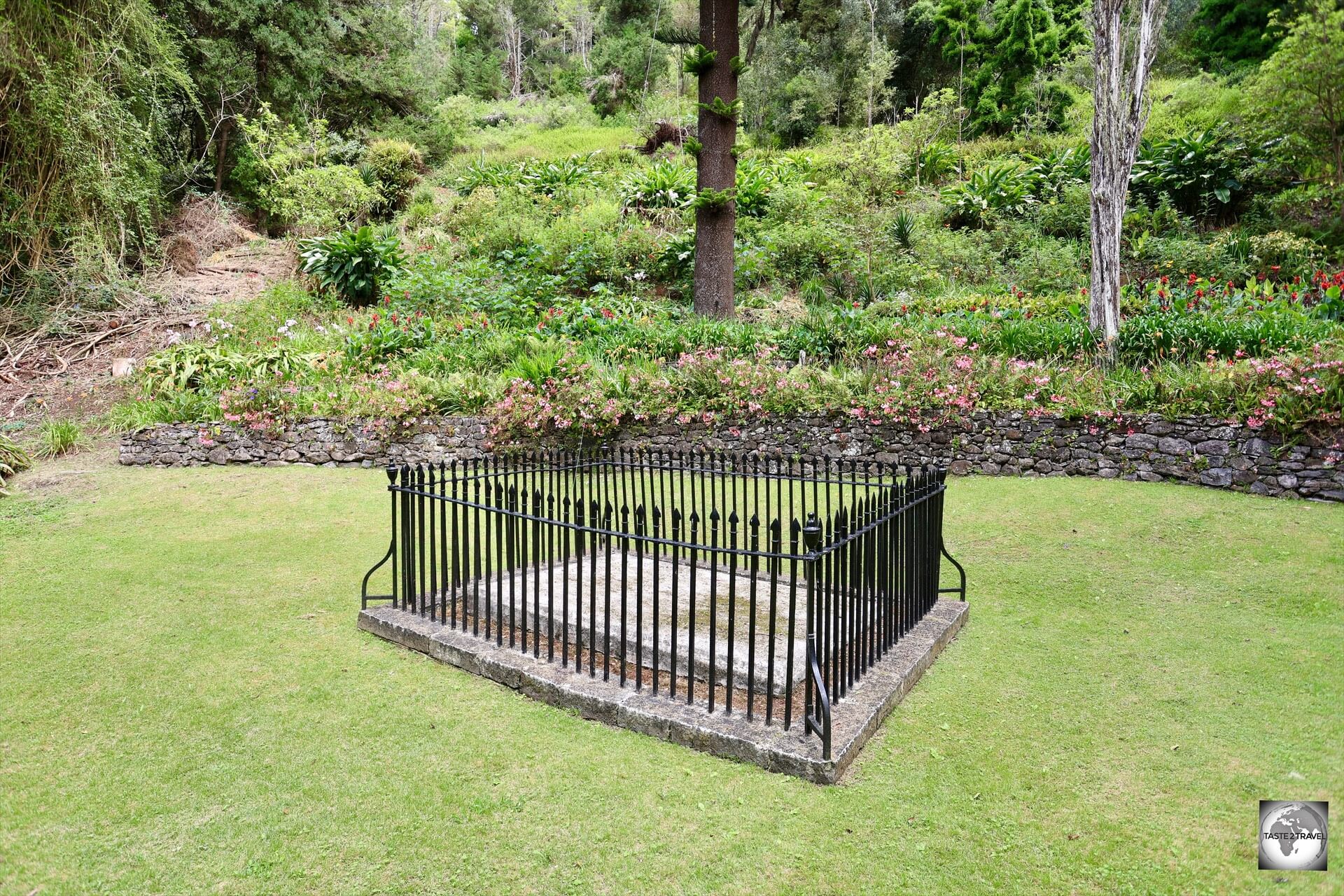
A view of Napoleon’s tomb, in the Valley of the Willows, on Saint Helena.
The valley was a favourite recreation place for Napoleon during his exile.
A 500-metre long, downhill, trail leads from a small parking area on the Longwood to Jamestown road to an observation point which overlooks the tomb.
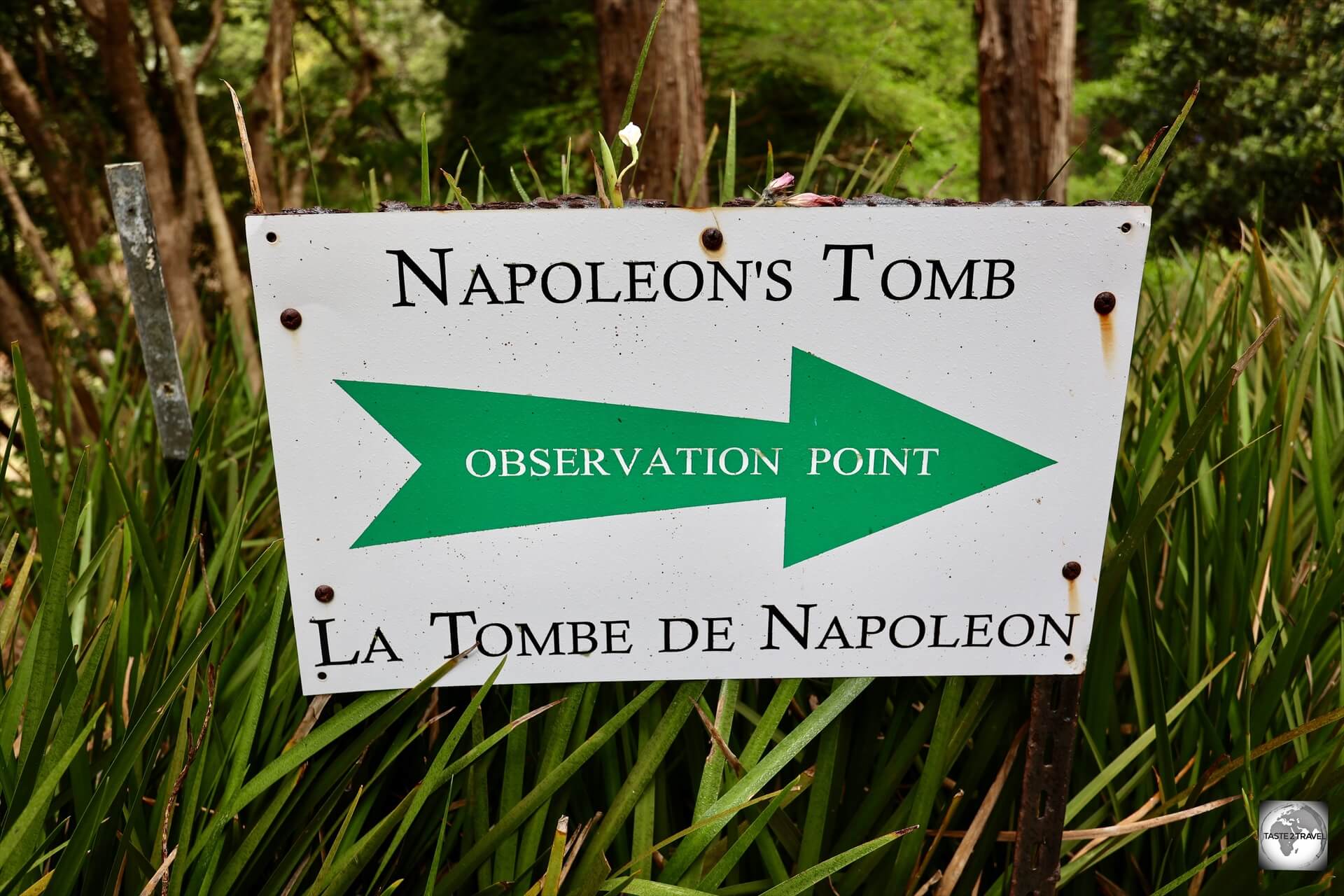
Napoleon was buried on Saint Helena in 1821 and then transferred to Paris in 1840.
A gate at the trailhead is open from 9 am to 3 pm.
Although tickets for Longwood House also include entrance to the tomb, there was no one in attendance at the tomb to check my ticket when I visited.
The tombstone, which bears no inscription, is set in a small valley, surrounded by several trees, among which are 12 cypress trees planted in 1840 in memory of Napoleon’s twelve great victories.
In 1858 the two properties – Longwood House and Napoleon’s Tomb ground – were purchased by France, although the United Kingdom has ultimate sovereignty over them.
Tickets:
The ticket price for Longwood House and Napoleon’s Tomb is £10.
Opening hours:
- Longwood House is open every day from Monday to Friday from 11 am to 1 pm.
- Napoleon’s Tomb is open every day from Monday to Friday from 9 am to 3 pm.
Napoleon’s Tomb in Paris
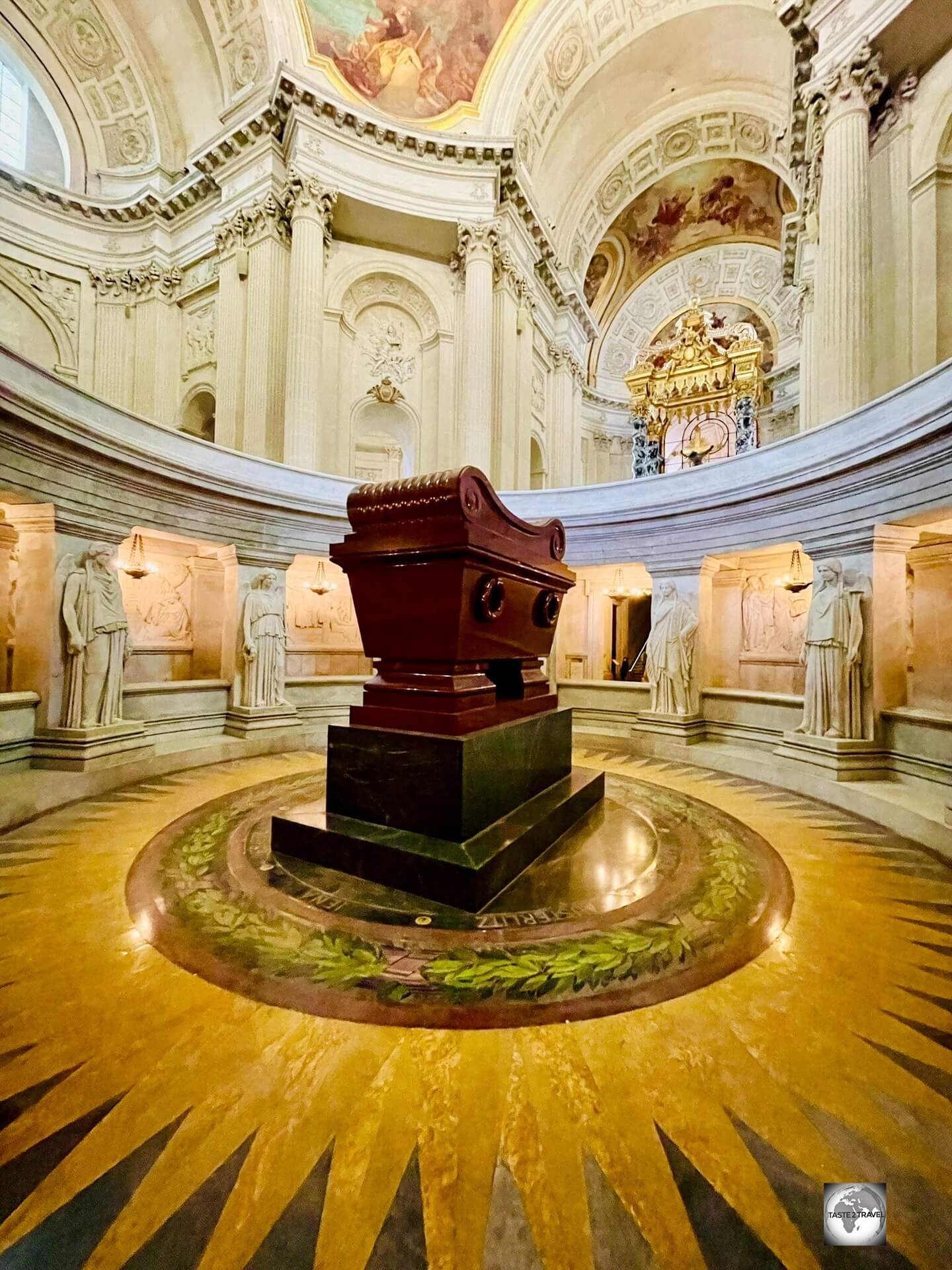
Napoleon’s tomb at the Hôtel des Invalides in Paris.
Prior to my visit to Saint Helena, I spent time in Paris where I was able to visit Napoleon’s current tomb at the Hôtel des Invalides.
In what was known as the “Retour des Cendres” (“return of the ashes”), in 1840, Napoleon’s remains were transferred from Saint Helena to Paris, arriving in Paris in December of that year.
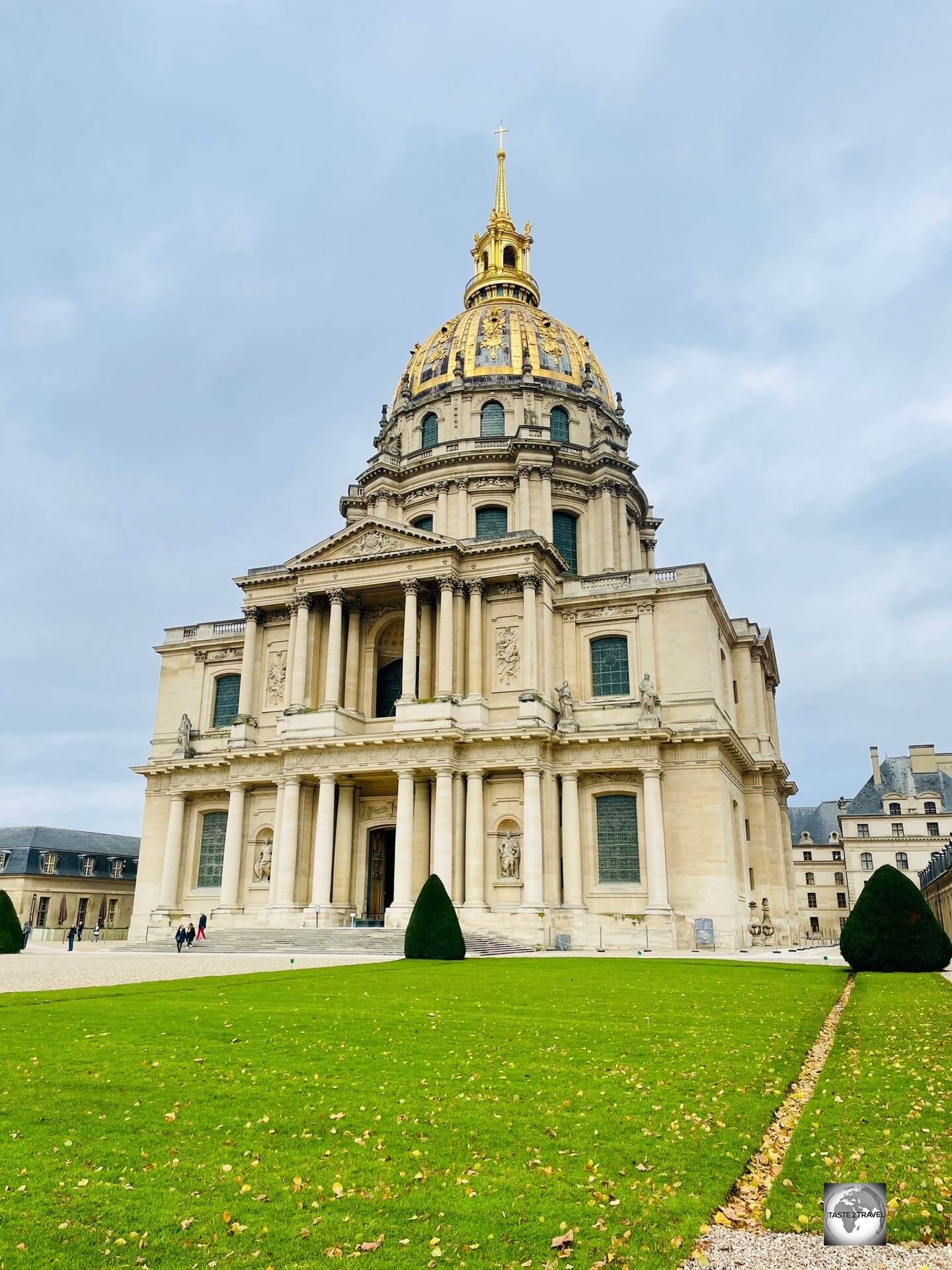
Napoleon’s tomb is located in the Church of the Dome at the Hôtel des Invalides in Paris.
Napoleon was then entombed in a crypt in the Church of the Dome in the Hôtel des Invalides, where he remains today.
The crypt is surrounded by a circular gallery with 12 pillars, sculptures and bas-reliefs celebrating Napoleon’s life and military victories.
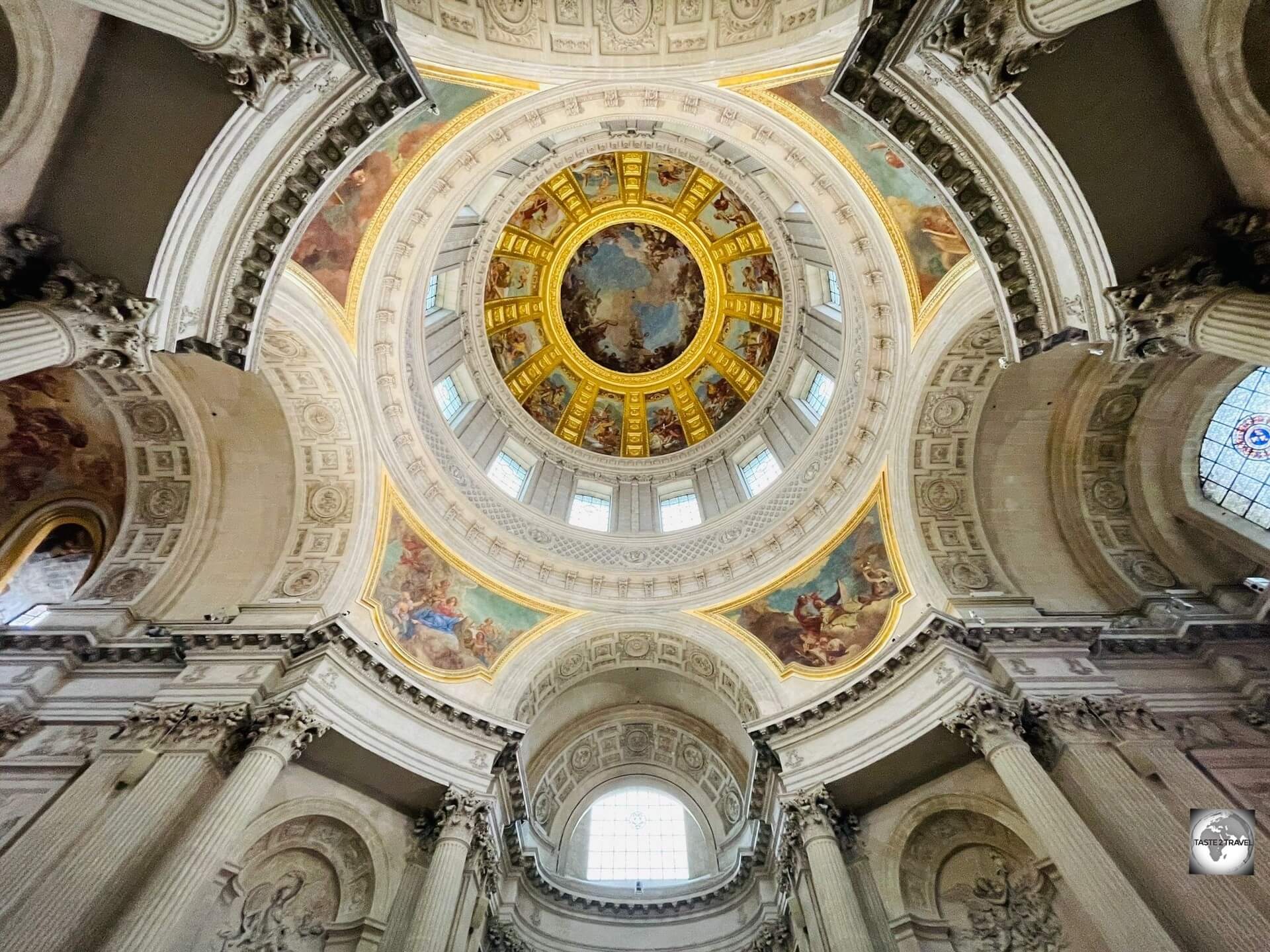
A view of the spectacular Church of the Dome at the Hôtel des Invalides in Paris.
The construction of the tomb took nearly another 20 years, so his body was only laid to rest here in 1861.
Saint Helena Golf Course
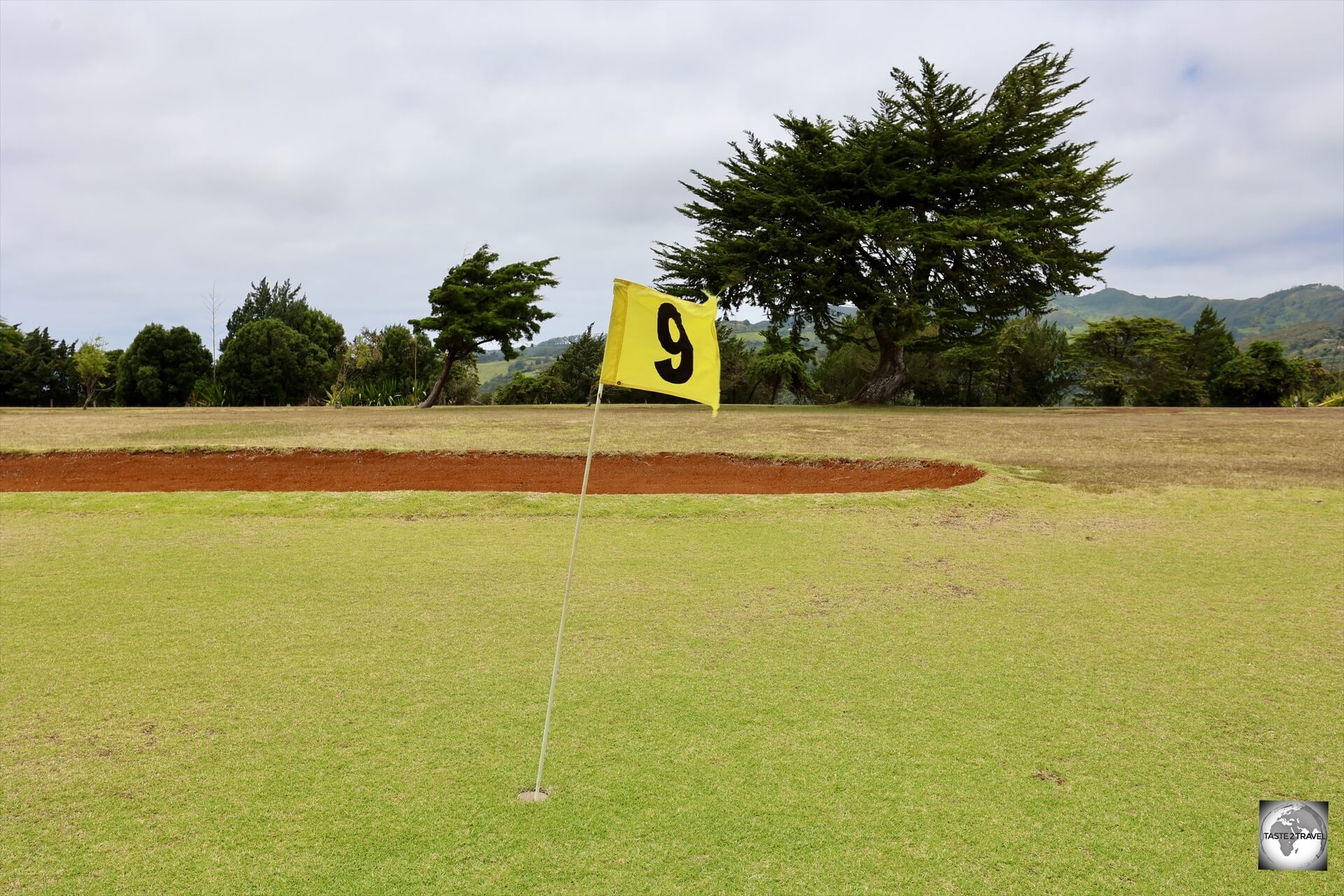
Saint Helena boasts a 9-hole golf course in Longwood, just around the corner from Longwood House.
Offering weedy and patchy fairways, and not at all to international standards, the Saint Helena Golf Club offers a semi-challenging 9-hole course a short drive from Longwood House.
The course is more frequented by grazing goats than golfers which is a good thing since the main road crosses the course four times.
For those who are keen to tee off, you can contact the club at:
- Facebook: https://www.facebook.com/shgc.org.sh/
- Telephone: +290 24421
Saint Paul’s
St. Paul’s is one of eight districts on Saint Helena and is the second-most heavily populated district on the island.
Plantation House
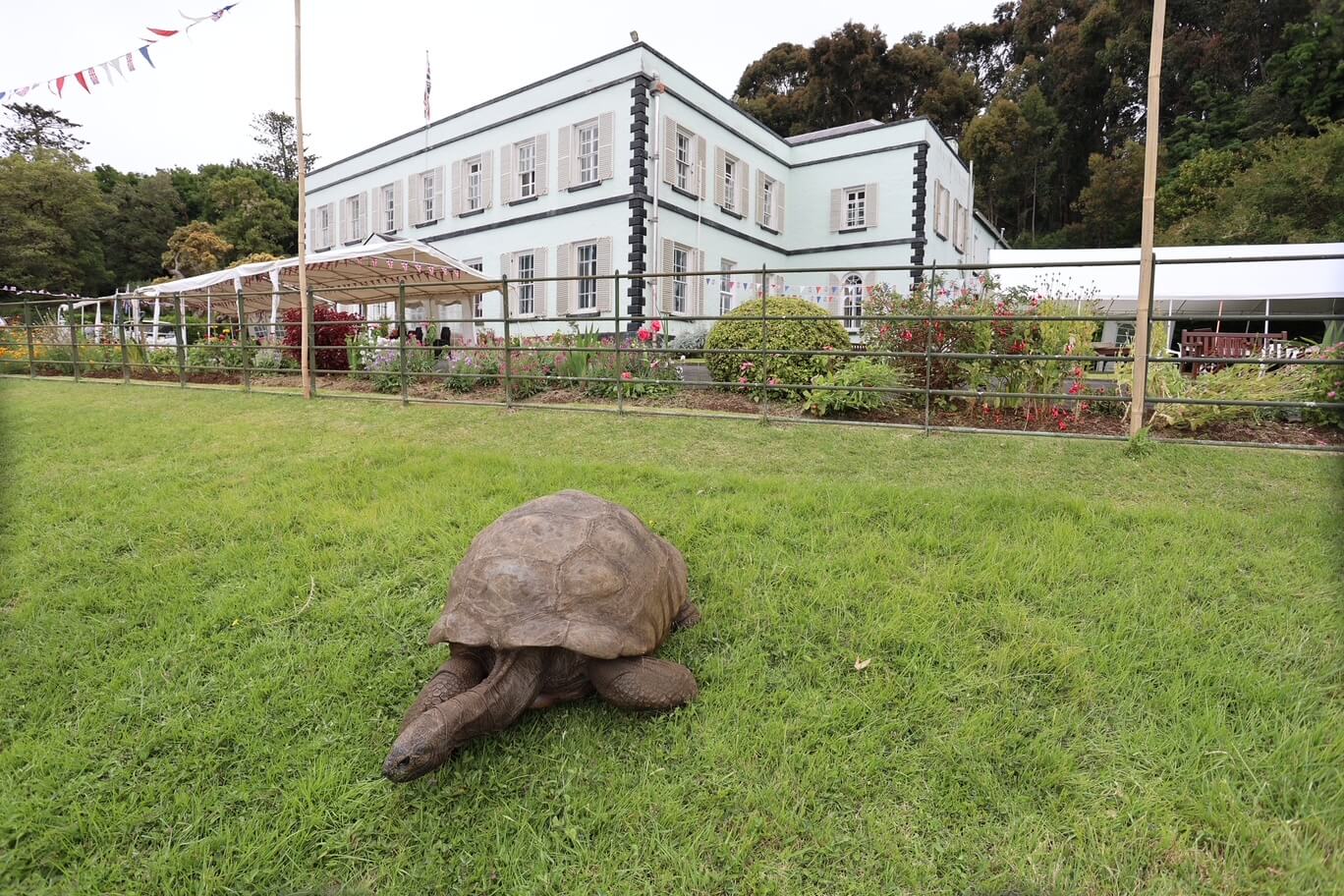
Plantation House is the official residence of the Governor and Jonathan the Tortoise.
Located south of Jamestown, Plantation House was built between 1791-92 by the East India Company (EIC) as a summer residence for the governor.
The company governed the island until 1834, when it became a crown colony, although governors of the island have continued to use the property since.
Jonathan the Tortoise
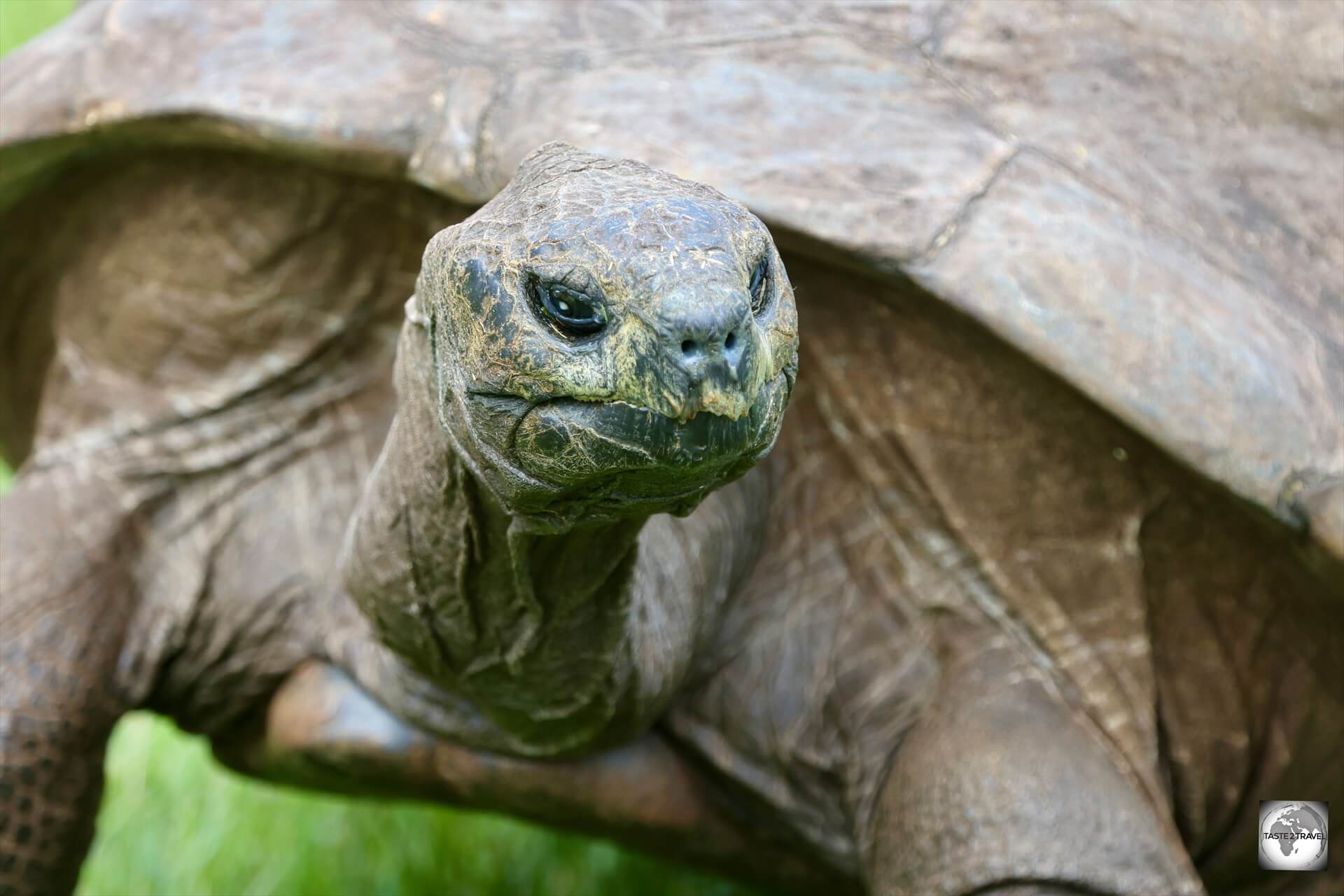
The world’s oldest living creature, Jonathan the Tortoise is celebrating his 193rd birthday in 2025.
While many governors and come and gone over the years, the most famous, and by far the longest, resident of Plantation House is Jonathan the Tortoise.
Jonathan (hatched c. 1832) is a Seychelles giant tortoise, a subspecies of the Aldabra giant tortoise.
Celebrating his 193rd birthday in 2025, Jonathan is believed to be the oldest living creature on earth.
Jonathan resides in the private grounds at Plantation House but the friendly staff at the Jamestown Tourist Office can organise for you to visit and take photos.

Jonathan the Tortoise arrived on Saint Helena from the Seychelles in 1882.
A Seychelles giant tortoise, it is believed that Jonathan was hatched around 1832, and was brought to Saint Helena from the Seychelles in 1882, along with three other tortoises at about 50 years of age.
Apart from Jonathan, there are 3 other giant tortoises in residence at Plantation House.
St. Paul’s Cathedral
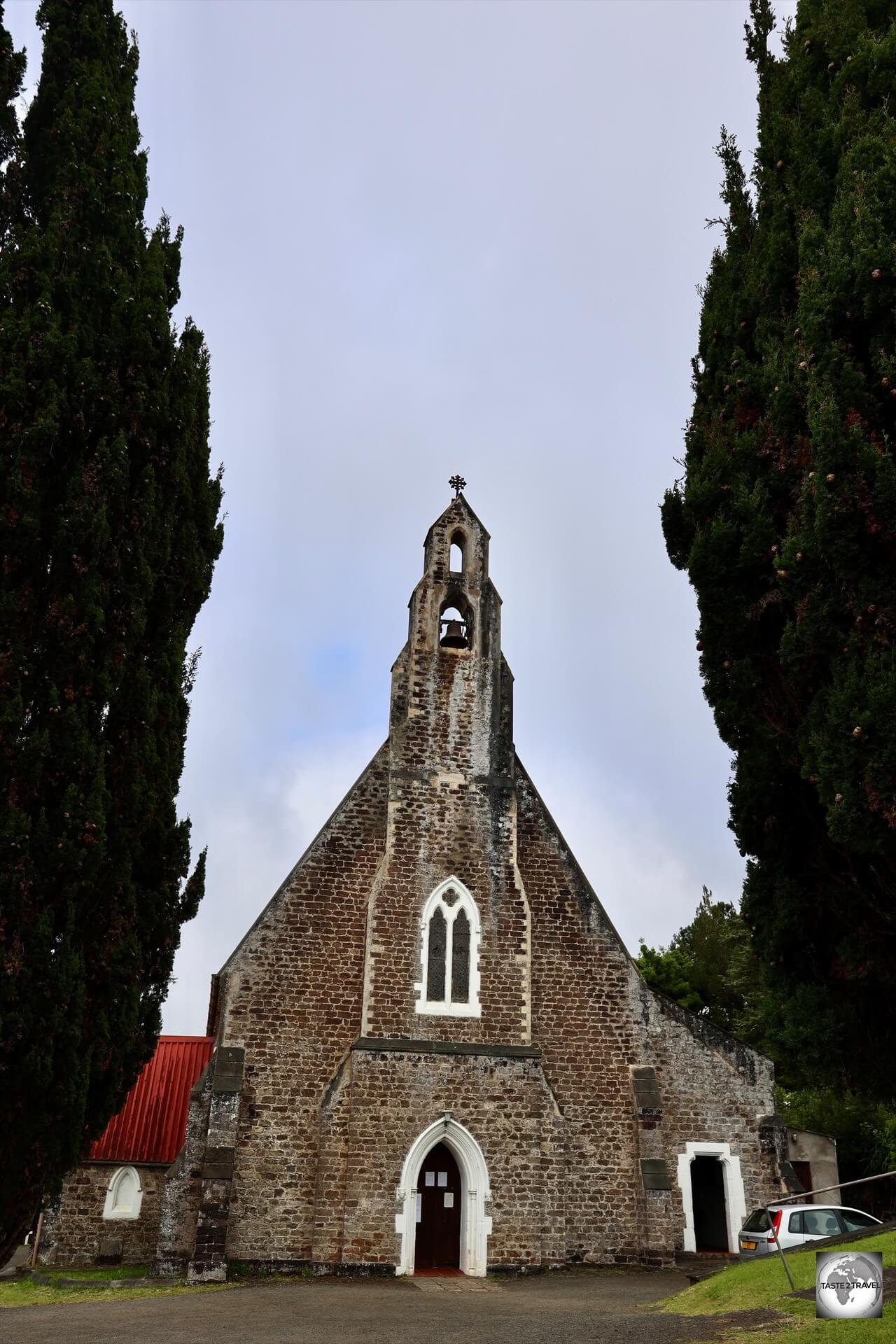
St. Paul’s Cathedral – one of the remotest Anglican churches in the world.
Saint Paul’s Cathedral is located approximately 3 km (2 mi) south of Jamestown in the district of St Paul’s.
It replaced “the Country Church” which existed from the early days of St Helenian colonisation in the late 17th century.
Building work on the new church began in 1850, was completed in 1851 and the church became the cathedral in 1859.
St. Paul’s Cathedral has the distinction of being one of the remotest Anglican churches in the world.
It is surrounded by a large cemetery.
Boer Cemetery
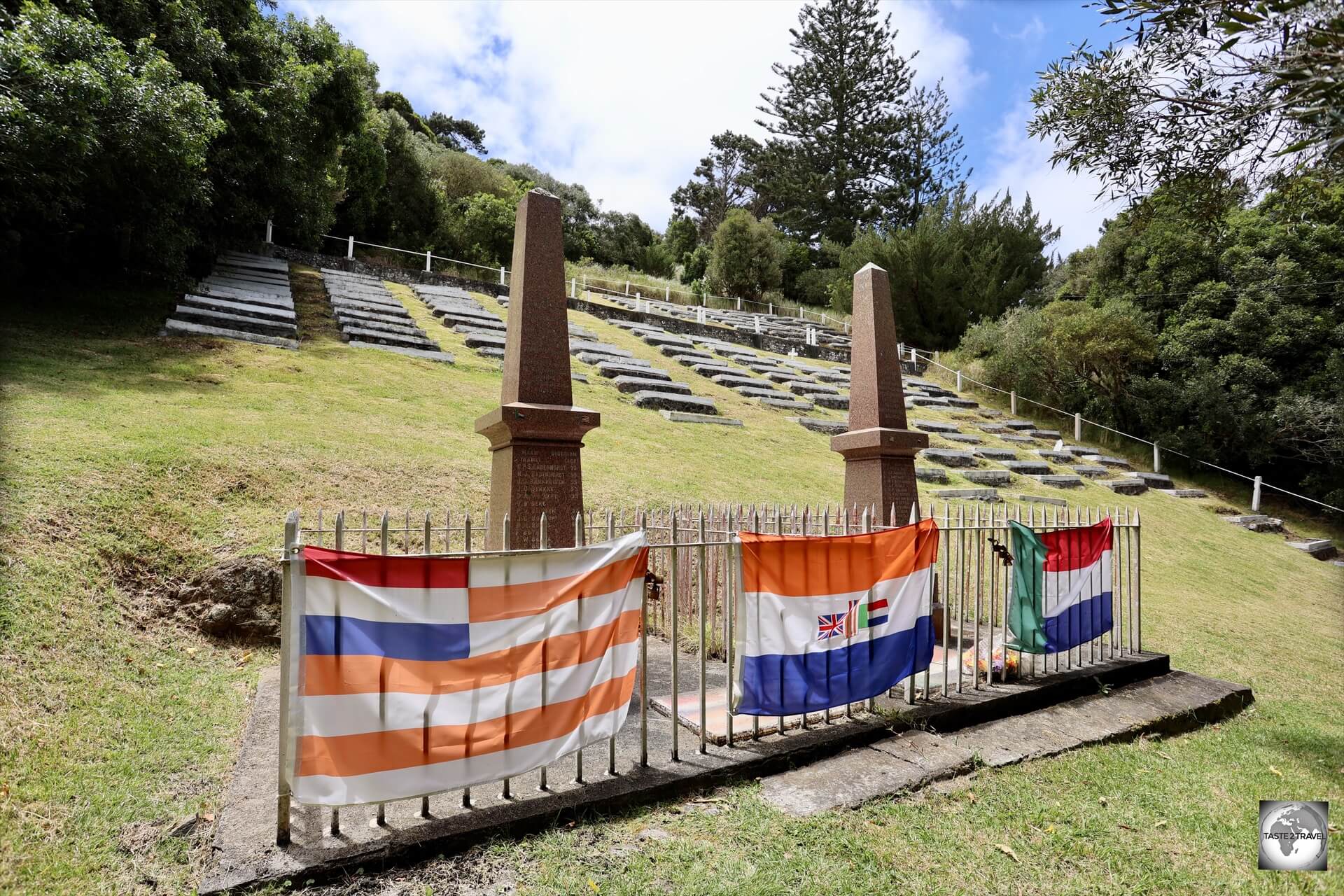
Boer flags and two granite obelisks, which list the names of those buried in the Boer cemetery.
Also located in St. Paul’s, the Boer Cemetery is the final resting place of 200 Boer POWs that were imprisoned on St. Helena and died between 1900 and 1902 during the Anglo-Boer War in South Africa.
From 1900 to 1902, Saint Helena was used as an internment camp for around 5,000 Boer prisoners who the British had captured during the war in South Africa.
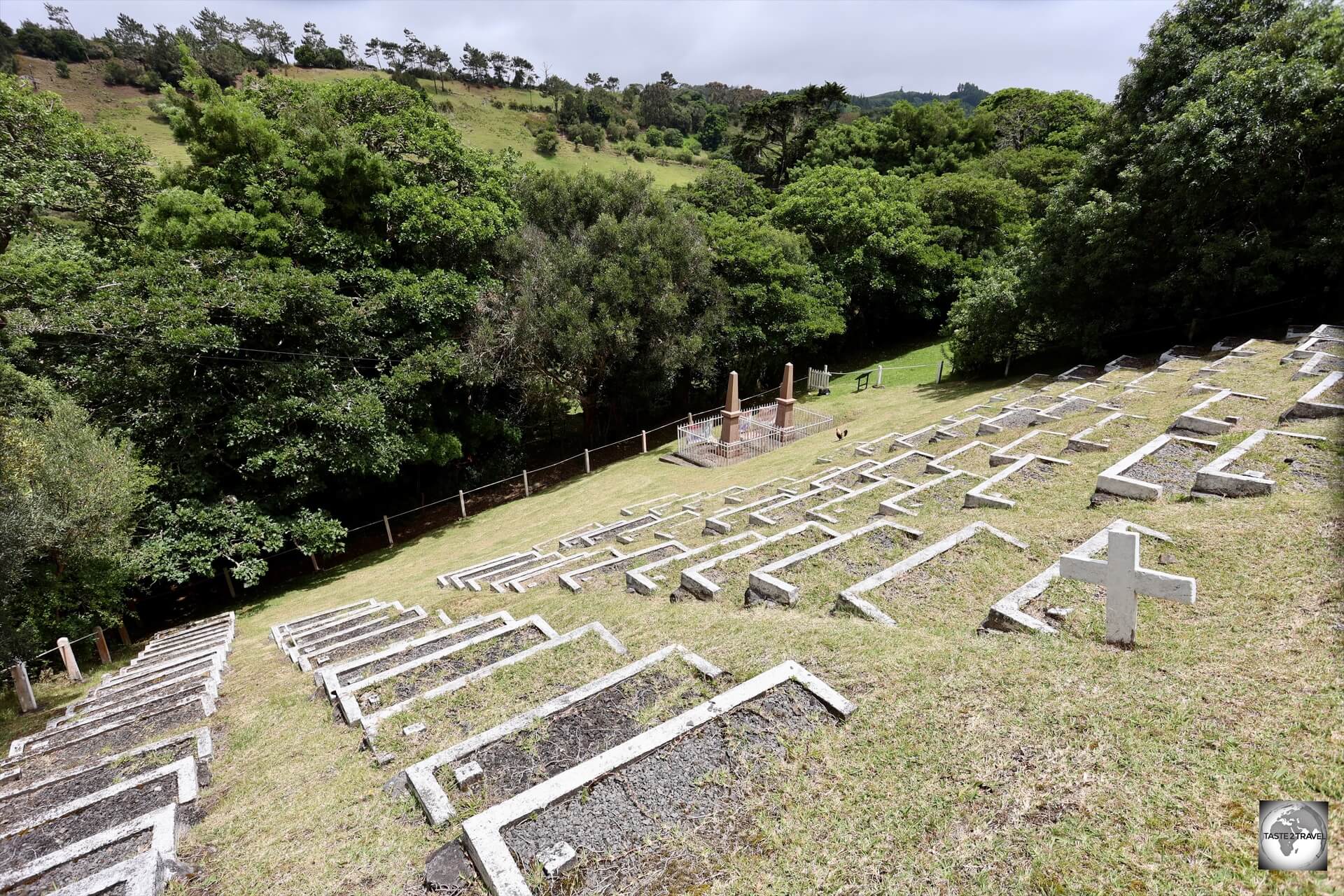
The Boer Cemetery is the final resting place of 200 Boer POWs.
The land for the cemetery was provided by the Baptist church, after the Anglican church (i.e. the nearby St. Paul’s Cathedral) refused burials of Boers in their graveyard as they considered them “heathens” as they were Calvinist Protestants.
Two granite obelisks, which list the names of those buried in the cemetery, were installed in 1913.
The cemetery was renovated by the South African Navy in 1991.
What was the Anglo-Boer War?
The Anglo-Boer War, also known as the South African War, was a conflict between the British Empire and the Dutch settlers of the Boer republics in South Africa that lasted from 1899 to 1902.
The war was fought between Britain, who wanted to establish its imperial supremacy in South Africa and the Dutch Boer settlers who wanted to remain independent of the British Empire.
The British were especially interested in gaining control of the Transvaal, which was home to the richest gold fields in the world and the war started when the British tried to cross the border into Transvaal.
The British eventually won the war, allowing them to complete their imperial conquest of the Southern African region.
Sandy Bay
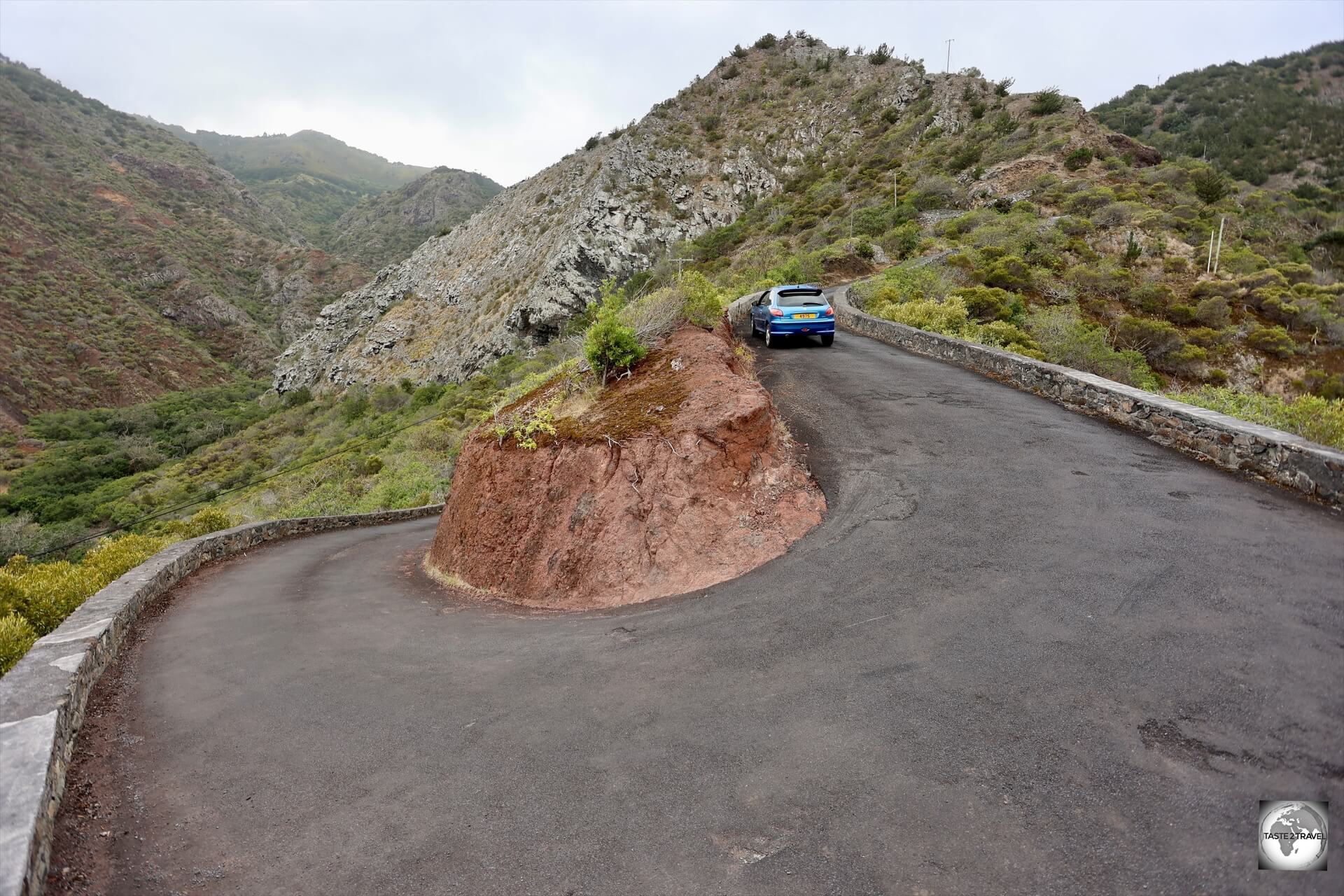
The long, windy and steep road to Sandy Bay.
A long, windy, and very lonely, narrow road plunges down the near vertical terrain to the beautiful black sand beach at Sandy Bay which is surrounded by some spectacular volcanic formations.
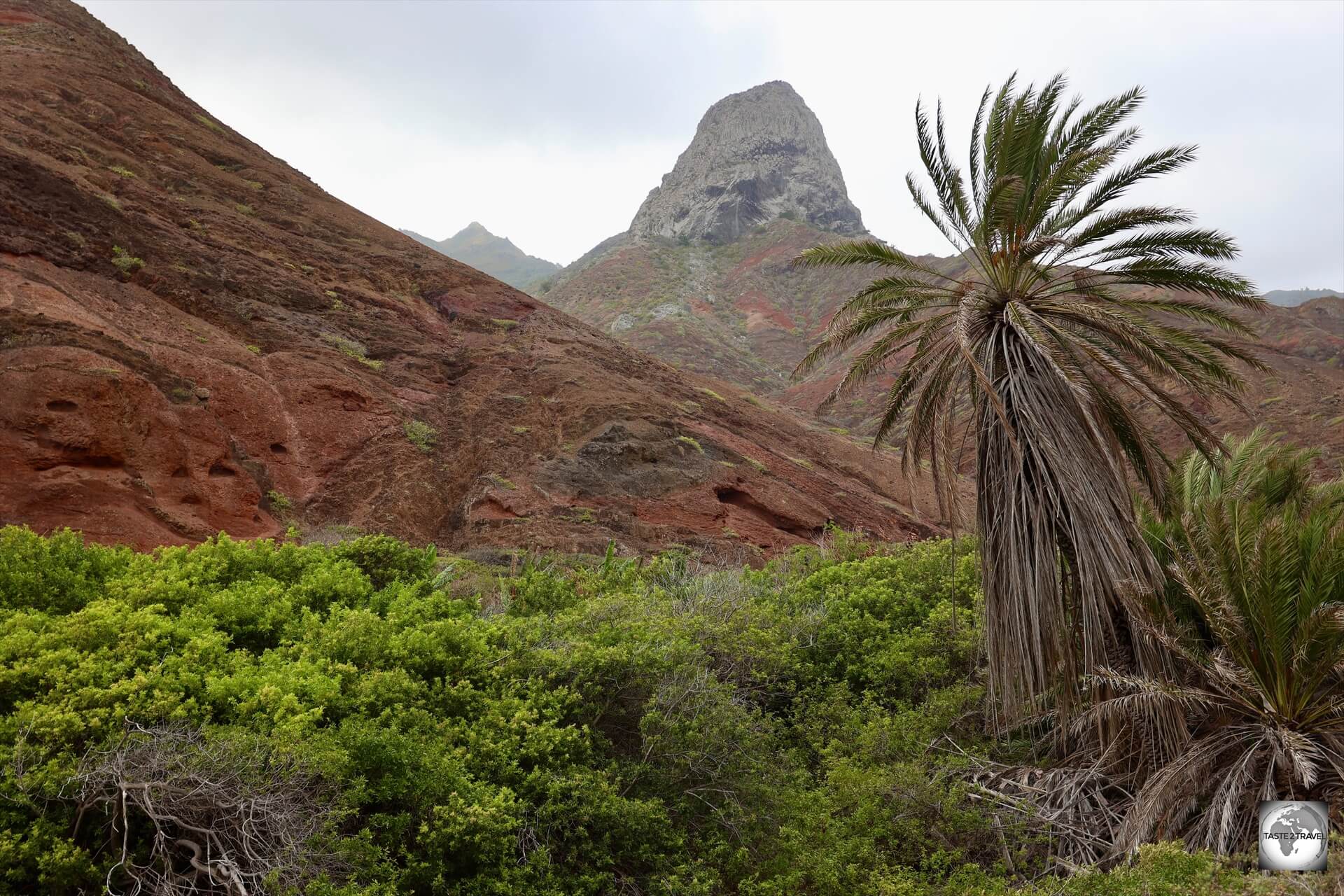
The volcanic plug, known as ‘Lot’, towers over the arid landscape of Sandy Bay.
Only 5% of the island’s population live in Sandy Bay, making it the second least populous district on the island.
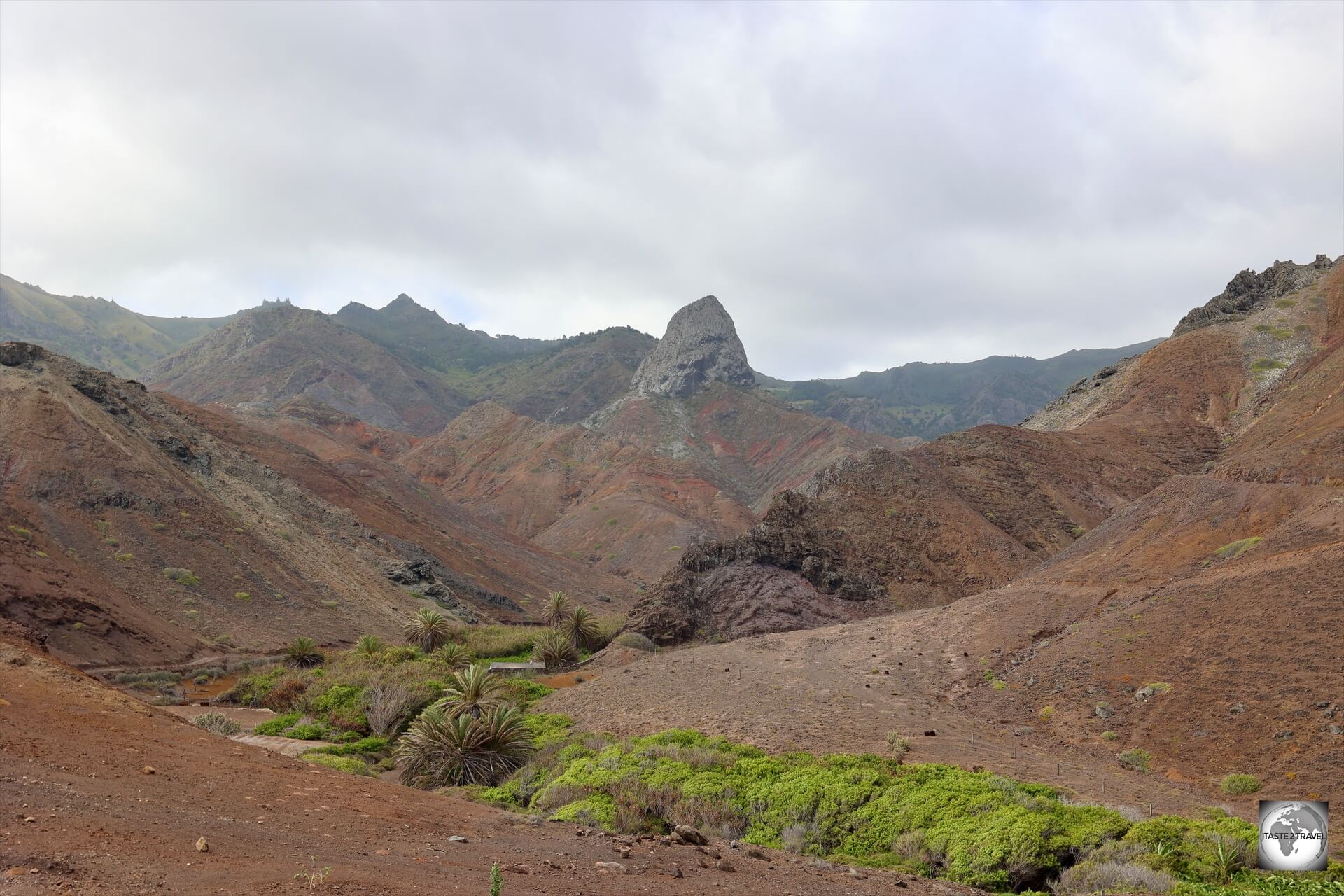
A view of the arid coastal landscape at Sandy Bay with the volcanic formation, ‘Lot’, in the background.
The terrain surrounding Sandy Bay is quite varied, starting with lush, green slopes which plunge quickly down to an arid coastal strip of land which is punctuated by a number of volcanic plugs.
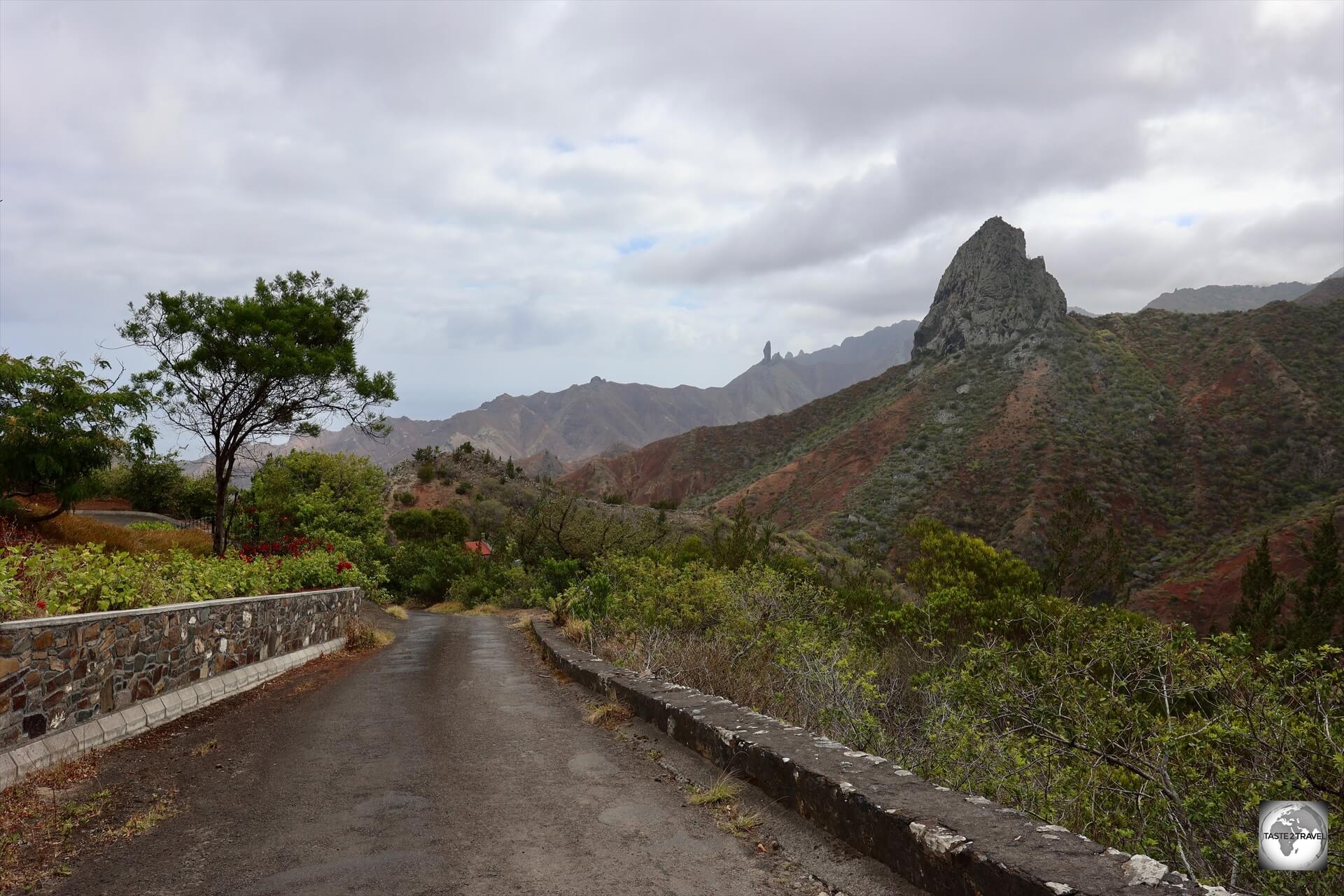
The road to Sandy Bay, with the volcanic plug known as ‘Lot’ on the right.
Sandy Bay Baptist Chapel
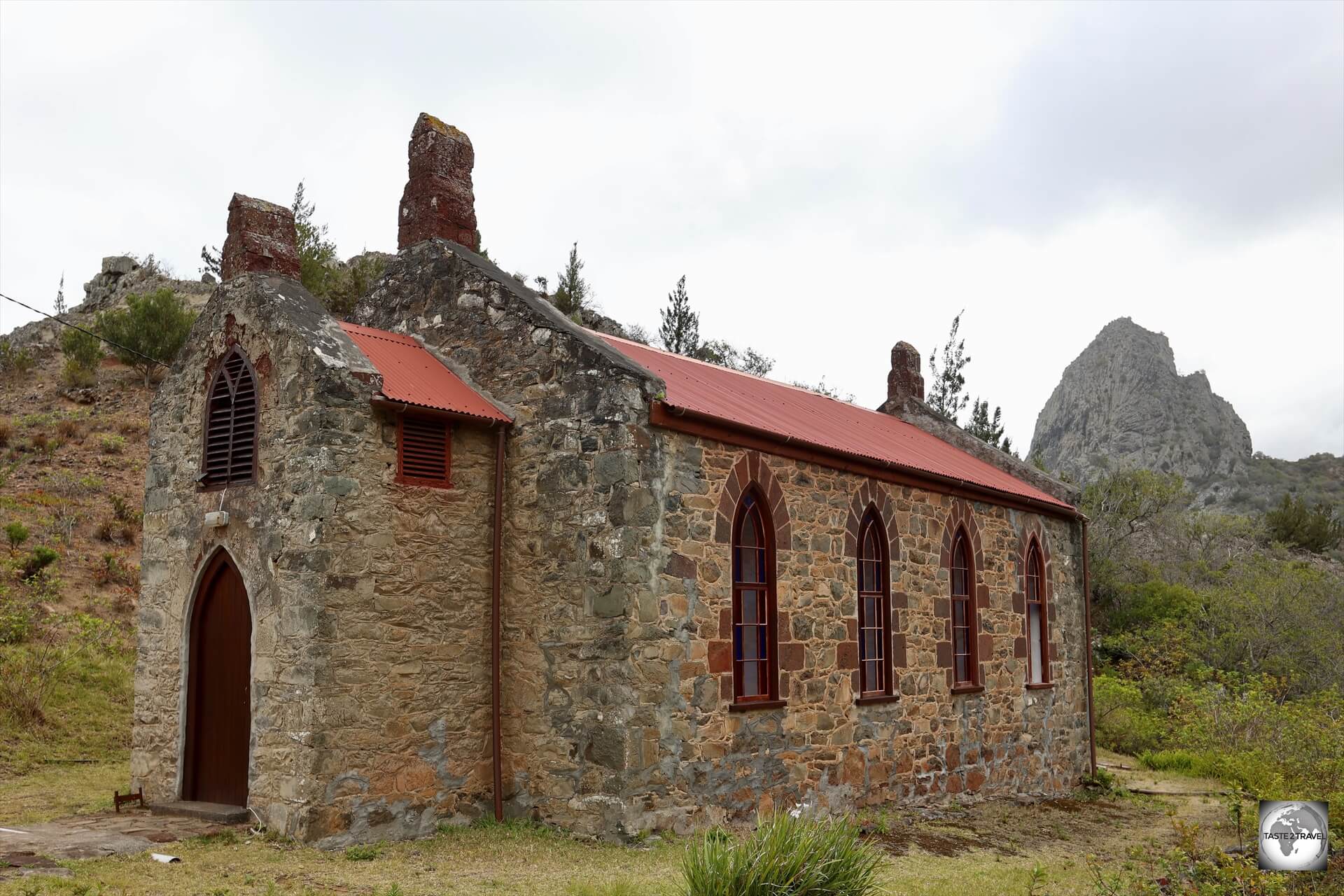
The Baptist Chapel at Sandy Bay, with the volcanic formation ‘Lot’ in the background.
Apart from the spectacular beach, there is a small Baptist Chapel by the side of the road in the small settlement of Sandy Bay.
Sandy Bay Beach
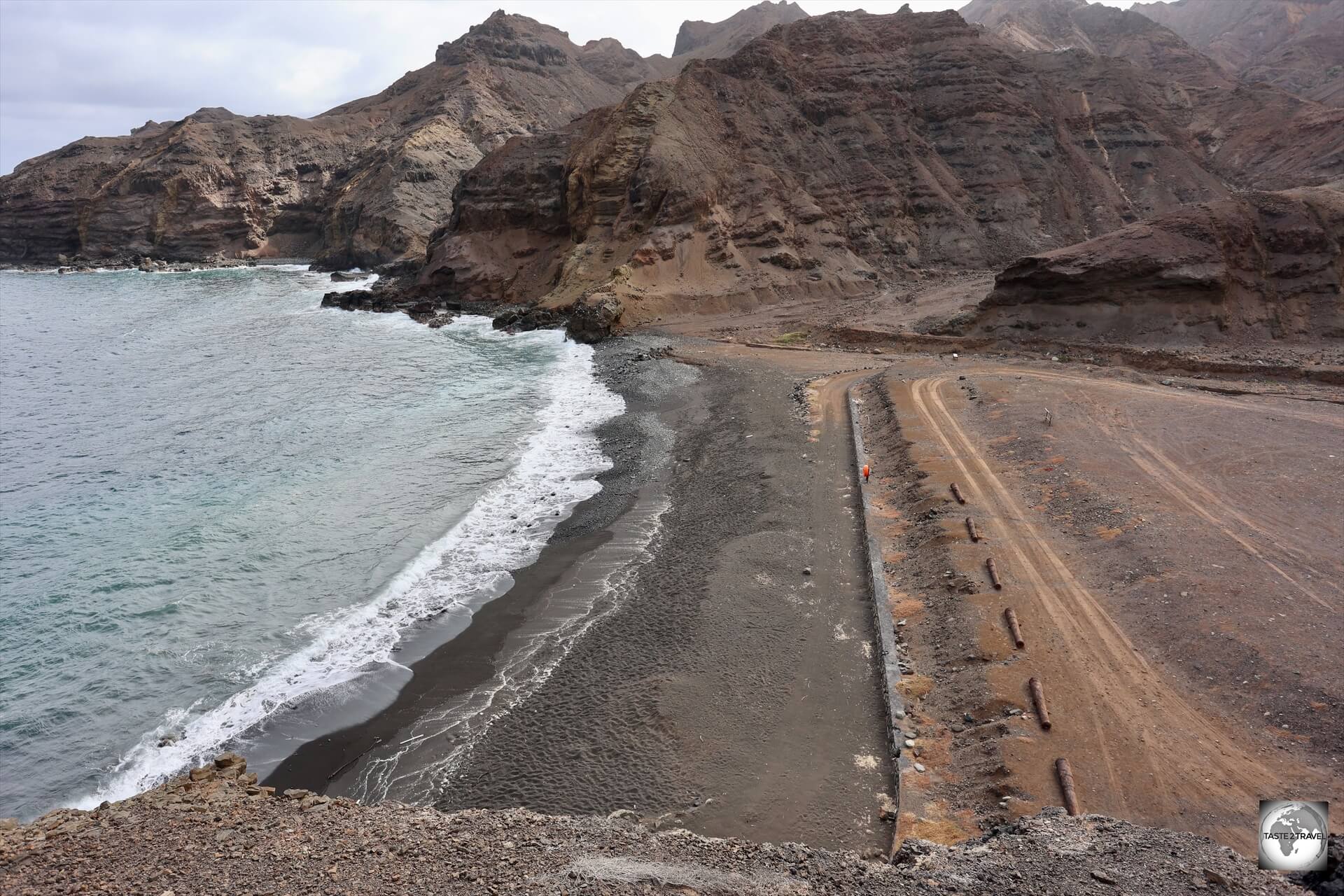
The black sand beach at Sandy Bay, the largest stretch of sand on Saint Helena.
At the end of the road is the beautiful Sandy Bay beach, the only beach on the island, which is home to a stretch of jet-black, volcanic, sand.
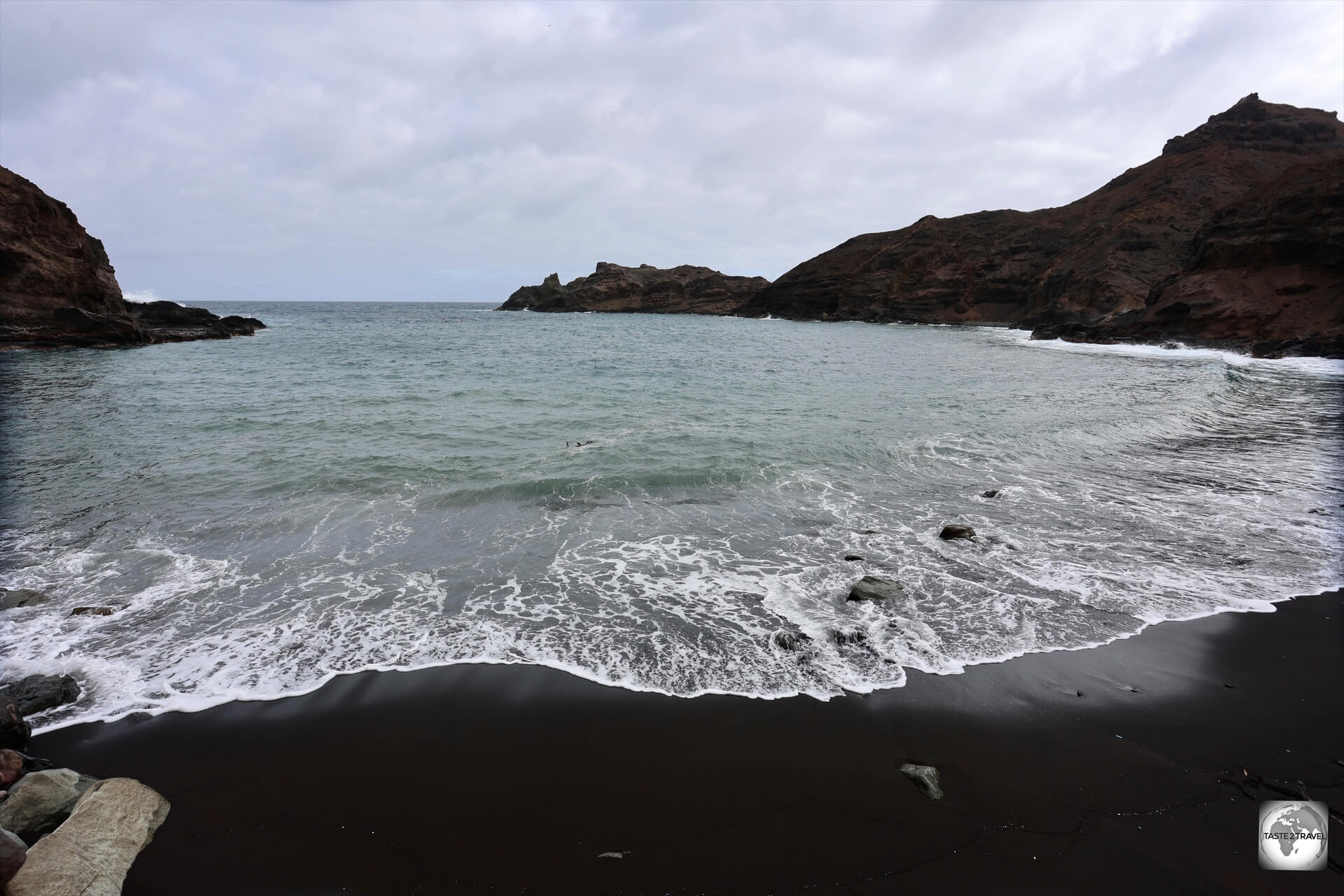
The jet-black volcanic sand beach at Sandy Bay.
Since it is the only real stretch of sand on the island, Sandy Bay is a popular recreation spot, although it’s inadvisable to swim in the beach due to strong under-currents.

A view of the arid coastal landscape at Sandy Bay.
Fortifications at Sandy Bay
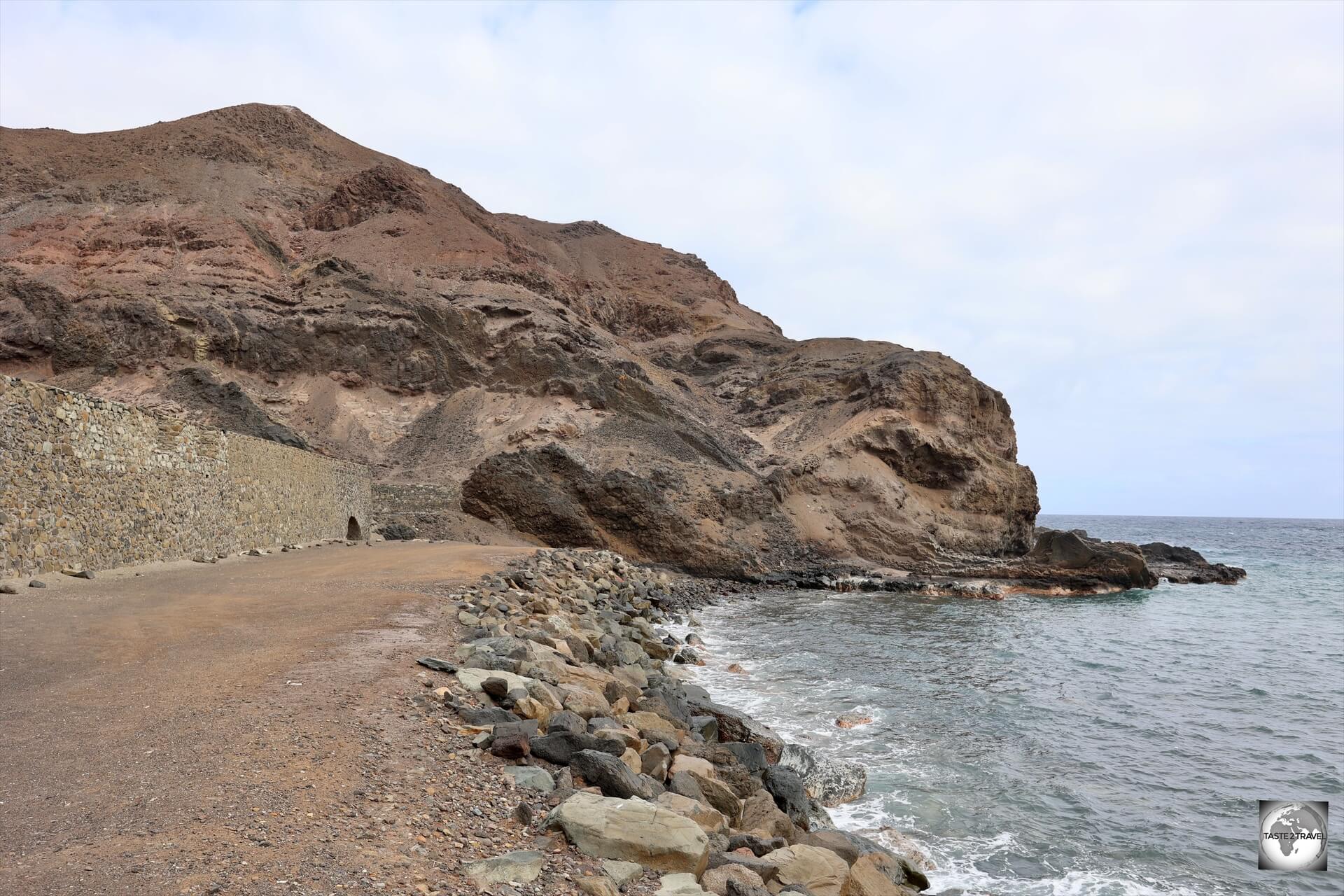
The Sandy Bay Line was a fortification wall which once spanned the full width of the beach.
Since Sandy Bay was one point of vulnerability, on an island whose cliffs made it an otherwise impenetrable fortress, a wall, called the Sandy Bay Line, was built to defend the beach against attack.
The first fortifications at Sandy Bay were built after 1708, when limestone deposits were discovered nearby and used to make mortar.
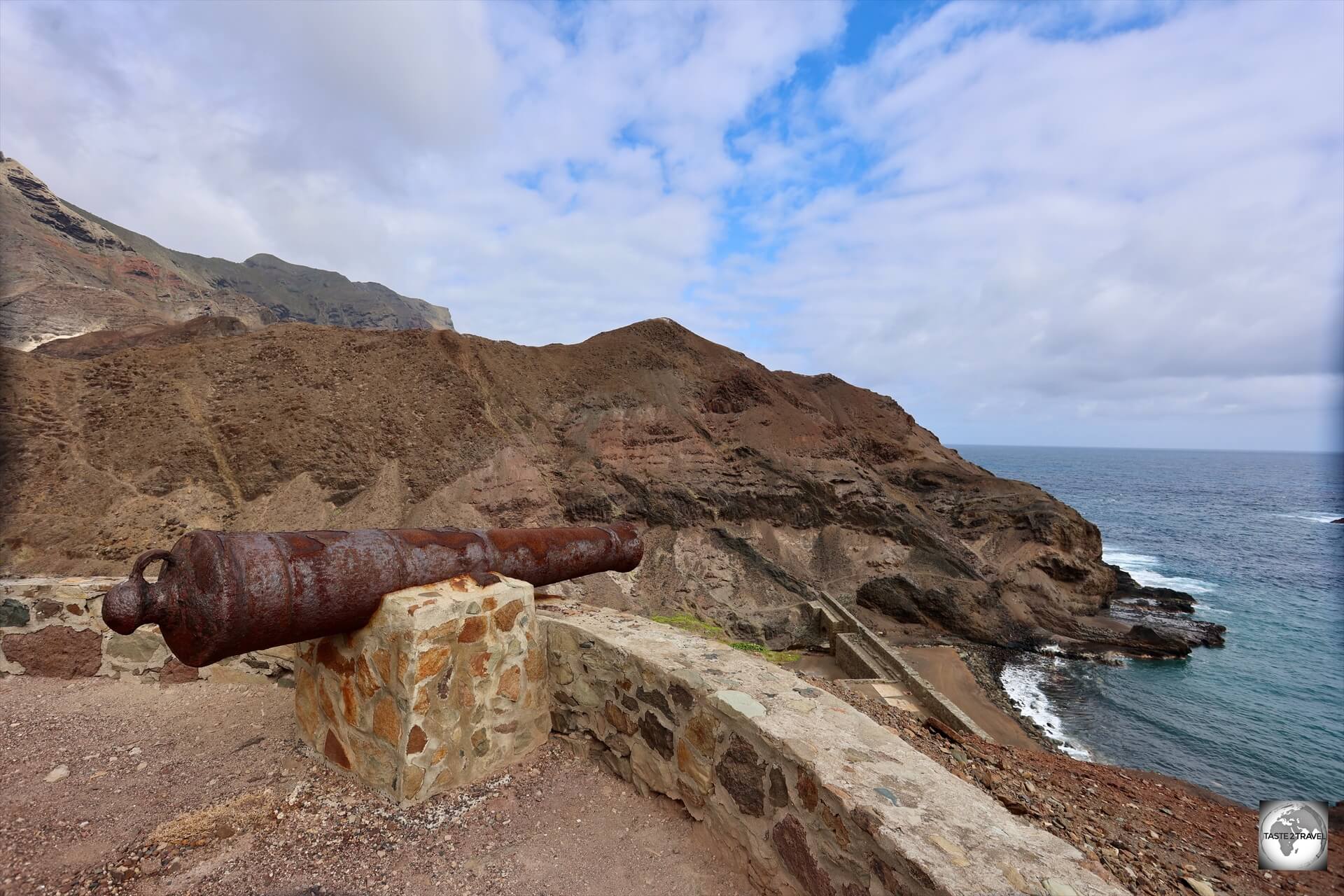
Beach Hill Battery was built in the late 1700s atop the promontory that divides the beaches at Sandy Bay.
The single-gun Beach Hill Battery was built in the late 1700s atop the promontory that divides the beaches.
Blue Point
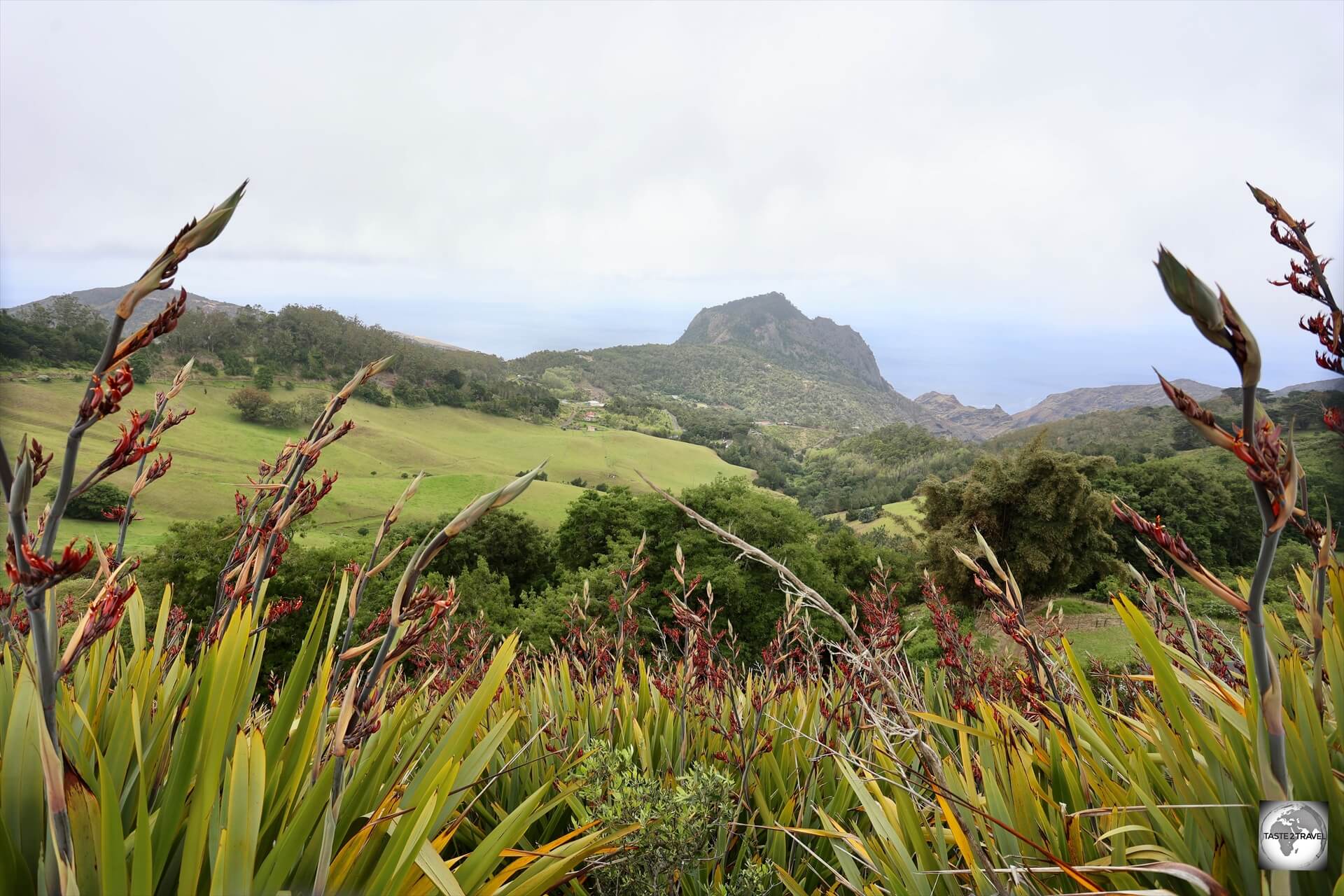
Views of the Saint Helena countryside from the road to Blue Point.
Blue Point has the distinction of being the least populated district on Saint Helena.
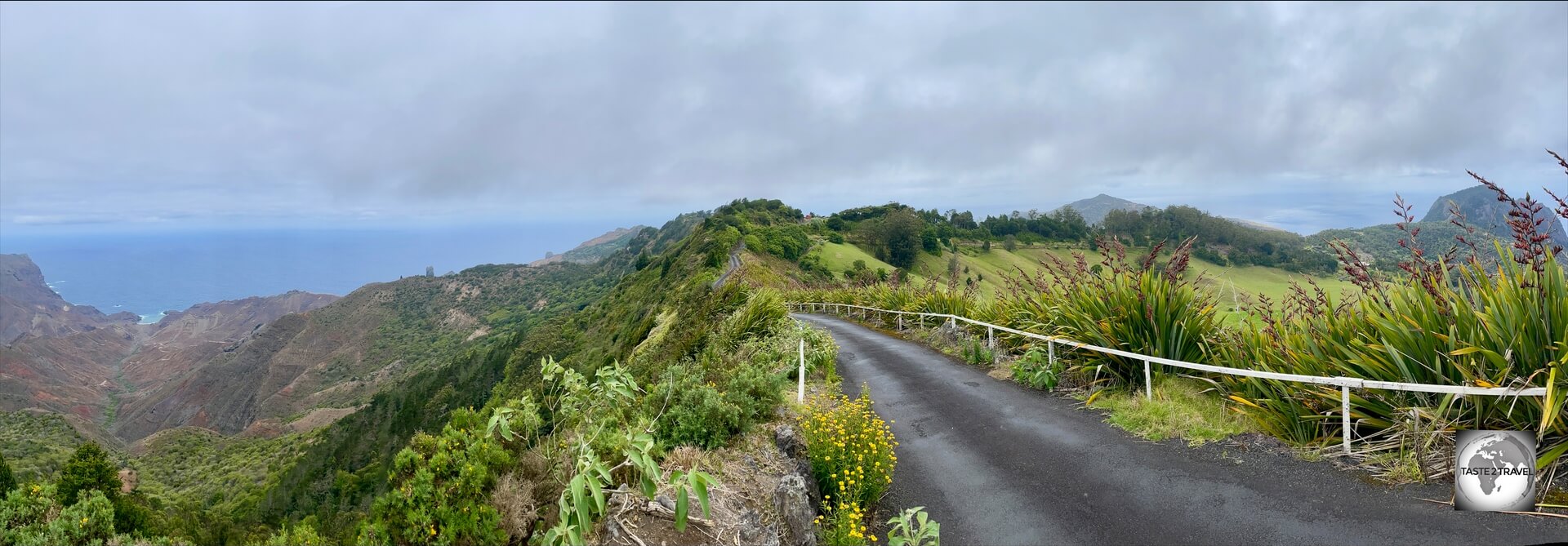
Views of the Saint Helena countryside from the road to Blue Point.
Home to just 174 souls, while it is the smallest district in terms of population, it is the biggest district in terms of area, covering the western third of the island.
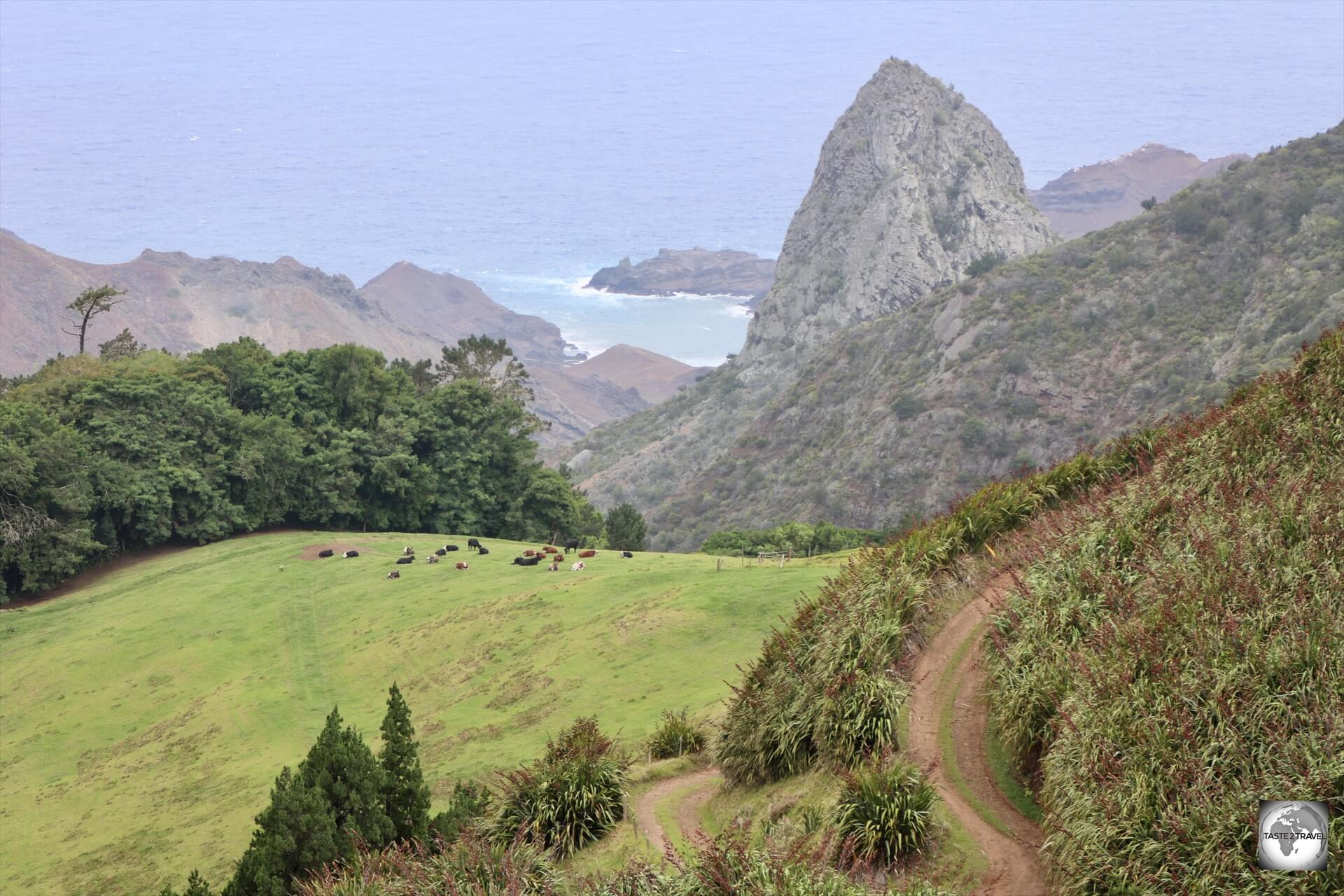
A view of ‘Lot’, a large volcanic plug, and Sandy Bay in the background, from the road to Blue Point.
The main access road, which traverses along a high mountain ridge, offers stunning panoramic views in all directions, while numerous walking trails lead to coastal viewpoints.
Video: Driving on the road to Blue Point.
Accommodation
A complete listing of all accommodation options is available on the accommodation page of the Saint Helena Tourism Website.
There is a limited range of accommodation on Saint Helena with options to suit mid-range or deluxe budgets.
Somerville Flats
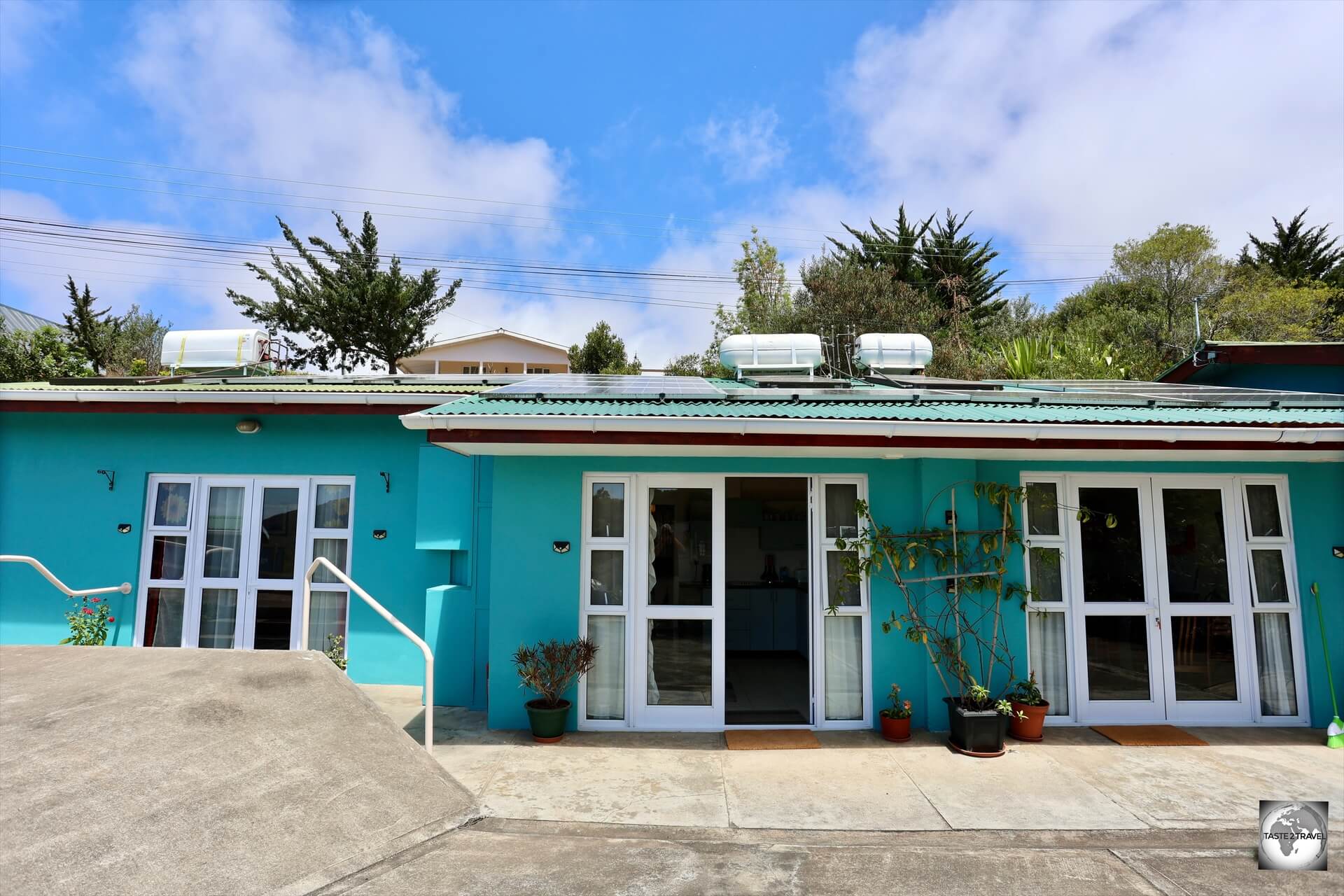
The property, where I stayed on Saint Helena, Somerville Flats.
While hotel prices on Saint Helena can be high, some good mid-range options can be found on Airbnb.
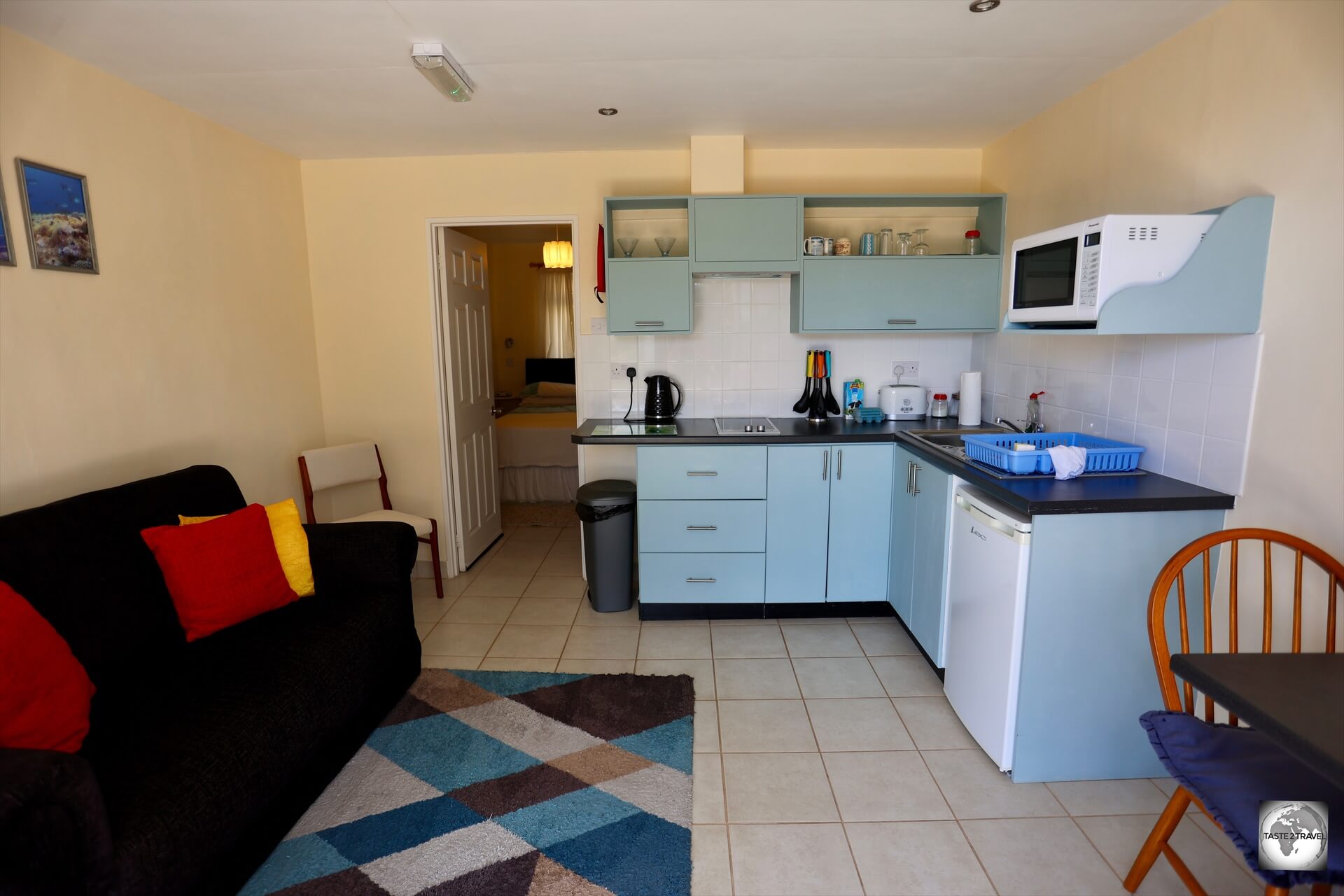
The view of my living room and kitchen at Somerville Flats.
I stayed at a very good, self-catering apartment called Somerville Flats which is perched on the top of a mountain, overlooking the sea, about a 15-minute drive uphill from Jamestown.
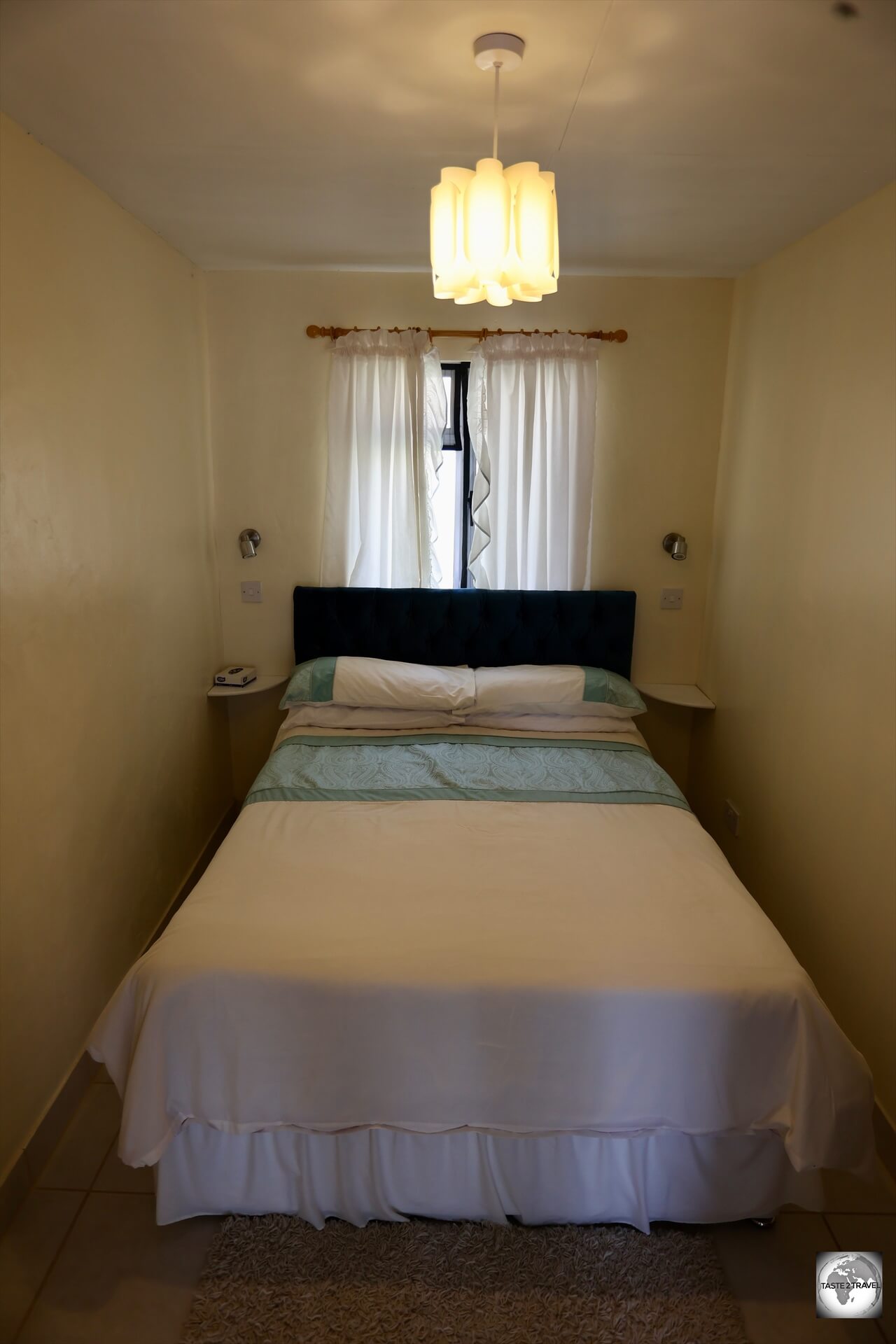
The less-than-spacious bedroom at Somerville Flats.
This family run option consists of 3 small flats which cost £35 per night and include a kitchen, WiFi and cable TV.
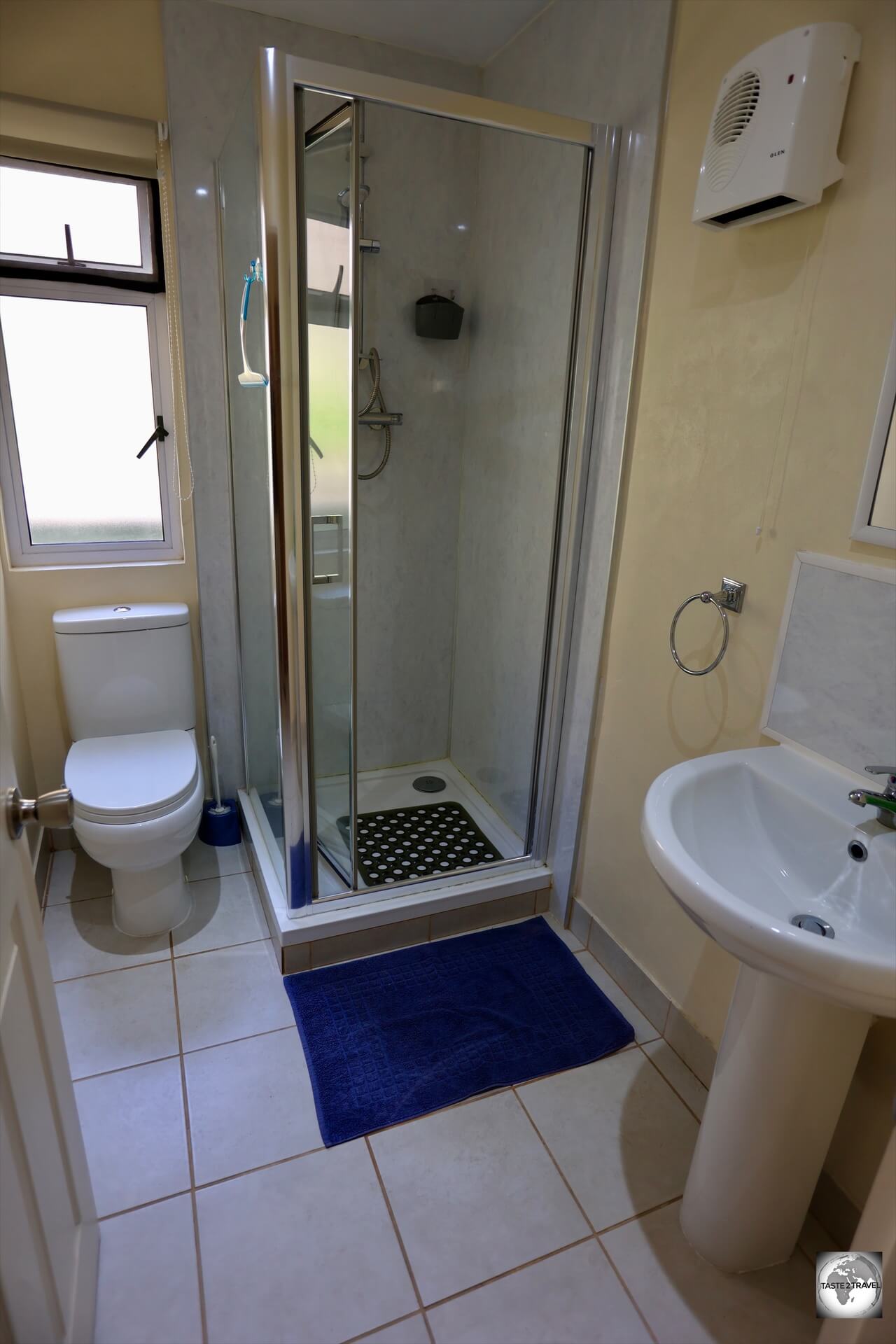
My bathroom at Somerville Flats on Saint Helena.
Contact details for Somerville Flats:
Mantis St Helena
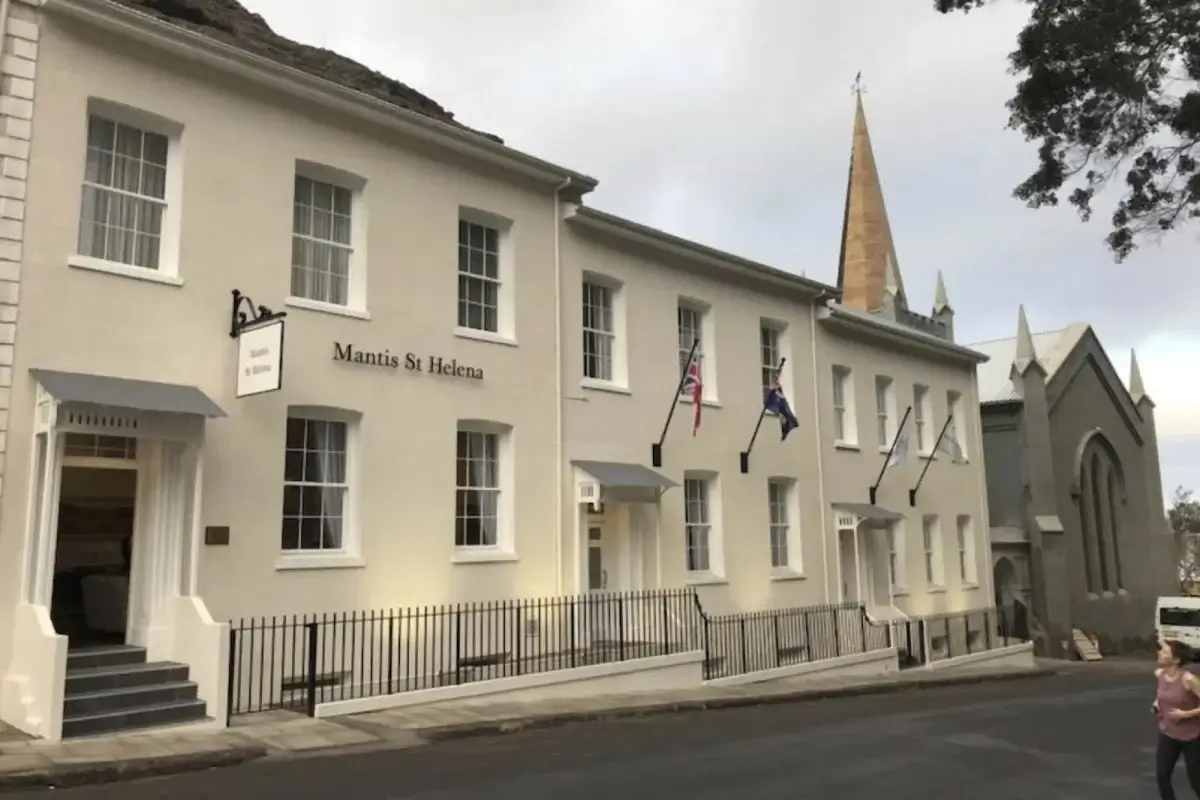
Mantis St Helena is the most deluxe hotel on Saint Helena Island.
Part of the Accor Hotel group, Mantis St Helena is the most deluxe hotel on the island and is the one place where you can pay using a credit card.
Located in the heart of Jamestown, this 30-bedroom boutique hotel is set in the original East India Company’s officers’ barracks built in 1774.
A popular accommodation option, the hotel boasts a large restaurant, cocktail bar, guest lounge and two spacious outdoor terraces.
Contact Details for Mantis St Helena:
- Email: reservations@mantiscollection.com
- Web: https://mantissthelena.com/
- Office Tel: +290 25505
Consulate Hotel
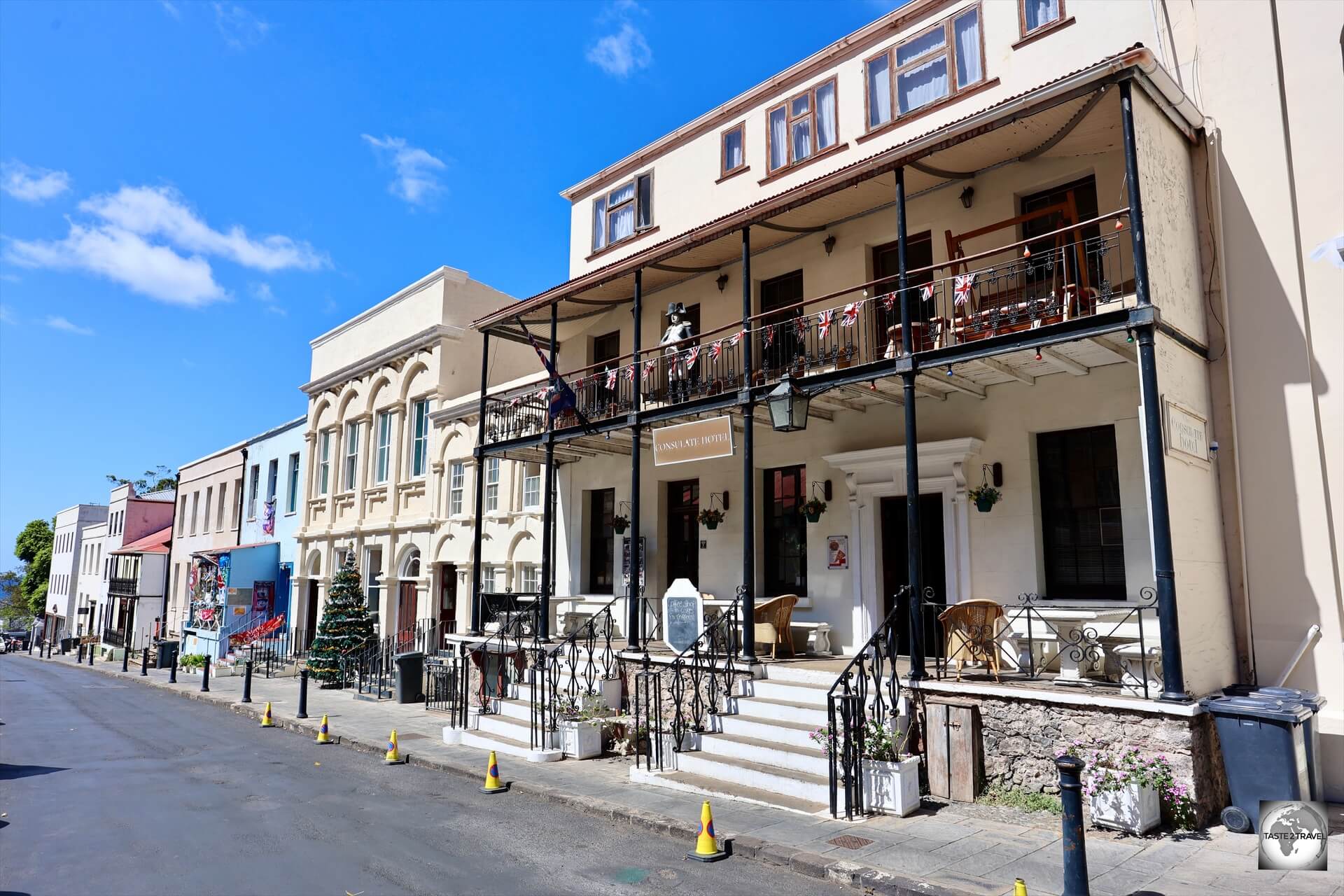
Located on the main street of Jamestown, the Consulate Hotel offers rooms and a cosy tea room.
Located in the heart of Jamestown, the historic Consulate Hotel offers comfortable accommodation, a popular coffee shop and an art gallery.
Rooms cost £150 for single occupancy or £200 for double occupancy.
Contact Details for Consulate Hotel:
- Email: consulatesthelena@gmail.com
- Office Tel: +290 22962
Eating Out
The cuisine of Saint Helena Island is a reflection of its diverse cultural influences, shaped by its isolation in the South Atlantic Ocean, as well as its history of British colonialism, African heritage, and connections to nearby islands and trade routes.
Being an island, Saint Helena has access to a wide variety of fresh seafood with fresh fish, especially tuna, featuring on most restaurant menus.
Oddly, there is no brewery on Saint Helena! This would be the ideal place for a craft brewery, such as they have in the Falkland Islands.
Instead, all beer is sold in cans or bottles, imported from Namibia or South Africa.
Saint Helena Coffee
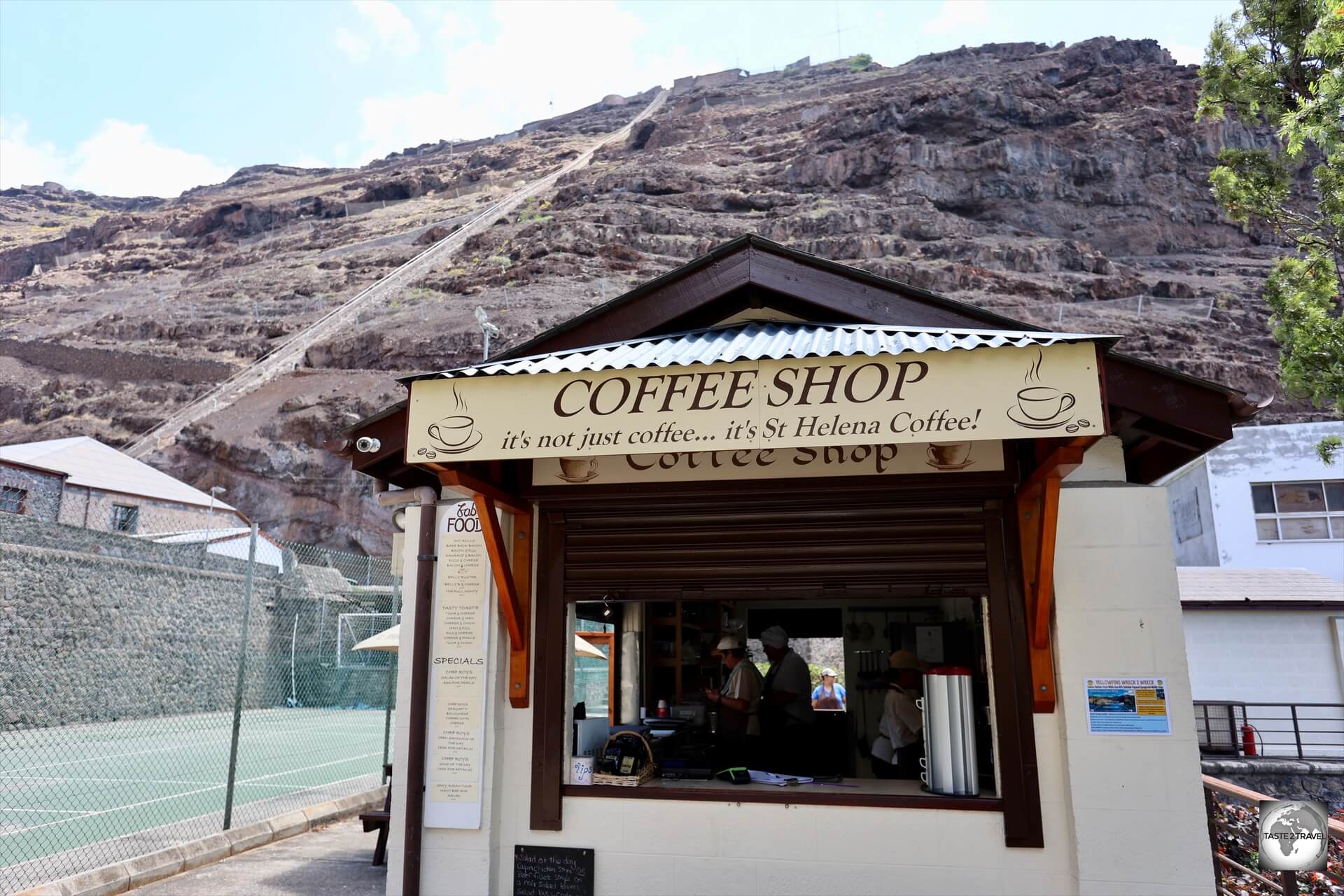
Located on the waterfront in Jamestown, the St Helena Coffee Shop offers the best coffee in town.
“The only good thing about St Helena is the coffee.”
Quote from Napoleon Bonaparte.
Top billing for the ‘Eating Out’ section of this guide must be given to the amazing St Helena Coffee Shop and the divine St Helena Coffee.
Coffee beans were first introduced to Saint Helena on February 10, 1733 by the East India Company who imported coffee plants from Yemen.
Saint Helena coffee became popular after Napoleon praised it during his exile on the island.
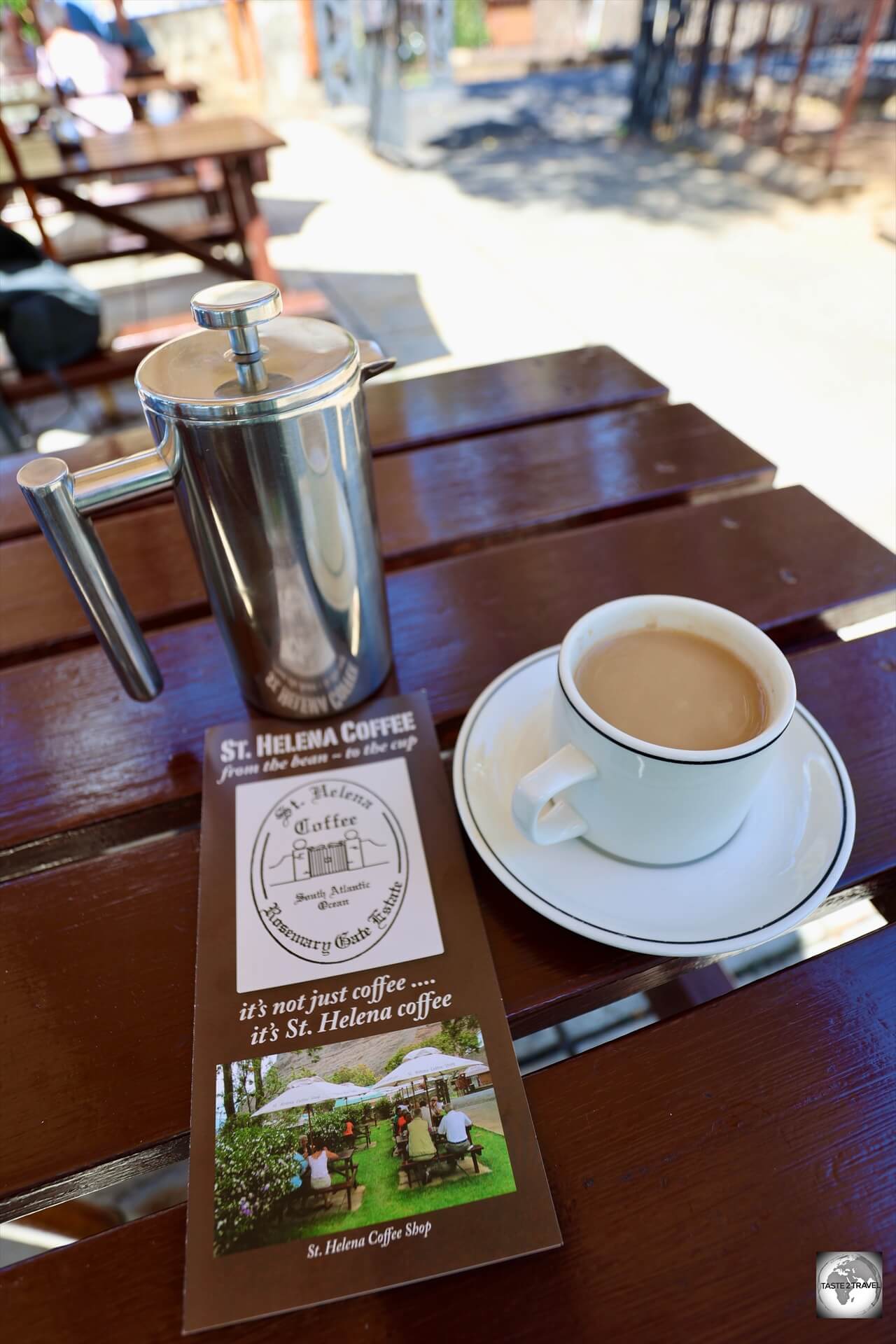
Enjoying a cup of the truly divine-tasting Saint Helena coffee at the St Helena Coffee Shop in Jamestown.
Coffee from the island was sold in London in 1845 at one penny per pound, making it the most expensive and exclusive coffee in the world at the time.
Sourced from Rosemary Gate Coffee Plantation, this is a supreme caffeine experience which is not to be missed.
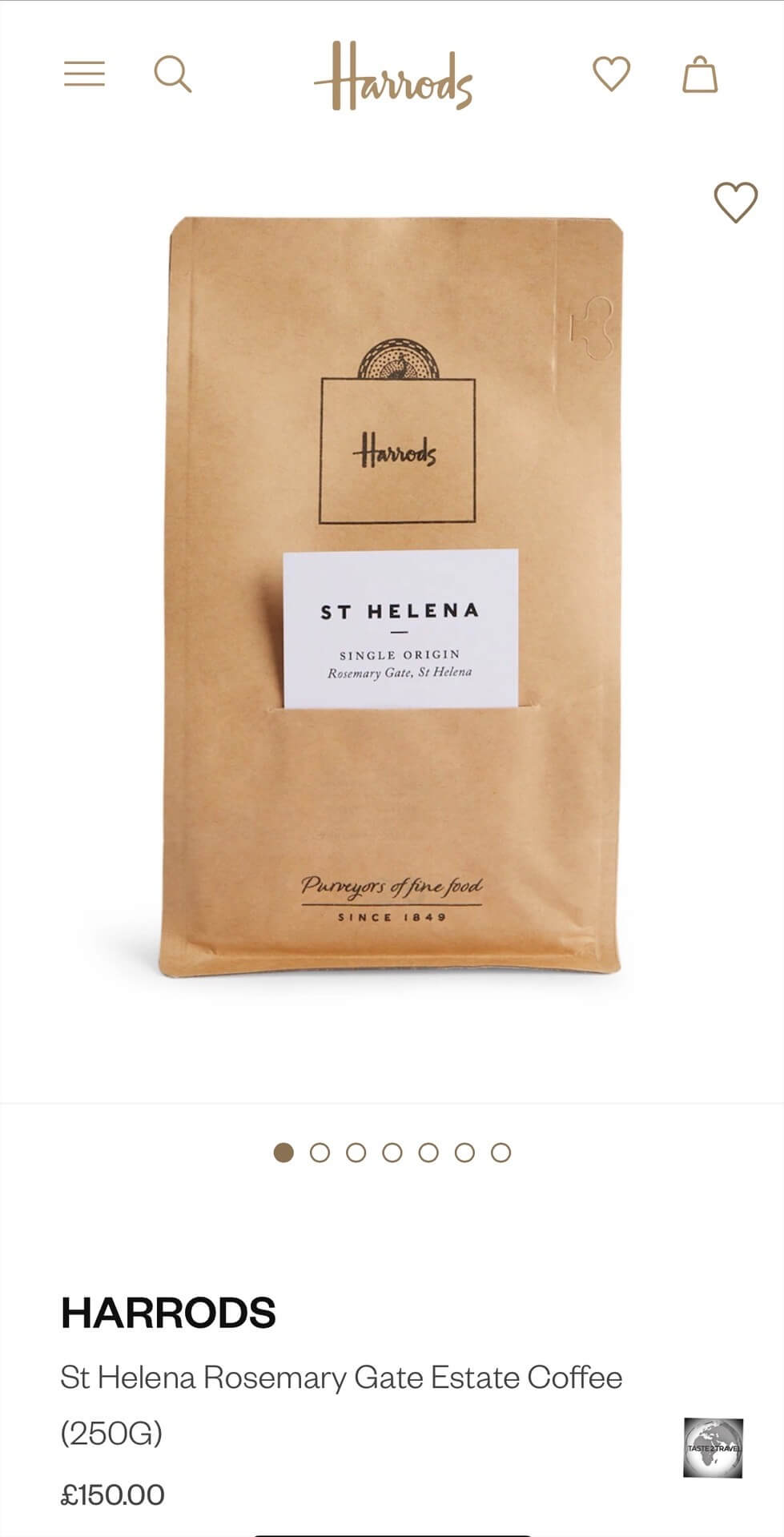
This 250-gram bag of St Helena coffee sells at Harrod’s in London for £150!!
Today, a 250-gram bag of Rosemary Gate Coffee sells for £150 at Harrods.
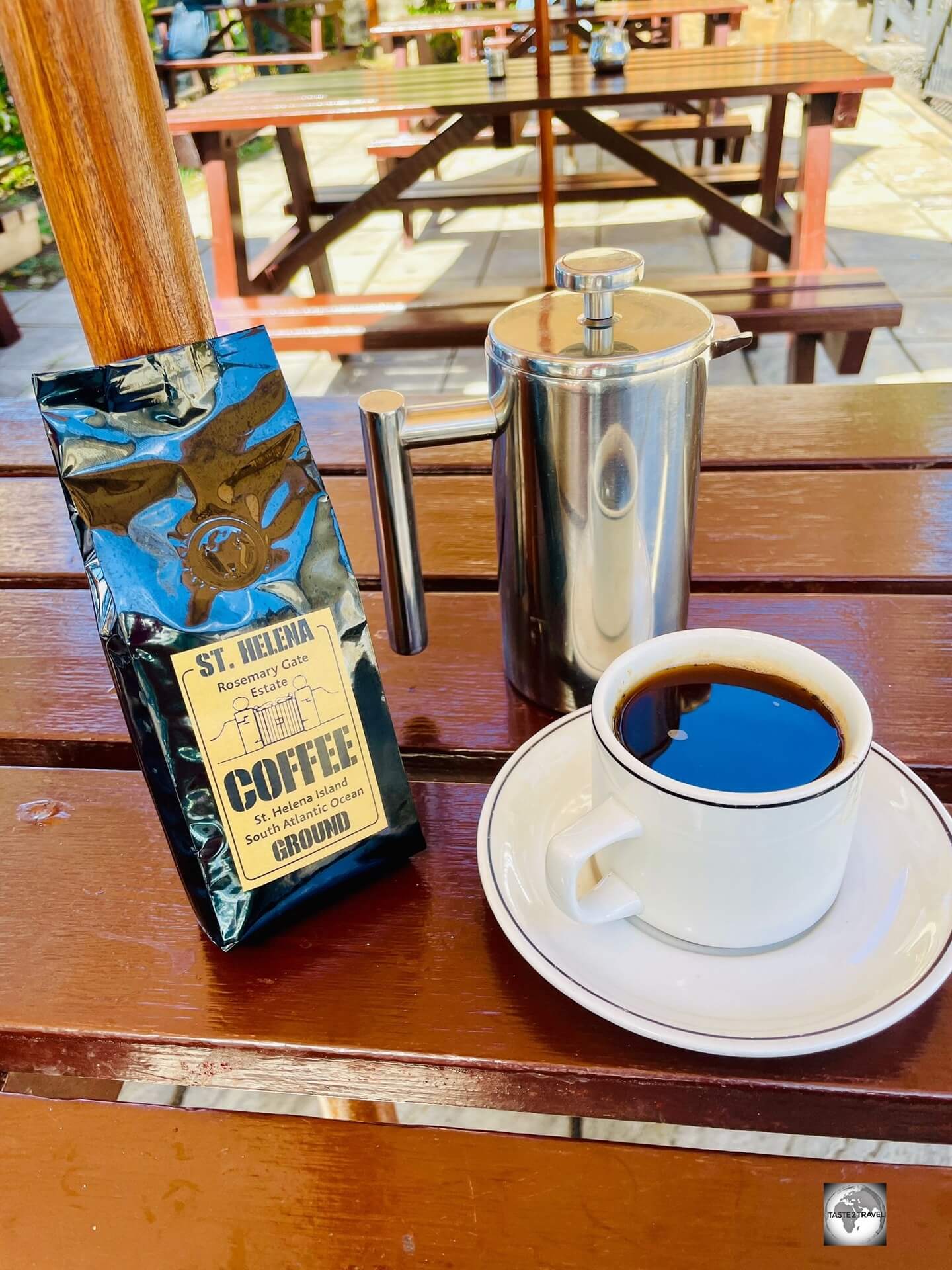
My 125-gram bag of St Helena Coffee, which cost me £12 from the St Helena Coffee Shop.
Buying the coffee on Saint Helena is much cheaper, with a 125-gram bag costing £12 from the St Helena Coffee Shop.
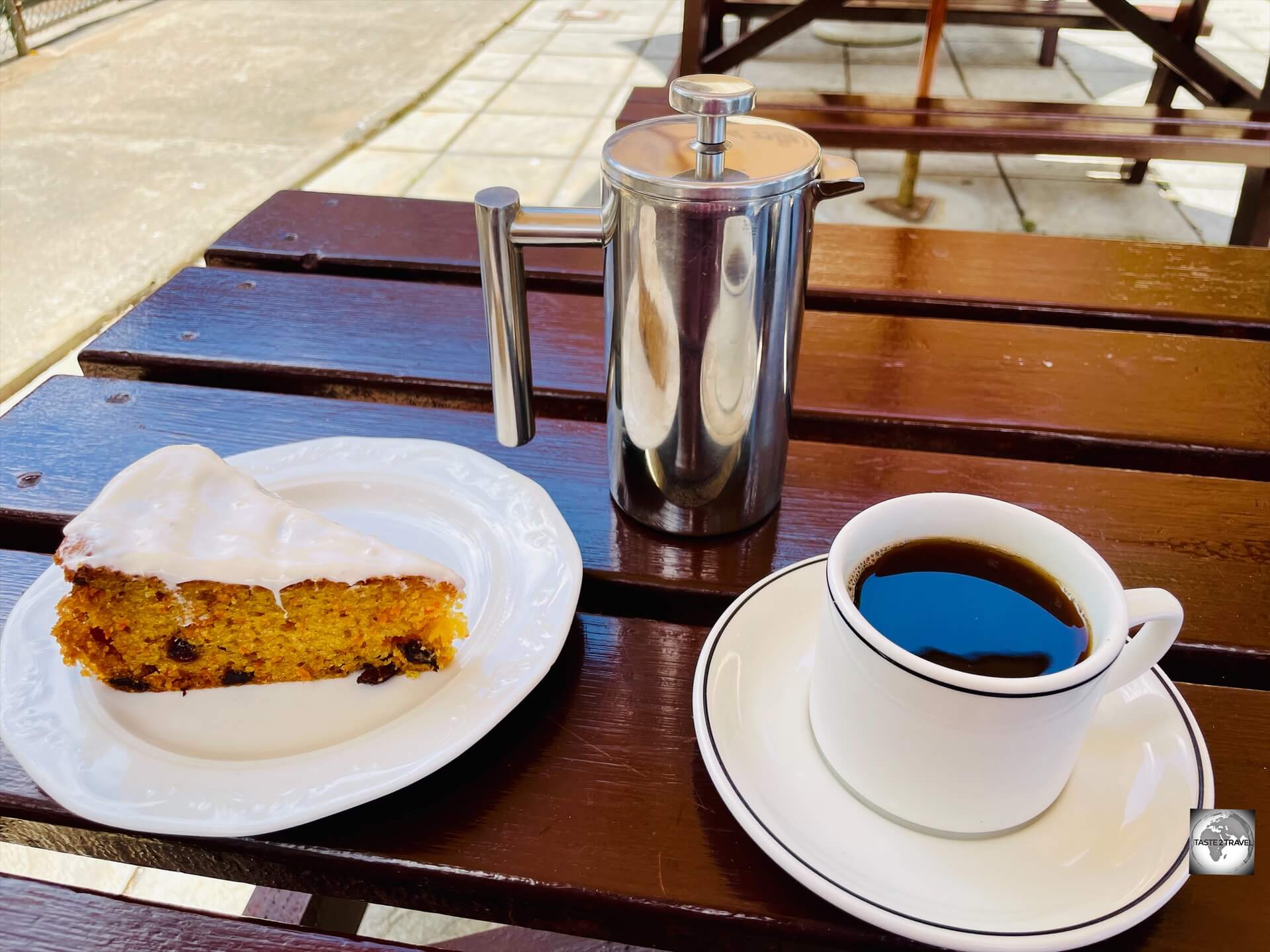
Enjoying a pot of St Helena coffee, with a slice of homemade carrot cake, at the St Helena Coffee Shop in Jamestown.
Located on the waterfront, next to the historic moat in Jamestown, the small kiosk-size cafe that is the St Helena Coffee Shop serves the very rare and extremely valuable St Helena Coffee.
While the coffee is the highlight, the food offerings, with are prepared by the famous Chef Roy are equally as good.

A delicious Thai beef salad, served with homemade bread, at the St Helena Coffee Shop.
Prior to his gig at the St Helena Coffee Shop, Chef Roy worked for many years as the chef on the RMS Saint Helena, then worked as the head chef at Mantis Saint Helena Hotel.
Highly recommended!
The coffee shop is open from Wednesday through to Sunday for breakfast and lunch, closing mid-afternoon.
St Helena Coffee Shop Contact
- Email: Jillandbill.bolton@gmail.com
- Facebook: https://www.facebook.com/Jillandbillbolton/
Coconut Fingers
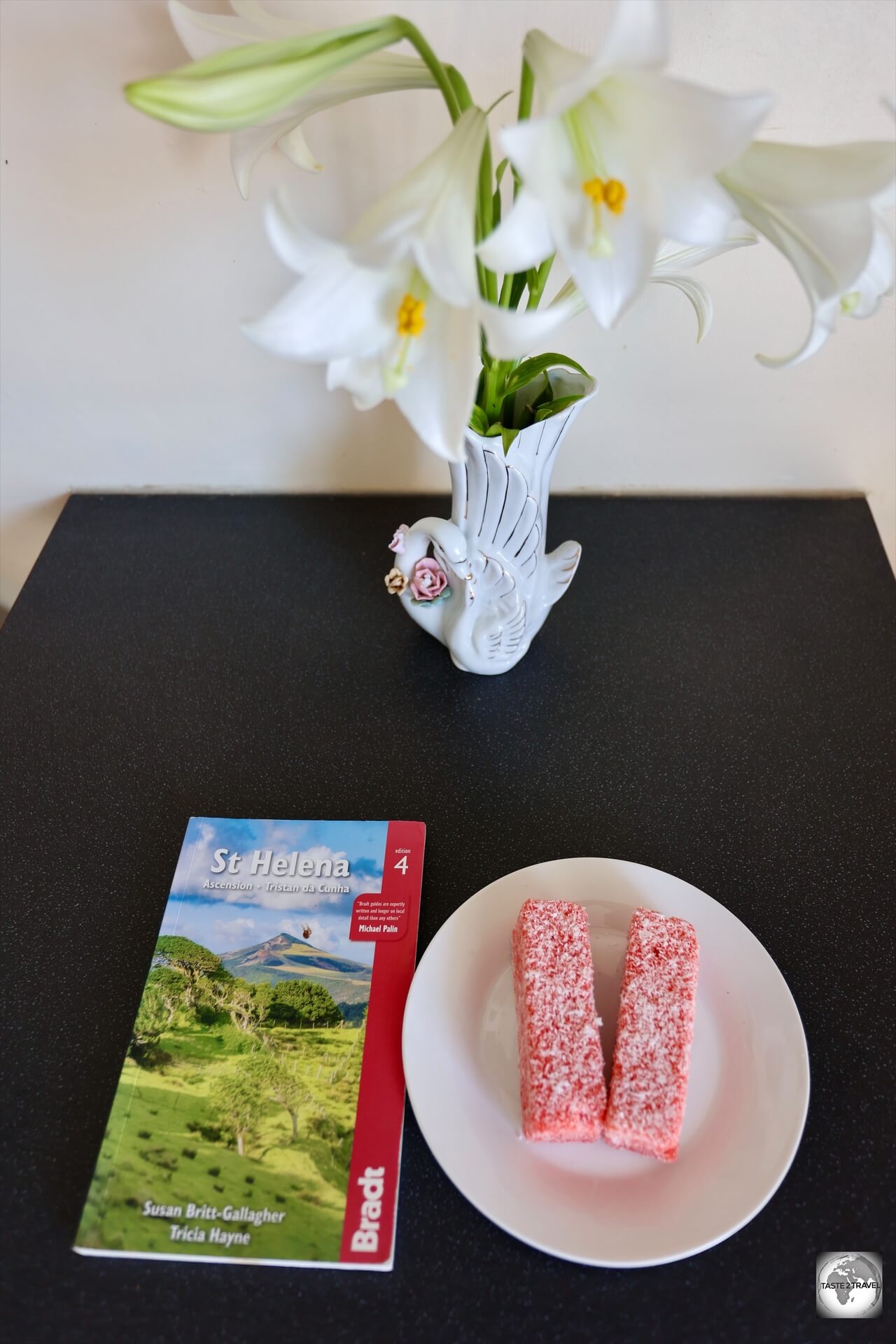
A local treat, Coconut Fingers are said to have been inspired by the Australian Lamington.
Always covered with an iridescent pink icing, Coconut Fingers are a local Saint Helena sweat treat which reminded this Australian traveller very much of Lamingtons.
They are apparently inspired by the Australian Lamington and while the, always pink, icing is much thicker and much sweeter than the icing found on their Australian counter-parts, Coconut Fingers are very popular and best enjoyed with a cup of tea or Saint Helena coffee.
Coconut Fingers recipe:
Mantis St Helena Restaurant
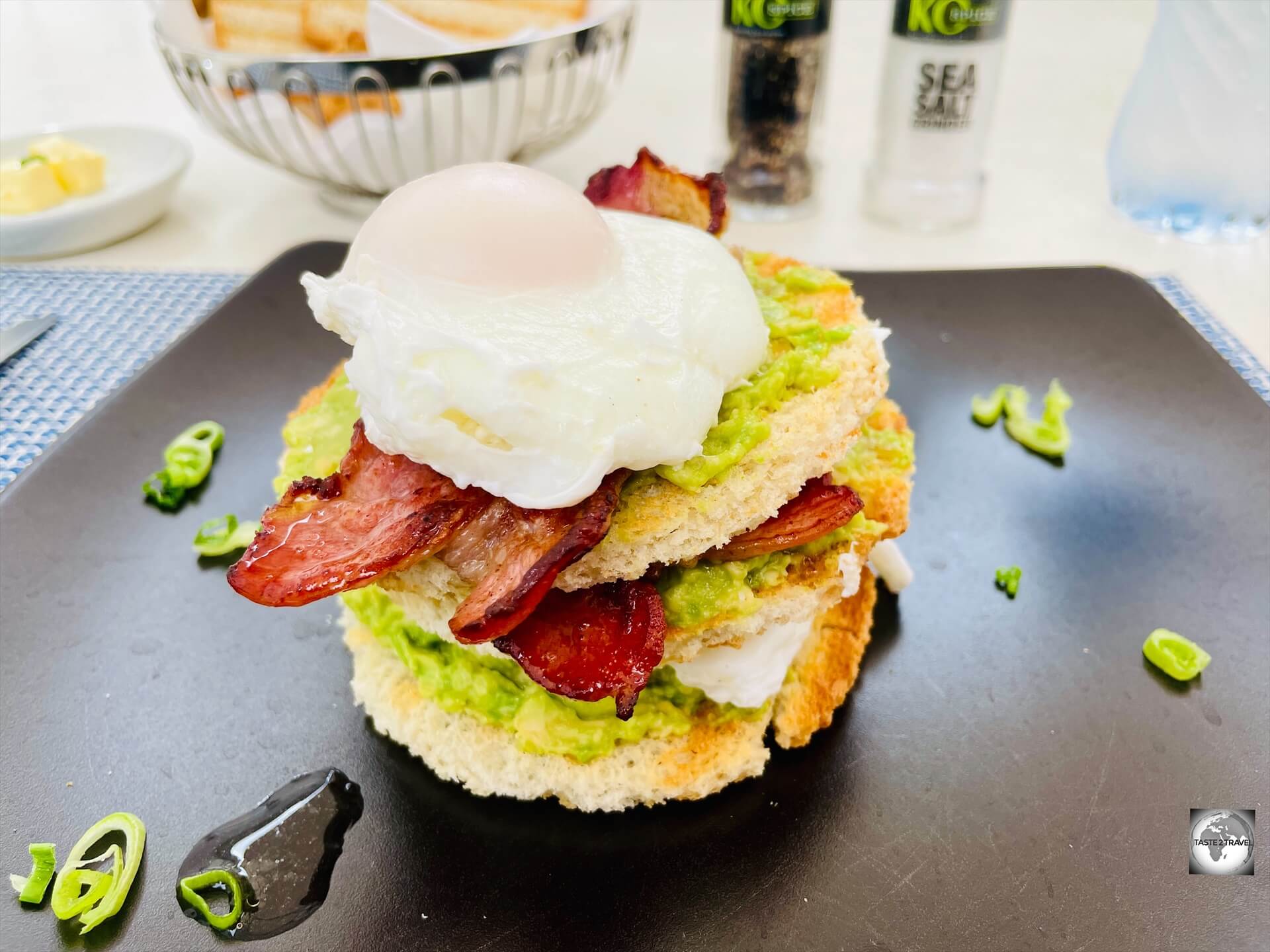
Enjoying a delicious breakfast at the Mantis hotel in Jamestown.
If you wish to indulge in fining dining, and then pay your bill with a credit card, the restaurant at the Mantis St Helena Hotel is the only option on the island.
The regular menu is supplemented by daily specials, which always showcase the excellent local fish, especially as tuna.
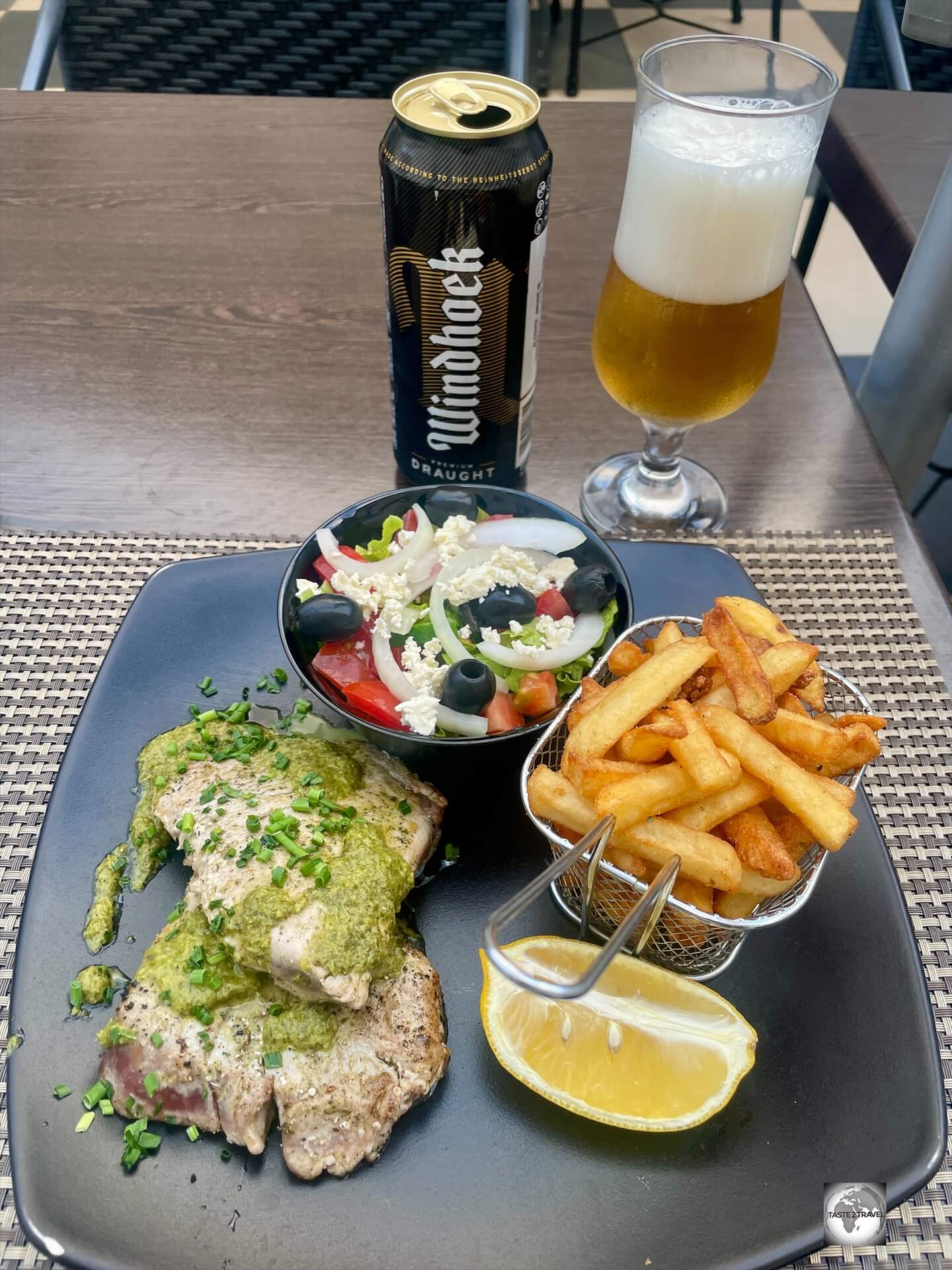
An amazing seared tuna steak dinner at Mantis St Helena Hotel.
Open for breakfast, lunch and dinner, I often ate here just so I could conserve my limited supply of cash.
The food is excellent with the menu offering a variety of cuisines from British to Indian, Thai and more.
Highly recommended!
Anne’s Place Restaurant
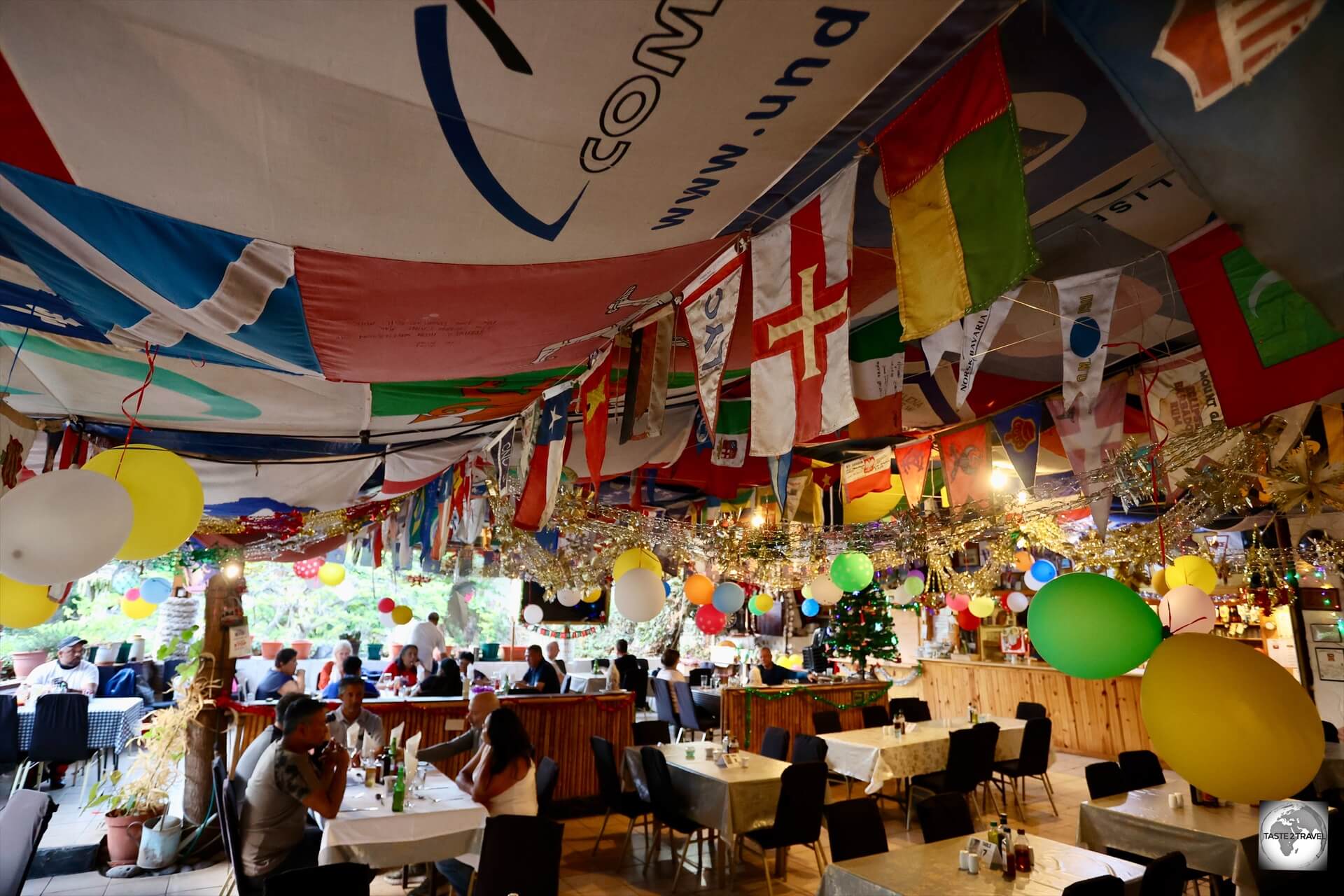
The ceiling at Anne’s Place is decorated with flags which have been donated by the many passing yachts.
Located in the heart of Jamestown, inside Castle Gardens, Anne’s Place is a relaxed, unpretentious eatery which specialises in local cuisine with an emphasis on fresh local fish.
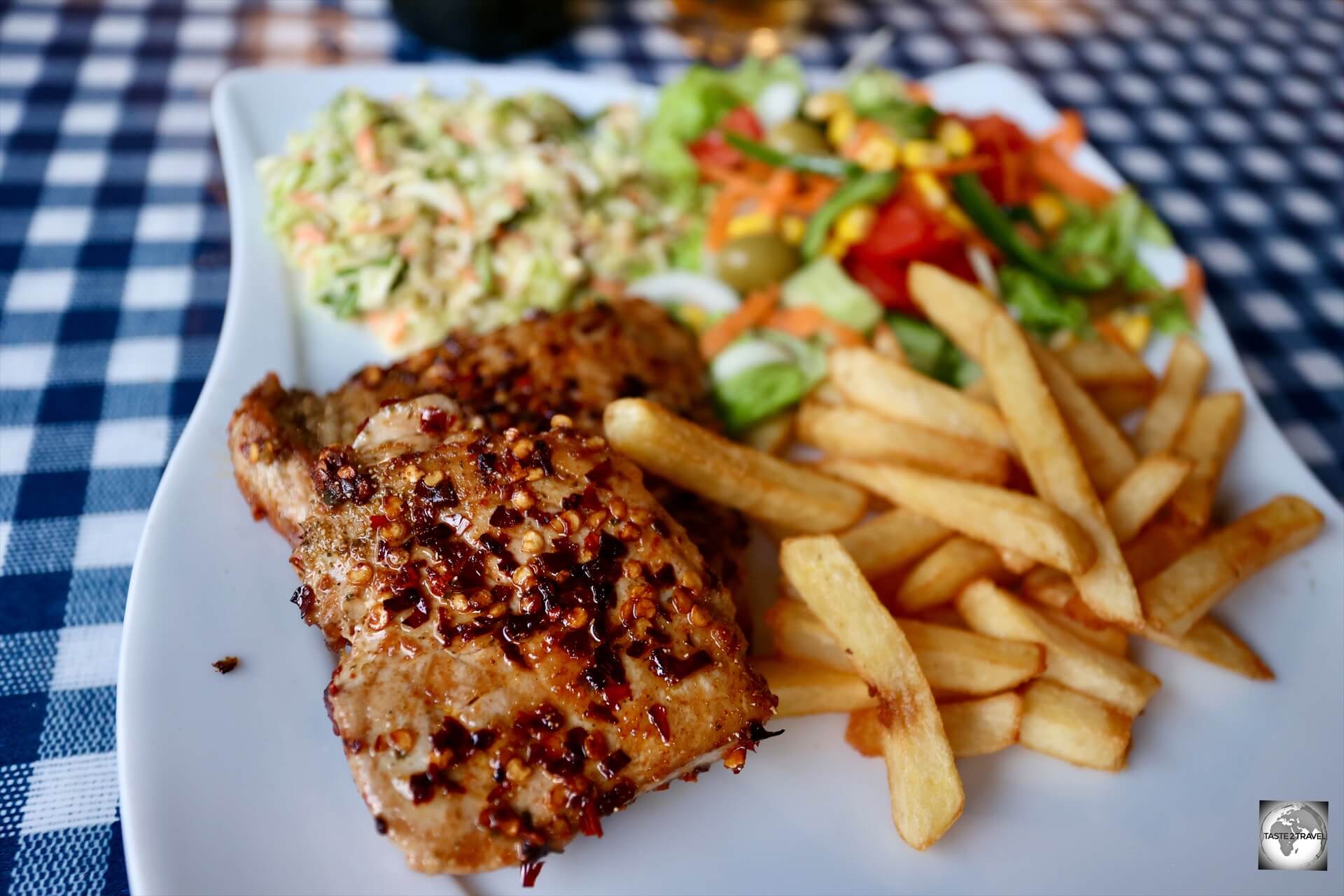
The spicy tuna steak meal which I enjoyed at Anne’s Place in Jamestown.
Tables are arranged under a ceiling which is covered with flags which have been donated by passing yachts.
This is a popular restaurant with locals, with large tables accommodating groups of diners.
Especially popular are the occasional fish buffets and pig roasts.
Consulate Hotel
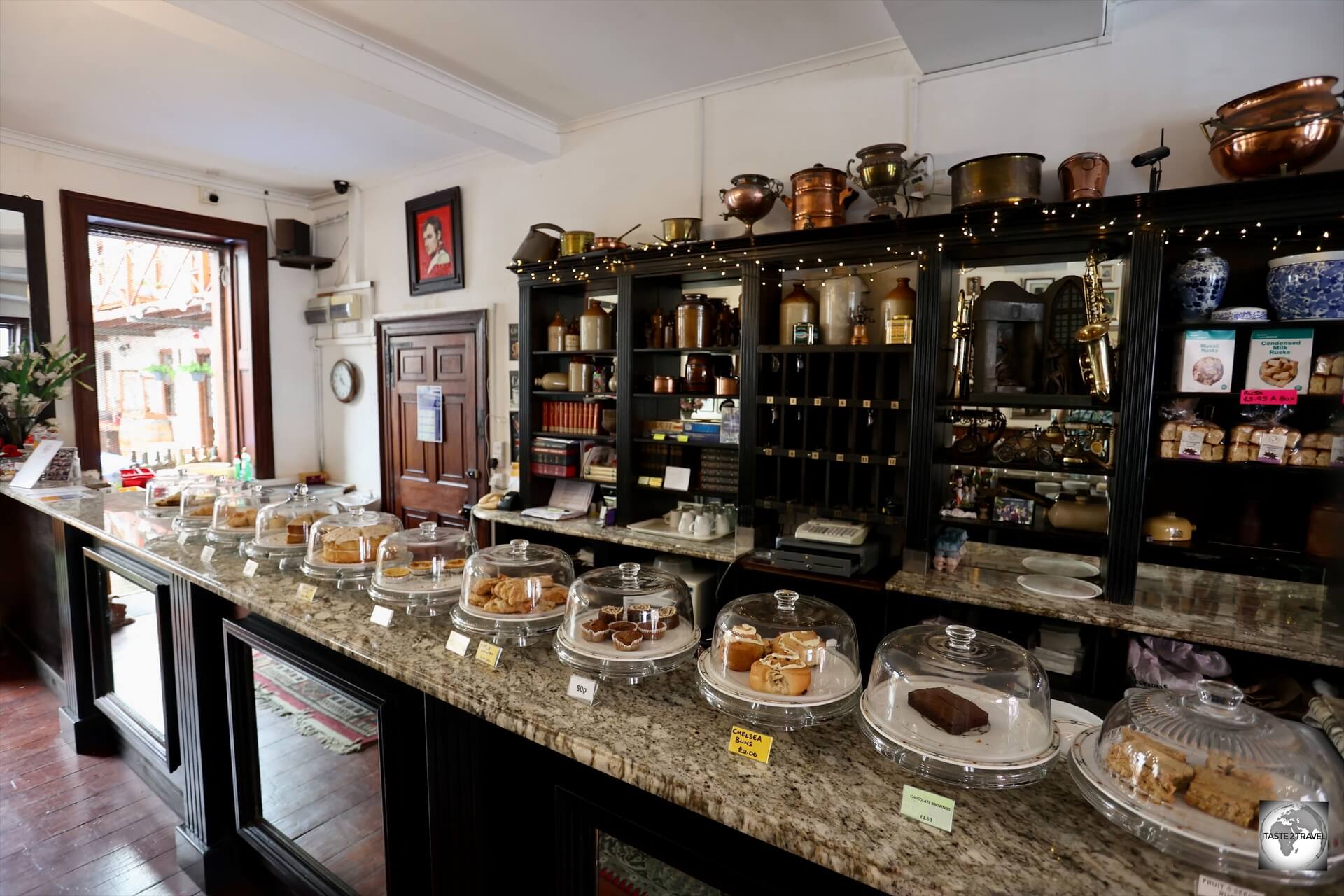
The tea room at the Consulate Hotel in Jamestown offers a good selection of freshly baked cakes.
Located on the main street of Jamestown, opposite the post office, the ground floor of the historic Consulate Hotel is home to a tea room/ coffee shop which always offers a selection of freshly baked cakes.
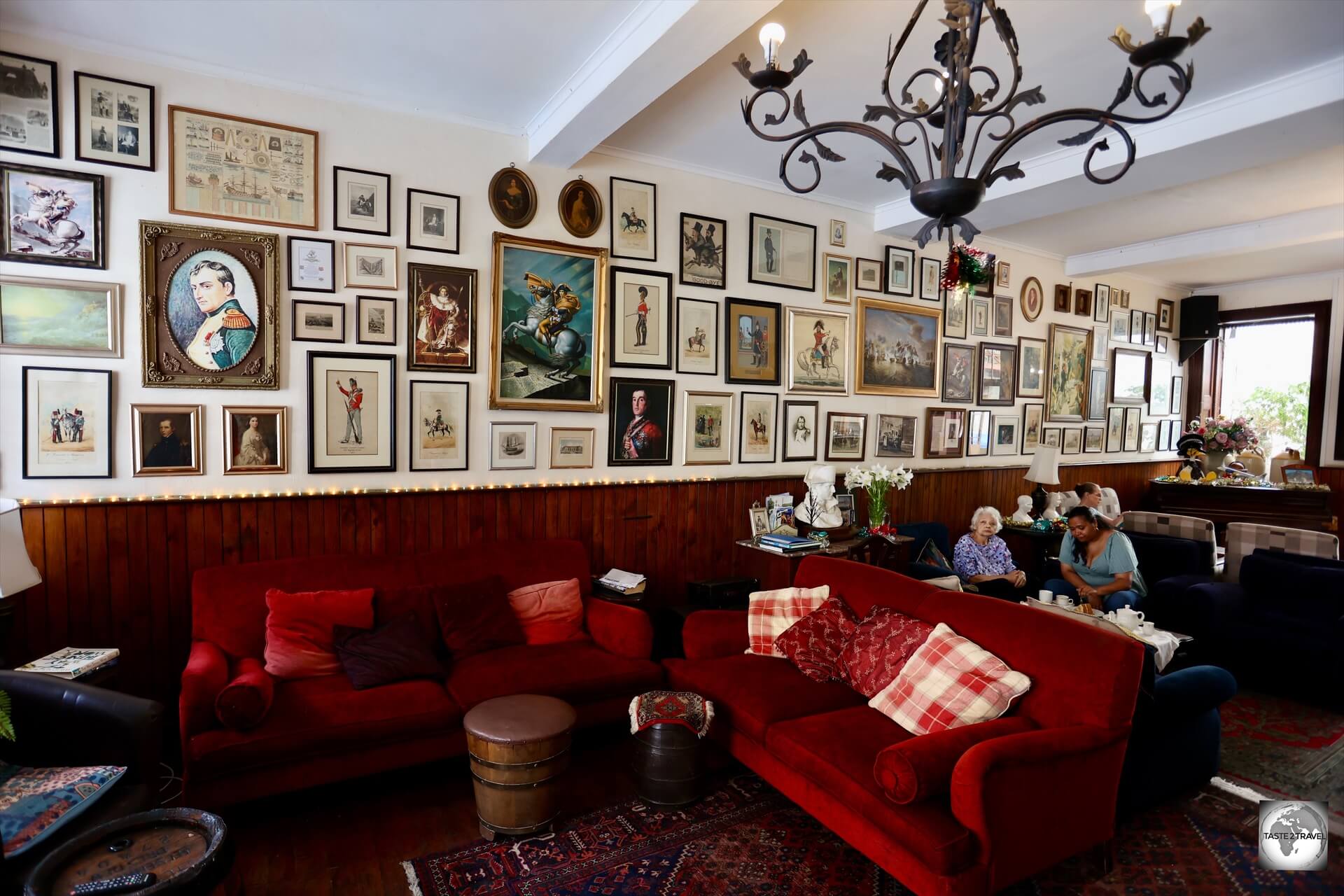
The walls of the tea room at the Consulate Hotel in Jamestown are decorated with Napoleon memorabilia.
Customers sip their coffee and tea in the retro lounge area, under the watchful gaze of Napoleon, who is ever-present here.
Saint Helena Yacht Club
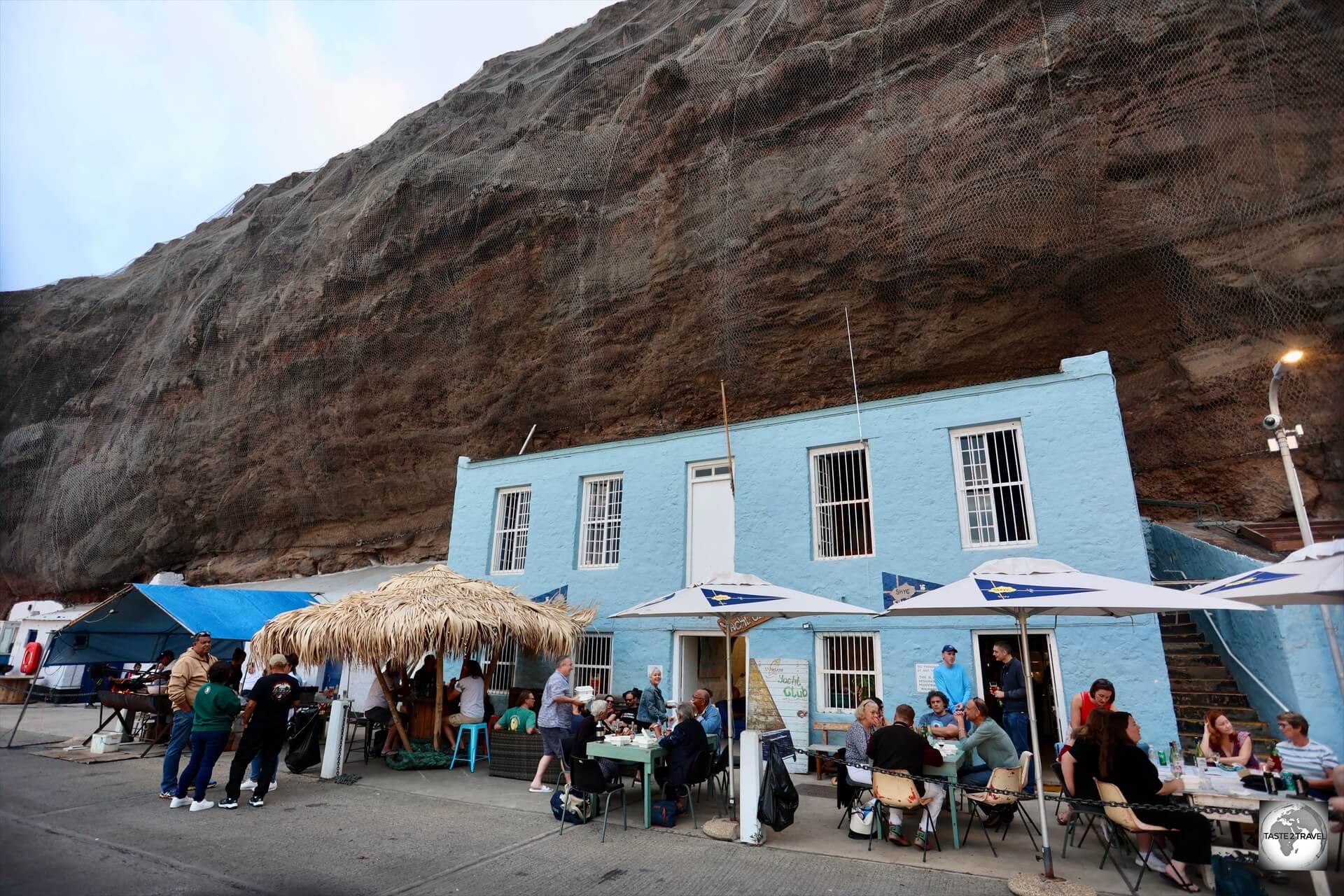
Locals gather outside the Saint Helena Yacht Club for the Wednesday evening ‘Fish fry’.
Every Wednesday evening, everyone comes together at the dockside Saint Helena Yacht Club for the weekly Fish Fry.
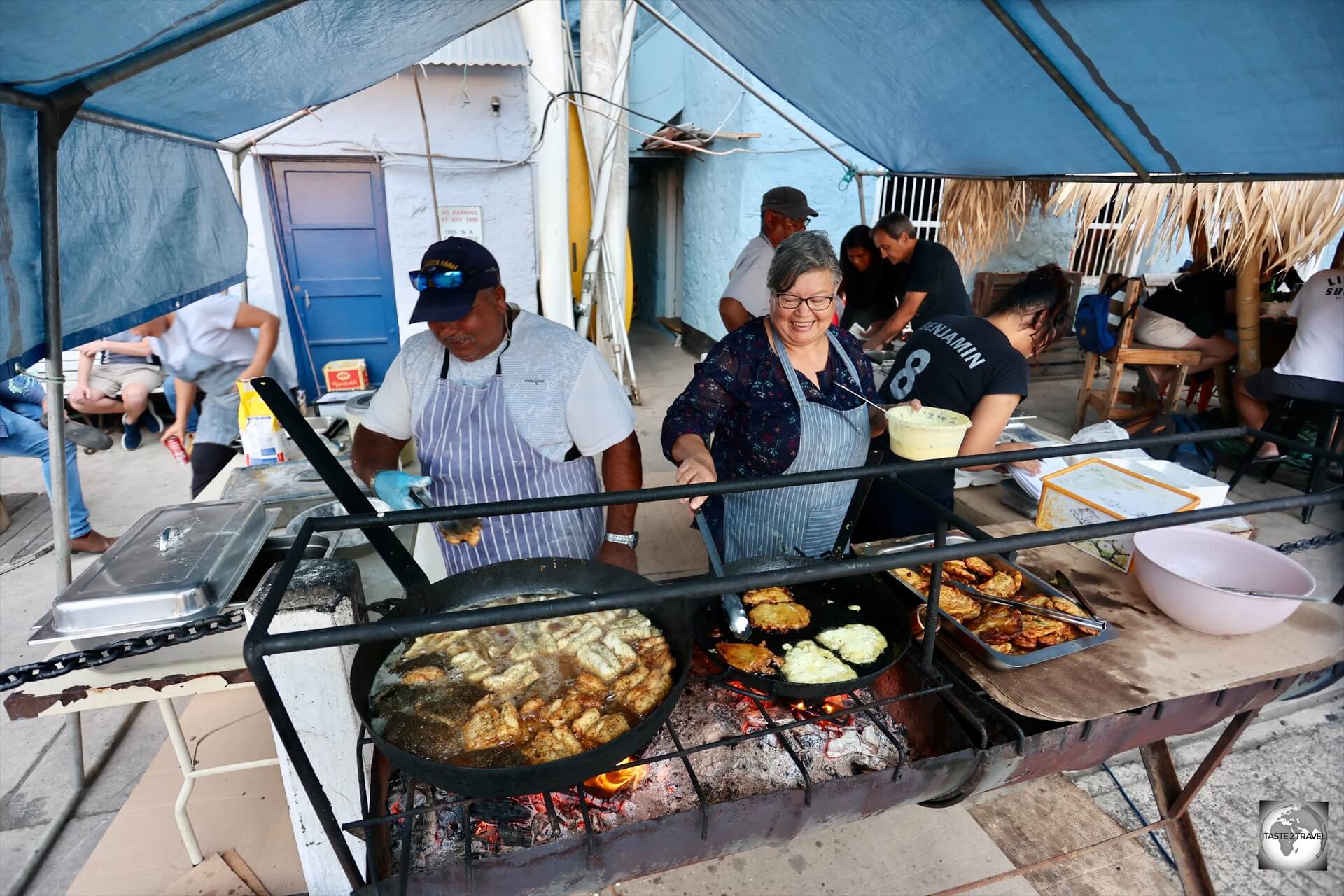
Every Wednesday evening, the Saint Helena Yacht Club hosts a very popular ‘Fish fry’.
This is a very popular event, not to be missed, which brings the locals, and the few tourists on the island, together for an informal social occasion.
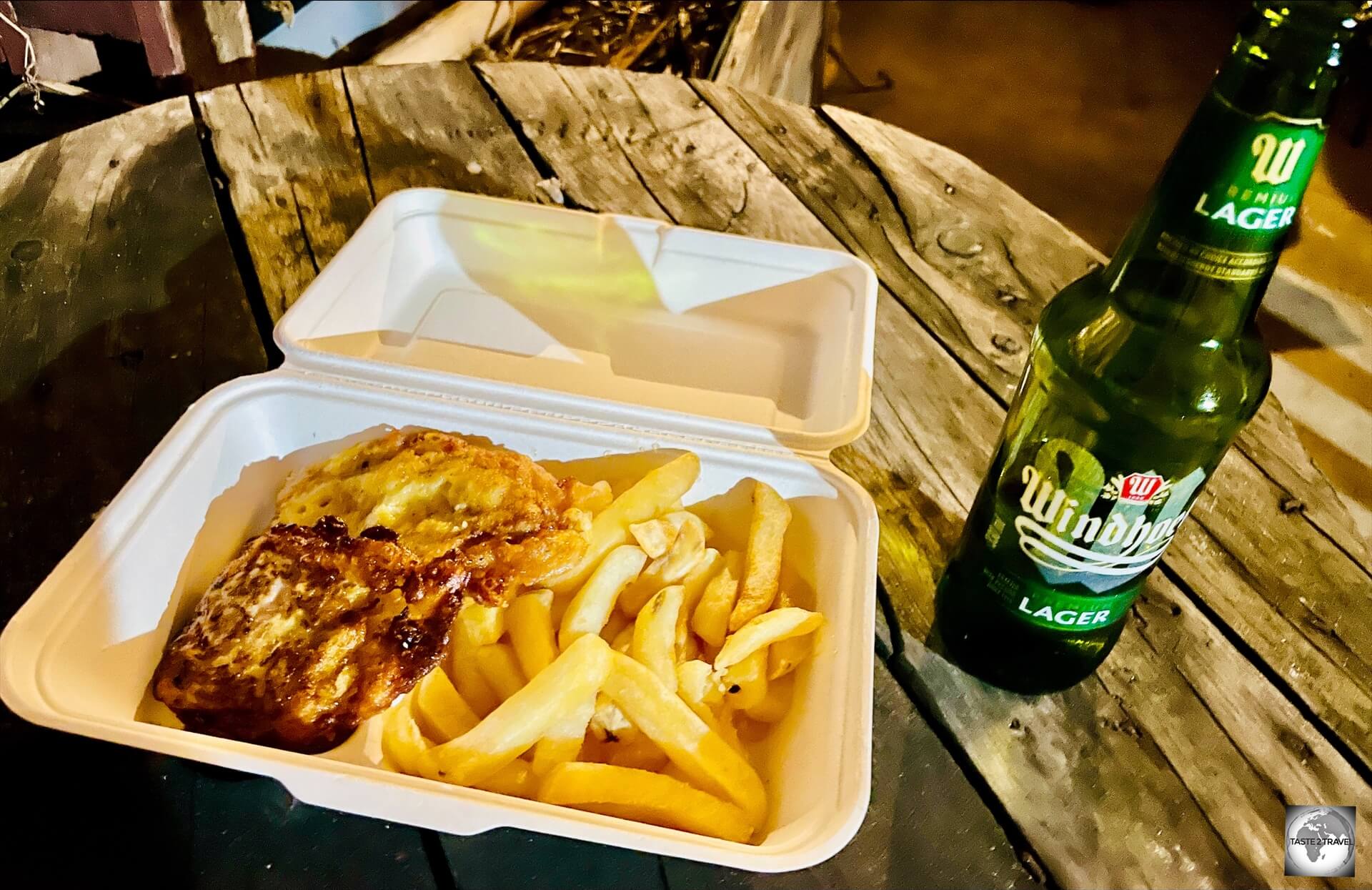
My fish and chips meal at the weekly Fish Fry.
This is a great opportunity to rub shoulders with the local Saints and to enjoy some fine fresh fish and (imported) beer.
Visa Requirements
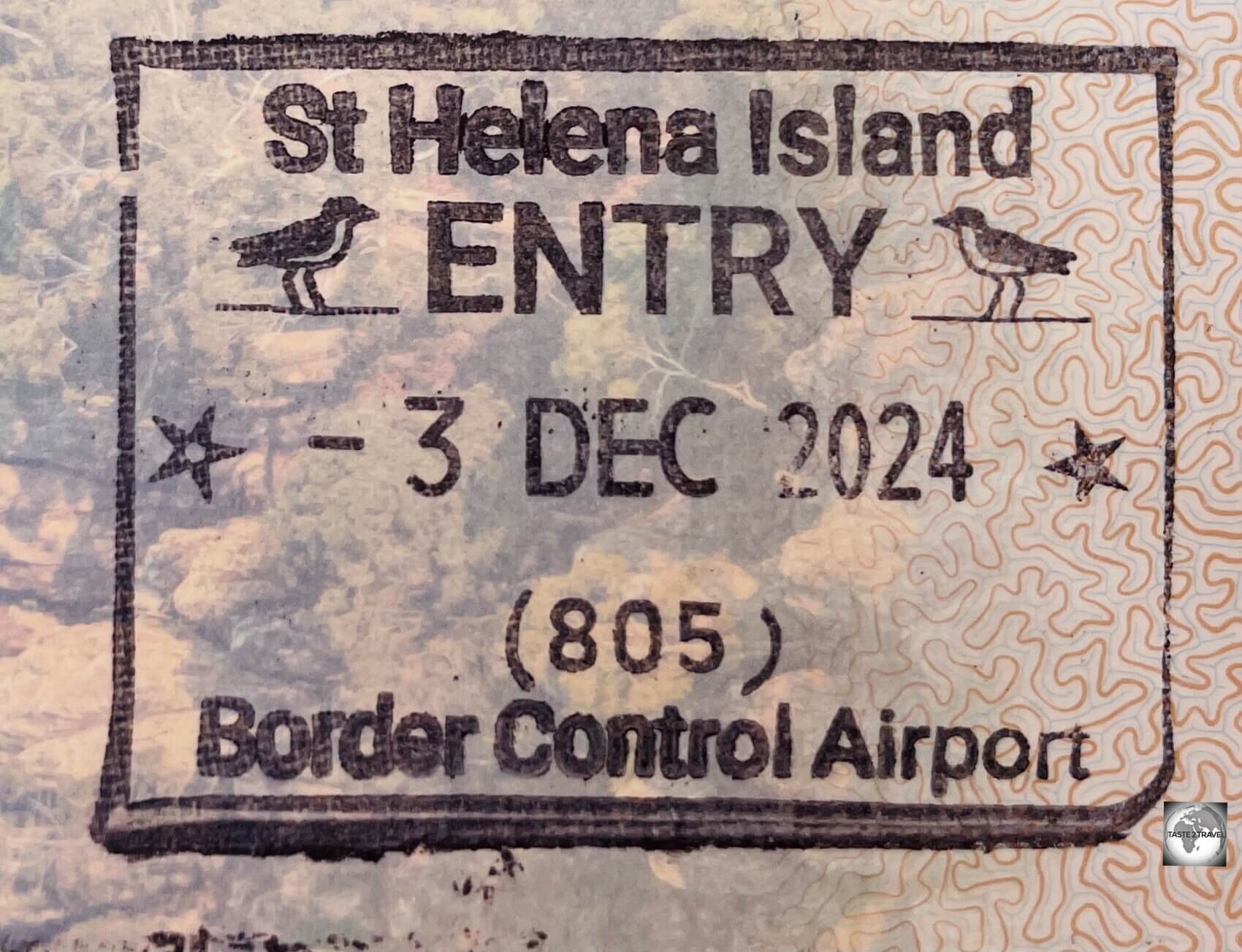
My passport entry stamp into Saint Helena.
It is important to note that the three different islands which comprise the British territory of Saint Helena, Ascension, and Tristan da Cunha each have their own entry requirements.
I have included the visa requirements for Ascension Island at the bottom of this section.
Visa Policy
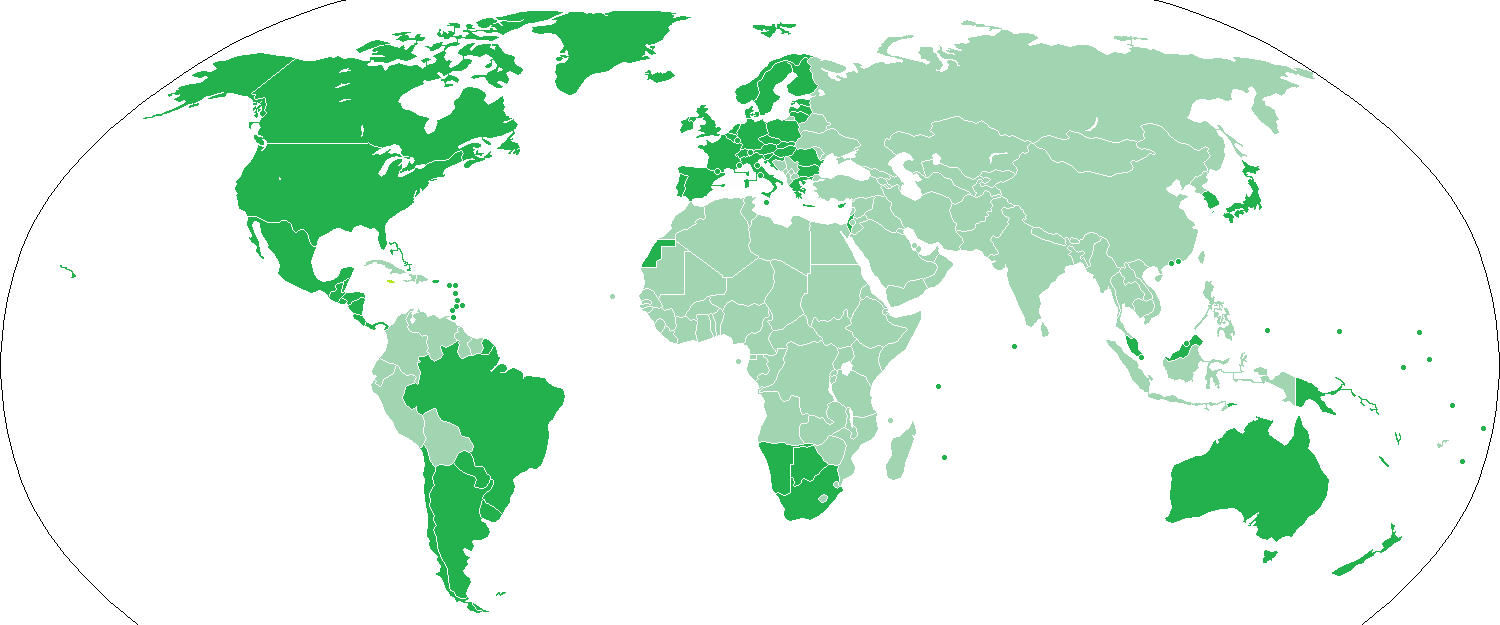
Visa Policy Map of Saint Helena.
The visa policy of Saint Helena grants visa-free access to all countries highlighted in dark green.
Nationals from the light green countries can apply for an online visa in advance.
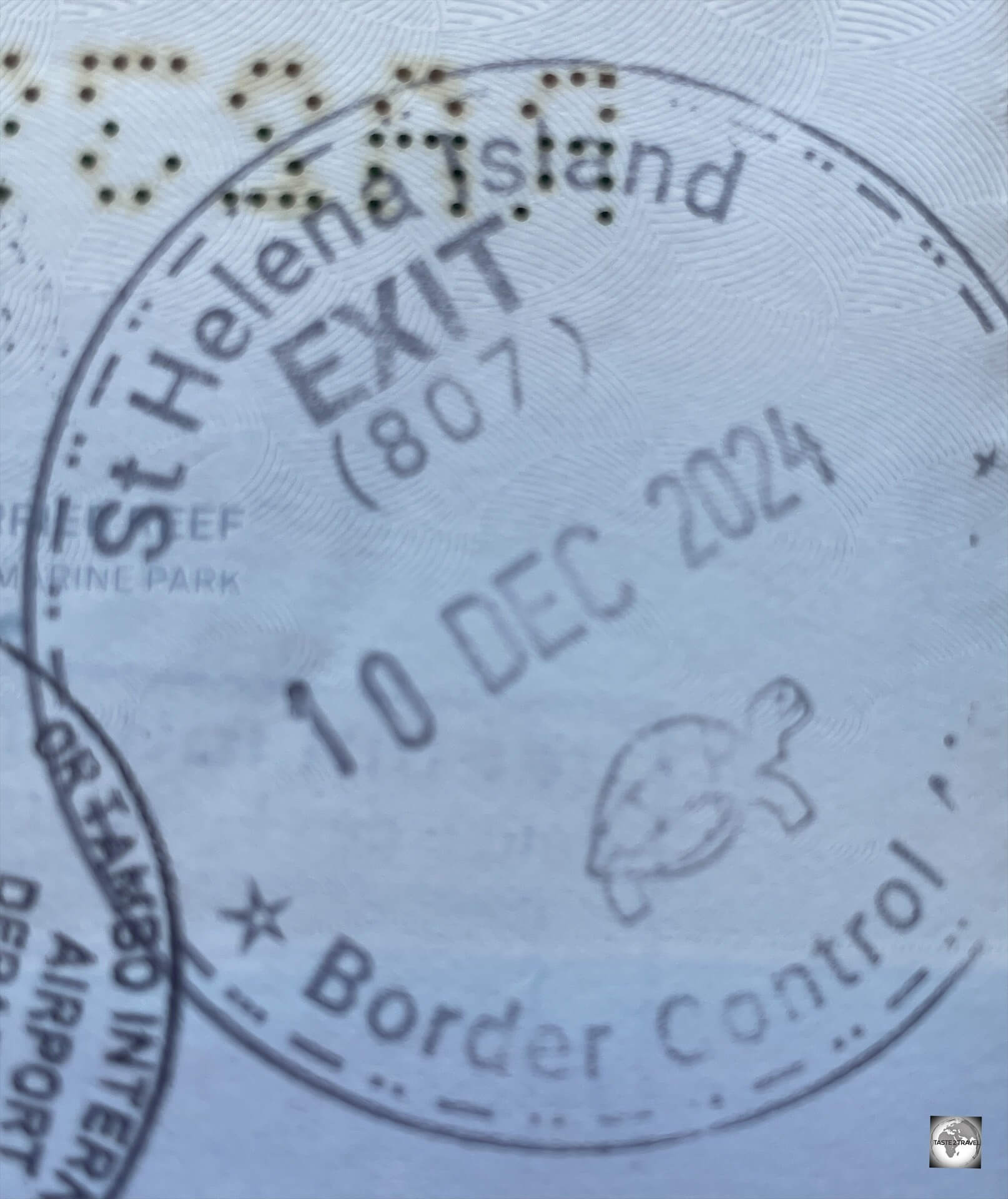
My passport exit stamp from Saint Helena, which features Jonathan the tortoise.
Entry Requirements
Entry requirements for Saint Helena are:
- Payment of an entry permit – which costs £20, payable in cash in British pounds, Euros, US dollars or South African rand.
- Proof of a return flight ticket.
- Proof of an accommodation booking.
- Sufficient funds for your visit.
- Proof of medical insurance that covers medical evacuation at a minimum value of £175,000.
Entry Permit
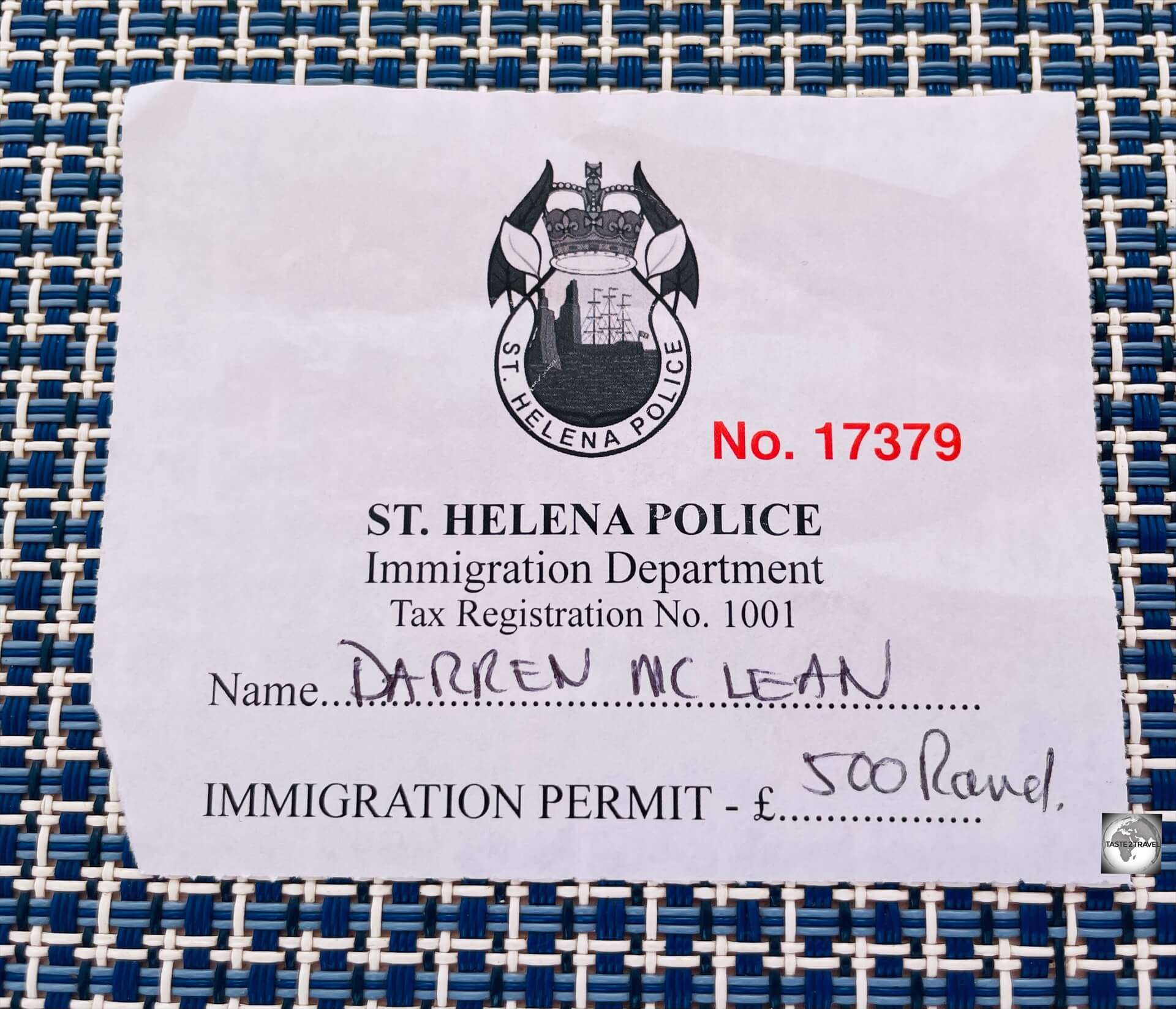
All visitors arriving at Saint Helena Airport must pay for an entry permit.
Important:
All visitors to Saint Helena are required to pay for an entry permit – which costs £20, payable in cash in British pounds, Euros, US dollars or South African rand.
There are no ATMs on Saint Helena, and no credit cards are accepted, so you need to ensure you are carrying sufficient cash when you arrive at the airport.
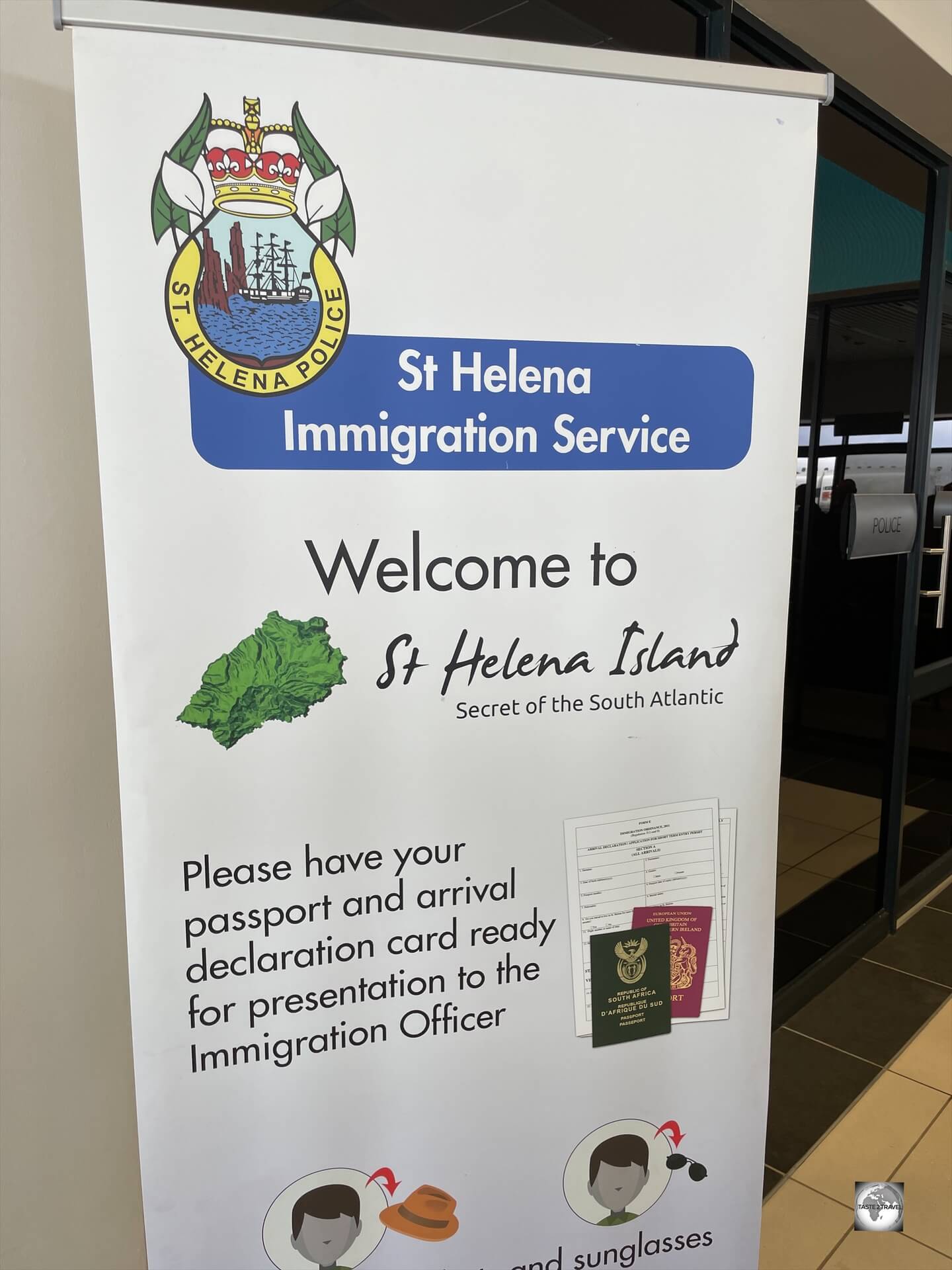
Entering Saint Helena.
Medical Insurance
When visiting Saint Helena, it is critical that you have a valid travel insurance policy which covers medical evacuation at a minimum value of £175,000.
This will be asked for by immigration and also at check-in by Airlink staff at Johannesburg Airport.
If you are unable to show proof of a valid travel insurance policy at Johannesburg Airport, you will be denied boarding.
Saint Helena Immigration Contacts
All details relating to immigration on Saint Helena can be viewed on the Saint Helena Immigration website.
For any enquiries related to visas, you should email Saint Helena Immigration Services at: evisaenquiries@sainthelena.gov.sh
Visa Requirements – Ascension Island

The flag of Ascension Island.
Both Saint Helena and Tristan da Cunha have relatively straight-forward entry requirements while Ascension Island (a military base) is a little more complicated.
All visitors to Ascension should note that no travel can be arranged without confirmation that a valid entry permit (e-visa) has been issued.
All nationalities, including British citizens, need to apply for an e-visa from the Ascension Island Government (AIG), unless you are exempt due to your occupation – i.e. certain government and military personnel.
Visa Application Process
You must apply for an Ascension Island e-visa, in advance, through the AIG e-visa application portal.
There is no visa-on-arrival option on Ascension Island.
Applications take time! You should apply for a visa at least 14 days before your intended travel date, unless there is a genuine emergency.
Late applications without a valid reason may be refused.
Since the island serves as a military base, which is shared between the UK and US governments, the e-Visa application asks for your complete travel history for the past 5 years.
You must list all countries which you have visited during the last 5 years and list any visas obtained during that period.
Each applicant will need a separate application, for example a family of four will need to complete four applications – one for each person wishing to travel to Ascension.
Visa Cost
The cost of the e-visa is £20 per person if the application is submitted at least 14 days prior to arrival.
A Fast Track fee of £30 automatically applies to all applications made where the applicant wishes to arrive within a shorter period than 14 days from the date of the application.
Entry Requirements
Entry requirements for Ascension Island are:
- A valid entry e-visa
- A return flight ticket
- Confirmed accommodation booking
- Sufficient funds for your visit
- Medical insurance that covers medical evacuation at a minimum value of £500,000
Charter Flight Bookings
Bookings on the monthly charter flight (operated by Airlink) between Saint Helena and Ascension are fully managed by the AIG flight booking team.
Please refer to the ‘Getting There‘ section below for more details.
Ascension Island Immigration Contacts
- Ascension e-visa portal: https://www.ascension-visas.com/
- Ascension police email: Police.admin@ascension.gov.ac
Getting There
Air
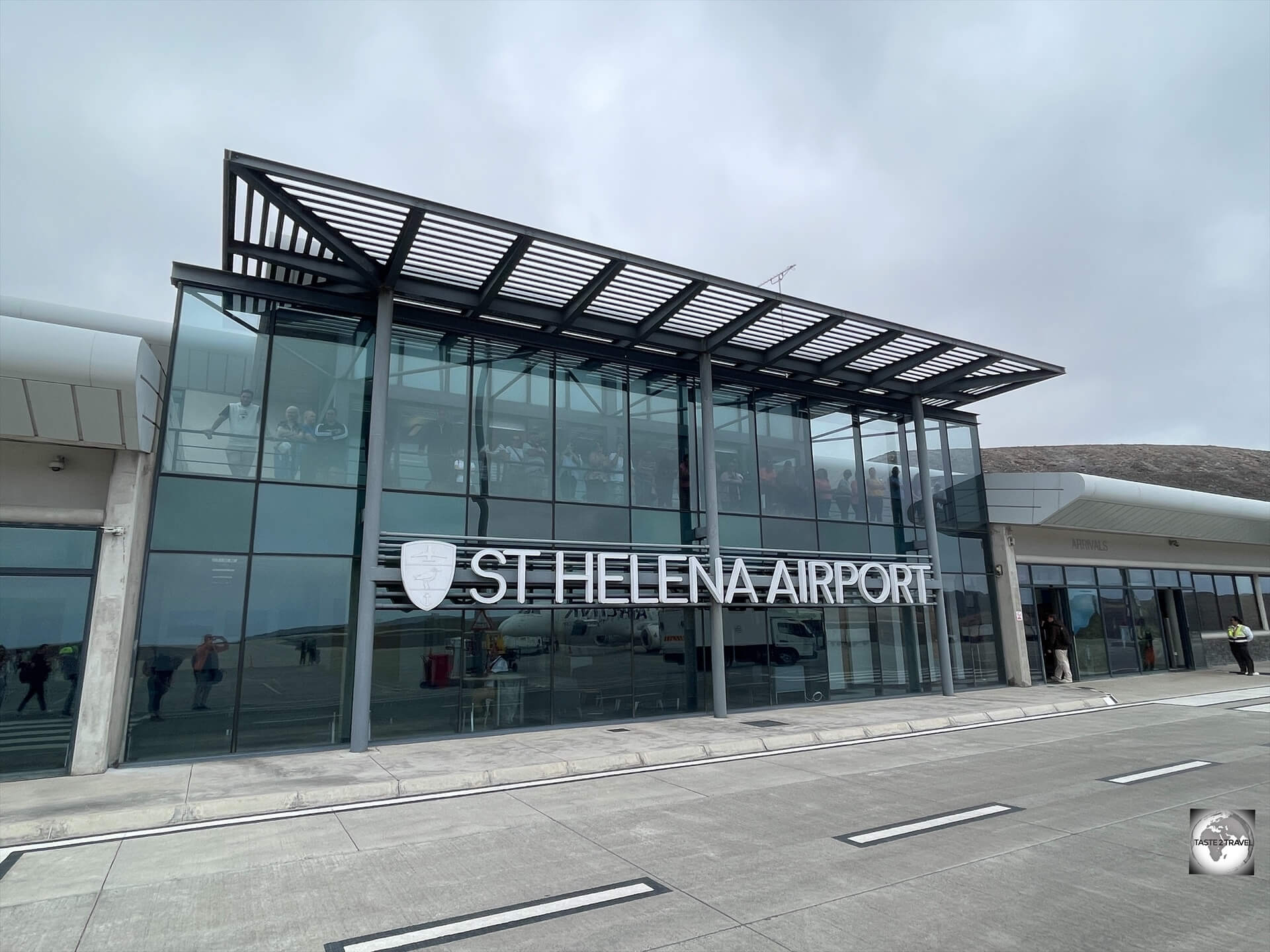
Saint Helena airport was opened in 2017, ending the island’s long period of isolation.
For most of its history, Saint Helena remained one of the most isolated places in the world with the only way of reaching it being a sea journey from Cape Town, on the RMS Saint Helena, which typically lasted 10 to 12 days.
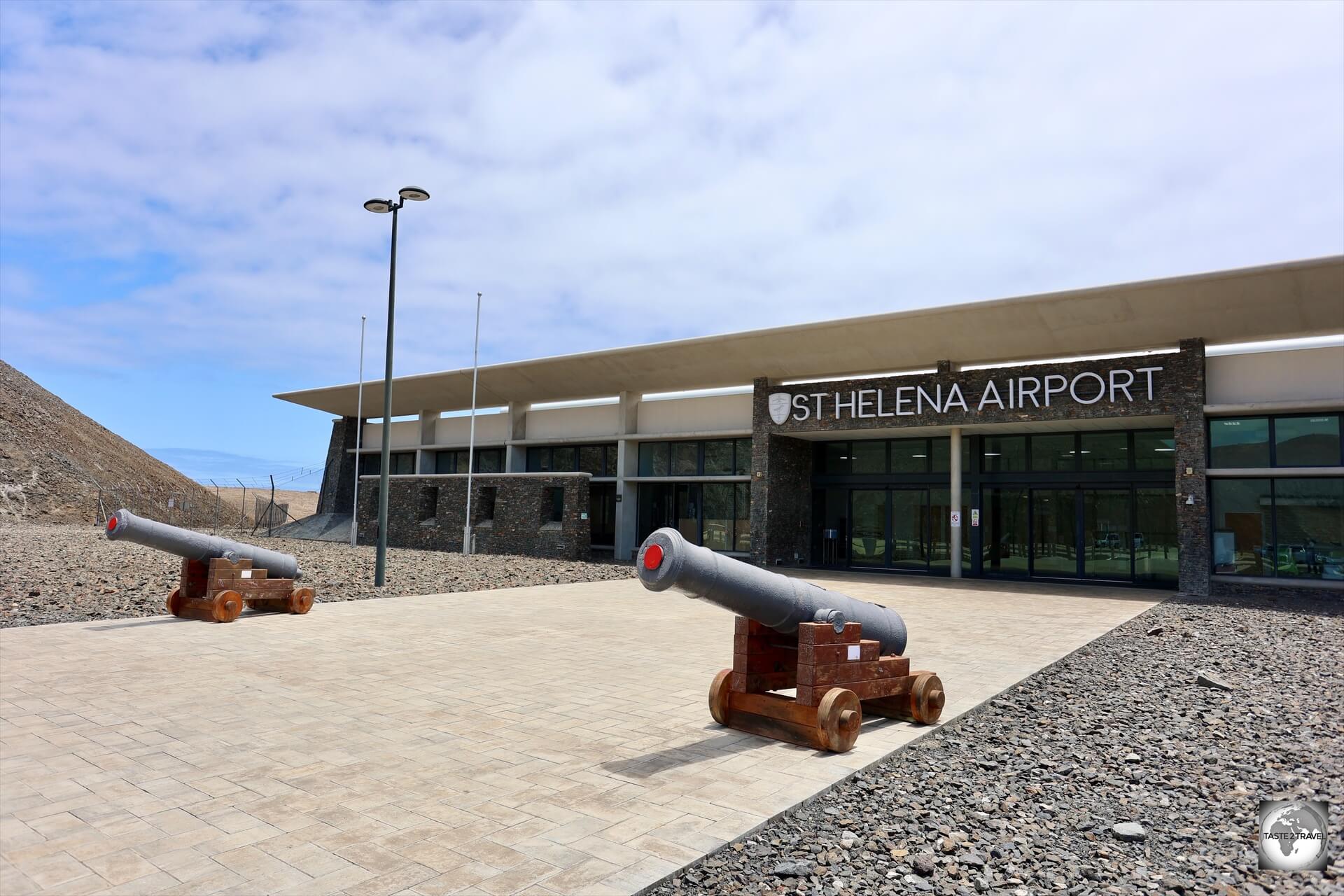
The terminal building at the newly completed Saint Helena Airport.
This all changed in 2017 with the opening of Saint Helena Airport (IATA: HLE), which was built at a cost of £285.5 million.
The Flights page on the Saint Helena Tourism Website contains information regarding the airport along with important aviation links.
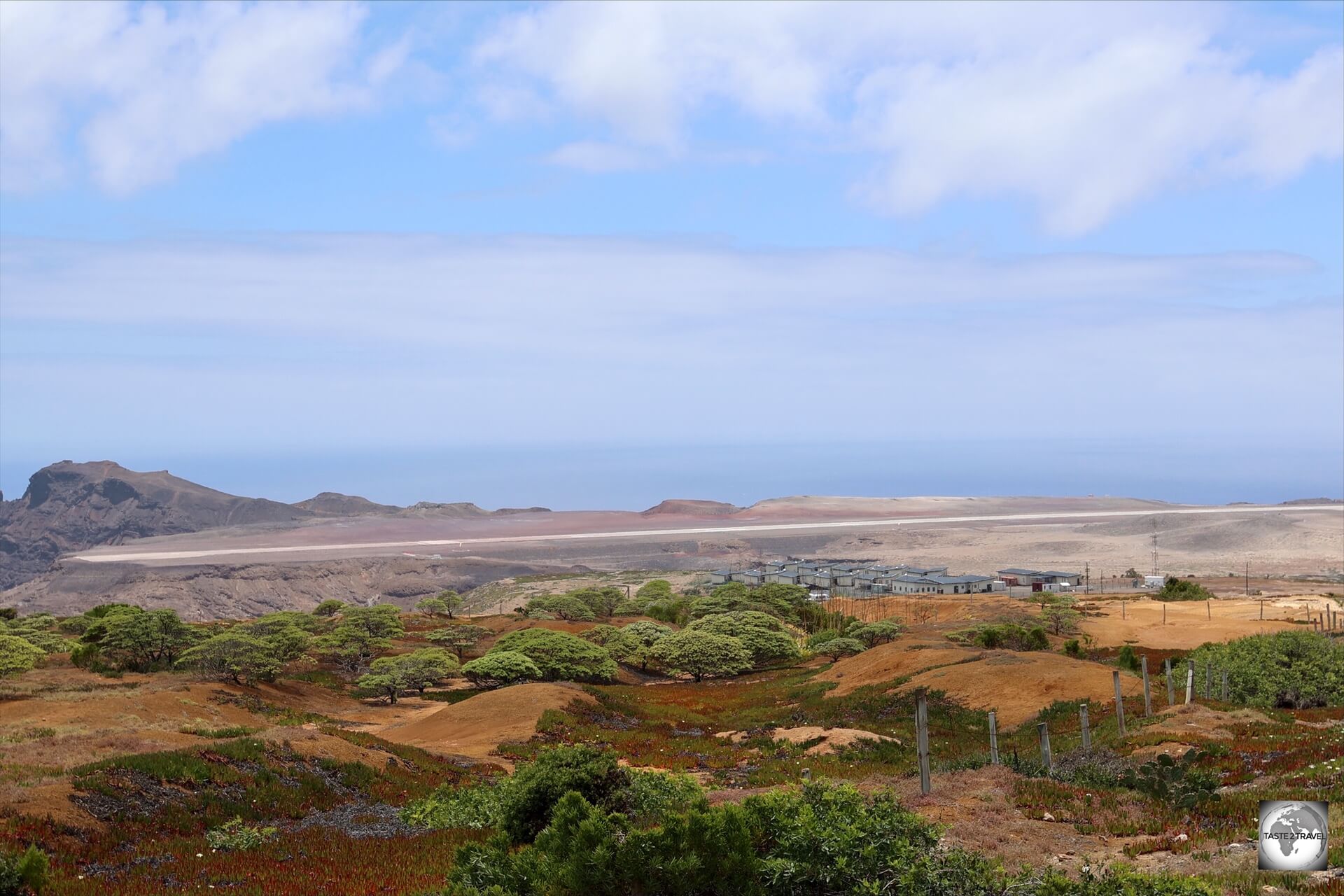
A view of the runway at Saint Helena Airport from the Millennium Forest.
Located on the very arid east coast of Saint Helena, 17 km east of Jamestown, the airport serves as the only regular international gateway to the island.
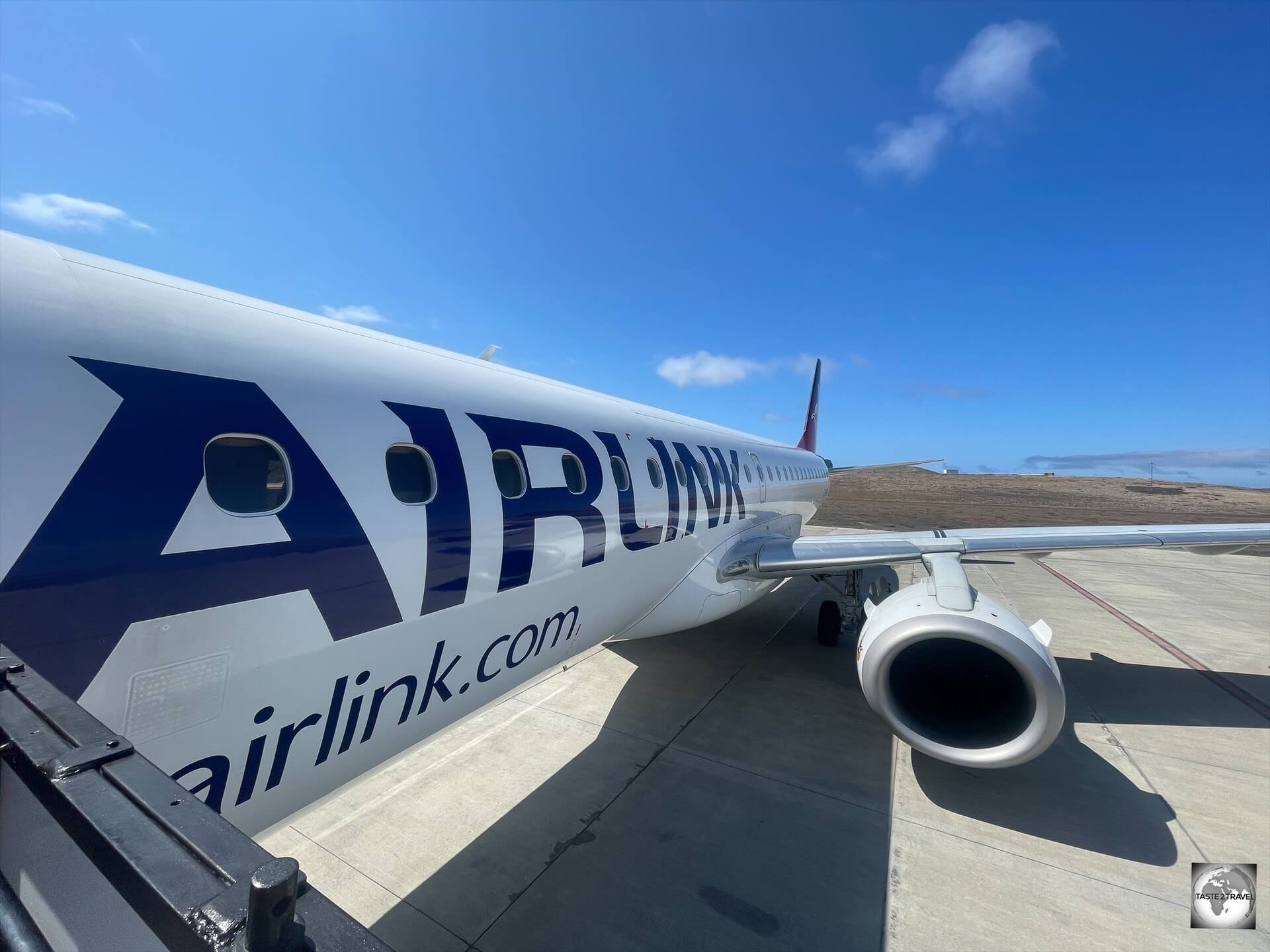
The South African airline, Airlink, provides the only flight to Saint Helena, flying every Saturday from Johannesburg.
The airport began scheduled commercial services on 14 October 2017, when the South African carrier Airlink inaugurated a weekly (Saturday) service, using an Embraer E190-100.
Video: On final approach to Saint Helena Airport.
The flight operates from O. R. Tambo International Airport (IATA: JNB) in Johannesburg, to Saint Helena Airport – with a refuelling stop (when required) at Walvis Bay Airport (IATA: WVB), Namibia.
Walvis Bay Refueling Stop
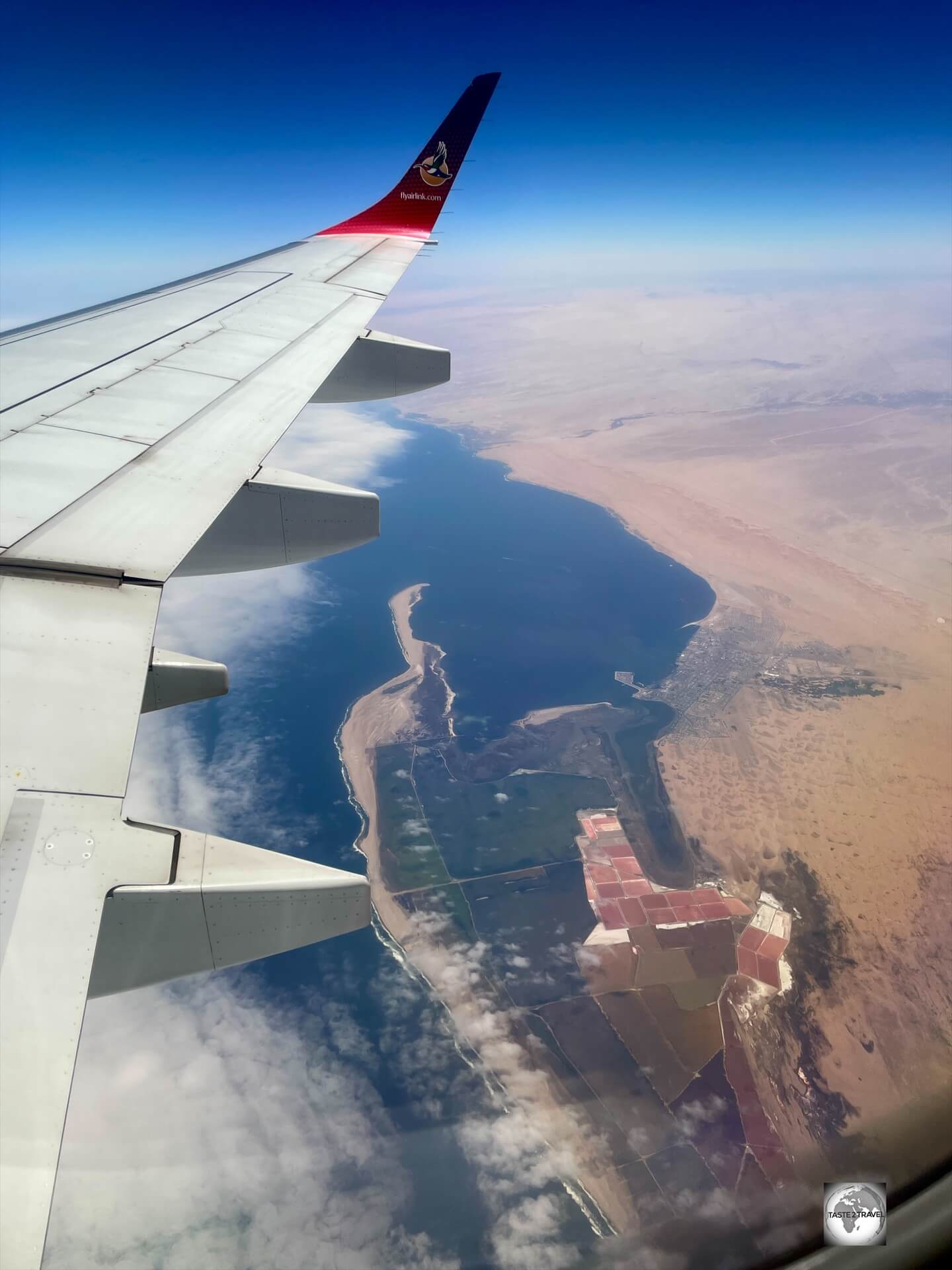
Flying over Walvis Bay, Namibia, without needing to make a fuel stop.
The refueling stop at Walvis Bay Airport isn’t compulsory and is made only if wind conditions are difficult on Saint Helena and there is a possibility that the flight cannot land and has to double back to Namibia.
On the day I flew, wind conditions on Saint Helena were calm and hence, we were able to fly directly to Saint Helena without the need to stop over at Walvis Bay.
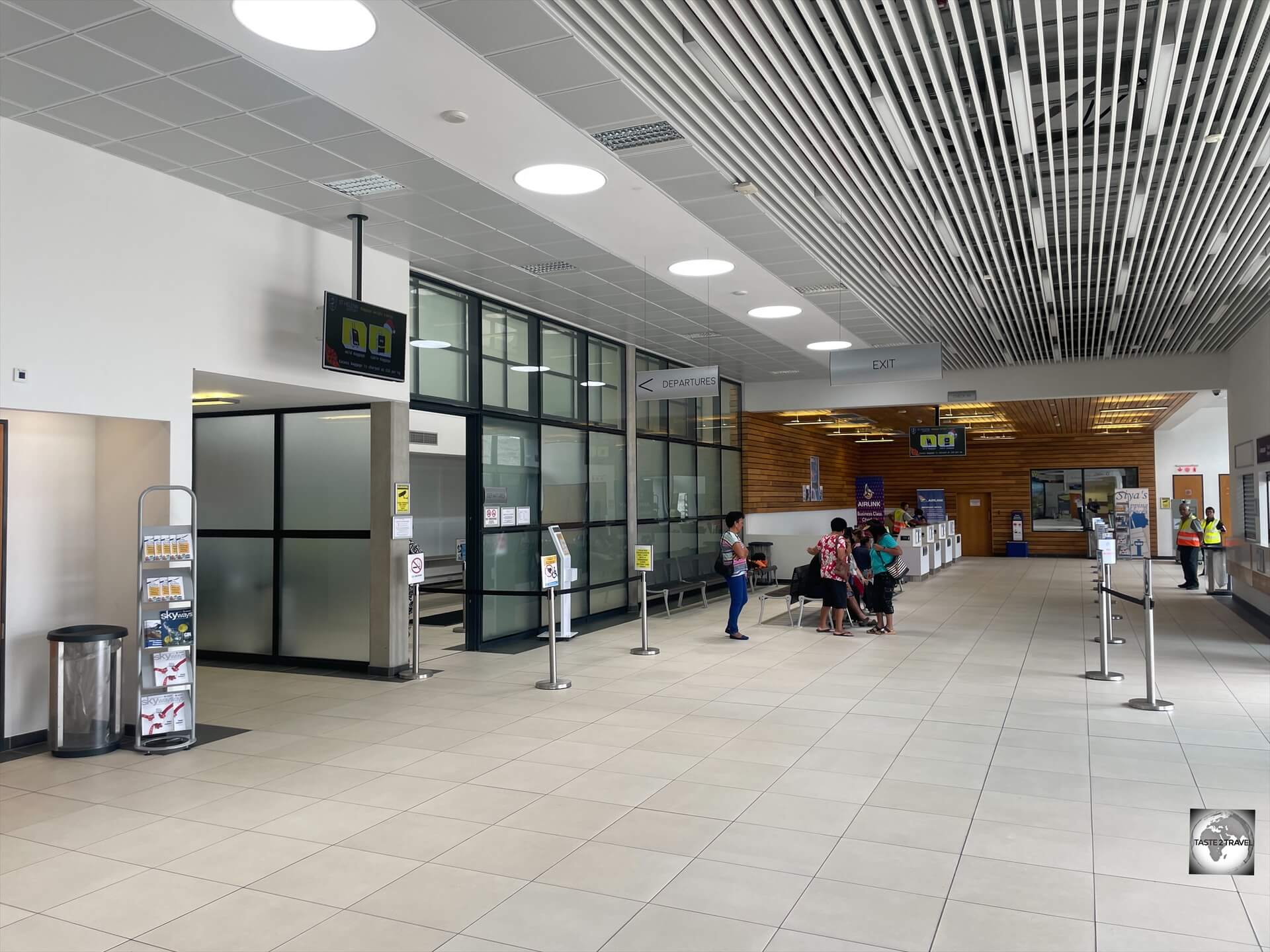
The departure area at Saint Helena Airport.
Flight Schedule
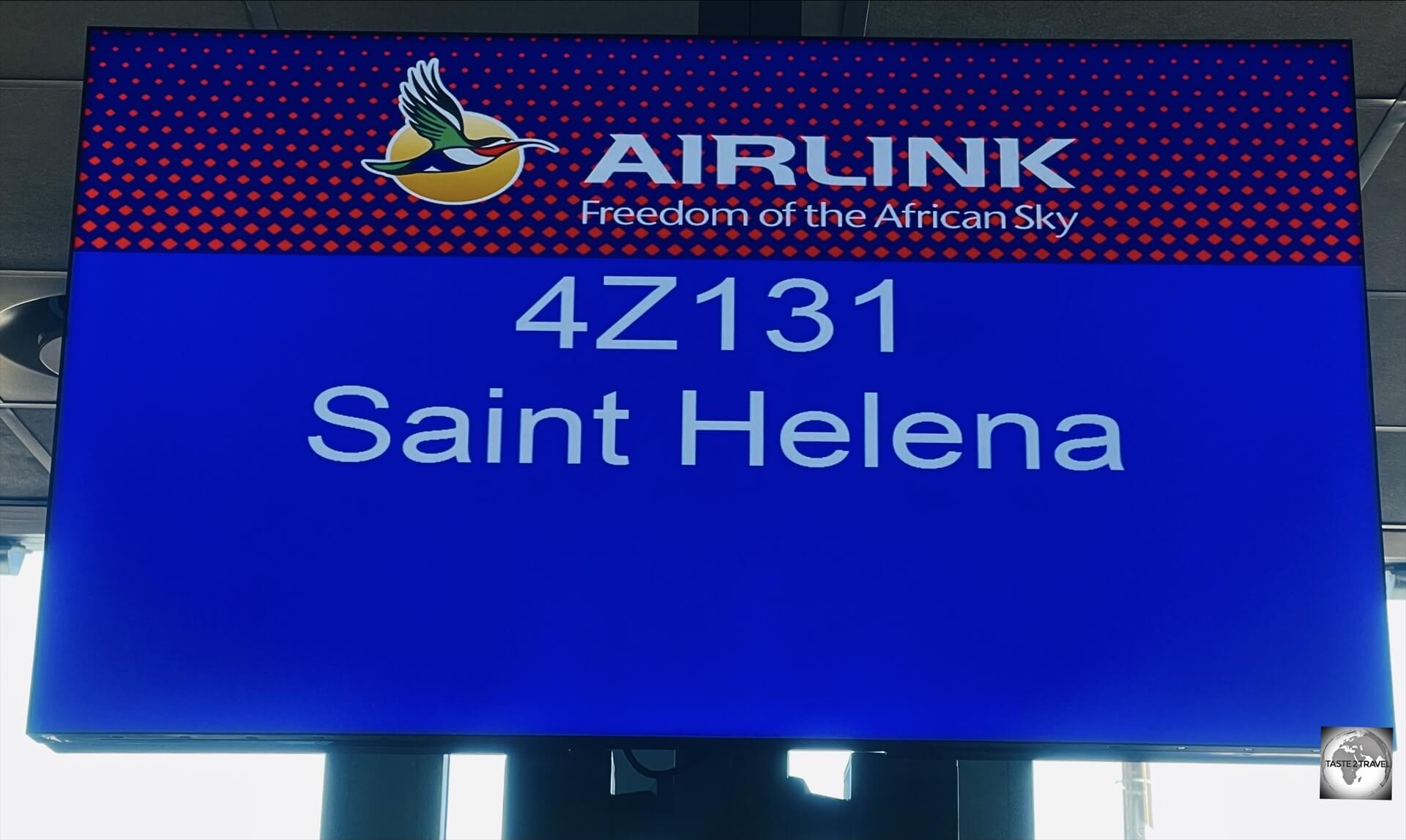
Airlink flight 4Z131 flies every Saturday from Johannesburg to Saint Helena.
- Airlink flight 4Z 131 operates every Saturday from JNB to HLE, with a refueling stop (if required) in Walvis Bay (Namibia). The flight departs from JNB at 09:00, arriving at HLE at 13:25.
- The return flight, 4Z 132, departs from HLE on the same day at 14:30, arriving at JNB at 21:15.
During the peak holiday season, between November and February, Airlink operate two flights per week to Saint Helena as follows:
- Every Saturday: Cape Town to Saint Helena
- Every Tuesday: Johannesburg to Saint Helena
Click to view the current Airlink Flight Schedule.
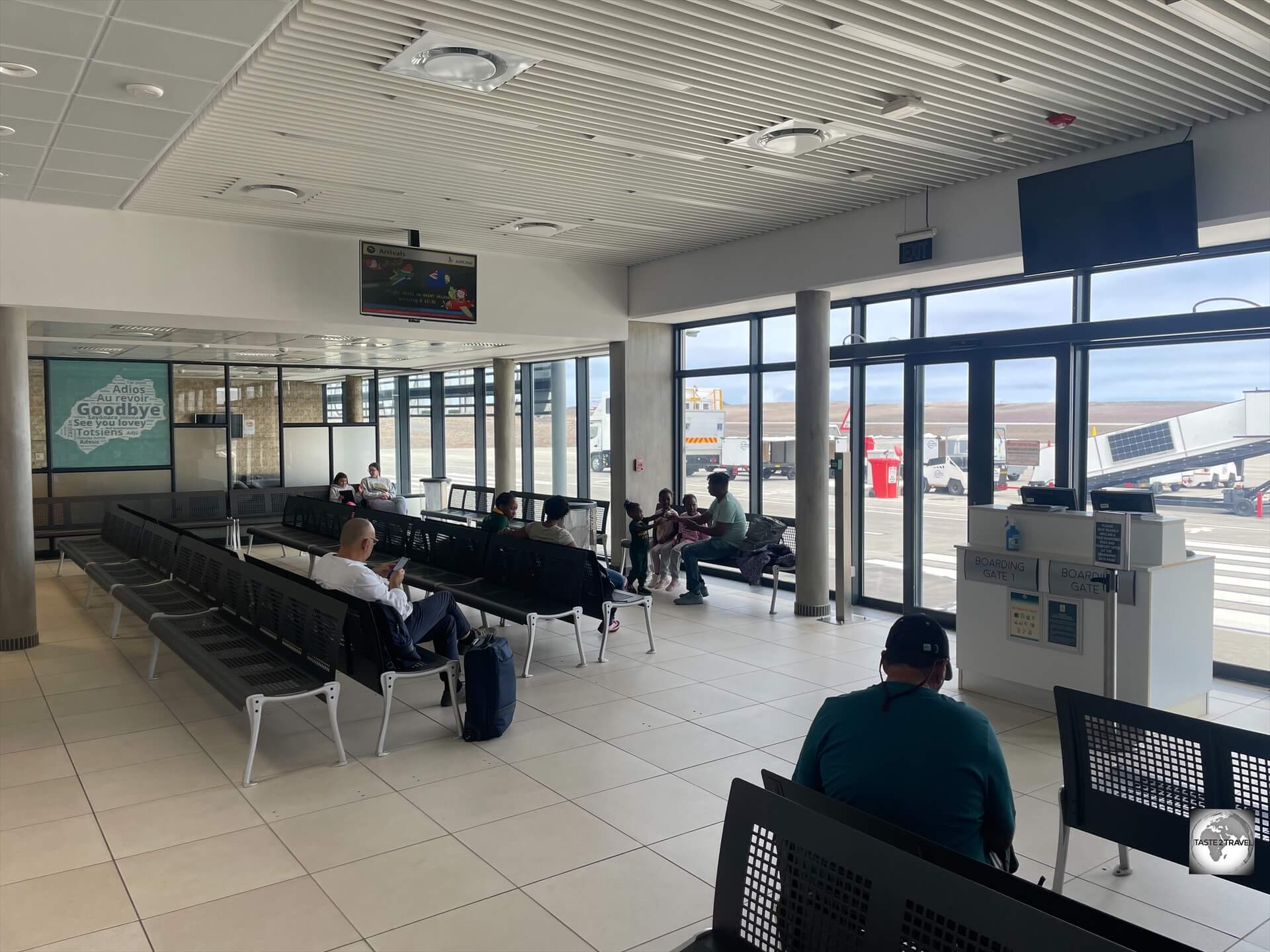
The departure lounge at Saint Helena Airport.
Flight Cost
A typical return flight from JNB to HLE costs around 14,500 ZAR (£620) and can be booked through the Airlink website.
Sea
Around nine cruise ships call at Saint Helena each year, with each spending one day at port.
Ships anchor offshore, with passengers being transported ashore via tender.
The current cruise ship schedule for Saint Helena is available online.
Getting There – Ascension Island

The flag of Ascension Island.
There are two ways of flying to Ascension Island:
- The monthly Airlink Charter Flight from Saint Helena.
- The regular Ministry of Defence (MOD) Airbridge flights from RAF Brize Norton (UK) and RAF Mount Pleasant (Falkland Islands).
Monthly Airlink Charter Flight
The Airlink Ascension Island charter flight is scheduled once every four weeks, operating from Saint Helena (IATA: HLE) to Ascension (IATA: ASI) on Saturdays, with the same flight returning to Saint Helena on Sunday morning.
This flight is a continuation of the weekly Johannesburg (JNB) – HLE flight.
The Ascension charter flight is operated by Airlink, on behalf of the Government of Ascension Island (AIG) with all tickets being sold by the AIG flight booking team.
You cannot book a seat on the Ascension charter flight through Airlink.
Normally, Airlink return to Johannesburg from Saint Helena on Saturday afternoon, however, when an Ascension charter flight operates, the return flight to Johannesburg departs from Saint Helena one day later – on Sunday afternoon.
Charter Flight Booking Form
All charter flight booking requests are to be made using the Airlink Flight Booking Form which is to be completed and emailed to the AIG flight booking team.
You will first need to obtain an e-Visa for Ascension before you can book any travel to the island.
However, you should first check seat availability with the flight booking team before starting the Ascension e-visa process.
Charter Flight Schedule
Once a month, the regular Saturday Airlink flight from JNB to HLE continues onto ASI as a special charter flight.
This same flight then returns to HLE on Sunday, then continues back to JNB on the same day.
- Flights from HLE to ASI (flight: 4Z 3135) takes place one Saturday per month, departing HLE at 14:30 and arriving at ASI at 16:30.
- Flights from ASI to HLE (flight: 4Z 3136) takes place on the following day, departing ASI on Sunday at 11:15 and arriving at HLE at 13:15, before returning back to JNB.
Click to view the current Ascension Charter Flight Schedule.
Note: It should be noted that if you fly to/ from Ascension on the same return flight, you will have just 18 hours and 45 minutes on Ascension.
Contacts details for the AIG Flight Booking Team:
- Address: Ascension Island Government, Administration Building, Georgetown, Ascension Island, ASCN 1ZZ
- Telephone: + (247) 67000 ext. 1111
- Email: flight.bookings@ascension.gov.ac
- Website: https://www.ascension.gov.ac/
Charter Flight Cost
The cost of a single fare between Saint Helena and Ascension is £445, while the return fare costs £890.
This is in addition to the return fare from Johannesburg to Saint Helena which is around £620. This flight is to be purchased through Airlink.
Total Flight Cost:
The total cost of a return flight, flying with Airlink, from Johannesburg to Ascension, via Saint Helena will be approximately £1,510.
If travelling on this flight, you can arrange to break the journey, spending one week (or more) on Saint Helena, as part of the journey.
MOD Airbridge Flights
The MOD have made available fifteen seats on each of the South Atlantic Airbridge flights to and from Ascension and the UK/ Falkland Islands.
The AIG flight booking team manages the booking process and all booking requests at to be made on the Airbridge Flight Booking Form.
Flight bookings are accessible to staff working on Ascension, their dependents and visiting family and friends.
The MOD will not permit transit bookings or those where Airbridge passengers intend to link visits to Ascension with travel to or from Saint Helena via Airlink.
Transit is allowed between Falklands and St Helena via Airbridge and Airlink flights.
Accommodation on Ascension Island
There are just two accommodation options on Ascension Island:
Heart Held Guest House – which offers six accommodation suites.
- Telephone: +247 66344 or +247 66317
- Email: heartheldguesthouse@atlantis.co.ac
- Email: You can email enquiries to Syrena Ellick at jams.dreams@outlook.com
JAMS also offer rental cars.
Getting Around
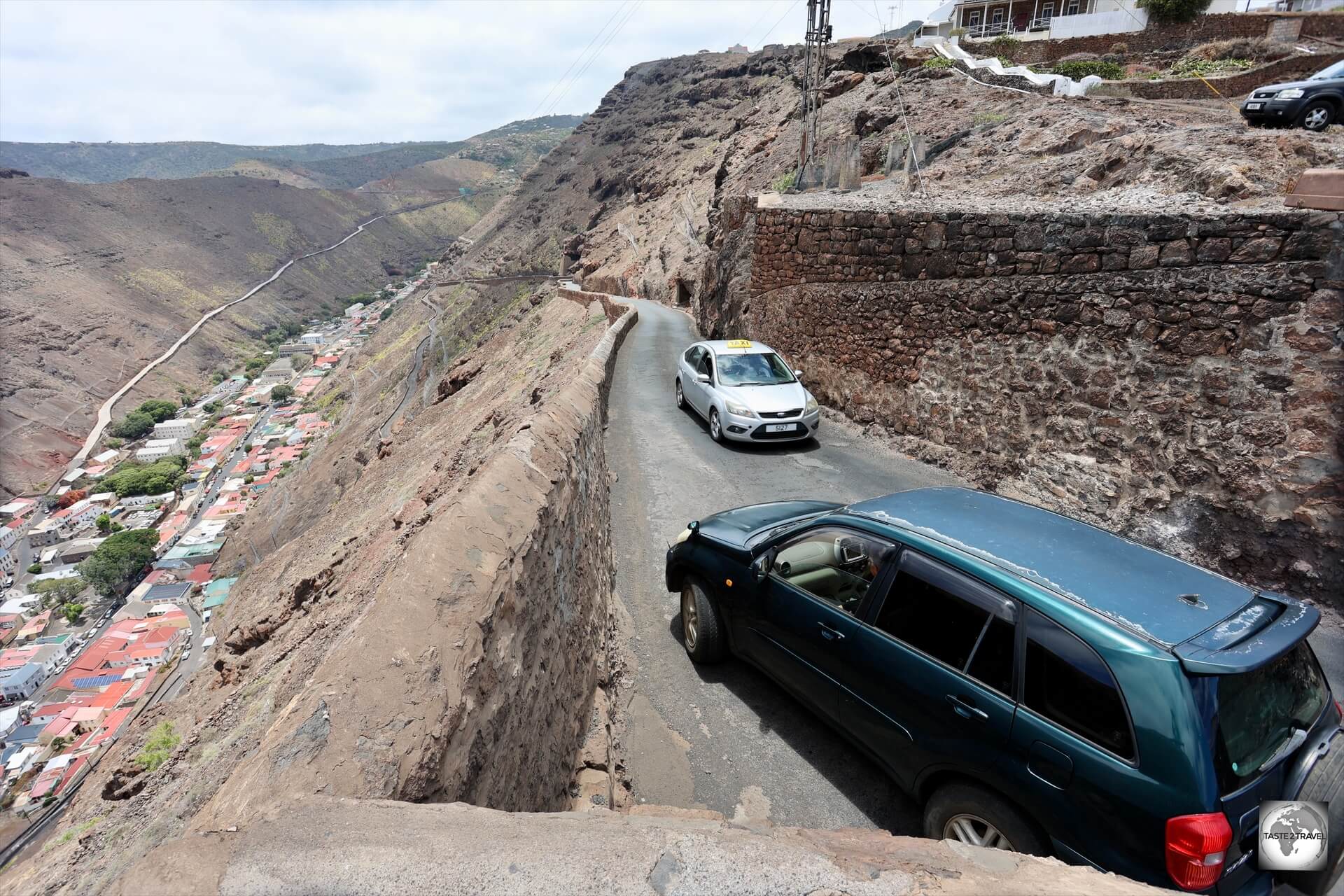
Driving on the narrow, windy roads of Saint Helena requires lots of giving way to oncoming motorists.
The roads on Saint Helena are generally narrow, and due to the island’s mountainous topography, they often wind and twist around steep hillsides and cliffs.
This makes for a scenic but sometimes challenging drive.
In many places, roads are only wide enough for one vehicle, and passing another vehicle can require careful maneuvering, especially on the more remote sections.

A view of the newly widened concrete road which connects Jamestown with other parts of the island.
The island’s geography is highly mountainous, and roads frequently climb up steep inclines or descend into deep valleys.
Some parts of the roads are carved directly into the rock faces.
Saint Helena has only around 300 kilometres (186 mi) of paved roads, and the network is relatively small, so it’s easy to traverse the whole island, though not necessarily quickly due to the terrain.
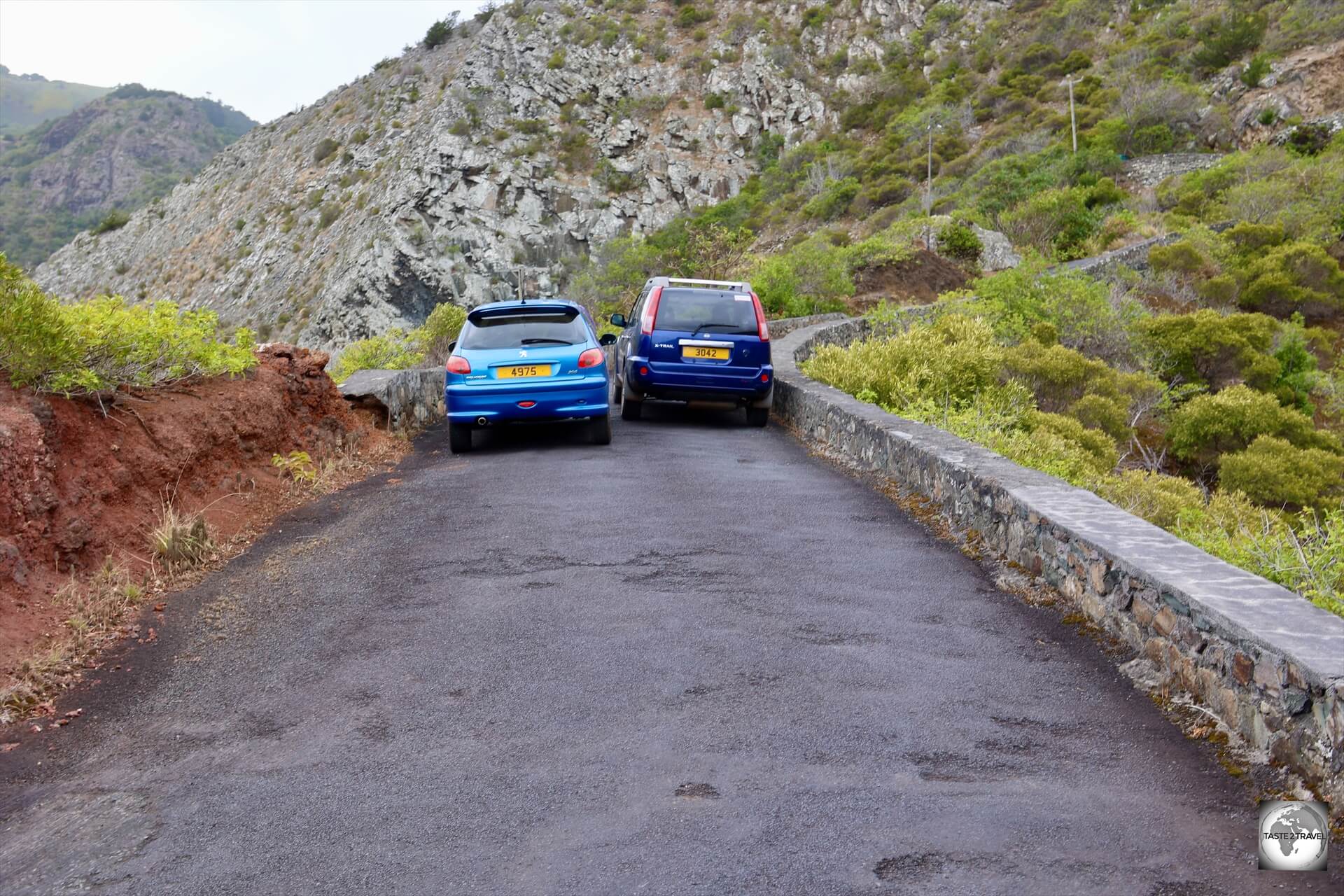
The roads of Saint Helena are narrow, windy, twisting and always challenging.
During my week of driving on the island, I rarely reached 4th gear with 1st and 2nd gear being used the most.
The speed limits are low which is a reflection of the difficult driving conditions.
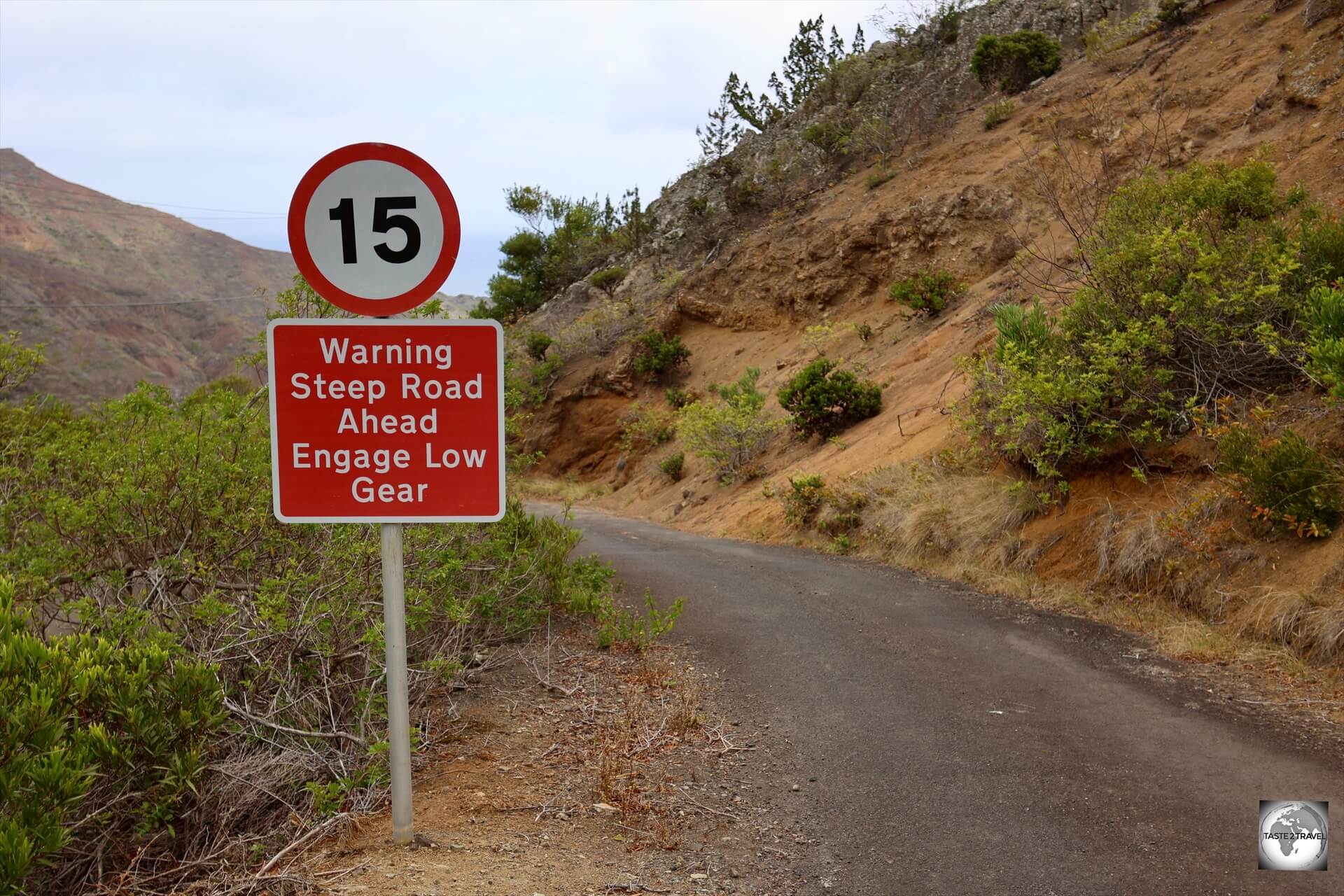
Low speed limits on Saint Helena reflect the challenging road conditions.
It’s impossible to travel fast on the windy roads of St Helena!
Driving at night is challenging with an absence of street lighting anywhere on the island.
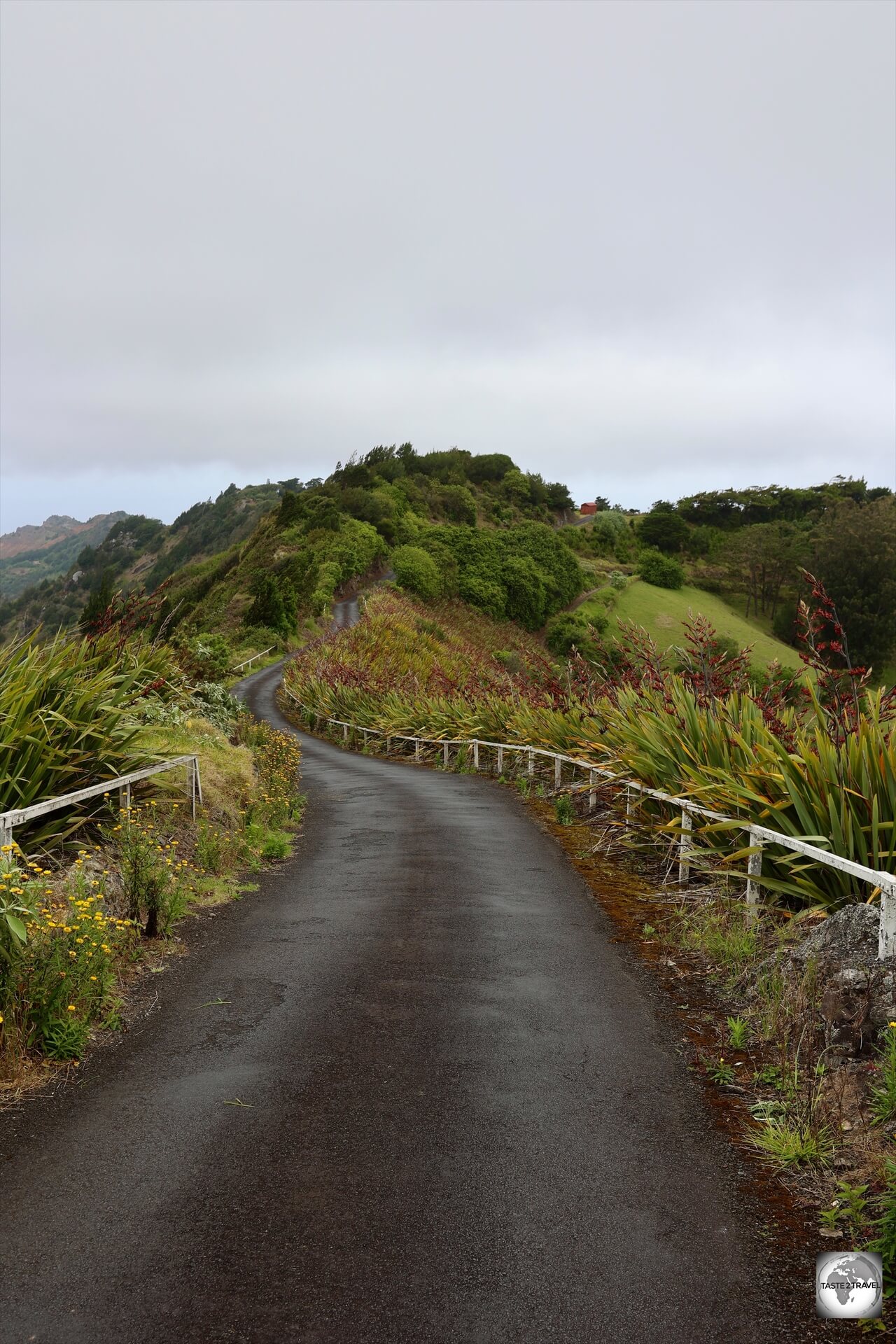
The lonely road to Blue Point.
Despite their challenges, many of Saint Helena’s roads offer some of the most breathtaking views of the island’s natural beauty.
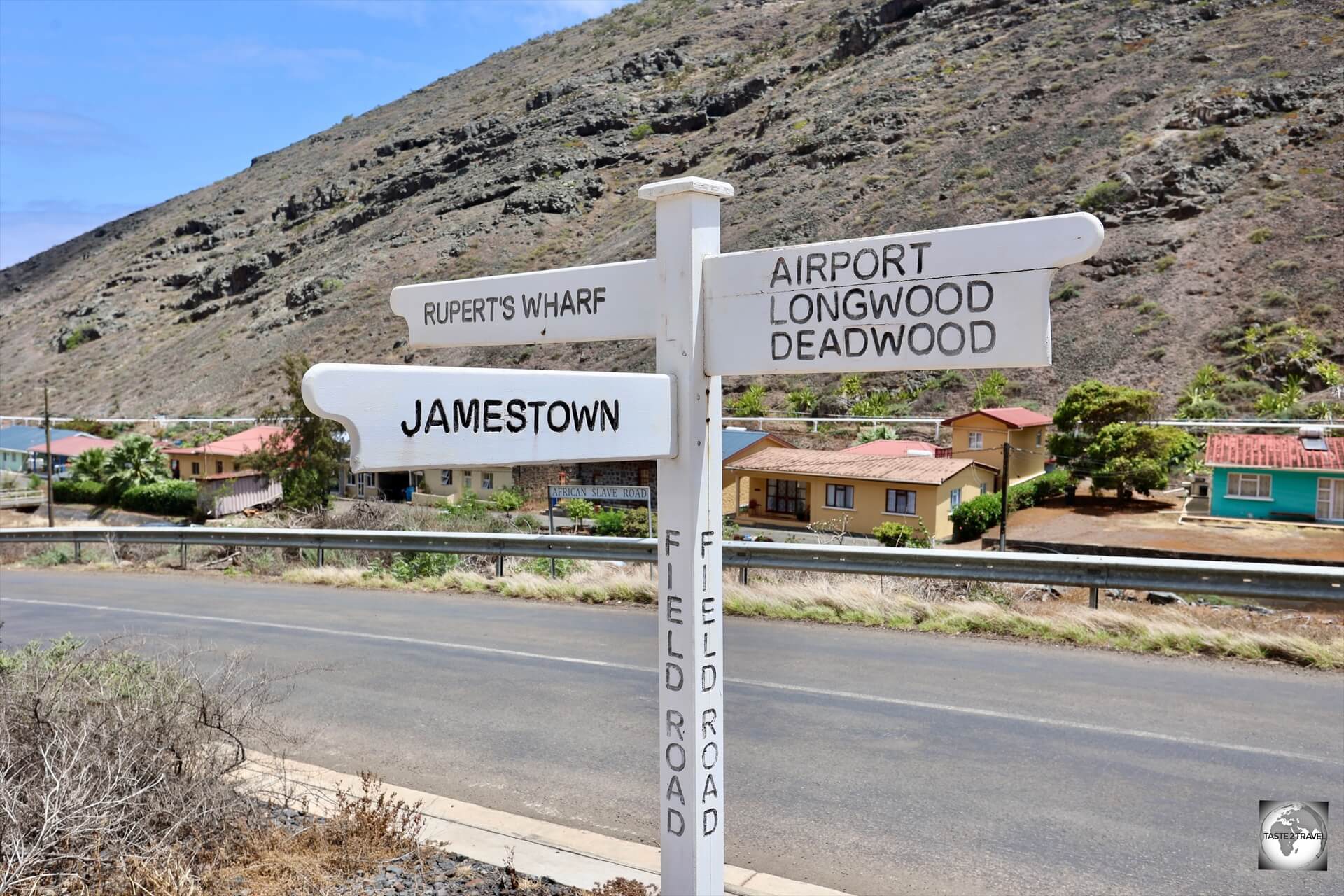
A road sign at Rupert’s Bay.
Public Transport
There is no public transport on Saint Helena.
The best option for visitors is to hire a rental car or a taxi for short excursions.
Taxi

Taxis can be chartered for short trips into the countryside.
There are several taxi operators on Saint Helena with a taxi rank located in Jamestown, behind the Tourist Office.
Taxis are listed on the Transport page of the Saint Helena Tourism Website.
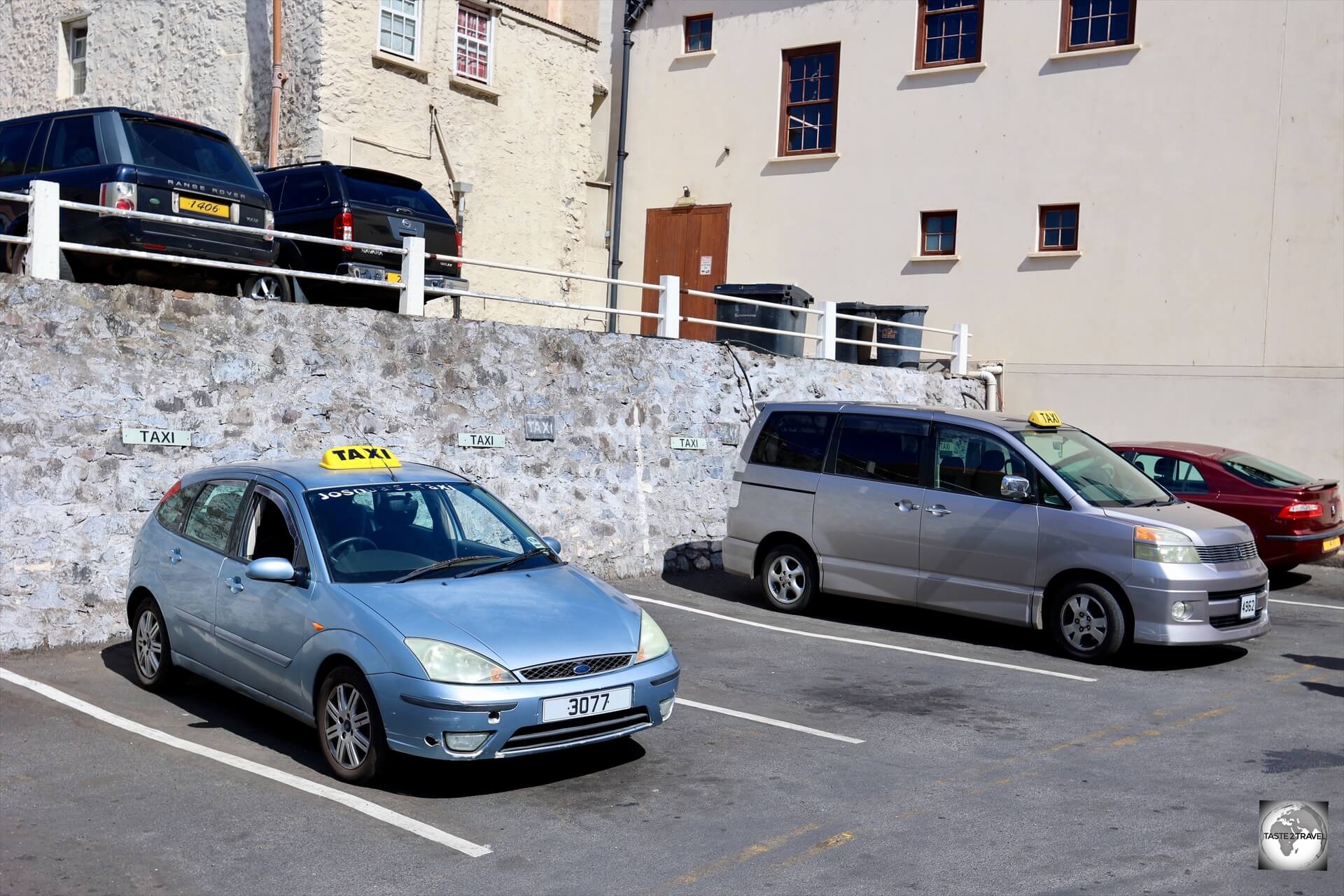
The only taxi rank on Saint Helena is located behind the Tourist Office in Jamestown.
Taxis do not have meters and rates should be confirmed before beginning your journey.
Rental Car
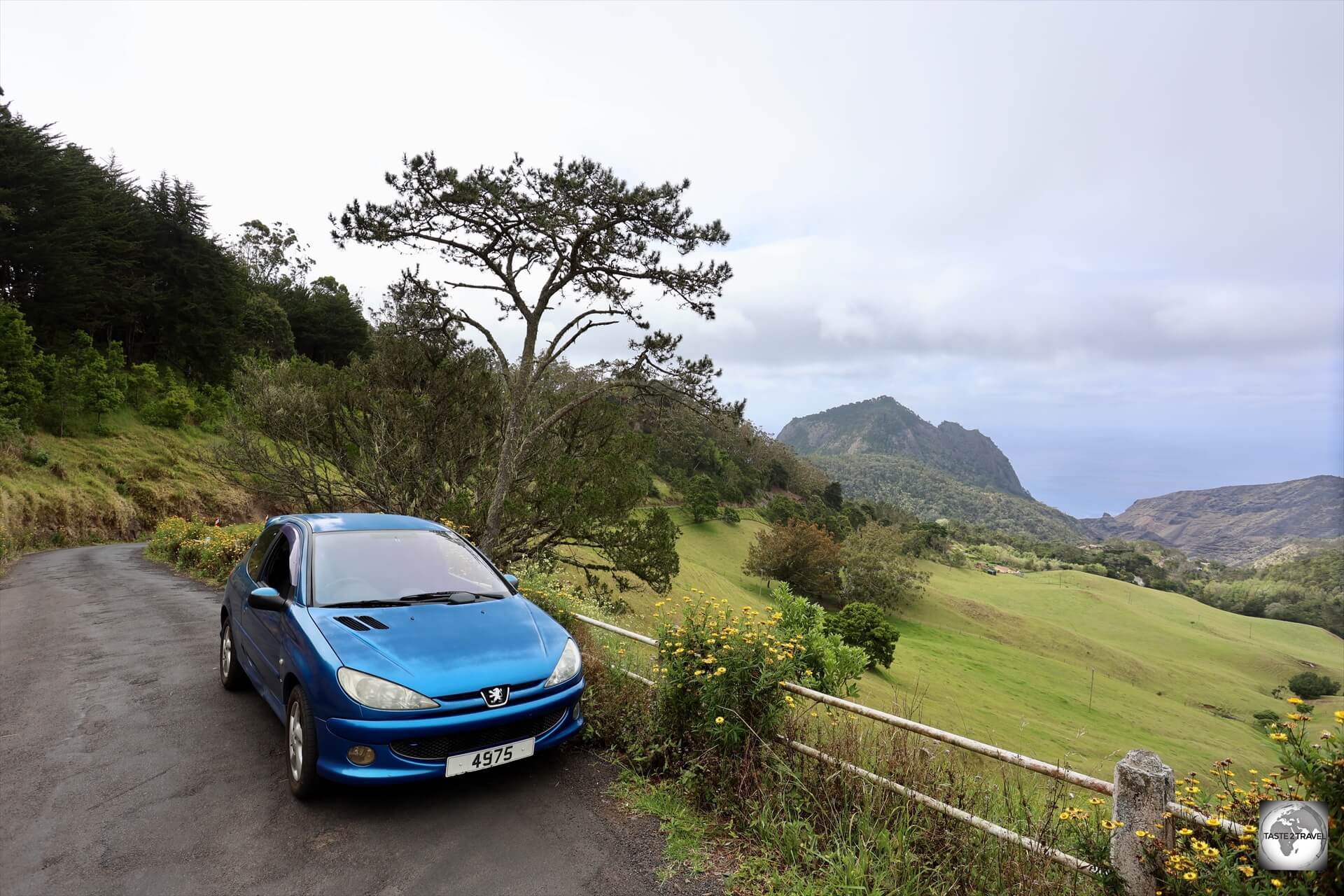
Exploring the beautiful countryside of Saint Helena in my rental car.
If you wish to maximise your time on Saint Helena, you will need to hire a rental car.
There are several companies which provide rental cars, all of which are listed on the Transport page of the Saint Helena Tourism Website.
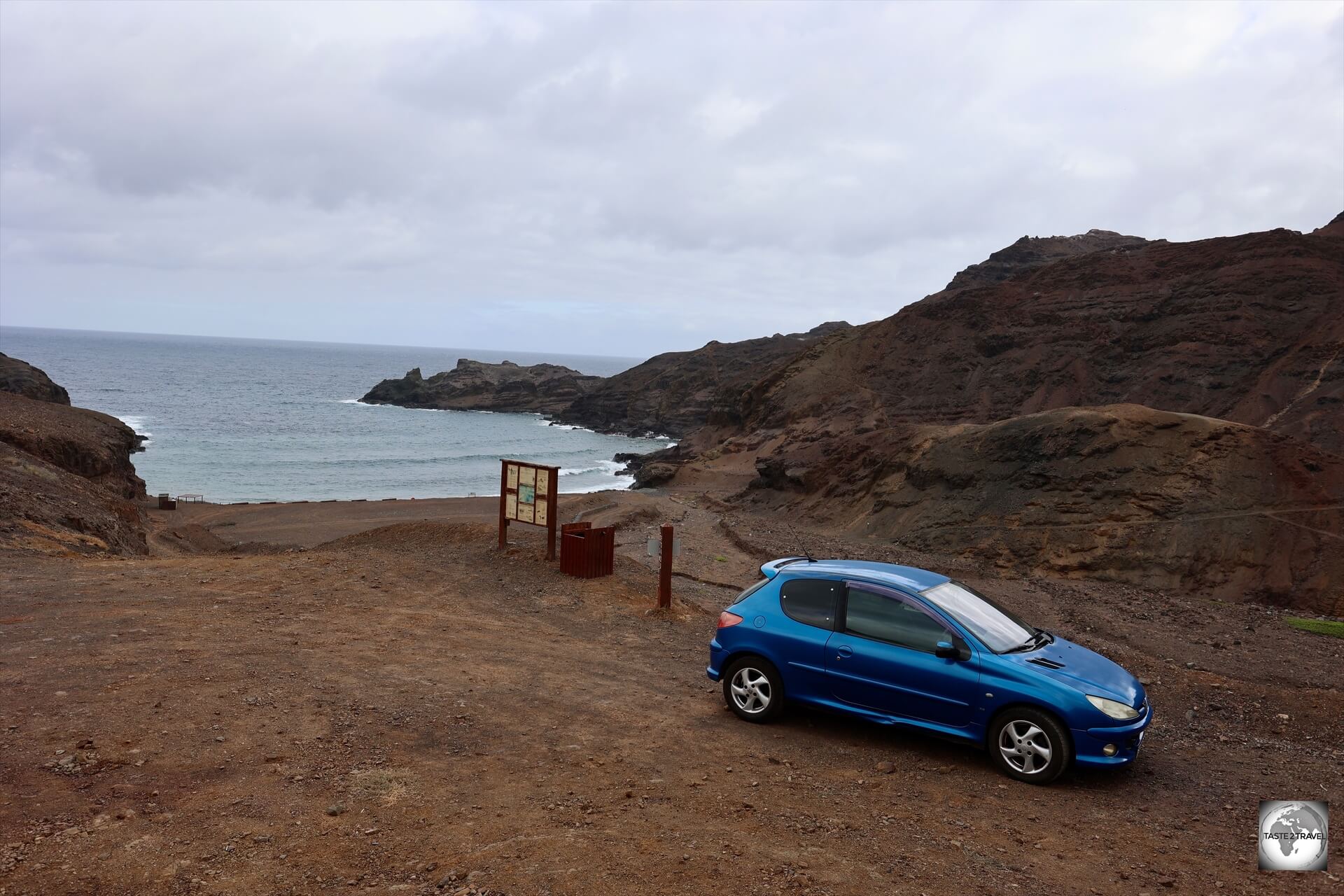
My rental car, parked in the car park at a very empty Sandy Bay.
I rented a car through Patrick’s Hire Drive with the friendly Patrick charging me £10 per day for a compact Peugeot.
Due to the narrow, windy roads, most cars on Saint Helena are compact out of necessity.
As of May 2024, the price of petrol on St Helena is £2.02 per litre at all three filling stations on the island: Jamestown, Longwood, and Half Tree Hollow.
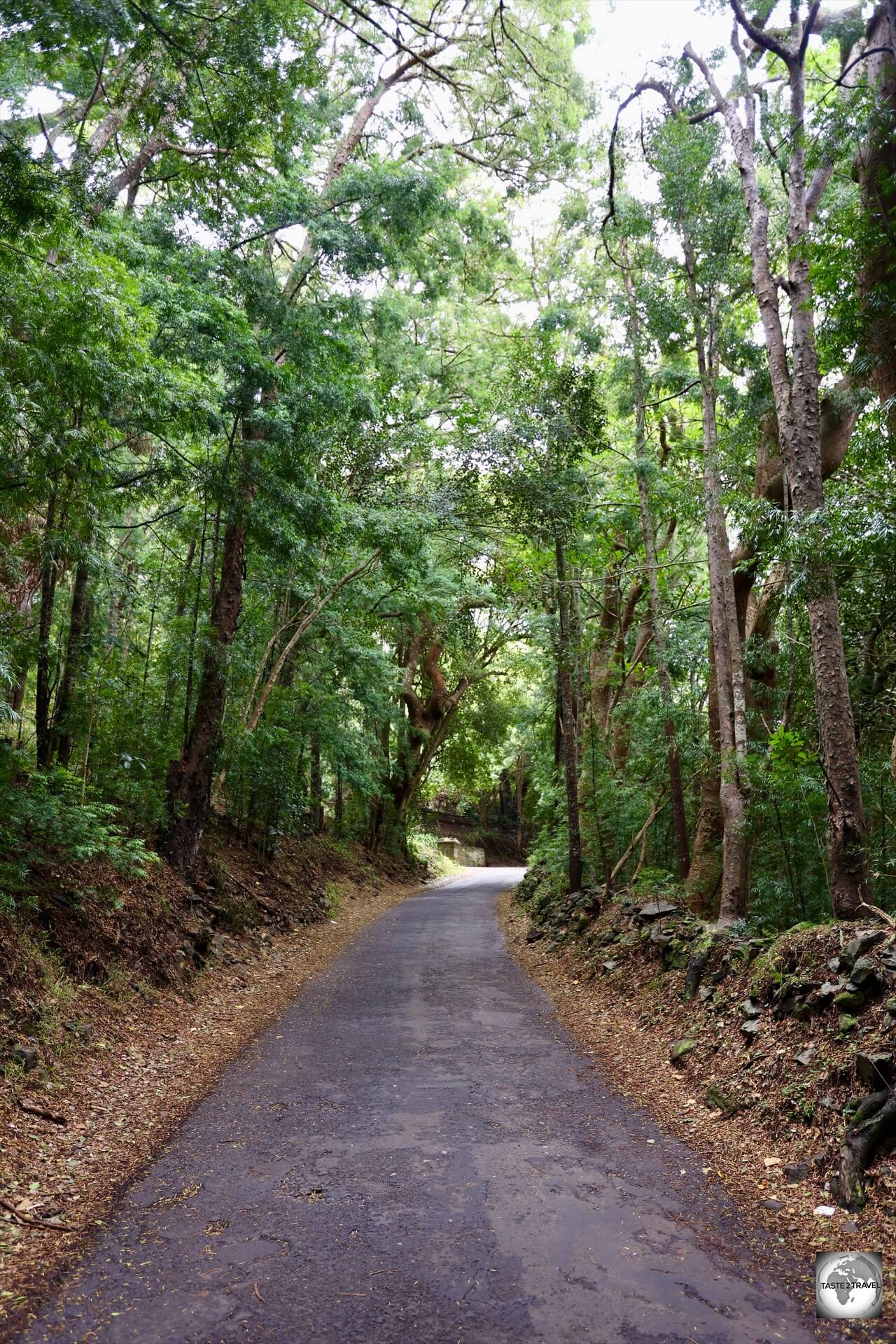
A country lane on Saint Helena.
This is no place for a big SUV!
Patrick can be contacted at:
Office Telephone: +290 24859
Mobile Telephone: +290 61943
Email: pvanderson@helanta.co.sh
That’s the end of my Saint Helena Travel Guide.
If you wish to leave a commentor any feedback, you can do so using the form below.
Safe Travels!
Darren
Author: Darren McLean
Darren McLean is an Australian, full-time, digital nomad who has spent 37 years on a slow meander around the globe, visiting all seven continents, 192/ 193 UN countries and 245/ 251 UN+ countries and territories.
He founded taste2travel to pique one’s curiosity and inspire wanderlust.


